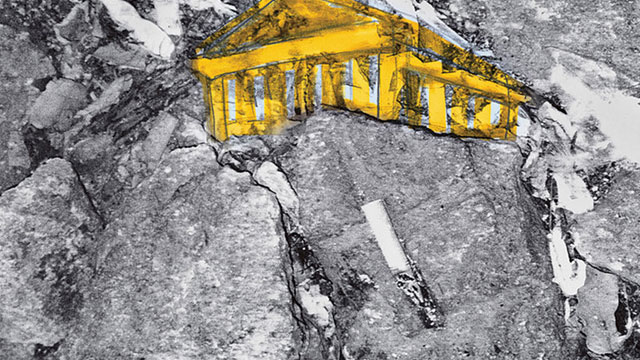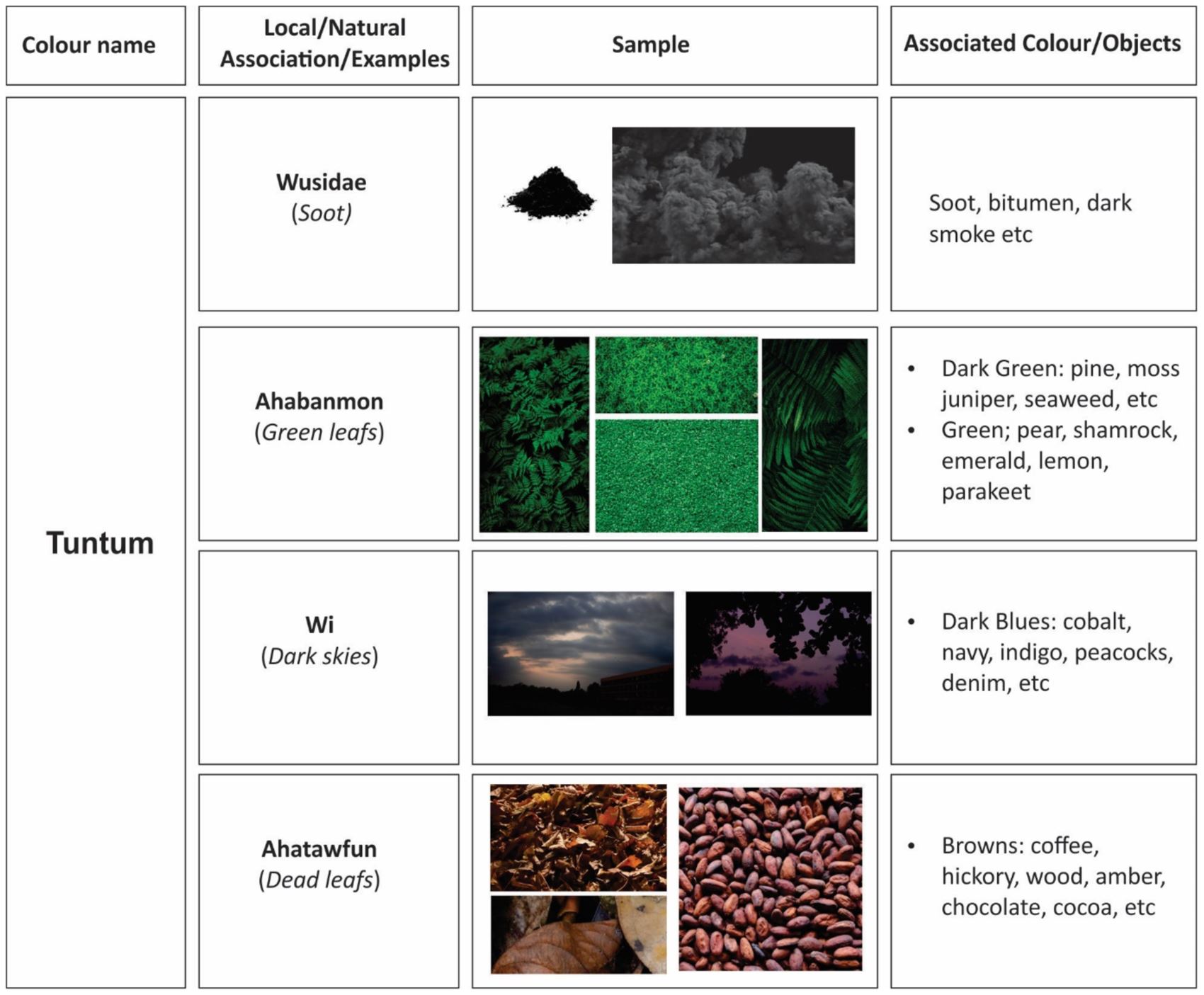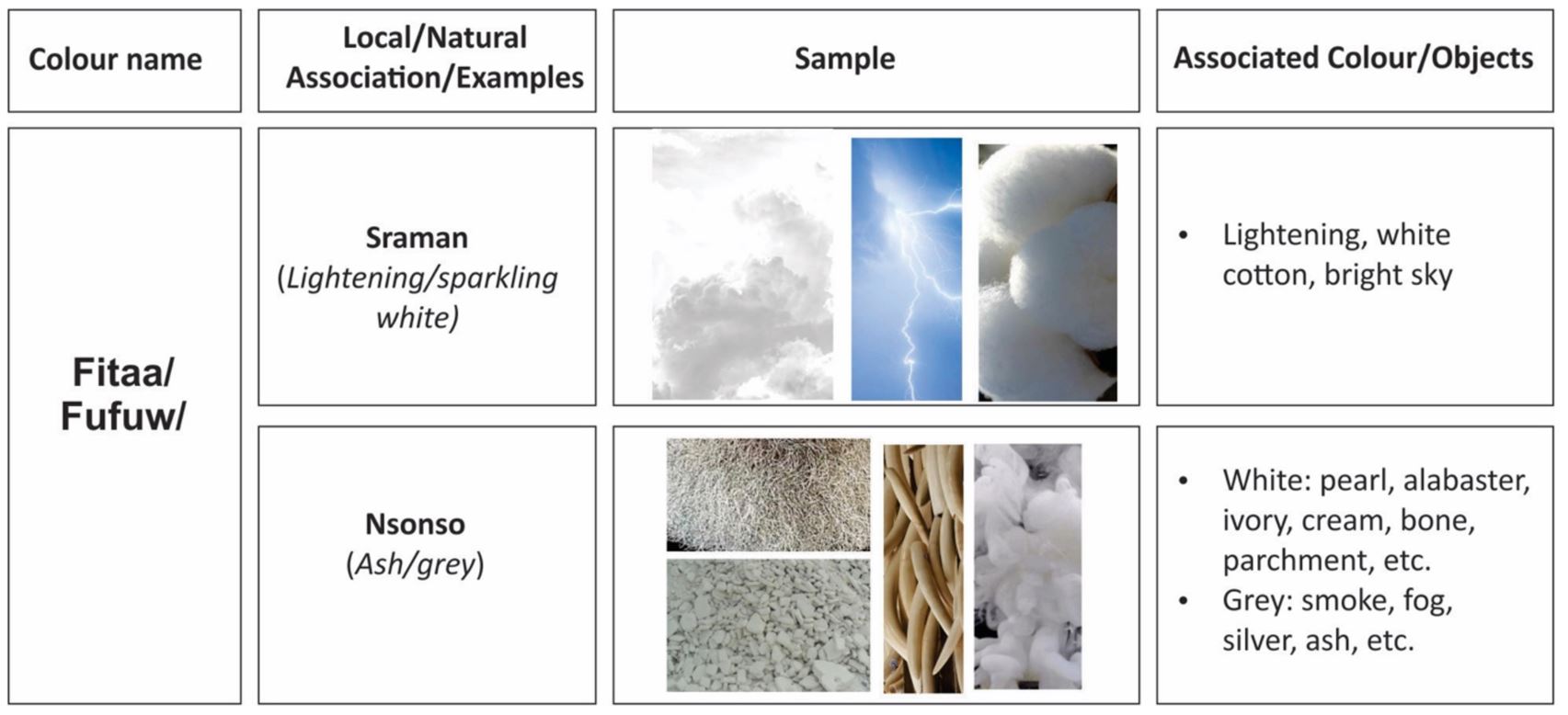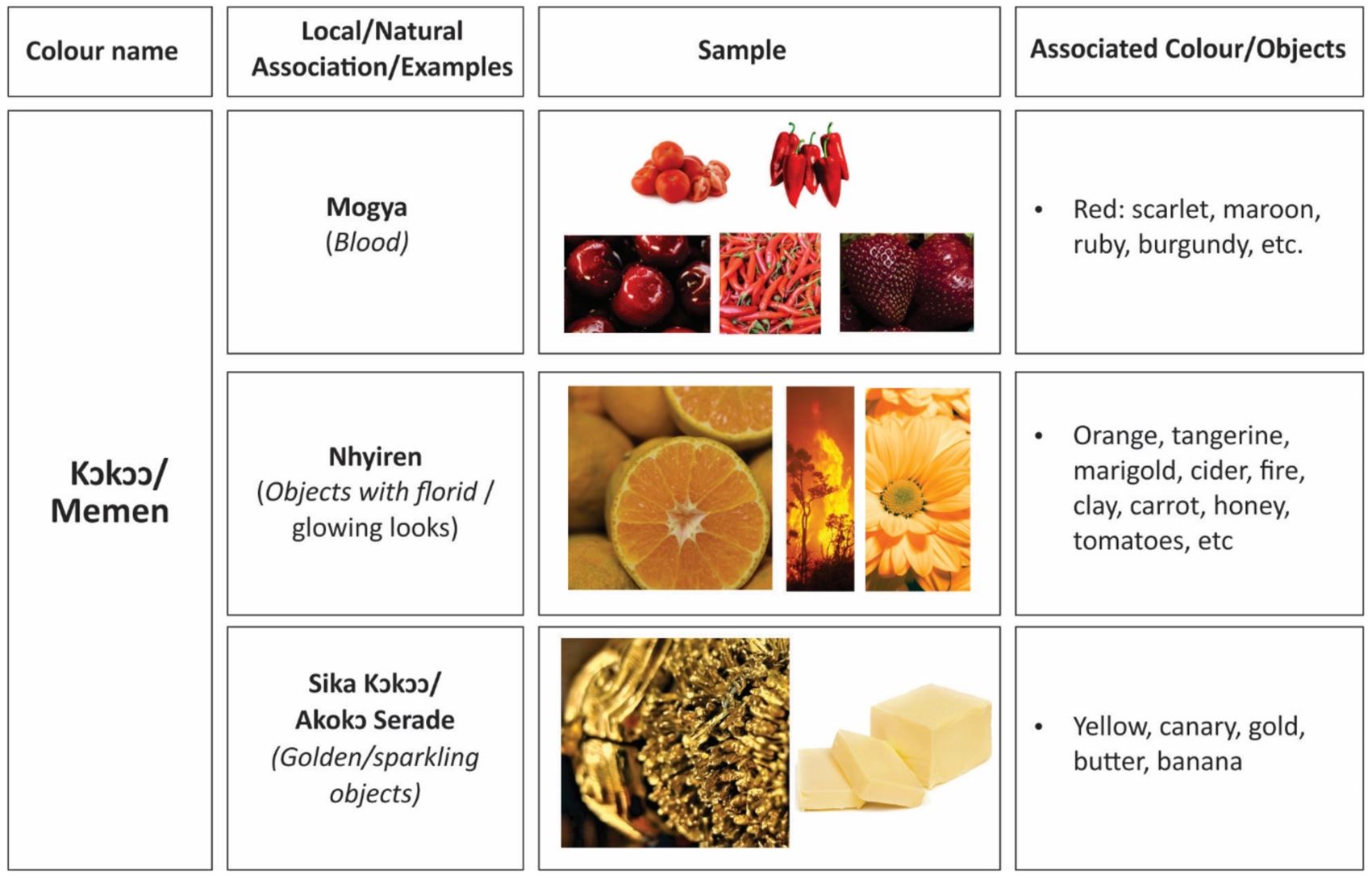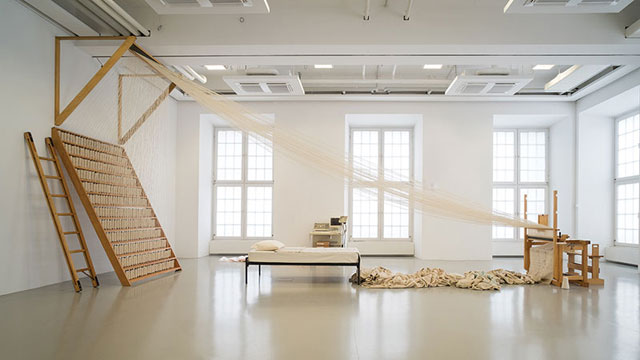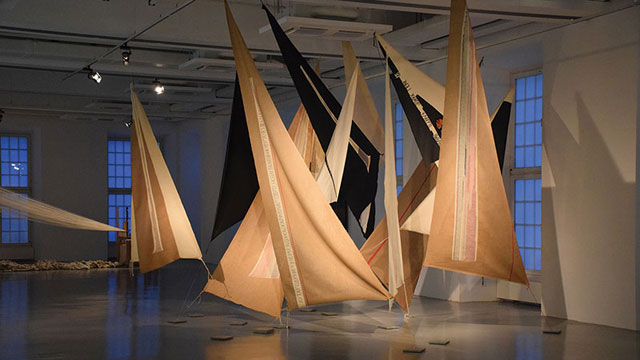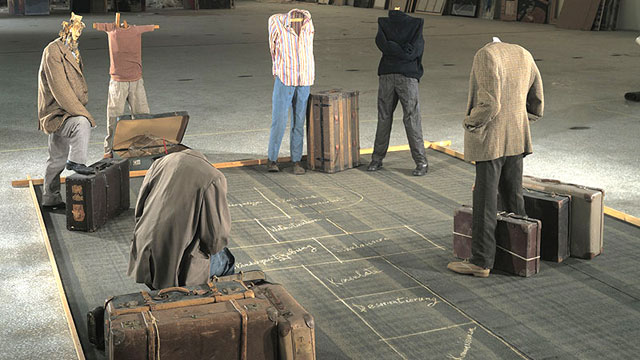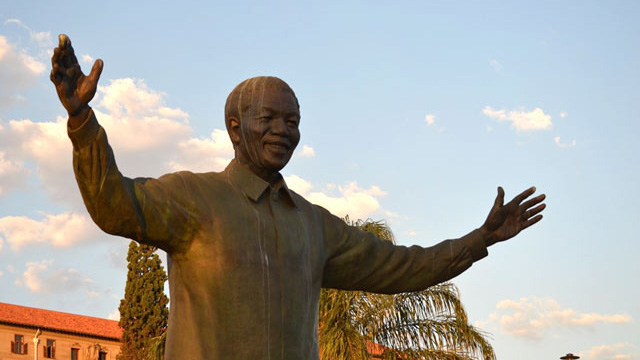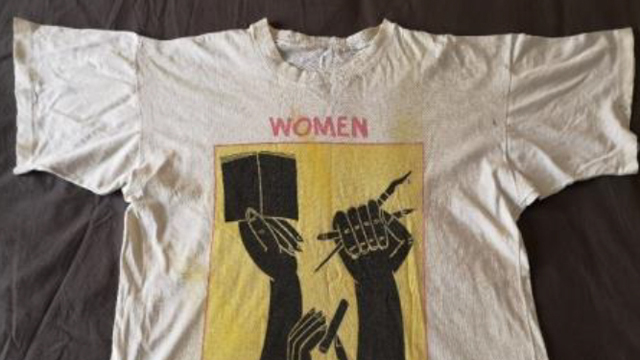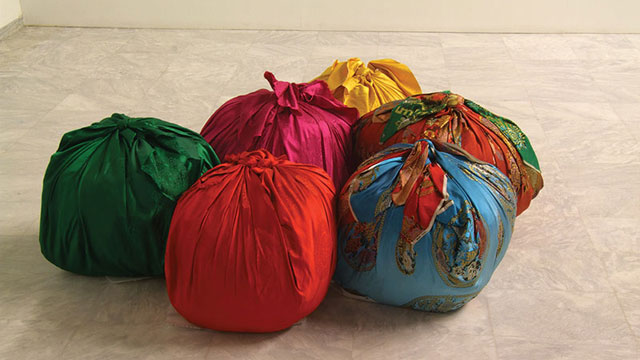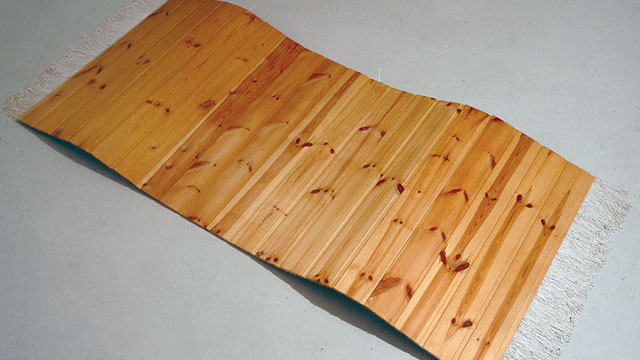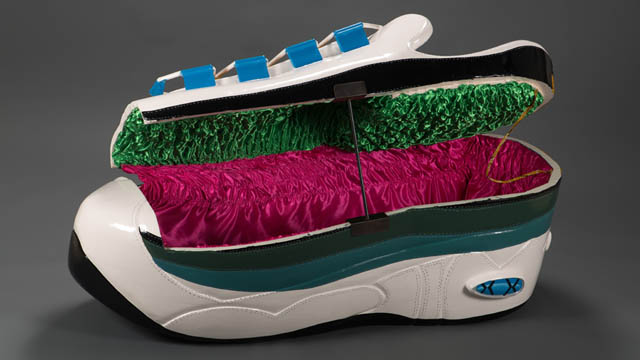Dear user,
This section of our website forms the heart of the EVC project. Here you find a collection of images of objects from different ‘visual cultures’. Our contributors selected and interpreted them in their respective contexts believing that these objects are particularly important for intercultural understanding across boundaries. Each time a user opens this page, the order in which the objects appear changes. In this way we hope to avoid a hierarchical understanding of the collected objects as their entries continue to be accessed in the long run. The constant changing face of the page also reflects the continuous expansion of the collection. As there are already over more than a hundred entries, users may want to form an overview, or to navigate through the growing collection according to their interests. For this purpose, we offer the following search options:

Filter: This enables you to search for objects according to time, place, keywords, etc. / Free title search: If you know the title of an object, you can find it in the free search field. / Lab: In the lab section, objects from the database are grouped under overarching themes. This is an ongoing project and about to be expanded extensively.
Enjoy exploring our database!
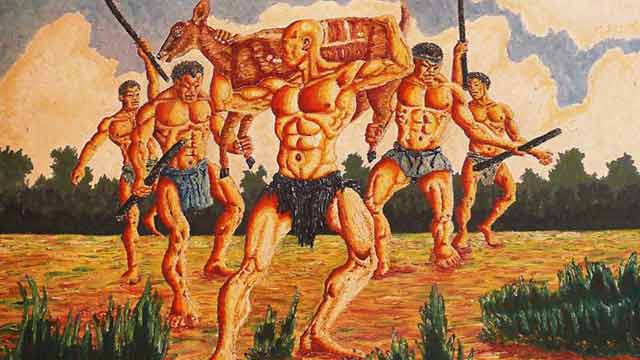
-
 Emmanuel Aklasu
Emmanuel AklasuOwusu-Ankomah’s painting at first glance reveals a foreshortening company of energetic warriors, muscular framed with broad shoulders, muscled chest, and a narrow waist in a chiselled physique. The hunters were portrayed with huge hands, clenched fist, knuckles, strong legs visibly revealing biceps brachiis and dabs of varicose veins on the arms, thighs and legs evident of powerful and efficacious men. Before modern society, the average male spent most of their time hunting, protecting, and engaging in physical activities that increased their muscle mass and maximize their muscular proportions. Owusu-Ankomah’s production exhibits masculine competitiveness and a sense of adventure – the brave team were a-fire with passion, armed with sticks in a leopard-like graceful movement as the captain leads carrying a captured antelope shoulder high.
The warriors are noticeably naked with only a string of grass costume wrapped around the private parts which is the formal and ceremonial attire for the ancient culture. Owusu-Ankomah’s choice of colour in rendering the human figures lends credence to the fact that colours have a strong position in identifying humans while hunting. Wearing hunter orange is the best way to ensure other hunters see you and don’t accidentally mistake you for game in complex backgrounds that are often green or brown. The artwork reveals harmonizing brown colours which tend to create a central focal point in the entire picture frame to evoke earthiness, emotions, security and safety related to the natural world. The tints and shades of hues enhanced the main features in the painting to vividly communicate the intended message as well as create an illusion of depth.
A thick flora forms the background of the painting evident that the hunting expedition was carried out in a thick forest. As the fearless, able-bodied men advance through shrubs in high spirit of mission accomplished, an earthly scent swirled around them coupled with a sense of eagerness to meet a welcoming, expectant and jubilant community. Hunting is an extremely important mode of human-nature interaction closely linked to culture patterns and value systems. This engagement with wild animals is thought of as part of a deeper unity with nature, which means being part of nature in physical sense (Lowassa et al., 2012). Sustainable hunting prescribes taking as much as needed and as much as the habitat and the population can regenerate. Suffice to say, when hunting for a game form the basis of a year-long survival of a people, it calls for a deeper reflection. Owusu-Ankomah’s painting comes on the back of an ancient heritage of a distinct tribe in Sub-Saharan Africa.
‘Aboakyir’ translated ‘deer hunt’ is a festival uniquely celebrated by the Effutu (Simpa) people of Winneba in the Central Region, southern coast of Ghana, West Africa. The festival which is celebrated annually on the first Saturday in May has the historical antecedent of the replacement of a human sacrifice to a tribal god with a leopard – an alternative which resulted in the loss of many more lives than the sacrifice of a single slave. Consultations with the deity for a more humane alternative resulted in the “Wansan” (the deer) as a practicable and most acceptable substitute. The capture of a live deer, like the leopard, required many more hands than the members of the royal family could find. The additional hands required were solicited from the local militia as a service to ‘the stool – a symbol of chieftaincy, royalty, custom and tradition’. It was this change in form; that is, the involvement of the local militia, that the annual consecration and appeasement of the deity became a public, state-wide affair. This marked the birth and hence the origin of the “Aboakyer” festival.
The design of the Effutu State emblem tells this story; the ‘stool’ on which the King is installed sits on the “Wansan” (the deer).
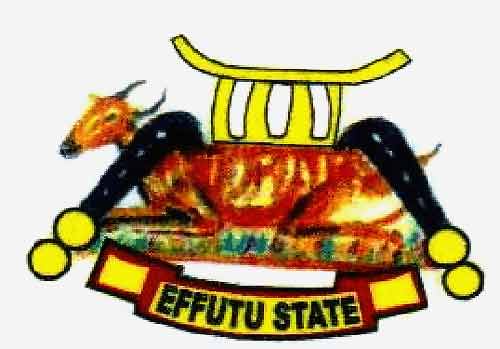
Emblem of the Effutu state (Source: Palace of Oma Odefe)
The festival is therefore important for the ‘stool’, its occupant and the entire royal stool family. It is a religious duty and an obligation for the general citizenry to ensure its celebration annually is sustained to honour the ancestors and protect their historic culture for posterity on the back of removing evil and predicting a good harvest for a prosperous life in the coming year. The week-long activity begins with two traditional warrior groups known as the ‘Asafo’ companies consult their shrines for clearance, protection and early catch. The warrior groups clad in distinct costumes with distinct musical instruments — the ‘Tuafo' and ‘Dentsefo’, move to their respective hunting grounds at dawn on Saturday, wielding sticks and clubs amid chanting of war songs. No weapons, other than clubs and sticks are used to catch the deer, as it must be brought back alive.
By far, the relevance of Owusu-Ankomah’s painting is not in doubt as it fosters a deeper understanding of the historical and societal roles of hunting within Ghanaian communities. The painting holds both cultural and educational significance which sparks discussions on conservation, sustainable practices, and the preservation of cultural heritage. Consequently, bridging the gap between present generations and the rich tapestry of cultural and environmental history. The sight of the painting in Ghana’s National Museum serves as a poignant reflection of the nation’s cultural heritage and connection to nature. In this visual narrative, the core of historical period of a distinct society is unearthed.
References
- Lowassa, A., Tadie, D. & Fischer, A. (2012). On the role of women in bushmeat hunting – Insights from Tanzania and Ethiopia. Journal of Rural Studies 28(4):622–630.
Further Reading
- Anane-Frimpong, D. (2022). Aboakyir: Deer hunt festival. Link Retrieved on April 10, 2023
- Rubiano, W. (2017). Planting trees for the aboakyer festival 2017. Link
Published March 2024
 Barbara Lutz-Sterzenbach
Barbara Lutz-SterzenbachAn energetic scene. Five men in a flat landscape approach the viewer. Their bodies are naked - except for their loincloths - their faces grim. Muscles in the bright light stand out under the skin, their chests bulge voluminously - they are timeless heroes. The men do not look at the viewer of the picture. With their long, dark sticks firmly in their strong hands, they gather symmetrically around the bald man in the foreground. He presents himself with an antelope in his raised arms. His bald skull points to the left, as does the antelope's head.
On closer inspection, some things are irritating. Are the men dancing or walking? Where is the animal spatially located? Somehow it is on the shoulder of the man, but the legs are captured by the men behind, who would be much too far away for that. Is an event, an episode (as in a photograph) depicted? Or does the symmetry of the composition speak more of a constructed symbol, a sign, as in an emblem? The latter would support the strict division into horizontal planes: with the islands of grass in the foreground, the flat, ochre-coloured plane in the middle ground and the forest with sky in the background. But then again many design principles undermine this order: the tense, energetic movements of the figures, the strong brushstrokes, the irregular shapes of the white clouds and the tufts of grass, the dynamic accents of the sticks.
We know from our Ghanaian colleagues that what is depicted here, the catching of the animal, is part of a ritual celebration and a festival (the Aboakyer Festival). Here the moment is shown when the men have stepped out of the dark, hermetically sealed forest in the background with their prey and now present themselves in the bright light with their success. A comparison with the results of an image search on the internet for “Aboakyer festival” (Fig. 2) shows that this is the iconic moment. Here the idea of the festival seems to be condensed. And this also explains the emphasis on muscles: the hunters must be well trained to match the animal's speed and strength.
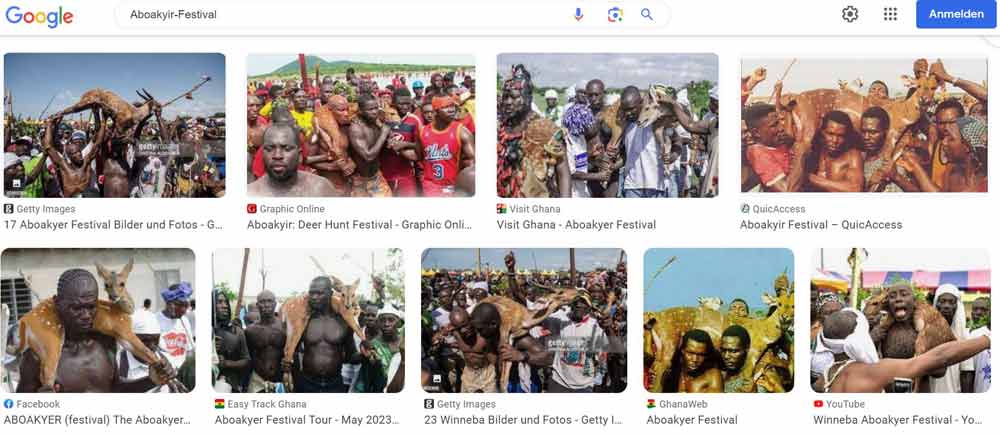
Fig. 2 (Google search for "Aboakyer Festival" on 9.9.2023 - the first page of results) Screenshot: Ernst Wagner
Owuso-Ankomah's painting focuses on the men with the animal. At first glance, the painting shows above all the strength of the men. The space thus becomes the backdrop for their performance. Their bodies are not only idealised but theatrically exaggerated, their muscles as if illuminated by a spotlight. The geometric centre of the picture, through which the horizon also passes, brings the loincloth of the leader into focus (see fig. 3) - perhaps an allusion to male potency?
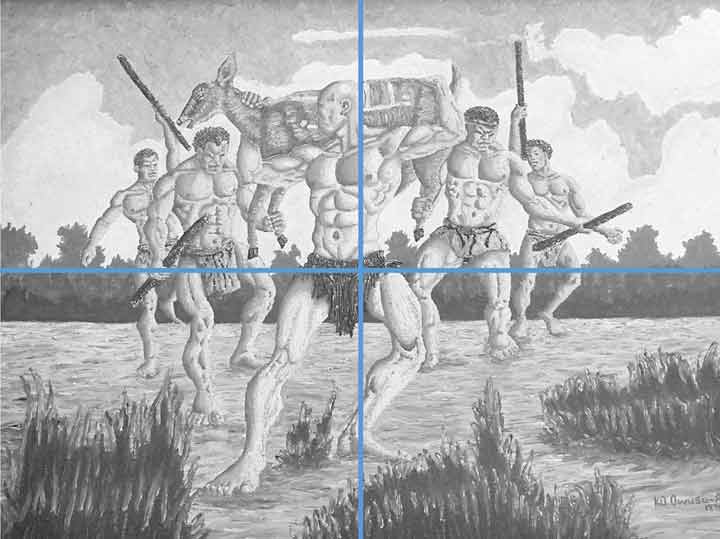
Fig. 3: Composition sketch (horizon and geometric centre) Photo: Ernst Wagner
A comparison with photos on the same theme from the Heritage Centre in Winneba (see Fig. 4-6) shows clear differences to the depiction in Owusu-Ankomah's painting. In the artwork, both animal and hunter have their mouths open, exhaustion is evident in both. In this way, too, man, animal and landscape are connected - despite hunting and death. The artist uses the warm ochre tones in such a way that the earth, the human body and the animal hardly differ in colour. Since the animal is still alive, its head does not have to be held. Thus, visually, it seems to elude a depiction of "being trapped", also due to the ambiguous spatiality described above. It could almost just as easily be understood as a triumphant appearance of the animal, to which the men are subordinate as bearers and assistant figures - comparable, for example, to Jan van Eyck's depiction of the lamb (see fig. 7), which also marks a mediating position between victim and victor, between human beings and God.

Fig. 4-6: Photos from the Heritage Centre Winneba Photos: Ernst Wagner
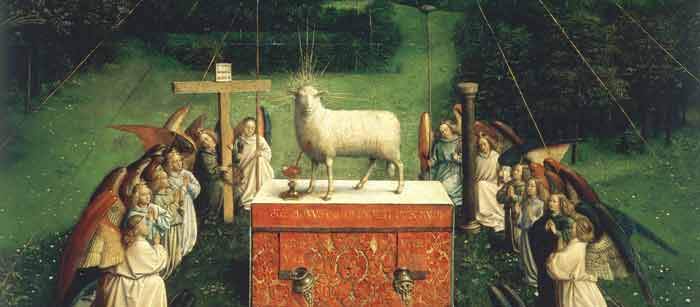
Fig. 7: Van Eyck, Lamb of God, Image Detail: Ghent Altar. Oil on wood, 350 x 461 cm
Cathedral of St Bavo, Ghenthttps://commons.wikimedia.org/w/index.php?curid=109213 [28.10.2024]
This image sets against each other contradictory concepts: static-symmetrical-ordered vs. dynamic; accidental situation vs. deliberate staging; documentation vs. sign; hyperrealism in body and space vs. symbolic charge. It sets these contradictions against each other in the unity of the painting.
Reference
Published March 2024
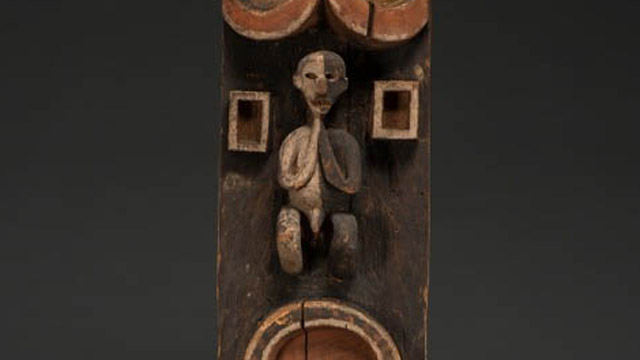
-
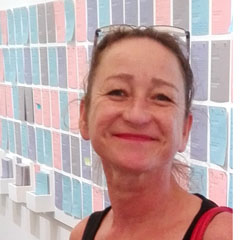 Karin Guggeis
Karin GuggeisObjects from the Global South in early collections of the Global North often lack any information about their specific local context. This is also true for this wooden sculpture made from a single block of hard wood, carved with different figures and forms on two sides and painted with natural colours in red, white and black. It was acquired in 1893 by the “Royal Ethnographic Collection” (Königlich Ethnographische Sammlung) in Munich, today the Museum Fünf Kontinente. No specific information about its geographic origin, its producers, users or use was documented in the inventory book. “Huge four-edged block, 1.80 high made of heavy wood, double-sided carved with human figures and lizards, heavily damaged by termites” is the only information recorded. The wooden block was sent from “Cameroon” (Kamerun) which is therefore documented as its region of origin. It was given to the museum as a present by Max von Stetten, a colonial officer in the German colony.
The post gained a new layer of significance through its inclusion in the almanac “The Blue Rider” (Der Blaue Reiter), one of the most famous and important publications on art in the early 20th century in the Global North. The almanac was edited in 1912 by two artists based in the environs of Munich, Franz Marc and the Russian Wassily Kandinsky. They designed the publication as a starting point for a new epoch of art, rejecting academic art and encouraging new forms of artistic expression. Thus, Kandinsky and Marc included reproductions of different non-canonical art forms, such as artworks from the Middle Ages, folk art, art made by children – and non-Western artworks, in those days called “art of the primitives” (Kunst der Primitiven), among them this sculpted block from Cameroon. In this way, the editors of the almanac aimed to break down the hierarchies between art forms from different times, regions and levels of professional skill, and to expand the canon of art in the Global North.
The editors’ fascination with non-European art had different roots: Wassily Kandinsky was a trained ethnographer and often visited ethnographic museums. Franz Marc, since his visit to the ethnographic museum in Berlin in 1911, especially admired sculptures from Cameroon. Thus Marc included a photograph of this wooden block to illustrate August Macke’s article “The Masks” (Die Masken). Marc captioned the picture simply “Cameroon” (Kamerun), its known geographic origin, and the country whose sculptures he admired.

Fig 1: Almanac "Der Blauer Reiter" (page 58-59)
In his article, the artist Macke stressed that for Africans their “idols” (Idole), as he called their sculptures, were a “visible expression of an invisible idea”, “a personification of an abstract term”. He also stressed the equality of the art forms from different times and regions. For example, Macke valued bronze works from the kingdom of Benin, in what is today Nigeria, and other ethnographic works, because they are just as expressive as a grave marker in the cathedral at Frankfurt. To demonstrate this non-hierarchical attitude to art from different regions and times, Marc and Kandinsky placed two photographs side by side on a double page in the almanac – on one side the Gothic figure of a knight, and on the other a bronze plaque showing a soldier from the kingdom of Benin, which also was in the collection of the Munich ethnological museum by then (Fig 1).
The later fame of the almanac, and of its publishers Kandinsky and Marc as artists, led to the wooden sculpture being named “The Blue Rider Post” in the narrative of the museum.
It is significant for global art history dominated by the Global North that, in contrast to our broad knowledge in respect of the European admirers of this object, very little is known about its original local context in the Global South. The state of our knowledge concerning its producer(s), its patron(s), its use, its specific place of origin, the meaning of special forms, colours, figures or gestures sculptured is poor. There are two reasons for this. First, in the Global North, there has been little interest in investigating its local context. Second, it is actually very difficult to carry out such investigations in respect of such badly documented early works in ethnological museums. To unfold these difficulties: the common method used to trace the local context of poorly recorded works is to look for stylistic similarities and ethnological background information concerning comparable objects in other collections or publications. Spending long periods doing fieldwork in the place of origin is too time- and money-consuming, as there are numerous badly recorded objects, especially in the early ethnological collections. Moreover, in the Forest region of East Cameroon, the assumed place of origin, there are numerous small ethnic communities which have been inadequately studied. Thus the poor results of previous research in the Global North are the following: The sculpted post is valued as unique in ethnological and art publications. Only single figures and their gestures show similarities with a few other objects in collections of the Global North. The current suggested origin of this carved work in view of these stylistic similarities is among the Lundu or Mbo people in the Forest region in East Cameroon. There it was probably used in a cult.
A new approach has been made possible by a provenance research project of the Museum Fünf Kontinente, funded by the German Lost Art Foundation and the Bavarian State Ministry for Science and Art. In collaboration with scholars from Cameroun and the presumed source communities, members of the project are exploring the provenance and the local context of this special Cameroonian wooden block, as well as the whole collection from the German colony of Cameroon donated by Max von Stetten to the museum between 1893 and 1896. Hopefully the blank sheet regarding the original context of this wooden block will be filled.
For comparison, also read Patrique deGraft-Yankson's analysis of this object here.
The post in the context of the the repatriation discourse: Link
References
- Eisenhofer, Stefan (2009): Kulthauspfosten (?). In: Bujok, Elke (ed.): Der Blaue Reiter und das Münchner Völkerkundemuseums. Staatliches Museum für Völkerkunde München, Hirmer, München. S. 16-18
- Erling, Katharina (2000): Der Almanach Der Blaue Reiter. In: Hopfengart, Christine (ed.): Der Blaue Reiter. Bremen, Köln. S. 188-240.
- Kecskési, Maria (1999): Skulptierter Holzblock. In: Kecskési, Maria (Hg.): Kunst aus Afrika. Museum für Völkerkunde München. Prestel, Munich, London, New York. S. 116.
- Kecskési, Maria (1982): Zwei beschnitzte Holzblöcke. In: Kecskési, Maria (ed.): Kunst aus dem Alten Afrika. Pinguin, Innsbruck. S. 238-239, 72.
- Macke, August (1912): Die Masken. In: Kandinsky, Wassily/ Marc, Franz: Der Blaue Reiter. Piper, Munich. S. S. 53-59.
- Marc, Franz and Kandinsky, Wassily (eds) (1912): Der Blaue Reiter. Piper. Munich.
published March 2020
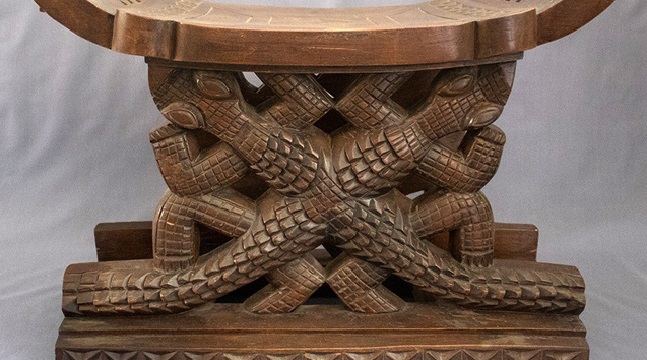
-
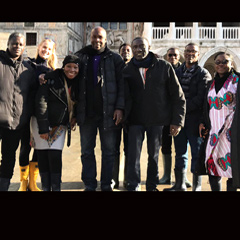 UEW Team
UEW TeamThe Funtumfunefu-Dԑnkyԑmfunefu stool is a carved traditional wooden stool designed with an Akan symbol known as Funtumfunefu-Dԑnkyԑmfunefu (pronounced ‘fuun-tum-fu-ne-fu den-cheem-fu-ne-fu). This type of stool called asԑsԑgua in Fante (a dialect of Akan people from Ghana) is an art-cum-utilitarian object. It is basically composed of three main parts namely the animu (top) which is the seat; the mfinfinin (middle) which bears the design that gives identity to the stool; and the wiabour (base) which is the part that touches the ground and gives stability to the stool (Antubam, 1963; Amenuke, Dogbe, Asare & Ayiku, 1991). In this particular image, the middle portion, which is the focal consideration for this presentation, is created with the Funtumfunefu-Dԑnkyԑmfunefu symbol. The size of the stool is composed of a base that measures 53cm x 28cm, the top arc-shaped seat that gives the stool a length of 55cm and an overall height of 42.5cm.
The stool was presented as a special gift to the Chairman of the Provisional National Defence Council (PNDC), who doubled as the then Head of State, Flight Lieutenant Jerry John Rawlings by the Chiefs and people of Dormaa in the Bono Region of Ghana. It was brought to the Ghana National Museum through the State protocol in 1992. Flight Lieutenant Jerry John Rawlings led Armed Forces Revolutionary Council (A.F.R.C) to power through coup d’état on June 4, 1979 and prepared the grounds for the coming of the third republican constitution. In the same year, Dr. Hilla Limann was inaugurated as the president of the third republic after winning the election. Rawlings returned to power on December 31, 1981 through another military takeover with his Provisional National Defence Council (P.N. D.C) of which he was the chair. Rawlings’ PNDC party stayed in power for almost eleven years before working out for the adoption of the Fourth Republican constitution through a referendum on April 28, 1992 (Essel, 2019). Subsequently, presidential election was held, which he led the National Democratic Congress (NDC) to win. Though the exact date he received the stool as a gift is unknown, it might have been received within 1981 to 1992, judging from the period of his military regimes and constitutional terms of office before the Ghana National Museum received the stool as part of its collections.
The artist who carved this stool is anonymous. Within the context of the Ghanaian traditional creative work productions, this is not strange, since artworks produced in precolonial and traditional Ghanaian societies were hardly signed by the artists who produced them. This was because the artworks were communal, that is, they were produced for use by the community. The chiefs and kings had varied proficient artists in their courts or communities who produced artworks for the community. With the Funtumfunefu-Dԑnkyԑmfunefu stool being a special gift to the then president of the state, it might have been created by a revered and creative carving-artist in the Dormaa community.
The Funtumfunefu-Dԑnkyԑmfunefu symbol falls within tangible artistic creations which takes its name from the Akan expression for Siamese crocodile. Akan is a major Ghanaian language, which is spoken by about 48 percent of Ghana’s total population as first language, and by an additional 35 percent as additional first language or second language (2010 Population and Housing Census). The symbol derives its name from an Akan proverb which suggests that the Siamese crocodiles share a common stomach and yet struggle for food. Semantically, fun means stomach while funtum means ‘put together’ or ‘mixed together’. Funtum also represents the rubber tree that produces a milky sticky substance used to glue items together. Fu-ne-fu (literally, ‘stomach and stomach’) represents two stomachs joined together. Dԑnkyԑm is crocodile. Dԑnkyԑmfunefu, therefore, means ‘two crocodiles with stomachs joined together’. On the other hand, funtum, as verb, also means ‘to stir something up with tension’, generally producing dust. This also draws attention to the struggle or the confusion that comes with the two crocodiles struggling to feed.
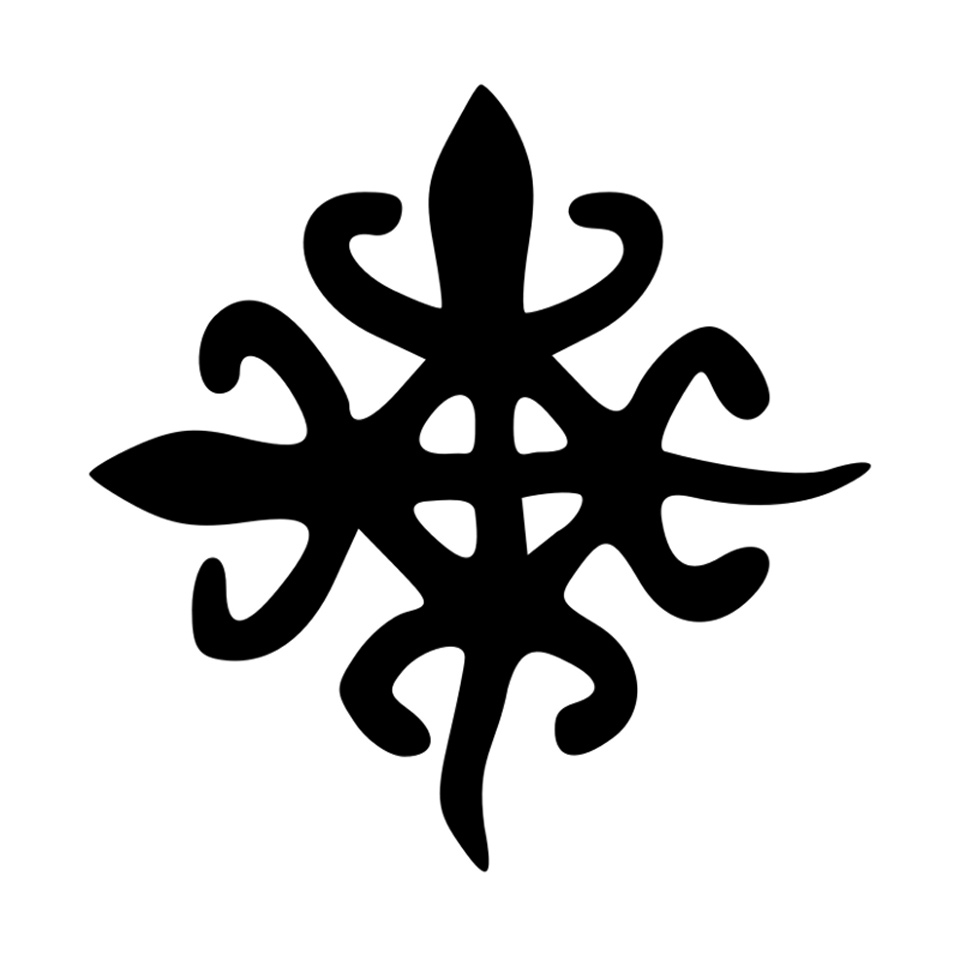
Funtumfunefu-Dԑnkyԑmfunefu symbol (Photo: the author)
The Funtumfunefu-Dԑnkyԑmfunefu symbol (see Figure above), is a graphical representation of two crocodiles rendered in silhouette in a perpendicular orientation with a conjoined and centred stomach, which is a common food receptacle. There are four juxtaposed arc-like lines interspersed and connected by four diagonal lines, creating a rhombic shape at the centre of the symbol. The four arc-shaped lines suggest the limbs, with the prominent sharp-tapered edges attached to the forelimbs placing emphasis on the cephalic regions. At a casual glance, the idealised limbs appear to be same in size, yet a close observation reveals that the forelimbs slightly outsize the hindlimbs. Two tadpole-shaped linearity with sharp-tapered edges placed perpendicularly to fuse with the limbs give a heightened impression of two reptile figures put together.
The Akan expression fun, which is the stomach in the case of the Siamese crocodiles, has two levels of meaning in Akan worldview, the superficial and the hidden. The Siamese crocodiles have a common stomach yet the two heads scramble for food. Each tongue yearns to have a taste of the food, though the gulps of food consumed by each enter a common receptacle. The complexity of this allegorical image could also be found in its multifaceted cultural interpretations.
Criteria for Selection (Educational Relevance & Quality)
The Funtumfunefu-Dԑnkyԑmfunefu symbol belongs to the family of Adinkra symbols. The symbols encapsulate the general Ghanaian philosophical thoughts and ideologies, cultural values, beliefs and practices. Its origin and first usage is traced to the Asante nation state, which is part of present day Ghana (Rattary, 1927). Its usage predates the 19th century as recorded by Bowdich (1819).
The multi-layered meaning of the Funtumfunefu-Dԑnkyԑmfunefu symbol tells its usefulness and educational relevance in the Ghanaian society. Due to its historical, socio-cultural and national importance in Ghana, Adinkra features in the design of decorative and functional artworks. The Funtumfunefu-Dԑnkyԑmfunefu symbol designed into carved wooden stool symbolises unity in diversity, democracy, shared destiny and female-male duality. Giving visual annotation to the idea of unity in diversity, the compositional structure of the Funtumfunefu-Dԑnkyԑmfunefu symbol shows formidable stability, an attribute of unity. There is deliberate inflation of emphasis depicted by the prominent sharp tapered edges attached to the forelimbs, which connotes power, energy and aggressiveness in the process of scrambling for ‘food’ by the Siamese crocodile. Viewers who do not understand the true symbolism of the image sometimes greet the aggressive depiction and the centred common stomach with negative interpretation. However, in the same stable composition, the graceful movement that bedews the tadpole-shaped figures placed at right-angled position creates an impression of diversity.
Methods/Interpretation/Research Questions
The asԑsԑgua (stool) in Ghana symbolises the soul of the society and serves as inoffensive symbolic link between the people or the subjects and their head of state or king (Antubam, 1963). It implies that the stool has both political and nationalistic useful to the citizenry and their ruler. In this instance, the stool reminds its users and observers of the need to engage in activities that will lead to unity rather than divisive tendencies. It teaches the Ghanaian society of shared destiny and the need to strive for oneness irrespective of one’s political affiliation, social standing, physique or race. The integration of the Funtufunefu Denkyemfunefu symbol into the political significations of stool symbolism therefore combines the essence of communal leaving and nationalistic feeling with power and governance. Just as the Funtufunefu Denkyemfunefu stool symbolises unity in diversity, and nationalism, the coat of arms of Germany also symbolises national unity. In this sense, both are thematised on unity and national consciousness. Both designs are abstracted animal figures and play allegorical role in the semiotic interpretations of the symbols.
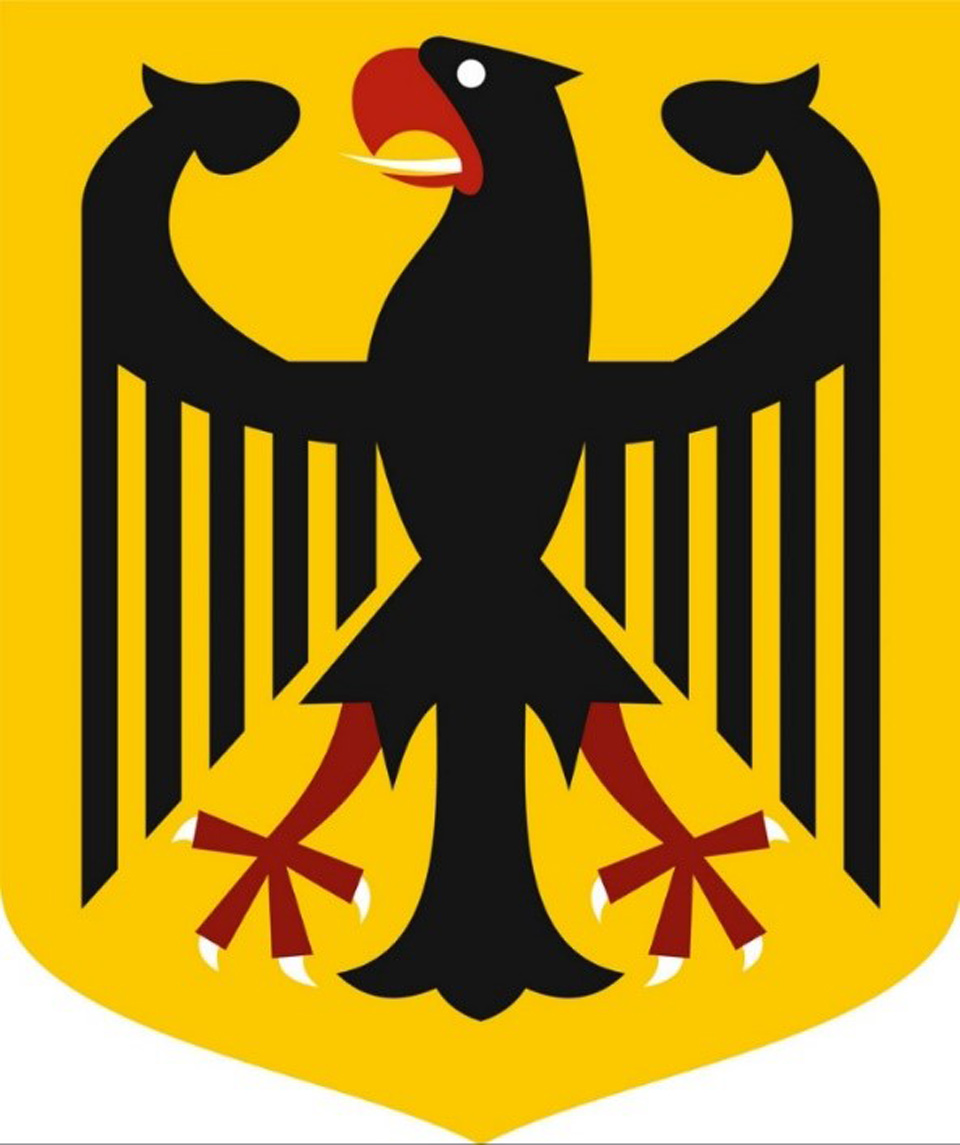
The coat of arms of Germany
https://de.wikipedia.org/wiki/Bundeswappen_Deutschlands [28.010.24]
In terms of artistic presentation, both were rendered in silhouette. The Funtufunefu Denkyemfunefu stool gives expressive meaning to unity by underscoring that individual difference, diverse shades of opinions and social standing that usually operate in the search for unity but must end in oneness of purpose for the national good. The broad vertical lines that conjoin the flanked arc-shaped lines to give impression of the wings of the eagle figure suggest strength, power and authority of the Germany coat of arms (Figure 3).
The common symbolic ideology in both the Germany coat of arms and the Funtufunefu Denkyemfunefu stool is to strive for oneness. Exploring the design concepts, socio-cultural and identity connections between these two images create opportunities for new levels of greater bilateral understanding and integration.
Obviously, interrogating images of this nature and identifying their essence within their traditional setting vis-à-vis other cultures is likely to help to eliminate prejudices about visual cultures among nations and reduce the barriers in visual communication.
References
- Amenuke, S. K., Dogbe, B. K., Asare, F. D. K., Ayiku, R. K., & Baffoe, A. (1991). General
- knowledge in art for senior secondary schools. London: Evans Brothers Ltd.
- Antubam, K. (1963). Ghana’s heritage of culture. Leipzag: Koehler & Amelang.
- Bowdich, T. E. (1819). Mission from Cape Coast Castle to Ashantee. London: Cass.doi: 10.1017/CBO9781107444621.
- Essel, O. Q. (2019). Dress fashion politics in Ghanaian presidential inauguration ceremonies from 1960 to 2017. Fashion and Textiles Review, 1(3), 35-55.
- Rattary, R. S. (1927). Religion and art in Ashanti. . London: Oxford University Press.
published March 2020
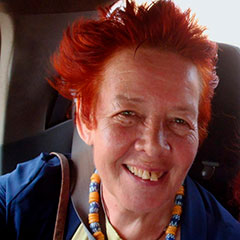 Bea Lundt
Bea LundtI am fascinated by the Ashanti-stool, being a symbol of soul of society, “to house the spirit of the Asante nation - living, dead and yet to be born” (Wikipedia), as it is described in this article. Travelling in Ghana very often, I had been told the background-story of this object again and again, so I know its importance to the people. Additionally, you can find several publications describing its meaning.
The beginnings are rooted in the 17th century when the Asante-confederacy was founded. As the legend tells, the Golden Stool fell from the sky as a religious legitimation of the King Osei Tutu, representing wealth and power of the region. During colonial times the Asante defended the stool against the British. They had been very successful to repulse the European invaders until they were finally beaten. So, for me the Golden Stool is also a symbol of anticolonial defence. People identified with this object as the representative symbol of their culture and protested any robbery of it. The stool as the main symbol of authority of the confederation gives the feeling of security and duration. Every 5th year it is presented to the public during the Akwasidae-Festival in Kumasi. As I read, there is also a Golden Stool of other ethnic groups, Denkyira and Ga. It is very interesting that this object can be constructed in different shapes and can also be decorated in quite different ways with additional meanings.

Golden Stool of Asante on its throne, the hwedom dwa, with its immediate caretaker (1935), United Kingdom Government, © public domain
One of the most exciting buildings I have ever seen, is the Golden Jubilee House (Flagstaff House) in Accra, which is the Presidential Palace and office of the President of Ghana (completed in 2009). Its architecture is following the model of the Golden Stool of the Ashanti people.
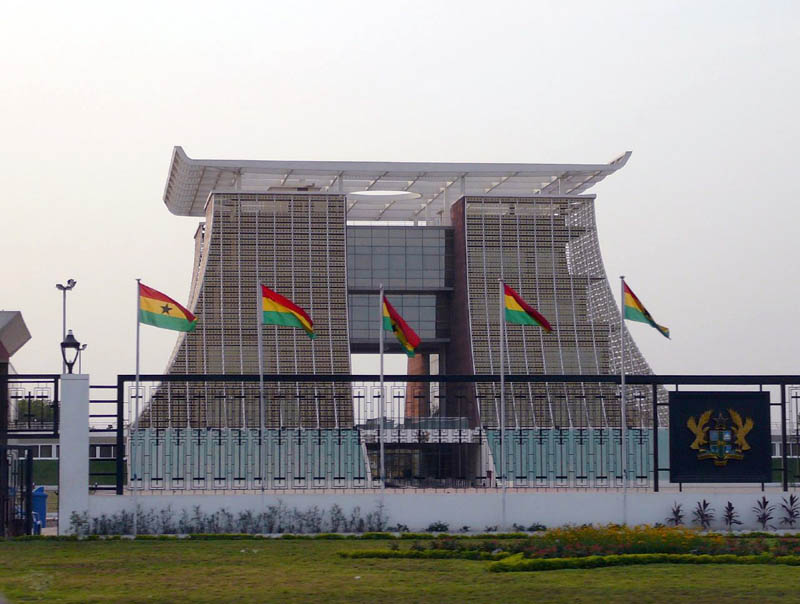
Golden Jubilee House - Flagstaff House (open access, https://commons.wikimedia.org/wiki/File:Golden_Jubilee_House.jpg)
The example of decoration which is chosen in this article is the Adinkra-symbol for „unity in diversity“. It always remembers me of the European story of Menenius Agrippa and the plebs, a narration which is bequeathed since Greek antiquity. It uses the body as metaphor for the society. The stomach is the symbol for the ruling elite. All the other parts of the body are in a revolt against the stomach, whom they define to be lazy. As the story moves on, they learn that they have to accept the different organs with its different functions because all of them need each other and work together. Also the two crocodiles have to accept that they live with a common belly whilst they both gain different food, which might be the symbol of diversity of the individualistic interests and spiritual goods from outside. They are equal beings which is an important difference to the European story which is used to play down rightful claims of disadvantaged groups.
The comparison of this symbol with the German coat of arms, the eagle: Germany has a quite different history and structure as e.g. Great Britain, France or Spain, countries who have a long tradition being structured centralized. The federal organized structure in Germany makes „diversity“ of the different regions much stronger in our consciousness than the longing for oneness. The state “Germany” just exists since the end of the 19th century; it comprises a hybrid population with many migrants from all over the world. It has to be blamed for two world wars and was divided in 1945; so the centres changed.
The eagle is a very old symbol found in the old Orient, e.g. in Egypt. Today it is also used by other countries like Austria or the USA. So it is not a specific part of the German culture or political tradition. Also, the traditional setting of this figure is joined to problematic contexts and even has a negative meaning as it often represented imperial endeavours, dictatorship, holocaust, state control and militarism. Very often the eagle is designed in a satirical critical way. A collection of this caricatures can be found in the “Haus der Geschichte der Bundesrepublik Deutschland” (House of History of the Federal Republic of Germany) in Bonn. It might be pedagogically interesting to follow these different performances and messages of the original pattern of this bird.
Reference
- Catherine Meredith Hale: Ananse Stools and the Matrilineage. Doctoral Dissertation Harvard University 2013; openly available via https://www.google.com/url?q=https://dash.harvard.edu/bitstream/handle/1/11004913/Hale_gsas.harvard_0084L_11004.pdf?sequence%3D3%26isAllowed%3Dy&source=gmail&ust=1594720839716000&usg=AFQjCNHu7lCXklUnOk2v6aQFdM2GjPKefw"> https://dash.harvard.edu/bitstream/handle/1/11004913/Hale_gsas.harvard_0084L_11004.pdf?sequence=3&isAllowed=y
Published July 2020
 Ernst Wagner
Ernst WagnerThe EVC team from Ghana has chosen this traditional stool that plays a ritual role in the Akan culture. This stool uses a specific symbolic language. The two ravenous and competing crocodiles have a common stomach, i.e. their bodies are fused together. Thus this symbol "represents the idea of unity in diversity, democracy, shared destiny and female-male duality.” But then the text above goes further. It compares the symbol from the Akan culture with the German national coat of arms, which also shows a stylised animal, an eagle. There are many similarities between both symbols, the animal, the shape, the symmetry. Therefore – so the assumption in Ghana – the German coat of arms also has the same meaning as the Akan symbol: national unity. The assumption from Ghana, the equation, triggered an intense discussion in the German team of teachers in 2019. A German historian would say this interpretation is wrong. But, on the other hand, the eagle is definitely used in this sense, e.g. by politically right-wing groups in Germany.
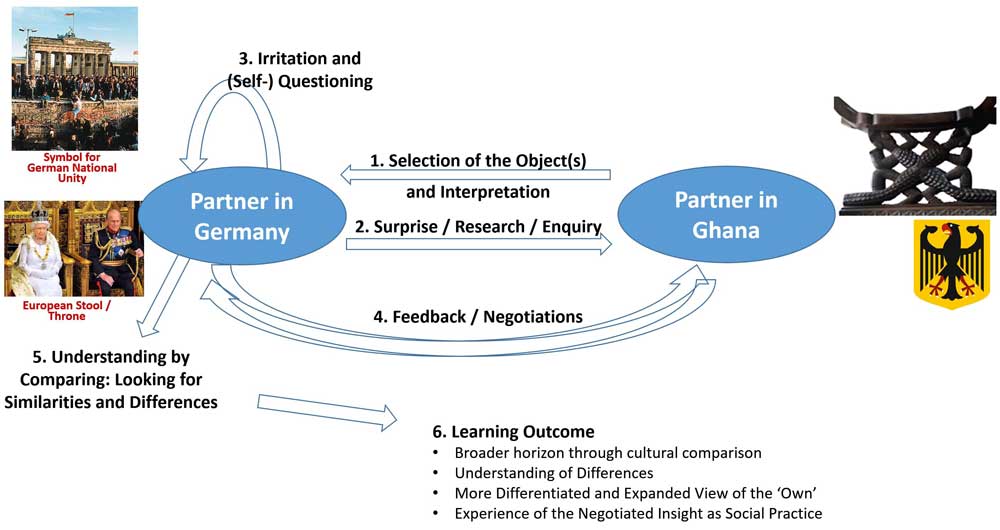
This figure presents a simplified visualisation of an extremely complex dispute that took place over several months - from a German perspective.
- The partners in Ghana selected the stool, interpreted it and made a connection to the German coat of arms.
- The addressees in Germany were very surprised by this, which led to intensive research into the symbols of the Akan culture. Through this, an acquaintance with the unfamiliar form of artistic expression took place.
- But, there was also an examination of the equation of meaning in the German coat of arms. The German team took up various aspects: the idea of the stool as a seat of power with symbolic adornment (as here with the English throne). But, the question of what image could be associated with the theme of "national unity" in Germany led to something quite different: the photo of cheering people on the Berlin Wall in 1989, when the division between the communist-totalitarian part of Germany and the capitalist-democratic part collapsed. This photo is much more anchored in the collective cultural memory than the coat of arms in respect to unity.
- In this way, the interpretations were discussed and negotiated together.
- Similarities and differences between the various cultural symbolisations could be identified,
- In a final reflection, the German team formulated their own learning experiences in this process.
Of course, everything was much more complicated and complex, but for the moment, perhaps the following conclusions can be drawn:
- The team in Ghana presents artefacts that are considered as important for the own context, the team in Germany tries to understand it, but starts a critical discussion when it comes to a German object, the coat of arms.
- The interpretations are negotiated with each other on eye level.
- The objects from Ghana and Germany (the stool and the coat of arms), although obviously completely different at first, are related to each other, come into contact with each other. Complex-entangled interactions of the objects themselves occur.
- What is initially seen as separate from each other becomes entangled in this way. The boundary between ‘one's own’ and ‘the other’ becomes fluid.
- This creates a hybrid intellectual space in which ambiguity becomes a paradigm.
Published August 2022
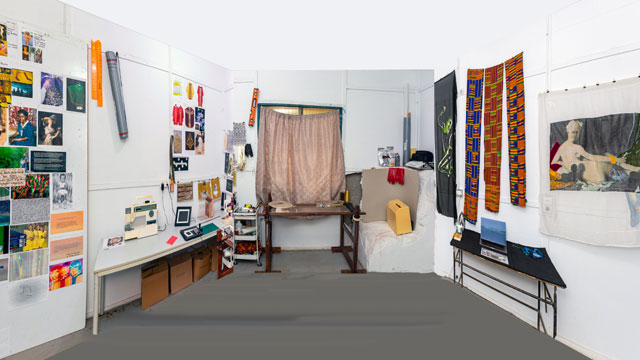
-
 Priscilla Kennedy
Priscilla KennedyCONNECTING THE DOTS
A Pilgrimage.
My studio is literally a skein; an element that forms part of a complex whole. Everything that forms part of its composition to me is like a thread being pulled through the eye of a needle to form a tapestry of narratives as body of works. I have absolutely no idea of what impact the connection of these dots/knots will fabricate or the entirety of its arrival and that to me is where I get immersed in roller coaster of jouissance. That is how the idea of process even in the most pleasurable way becomes an integral part of the context in which I work as an artist.
Unravelling.
Here, I connect the dots/knots within the current situation running through my artistic journey. The space in itself has multiple sub spaces I call ‘moods’’. I swing in-between these moods literally in pursuit of a certain expression towards my interests and concerns. These mood swings take off from my IDEA BOARD (https://www.explore-vc.org/en/galleries-content/idea-board.html) where my thoughts appear partially in flesh. That for me becomes my point of departure into streams of decision making. In totality, it’s a snapshot of all my thoughts as a cohesive whole where I can make choices guided by my ultimate motivation at a given time, on a particular body of work.
Then I swing into my RED BOOK (https://www.explore-vc.org/en/galleries-content/red-book.html) where I narrow down my thoughts into writings as part of a research. In transition from the previous mood of writing to this new mood is the optimum to my purpose, which refers to the making or the tangible expression. I deliberately swing back and forth between these two moods to create a certain dialectical relationship between them as a deliberate and crucial aspect to my practice. This opens up my explorations and discussions of the subject of the body, the politics of marginalization and subjugation from a feminine perspective with the use of materials and techniques connected to a certain body presence (craft).
Enchanted by the Familiar.
I see the body as a fluid material that morphs with time or momentarily based on certain conditions or instances. It is like that one thing that is connected to several things. I am interested in that materiality of the body that allows it to be transient. And in terms of that materiality, what it can become and what it can do.
So, to me, the idea of the female body aside its continuous flux is my interest in something about it that creates a permanent or ongoing relationship with itself. That is how the idea of the hand with regards to craft becomes crucial to my practice. This is in reference to its past and present subtle association with subjugation or oppression or basically how the idea of subjugation and oppression is tied to work categorized in the frame of the domestic. That sense of marginalization or the coupling of an idea to a body that makes it lay claim to a certain power absence is of interest to me.
With the hand, I rethink the value of craft.
Through that there is already an acknowledgement of a certain distance that is brought back to close proximity with the body through intimate artistic approaches like thread embroidery and tambour beading. This is where I swing to my TAMBOUR TRESTLE SPACE (https://www.explore-vc.org/en/galleries-content/tambour-trestle-space.html), here, I make laborious and intimate embroideries that feature beads. I perceive this process of beading as a metaphor in reclamation of the self, while highlighting the residue of power that still lingers within the very same system of subjugation. It is a subtle performance that happens in the studio yet inherent to the context.
A thousand Yards Away and Within.
I am tempted to refer to my whole studio as a bigger idea board where certain themes and artistic strategies come together to form narratives and contributions to subjects of interest. In constant exploration and experimentation, a mash up of all these themes and artistic strategies may birth a work of art that offers a blend of fabric cut-outs merged with beaded patterns or forms in the current state of my practice. Yet, I am open to exploring diverse forms of expressions in relation to the context as time goes on.
Absorbing the Far Fetched.
I connect with materials from a perspective where I perceive them as political instruments that exist in time and not only as objects of enjoyment. I believe in the idea of a common vocabulary in the use of familiar materials and objects because they inherently possess personal and cultural meanings from spaces they have been.
In Pursuit of…
If I’m to imagine my destination (the ideal work) from the swinging I’ve been doing for some time now, I assume I’m going to arrive at a magical tapestry composed of fabric cuts outs of feminine bodies fused with other forms of embroidery that may features threads and beads. These materials and artistic approaches may be composed to create fantastical characters, emerging out of a playful hybridization of the human body and sometimes other life forms.
My destination may not be a narrow one, I believe, but one of diverse interesting processes where I can achieve limitless possibilities in my creative projects. The narratives within the symbolic realm of imagery seek to emancipate the oppressed feminine body through a material and technique culture.
 Ernst Wagner
Ernst Wagner
Fig.2 & 3: Table in front of the window with bead embroideries (Photos: Priscilla Kennedy)
In the photo we see the artist's studio; in it, work tools (such as rubber gloves, a sewing machine, rulers), materials to stimulate the artistic process (e.g. image sources, sketchbooks, materials) and artistic work results. The room is painted white, even the crumbling block in the right-hand corner. This echoes the idea of the "white cube" with neutral walls as a currently still valid basic model for exhibition spaces of contemporary art. Everything is very clean and tidy. On the three tables in the room, materials and tools are arranged like in a still life. For example, on the table in front of the (curtained) window, an arrangement showing, among other things, a round embroidery frame with a bead embroidery that is not yet finished: work in progress. Everything is obviously deliberately placed in this museum-like working space, which thus develops a programmatic expressiveness.
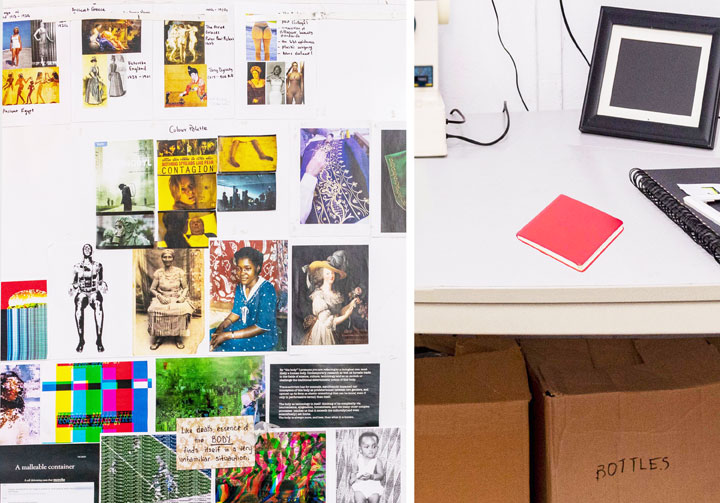
Fig. 4 & 5: Print outs on the wall, red book (Photos: Priscilla Kennedy)
Fabrics, textiles play a major role in this scenario. They are simply material (the kente fabrics on the right) or supports for the two larger works (also on the right). But they also play a major role in the many pictures (DIN A 4 printouts on the left wall), now as depicted clothing: women's dresses in older prints, on works of art (from ancient Egypt) to more recent photographs. Surprisingly, there are images of the vestments of Catholic priests and, beyond that, abstract fabric patterns, ornaments. Working with fabric (which also includes the embroidery frame) is repeatedly found as an important field of work for feminist-oriented artists or for a feminist-oriented visual language in contemporary art.
The DIN A 4 printouts are partly annotated in writing, which reinforces the impression that we are dealing with a "picture atlas" in the sense of Aby Warburg or an "atlas" in the sense of Gerhard Richter, i.e. an often surprising compilation of pictures which in this combination can or should provide very systematic suggestions for pictorial design and for reflecting on contexts.
This also includes the other collections of pictures in the room, in the photo album, on the computer or in transparent sleeves (on the right-hand table), which are obviously often biographically oriented, for example through the baby and children's photos, or through images of their own artistic works.
The overall picture is thus dominated by central aspects of current "global art", an art that could just as easily be shown in Berlin or New York. In this one, however, site-specific aspects, i.e. aspects related to Kumasi, Ghana or West Africa, emerge again and again: the kente fabrics, the photos in the album, even the materiality and construction of the walls speak of the place of origin.
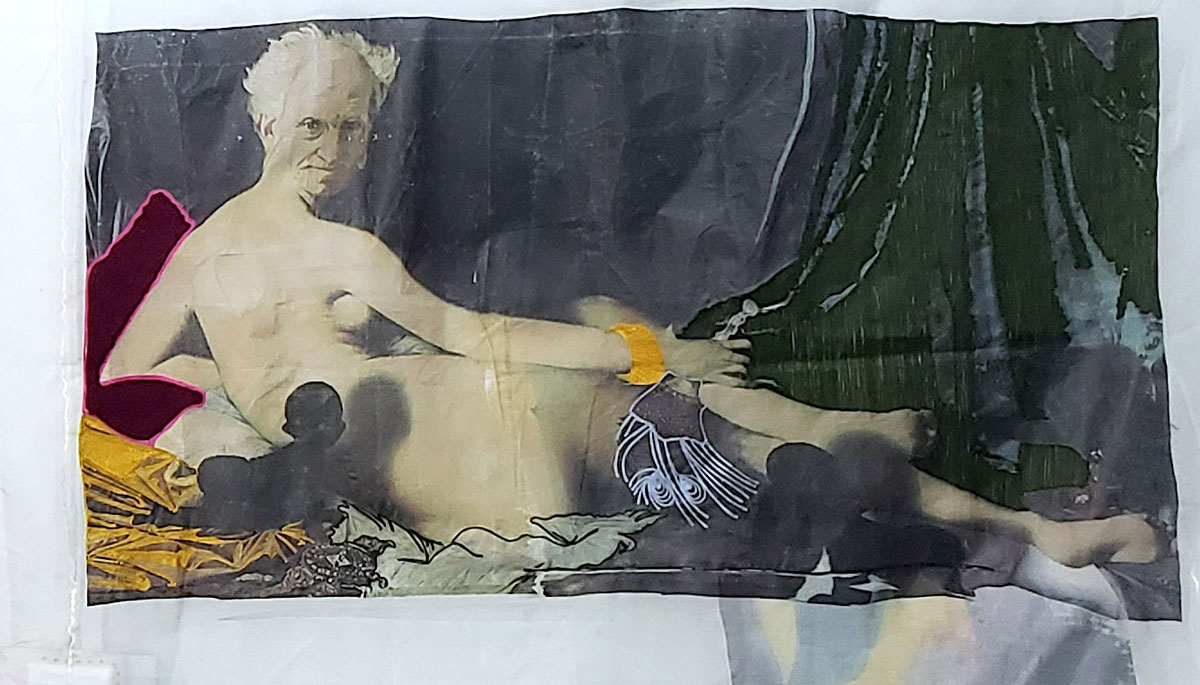
Fig.6: Priscilla Kennedy, o.T., experimental study (courtesy the artist)
This coming together of different thematic layers becomes clear once again in a detail, the painting that the artist presents in her studio on the right wall and which she herself sees as a technical experiment (see illustration below).[1] It shows an adaptation of Ingres' painting "Great Odalisque" from 1814, now in the Louvre. The superimposed head of an older white man (Arthur Schopenhauer) is reminiscent of the same pictorial strategy that the Guerilla Girls successfully tried out with the odalisque in 1989 by putting a gorilla head on it ("Do women have to get naked to get into the Met. Museum?"). While the other elements of the work vary the forms from Ingres' painting, mainly in colour and technique, there is one crucial addition in this work: a small baby in silhouette, black, looking up at Schopenhauer and casting a shadow on the pale odalisque body. The whole thing is printed or embroidered on a transparent, light fabric that throws folds.
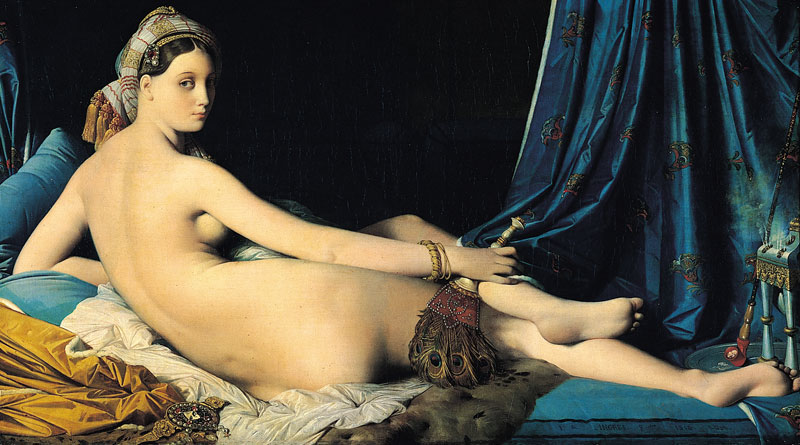
Fig. Ingres, The Great Odalisque, oil on canvas, 1814, Louvre (Copyright CC)
These references make the picture seem familiar to Europeans, but in its combinatorics and with the harsh contrasts it is enigmatic, just like Kennedy's studio itself. Here, an icon of Western art is cheekily alienated, here the canvas becomes a thin nettle, here the woman becomes a man, the soft cushion becomes a hard wedge, the white woman gets a black baby. On the one hand, objects and their meanings are thus unambiguously designated and named, but at the same time, through the artistic formulation and its combination, they are placed in an enigmatic resonance space, which immediately eludes the unambiguous settings that have just been made. An "in-between space" between black and white skin colour, man and woman, opaque and transparent, old man and young child, European (old) art and West African (young) art.
If one looks back through this image (which is taken here - against the artist's intention - as a key image) to the studio, one finds very similar constellations there: empty chasubles of Catholic, i.e. male priests against female bodies in erotically charged clothing, falling, soft fabrics against rigid measuring instruments from geometry lessons, physicality against abstract patterns and ornaments. With such contradictions Kennedy creates an experimental constellation, she spans a field that reports on possibilities in between without letting them culminate in a final work. The open, unfinished field of experimentation thus becomes the actual "work".
[1] "This work does not have a title. I considered it as an experiment to try printing with a blend of embroidery. What is actually piercing through from the back is also part of the experimental process where I made heat transfers again behind the fabric to see the interplay of images from various directions of the material. I do not consider it as a work but as an experiment. " (Information from Kennedy to the author via email on 5.10.2022)
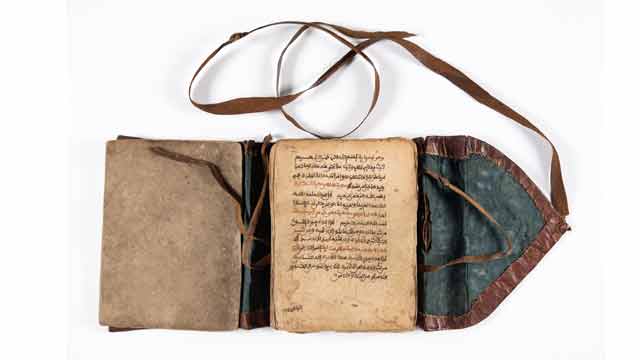
-
 Mahmoud Malik Saako
Mahmoud Malik SaakoThe Qur'an is typical for the time and the West African region in general. The idea originated in North Africa such as Morocco and Algeria. But the writing was later, influenced by the Hausa and Mande scholars in West Africa. The texts in this Qur'an are the same as the original from Arabia. But there are differences in the kind of calligraphy found in these Qur'ans and those found in Arabia. One important aspect of these Qur'ans is the calligraphy that comes after the beginning of a new chapter or Surah. Again, the use of red, gold and black colour in writing the Qur'an makes them unique.
Artistic features of the Qur'an
- The leather cover used to protect the Qur'an was designed with some relief using black ink. It shows that leather workers were very important in society. Similar covers are made but in a form of a bag for the Qur'an while others are wooden covers with a leather thong used to hold the wooden covers together with the Quran.
- The Holy Qur’an has Ayahs (words or verses) and Surahs (chapters). There is Bismillah before each Surah. The Qur'an has 114 Surahs or chapters.
- Calligraphy works in some portions of the Qur'an. Calligraphy as the art of beautiful, decorative writing has existed in Islam since the word of God, the Qur'an, began to be written. In West Africa which was known to the Muslim world as Bilad-al-Sudan (land of the blacks), Islamic calligraphy naturally came with Islam. They are just symbolic to honour the holy text.
- The use of three colours in writing such as gold, red and black: This shows how versatile the person was in giving an artistic impression of the Qur'an based on the Kanemi
- A large decorated sign known as shurafah (ennoblement) is written at the end of every fifteen hizb (that is the division of the Qur’an into parts and portions). This is done as a means of honouring the holy text. (See images below.)
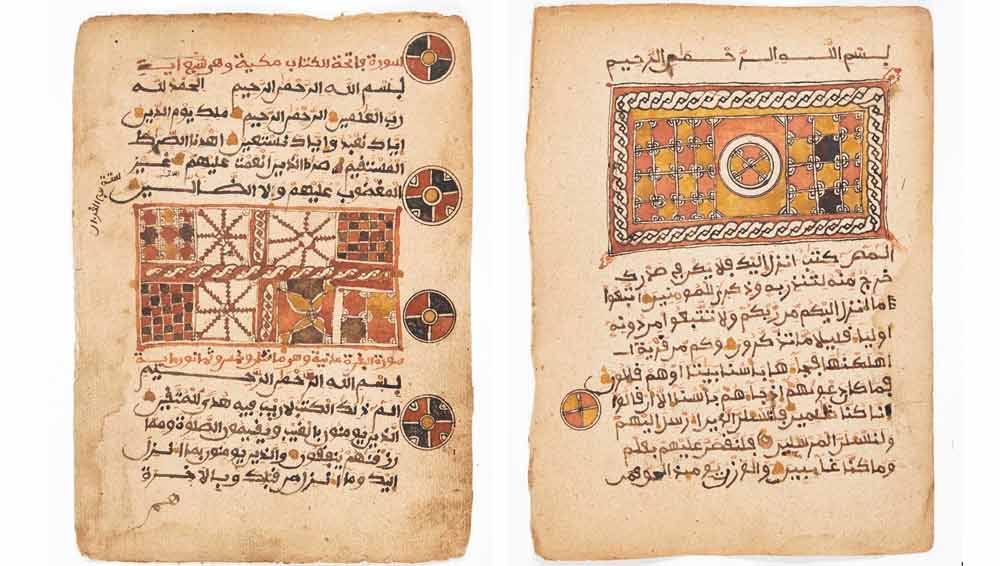
The shurafah or ennoblement at the beginning or end of a chapter (surah) is indicated in the two images. The gold, red and black colours are used to give it a splendid look. (Qur’an. 16th-17th century. Mossi in Togo. Museum Fünf Kontinente Munich. Courtesy Museum Fünf Kontinente. Nr. 20-3-1. https://onlinedatenbank-museum-fuenf-kontinente.de/detail/collection/b77d064f-c603-493c-af03-fc167f739586. [Stand: 08.08.24]. Photo: Nicolai Kaestner)
Material used for the Qur'an
The paper used is brown and a bit hard as compared to today’s paper used for printing. The ink is mixed in a variety of colours. There is jet-black ink that shines. Then there is a colour of black mixed with red and another colour which is neither black nor red. The ink is obtained through the following method. The roots of the desert date tree are collected and burnt into charcoal. This charcoal is then scraped into fine powder. The powder is filtered through a light piece of cloth. Water and gum Arabic are then added and the whole mixture is left to warm up in the sun. The mixture once prepared in this way gives out a very nice smell and its taste is very sweet.
Another method employed to produce the calligrapher's ink is to obtain the chaff of bulrush-millet (Pennisetum Spicotum), chips of the gum-yielding acacia (sieberiono), pods of the plant Egyptian mimosa (Acacia Arobico), slag from smithy and some bits of iron. All these items are then mixed with water. The mixture is filtered and boiled and once it is cooled it becomes ink. If the calligrapher wants a reddish colour or magenta colour imported dye of green or magenta colour is added. This type of ink is meant for the writing of the alphabet only and is always done in pure black. The ink is usually stored in small clay ink pots or small round gourds. The recent time, the ink is kept in small bottles.
What are the general specifics of these early Qur’ans?
The Qur'an is the holy text of the Islamic religion. In Islam, the Qur'an is believed to be the book of God’s words. The holy text remains sacred and unchanged since the beginning of time. The Qur'an is known as the most powerful text in Islam. Islam is a monotheistic faith and people of the religion take great pride in believing in pure monotheism. As followers of the Qur'an, Muslims must believe there is no one else besides Allah because Allah is the only one we worship sincerely, thus he is seen as the most powerful figure in the religion of Islam.
The Arabic text of the holy Qur'an in a book is known as the mus-haf (literally "the pages"). There are special rules that Muslims follow when handling, touching, or reading from the mus-haf. The Quran itself states that only those who are clean and pure should touch the sacred text. It is indeed a Holy Quran, a book well-guarded, which none shall touch but those who are clean... (56:77-79). The Arabic word translated here as "clean" is mutahiroon, a word that is also sometimes translated as "purified."
It was only Muslim believers who are physically cleaned through formal ablutions should touch or handle the pages of the Quran. Again, the Qur'an should be closed and stored in a clean or respectable place. Nothing should be placed on top of it, nor should it ever be placed on the floor or in a bathroom. Furthermore, when copying the Qur'an by hand, it should be legible with good handwriting. If you are reciting it you need to use a clear and beautiful voice. A worn-out copy of the Quran, with broken binding or missing pages, should not be disposed of as ordinary household trash.
Acceptable ways of disposing of a damaged copy of the Quran include wrapping it in cloth and burying it in a deep hole, placing it in flowing water so the ink dissolves, or, as a last resort, burning it so that it is completely consumed. But the translated Qur'an according to some scholars can be handled either by Muslims or non-Muslims.
Uses of the Qur'an
The Qur'an is meant for reading or recitation known in Arabic as taliwa. The recitation of the Qur'an is a highly honoured performance in Islam in which Allah blesses both the reciter and the listener. A person who memorizes the whole Qur'an is given the honorary title of a Hafiz (memorizer of the Qur'an). Again, the reproduction of the written Qur'an is as important as oral recitation. Two early calligraphic styles evolved in the writing of the Qur'an, Kufic (the more boxy, angular, heavy, and formal script) and Naskhi (the more elongated, rounded, cursive script).
The words in the Qur'an are regarded as the words of Allah and, therefore, handled with respect. Muslims also hold the view that some of the words contain mystical properties and as a result, Muslim religious scholars are sometimes consulted by people who have spiritual or psychological problems. They write verses from the Qur'an to ward off such evil spirits or for protection. The Qur'anic verses are often accompanied by diagrams drawn on a board and then washed off and given to the client to drink. As a result, these boards have high values based on the extent they have been used. It is believed that the older the board the more efficient it would be and vice versa.
At the Museum, there is one of the Qur'anic writing wooden boards that have verses from the Quaran on one side and diagrams on the other side. This board is brown and round at the base with a handle in a form of an animal beak. The surface is smooth while some old writing has remained and can be seen (see image below).
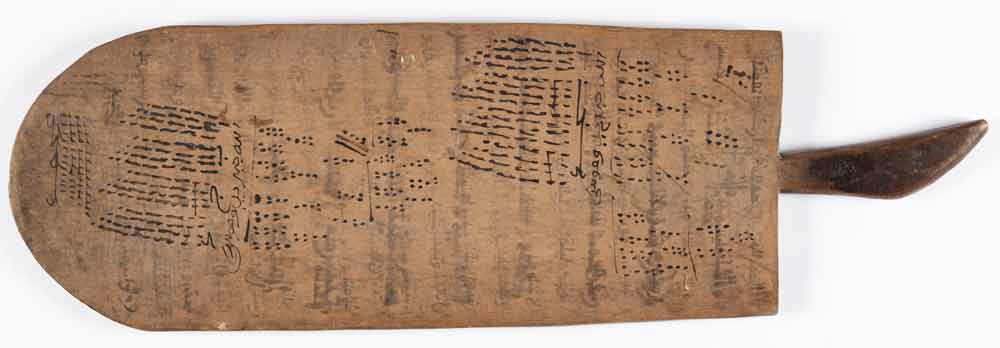
Board (Courtesy Museum Fünf Kontinente. Nr. 9-48. Photo: Nicolai Kaestner)
Where is the Qur’an kept?
Old Qur'ans were usually placed in two wooden covers before the use of leather cases or bags. It was easy to carry it once it was placed either in the wooden covers or in the leather bag. This is very important not to mess up the loose papers of the Qur'an. The two wooden covers after the Qur'an is placed and bound with a thong. There are two holes in the middle edge of the covers where the thong is passed through to bind the two wooden covers with the Qur'an. This method of bounding the Qur'an with wooden covers was practised during the early Abbasid period. Many of the early Abbasid manuscripts were copied into several volumes based on the Kufic script which was fairly heavy and not very dense. The Qur'ans of this early period were bound in wooden covers, structured like a box enclosed on all sides with a movable upper cover that was fastened to the rest of the structure with thongs. In this period, the Quran was arranged into 20 Juz or parts instead of the original 30 Juz during the Umayyad period. These wooden covers can be found at the Museum Fünf Kontinente (Inventar Nr 15-17-148).

Wooden cover of a Qur'an. Museum Fünf Kontinente. (Courtesy Museum Fünf Kontinente. Nr. 15-17-148. Photo: Nicolai Kaestner)
Appendix
When is it read and how?
It is read during the five daily worship by Muslims, at leisure times, during periods of hardship, during important occasions etc. However, in West Africa, it is read even at funeral celebrations. In many instances, the whole Qur'an is shared among those who can read, or the 30 Juz are shared among 30 people who recite or read it.
Islam in West Africa
Islam as a religion was revealed to the Prophet Mohammed in the 6th century in the Arabian Peninsula. Africa was the first continent into which Islam spread, from the Arabian Peninsula in the early 7th century. By the 10th century, the Berbers of West Africa were converted to Islam by their North African counterparts. It was the Berber Muslims who began to spread Islam into Western Sudan by the end of the 10th century through their trading activities. The Berbers of West Africa also converted some of the Manding-speaking traders to Islam, and they also began spreading it alongside their commercial activities. It was the Mande traders who began to spread Islam into many parts of West Africa through trading activities. The nature of Islam made it easy for the indigenous people to accept it as adherents were able to tolerate, to some extent, some of the local beliefs.
Later, the Hausa from northern Nigeria were also involved in the Kola-nut trade in the mid-15th century. The rulers of many of the Western Sudanese States encouraged the trans-Saharan trade and extended hospitality to both traders and visiting Muslim clerics. The most crucial factor in the diffusion of Islam into many parts of West Africa was the conversion of some of the rulers to Islam. Between the 14th and 16th centuries, many rulers of the Mali and Songhai empires were Muslims and performed the annual Islamic pilgrimages to Mecca to establish trade relationships with the Muslim world. It was during the era of European colonization of West Africa that led to the spread of Christianity among the locals.
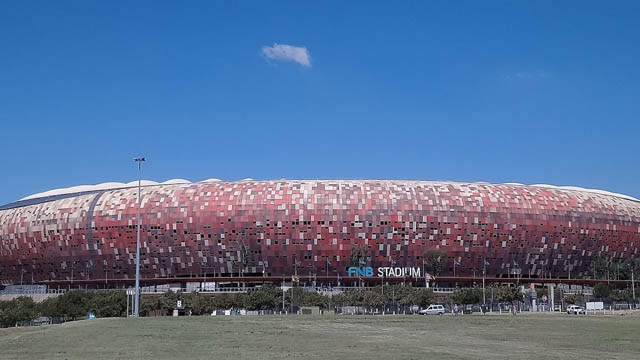
-
 Esther Kibuka-Sebitosi
Esther Kibuka-SebitosiSouth Africa gained its independence in 1994 with Nelson Mandela becoming the first black President on the fall of apartheid. The problem was: Even after the demolition of the apartheid system, social cohesion was a challenge as people still lived and gathered in separate groups, according to their race. Freedom had come but the people still segregated themselves. One of the ways to promote social cohesion is through sport. The hosting of the 2010 World Football cup therefore was a welcome opportunity.
The photograph shows the First National Bank Stadium or simply FNB Stadium. It is also known as the Calabash, because of its resembling an African vase. It is located near Nasrec and bordering Soweto and Johannesburg.
The Department of Arts and Culture defines Social cohesion as “the degree of social integration and inclusion in communities and society at large, and the extent to which mutual solidarity finds expression among individuals and communities”. This means that South African communities or society is cohesive when “ the extent that the inequalities, exclusions and disparities based on ethnicity, gender, class, nationality, age, disability or any other distinctions which engender divisions, distrust and conflict are reduced and/or eliminated in a planned and sustained manner. Thus, with community members and citizens as active participants, working together for the attainment of shared goals, designed and agreed upon to improve the living conditions for all”.
Based on the above understanding, building a nation is a complex process that entails “a society with diverse origins, histories, languages, cultures and religions come together within the boundaries of a sovereign state with a unified constitutional and legal dispensation, a national public education system, an integrated national economy, shared symbols and values, as equals, to work towards eradicating the divisions and injustices of the past; to foster unity; and promote a countrywide conscious sense of being proudly South African, committed to the country and open to the continent and the world“.
The hosting of the World Football Cup therefore was an optune moment in the history of the nation. According to Barolsky, (2011) sport was used as a catalyst to build a non-racial, non-sexist, democratic, prosperous and free South Africa. The FIFA World cup in 2010 referred to it as „African and South African. The Bafana Bafana team received great support from home. The social cohesion was divided into three dimensions: Civic, Social and Economic."
The impact of the FIFA World cup was significant in building social cohesion. There was little doubt that the World cup was an “extraordinarily unifying moment for the country as whole, which broke down social, racial and even gendered barriers as women were increasingly drawn into the fervor around the a game usually predominantly watched by men.” (Barolsky, 2011)
References
- Barolsky, V (2011).Impact of 2010 soccer World Cup on social cohesion and nation-building, Technical Report · January 2011.
- DOI: 10.13140/2.1.2007.5841
- Retrieved from https://www.researchgate.net/publication/271700976
- Department of Arts and Culture statement on Social Cohesion
published April 2020
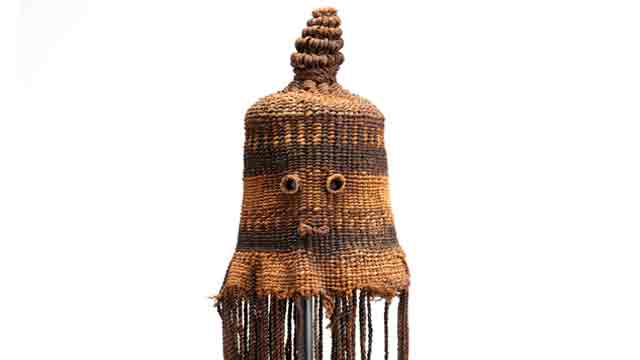
-
 Njeri Gachihi
Njeri GachihiMeaning
Ingolole serves several purposes in the circumcision ritual. It serves to mystify the ritual and more so the initiate. While wearing almost identical masks, the initiates become undisguisable in this full seclusion regalia. It is believed that even evil spirit sent would have a problem identifying the target and hence revert to sender. On the other hand, the masks also serve to wade off and scare women and children who are not supposed to interact with them during the seclusion. Even when they go out of the forest and make processions on major roads singing and dancing, the women and children should stay away. Part of the chants, dance and singing done is meant to break loose ‘childhood/boyhood’ which is symbolized by the breaking of the crown - palm reeds attached on the ingolole. Some do manage to break it which is a sign of physical strength and masculinity as well as spiritual and ritual wellbeing.
The dance that the initiates perform is know as bukhulu/bakhulu which means elder. Bukhulu henceforth, cosmologically viewed, means unity with the ancestors and is also used to symbolize fertility or the life-giving seed (seminal fluid). The effort of breaking the reed henceforth translates into becoming an adult and gaining all the permission to undertake the adult roles and the responsibilities associated with it. This means that this right gives the initiate the ability and power to engage in full conjugal and social responsibility. Last but not least, the initiates spend a lot of time in the open. Ingolole then serves to protect them from the scorching rays of the sun, protect them from sweating too much when dancing and at night serves to protect them from biting cold, wild animals and insects.
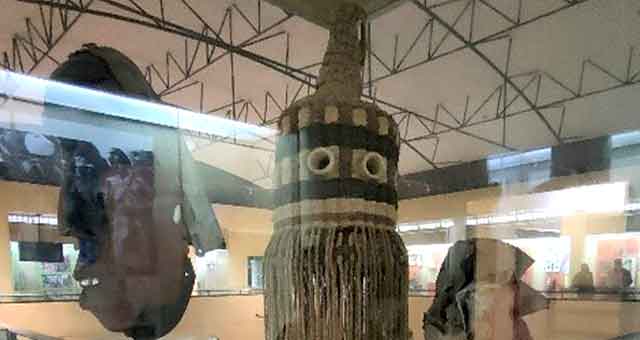 Cutout: Presentation at Nairobi National Museum, Ingolole (Circumcision Mask), Museum Fünf Kontinente and Nairobi National Museum. Photo: Njeri Gachihi.
Cutout: Presentation at Nairobi National Museum, Ingolole (Circumcision Mask), Museum Fünf Kontinente and Nairobi National Museum. Photo: Njeri Gachihi.Is Ingolole an Artwork or a Ritual Object?
The ingolole as a form of ritual art, seems to bear witness to the resilience of the Tiriki culture; what Bakhtin might have called the 'carnivalization of the social order'. A central reason for using this mask, it seems, is to affirm the Africanization of the arena, both public and private, where a culturally appropriate image reigns. The mask usually invests the wearer with signs of power over evil, while modelling him on the norms of masculinity and respectability. The ingolole is one item of art that is yet to be transformed from artefact to curio (or momento). This is apparently so because its mechanism of distinction is yet to mobilize political as well as economic categories. This mask resonates well with the notion that visual art communicates cultural values. It is a complex ideological communication that derives its symbolism and references from culture. Yet it also draws its form and content from the fundamental tenets of the magical appropriation of power through the manipulation of depiction and elucidation.
Therefore, the Tiriki Circumcision mask, Ingolole is not only an artistic representation. It is a ritualistic object that embodies several meanings. It is known to invest the wearer with signs of power over evil - in that the wearer is set apart from his enemies that would intend to inflict harm. It is believed that the evil spirits sent to cause harm on the initiate would find it difficult to positively identify the initiate. At the same time, it causes mystery around the initiates making their looks terrifying and hence keeping off those who are not permitted to come near newly initiates. Physically, it protects the young boys from scorching sun, biting cold and insects while in seclusion. Once ingolole is used, it is kept and passed on from generation to generation. A used one is still valuable to the family and must be kept safely to avoid causing harm to the members of the family. Hence, this is an item of art that cannot be easily transformed from a ritualistic artefact to a simple curio craft.
There are not many Ingolole’s in our Museum in Nairobi. Two are however exhibited in the permanent exhibition, Cycles of life, at the Nairobi National Museum.
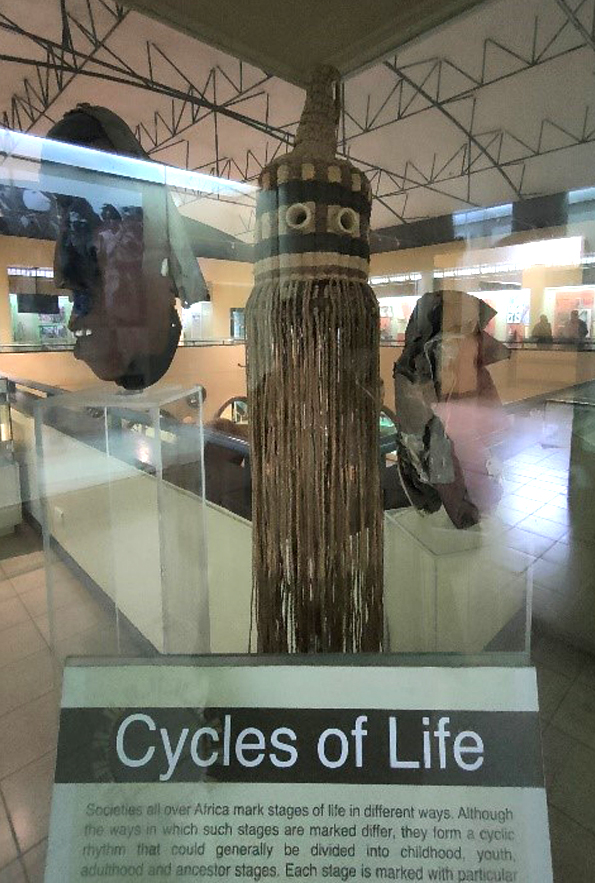 Presentation at Nairobi National Museum, Ingolole (Circumcision Mask), Museum Fünf Kontinente and Nairobi National Museum. Photo: Njeri Gachihi.
Presentation at Nairobi National Museum, Ingolole (Circumcision Mask), Museum Fünf Kontinente and Nairobi National Museum. Photo: Njeri Gachihi.
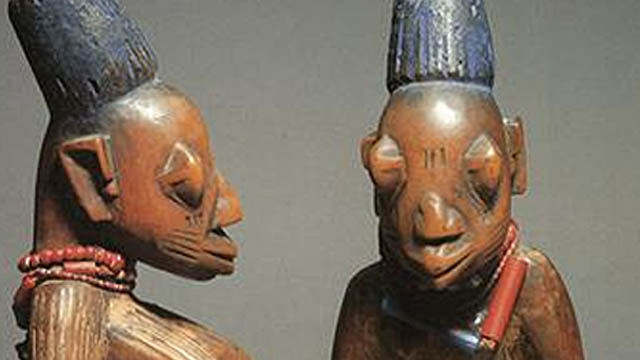
-
 Ebenezer Kwabena Acquah
Ebenezer Kwabena AcquahHistorical link between the Ga and the Yoruba
It is believed that the Ga-Adangbe came from Ile Ife at Yorubaland in Nigeria through Seme, a settlement on the border between Nigeria and Republic of Benin of today. According to popular oral traditions, the groups migrated together crossing the Mono River but scattered after crossing the Volta River (Nortey, 2012). They settled on the Accra plains within the south eastern corner of Ghana (Kilson, 1974). Their initial administrative capital was Ayawaso but was later moved to Accra, as Ghana gained its independence in 1957 and Accra became the capital city of Ghana.
Indigenous belief system among the Ga and Yoruba
The Ga, like other ethnic groups in Ghana and Nigeria, believe in life after death. They demonstrate this belief through comprehensive funeral rites. The type of occupation the deceased engaged in on earth while alive is believed to continue in the next world and as such a coffin is carved to depict the work of the deceased for their burial. The Ga, just like the Yoruba people, belong to Islam, to Christian faith or to traditional religious beliefs (Leroy, Olaleye-Oruene, Koeppen-Schomerus, & Byrant, 2002). They believe in the immortality of the soul and on its re-birth, which are both essential to the Ibeji twin belief.
The Ibeji sculptural figures in perspective and their aesthetic considerations
The Ibeji figures among the Yoruba provide an insight into the recognition of twins within the Yoruba society. The visual sculptural form presents the viewer with a glimpse of what the Yoruba society cherishes through the lens of visual culture. The two figures are presented in semi-abstract forms showing a male and a female (based on genital characteristics). It also shows the relevance of beads in body adornment as found in their usage in the form of necklace, wrist-bands, and waist-bands. On the heads of the figures are scarifications (marks on the body) and both figures are holding a string of cowries.
Cowries were extensively used during pre-colonial times in Africa as symbol of wealth and used as currency and medium of exchange, for symbolic messages, as objects of divination, as jewelry and as a religious accessory, as well as a powerful force that represents the eye of the gods and the womb of the goddess (Yiridoe, 1995; Wayne, 2010; Odunbaku, 2012). Also, the projection of the breasts of one figure is an indication of a female with youthful exuberance.
The pronounced shapes in the figures are curves with minor angular forms in feet and ears. Both figures also show projecting and rounded forehead which are basic characteristics of many African figures. The head-gear is cylindrical and this is similar to that of the Dipo initiates among the Krobo of Ghana who are related to the Dangme.
Though the basics of African aesthetic differ across cultures, the common ones would include symbolism, togetherness, luminosity, craftsmanship, self-composure, and youthfulness (Molokwane, 2010; Vogel 1986). In the Ibeji figures, it is envisaged that a culture of teamwork was involved in the production process, from the felling of the tree through carving to the finishing of the statuettes, building a sense of communal unity. The craftsmen usually work with a master-craftsman. In terms of craftsmanship, the figures are sculpted intricately, with exquisite details, body adornment, and to excellent finish that has made them stand the test of time.
Symbolism is embedded into traditionally African made objects and the Ibeji figures are no exception. They have elegant glossy finishes that portray purity and well-being/good health. The author considers the statuettes (reference to the Ibeji figures) as being young: vibrant, healthy, and a source of strength.
Recognition of twins in Yoruba and Ga societies
In many traditional African societies, twins are considered of supernatural origin and raised emotional reactions ranging from fear and dislike to hope and joy (Leroy, 1995). It is believed that twins are able to grant happiness, health and prosperity upon their family. As such, their nurture is far more venerated than that of other children (Stoll & Stoll, 1980).
Another similarity in terms of belief and practice between the Ga and the Yoruba is that twins share the same combined soul, and it is envisaged that when a new-born twin dies, the life of the other is exposed because the balance of his soul has become disturbed. To forestall any danger, a special ritual is carried out. Though the Yoruba carve a small wooden figure as a symbolic substitute for the soul of the deceased twin, the Ga only perform the ritual. If both twins have died, two of these figures are made among the Yoruba. These statuettes are called Ere ibeji (from ‘ibi’, meaning born and ‘eji’, two; ere means sacred image).
The Ga believe that the twins are special messengers from the Supreme god and therefore highly revered. They also believe that they could bring either a good or bad omen to the society based on the way they are treated. The Yam Festival which falls on the Friday of the Ga Homowo festival celebrated in August, presents a special occasion for twins in the Ga community who are presented with special feast in a form of sumptuous meal and mashed yam with eggs. It is honouring the twins in the traditional families (Nortey, 2012).
During the Homowo festival celebration on Friday, twins carry herbal mixture (leafy concoction) called “baa woo” that is prepared in metal containers and they move through the township in a frenzied manner amid singing and chants. The special concussion is believed to induce fertility and as such people bath themselves with it with the hope of bearing twins.
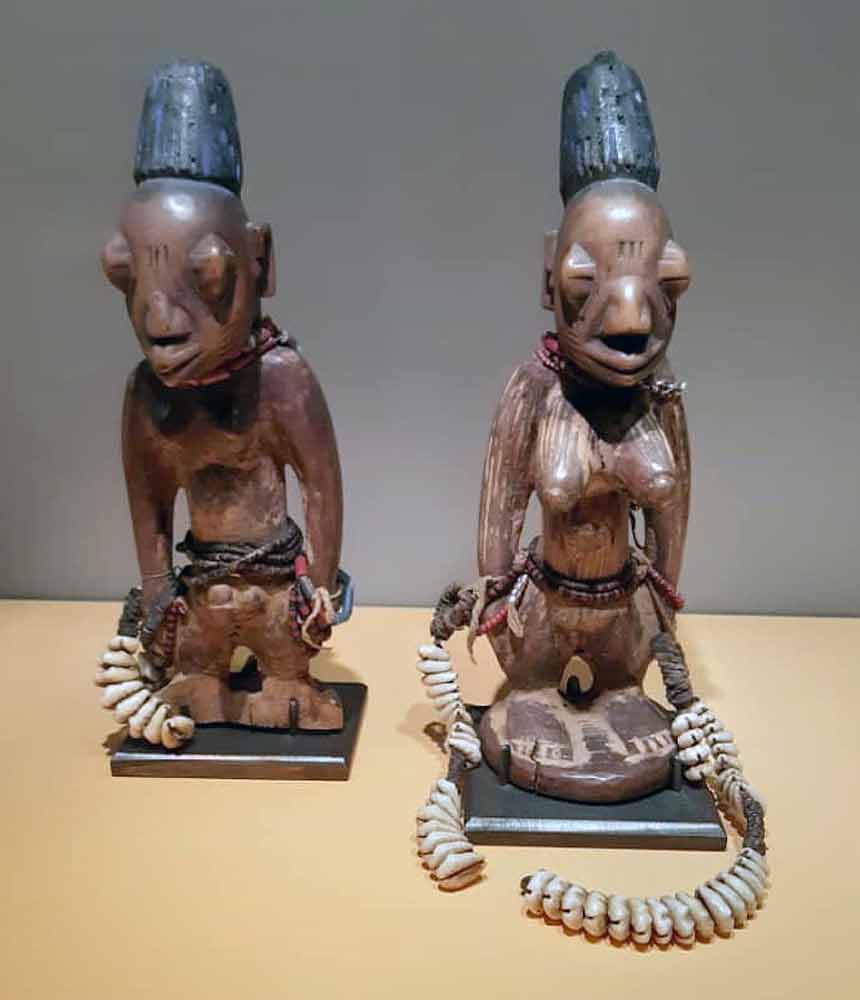
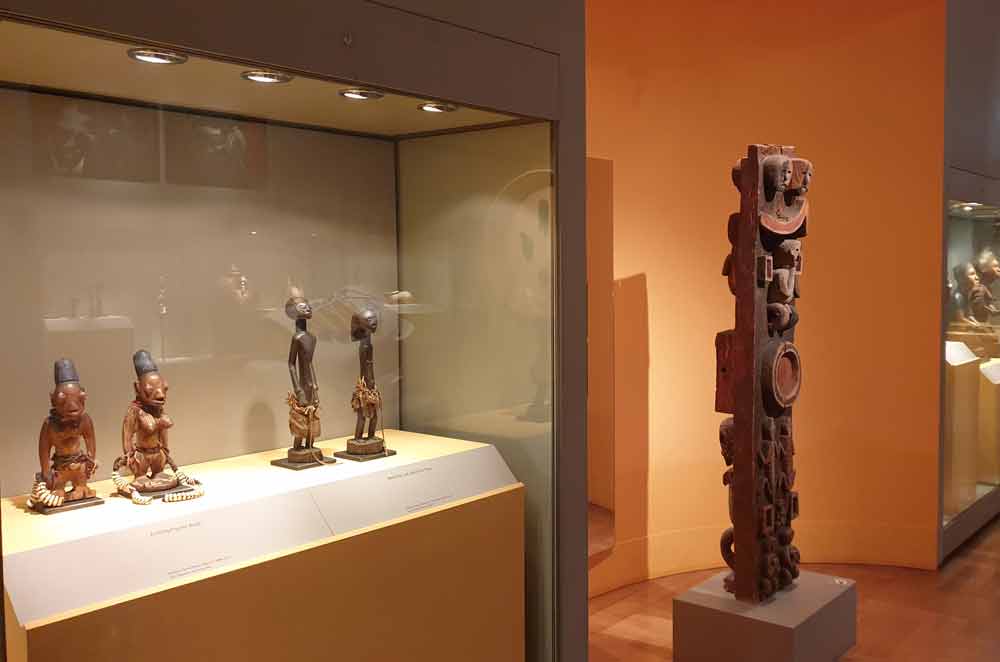
Unknown artist. Ibeji Twin Figures of the Yoruba. Presentation in the museum. First half of the 20th century. Wood, red chalk, cowries, glass. Height 27,5 cm. Museum Fünf Kontinente, Munich. © Museum Fünf Kontinente
Conclusion
The belief in reincarnation and life after death are linked to the Ga and Yoruba ancestor belief. As part of the veneration of twin in families, the Yoruba carve Ibeji figures that has symbolic and spiritual relevance among the people. Among the Ga and the Yoruba, twins are revered and honoured. Furthermore, the two societies believe that every human soul has a chance to return to earth as a new-born, mostly within the same family. The wellbeing of any family is dependent on that of its ancestors and twins. Therefore, periodic prayers/rites are said and sacrificial gifts are presented to ancestral deities, including the Ibeji figures.
References
- Kilson, M. (1974). African Urban Kinsmen, The Ga of Central Accra. London: C. Hurst and Co. Ltd.
- Leroy, F. (1995). Les jumeaux dans tous leurs états. Louvain –la - Neuve [Twins in every state], Belgium: DeboeckUniversité.
- Leroy, F., Olaleye-Oruene, T., Koeppen-Schomerus, G., & Bryan, E. (2002). Yoruba Customs and Beliefs Pertaining to Twins. Twin Research, 5(2),132-136
- Molokwane, S., & Shorn, B. (2002). The African aesthetic as it informs the product form. In:Computer-Based Design. Proceedings of the Engineering Design Conference, King’s College, London, 9 -11 July 2002.
- Nortey, S. (2012). Artistic Evolutions of the Ga Mashie Twins Yam Festival and Its Cultural Implications. Arts and Design Studies, Vol. 2, 2012.
- Odunbaku, B. J. (2012). Importance of Cowrie Shells in Pre-Colonial Yoruba land SouthWestern Nigeria : Orile- Keesi as a Case Study. International Journal of Humanities and Social Science, 2(18), 234-241.
- Vogel, S. M. (1986). African Aesthetics. New York: Center for African Art.
- Yiridoe, E. (1995). Economic and Sociocultural Aspects of Cowrie Currency of the Dagaaba of Northwestern Ghana Aspects. Nordic Journal of African Studies, 4(2), 17-32.
This article is part of a gallery: Perspectives from Ghana on Museum Objects in Germany
Published January 2021

-
 Kerstin Pinther
Kerstin PintherAs a miniature, the sculpture Indépendence Tchao (2014) by the Franco-Algerian artist Kader Attia refers to the Hôtel de l'Indépendence in Dakar, Senegal. At the beginning of the1970s – a little over ten years after the independence of the west African country under Lépold Sédar Senghor and a few years after the first Festial Mondial des arts nègres (1966), the hotel was built by Henri Chomette and Roland Depret. Since the end of the 1940s and into the 1980s, the office of the French architects had built governemental and private buildings and others in numerous African countries. Indépendence Tchao was initially created as a site-specific installation on the occasion of the 11th Dakar Bienniale in Senegal. It refers back to the hotel high-rise with the sculpture; the ‘borrowing’ can immediately be recognized, above all by its characteristic brise-soleil façade. Kader Attia used discarded and somewhat rusty inex index boxes, stacked on top of each other. The inventory of the archive itself came from a dissolved administration in Algeria. Only a few kilometres away from the central exhibition venue of Dak'Art, the hotel still forms a striking, decidedly 'modern' architectural antithesis to the flat neo-classical colonial administrative buildings - an aesthetic incunabulum that symbolized the future in its outstanding verticality and modern furnishings. However, the former architectural icon is now empty and in a state of decay. Indépendence Tchao (the title is a reference to the famous song Independence Cha-cha from 1960/Kalle) thus refers both to a utopia that has grown fragile, the bursting of a dream; as well as to the persistence of colonial archiving and (also structural) standardization practices, to old and new (architect) networks in the postcolony.

Attia, Kadar. Pascale, Fernand Pouillon, Alger. 2012
https://inferno-magazine.com/2012/06/23/kader-attia-le-corps-utopique/ [Stand: 28.10.24]
Two further - this time photographic - works by the same artist also address the ambivalences and potentials of modern architectural promises: In the case of the photograph of a woman, seen from behind, surrounded by the mighty arcades of the 200-column courtyard, the connection between the body as the 'first architecture' and the 'built' architecture is central. Not least through the title Pascale, Fernand Pouillon, Alger (2012), it becomes apparent that the person is a transsexual. According to Attia in an interview, the strangeness in one's own body corresponds to the 'architectural' alienation that the inhabitants of the 'Climat de France' who had resettled from the Kasbah in Algier must have felt in the 1950s; the necessity of appropriation, re-territorialisation or even 'becoming at home' applies to both bodies (the human and the architectural).
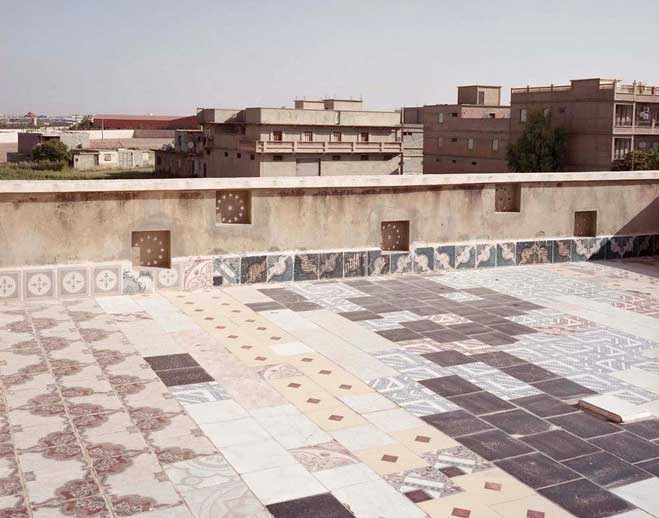
Attia, Kadar. Déconstruir - Reinventer. 2012
https://slash-paris.com/en/evenements/construire-deconstruire-reconstruire-le-corps-utopique/sous/3669 [Stand: 28.10.24]
A reflection on transgression and imagination also lies at the centre of another photo: Déconstruir - Reinventer (2012) actually shows only the results of a minimal intervention in the standardized construction method, and yet these traces of spatial action are marked here as meaningful in the sense of aesthetic place-making.
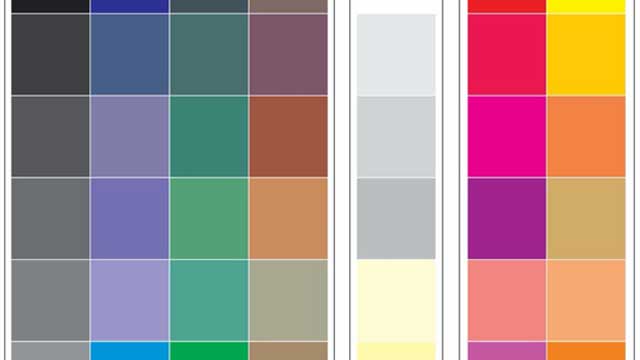
-
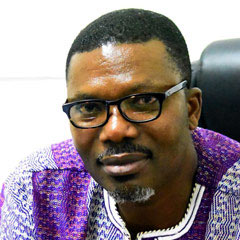 Patrique deGraft-Yankson
Patrique deGraft-YanksonAkan definition of Colour
The Akan people have no precise terminologies that assign a ‘name’ which interprets into the meaning of colour the way it is understood in English and other languages. In other words, most of the answers to the question ‘what is colour’ makes very little meaning to a pure Akan speaker whose understanding of colour transcends a scientific definition. In spite of several efforts by contemporary linguists to subject the Akan concept of colour to nomenclatural consideration, the traditional Akan people continue to describe hues by their relationship with similar colours in nature.
Consequently, terminologies in Akan, which are associated with the word colour, are likely to describe what a hue looks like in association with the natural (or in few occasions, manmade environment) or how a hue makes one feel, think or behave. Among numerous attempts at coming up with an Akan word for ‘colour’, the ones many respondents settled on were yɛbea, subea, su, husuo, ahusuo and bↄbea. These words, which mean almost the same in Akan, literally describe the nature, quality or, probably more precisely, the physical look/appearance of something. By implication therefore, the terminologies deduced are more general and their usage go beyond the description of just the colour of an object or a situation under discussion.
Colour names
Colour names among the Akan people, are often given directly after identifiable objects within the known environment. Therefore, names given to colour in Akan have the tendency of affecting the perception, understanding and accurate adaptation of colour among the Akan people. Name, like colour itself, has strong cultural significance. Therefore, names that are understood in one’s language are likely to have better cultural associations and connections with their people than those that sound foreign.
In this regard, many Akan people are of the opinion that all efforts at identifying names for colours should continue with the culture of associating colours with the local names of known objects among the Akan people. For instance, if there are names such as ahabanmon (fresh leaves) for green and akokↄ serade/akokↄ aŋoa (chicken fat) for yellow, there could also be names like ahabanfunu/ahatawfun (dead leaves) for brown, gyafrane/gyanframa (fire flames) for orange, gon/dwene (gray hair) for gray, etc.
Number of colours
The number of colours recognizable by a traditional Akan are as many as those identifiable and describable in nature. As already indicated however, recognized Akan colour names and their identification are mostly in relation to those discernible in nature, for which reason their descriptions are broadly categorized. The following are colours available in the traditional Akan language.
- Kↄkↄↄ (Red)
To a very large extent, kↄkↄↄ, the sound of the name of the colour identified as red among the Akan people is more onomatopoeic than semantical in interpretation. Kↄↄ, the root word, visualizes the sensation of the word glow. Therefore, kↄkↄↄ actually connotes more to complexion with a strong bright colour. It commands an ambience of hot brightness, usually with scorching visual sensation, rather than a simple colour name. For this reason, kↄkↄↄ is attributable to all objects that emit some warmth in their visual ascriptions. Therefore, whilst a ripe pepper is described as kↄkↄↄ, ripe mangos, ripe oranges, glittering gold, burning coal, sunny skies, flames, the skin of a ‘white man’, etc. are all kↄkↄↄ as well. In the Akan colour scheme therefore, colours that could be placed analogous to kↄkↄↄ include red, orange, pink, wine and the like.
- Fitaa/Fufuw (White)
Fitaa/fufuw is white, light, plain, spotless, clean, neat, pure, holy, untainted and incorrupt. Moreover, fitaa/fufuw is always associated with cleanliness, purity, victory and spirituality. It denotates white coruscating brightness, visual spotlessness and stainlessness. No matter where it is spotted, the associated psychological and spiritual experience comes naturally, and this is inert in almost every Akan.
Another dimension of fitaa/fufuw is its direct association with light especially when it reflects bright objects to shine. When something shines or sparkles, or hyerɛn as it would be said in Akan, it is associated with brightness and for that matter, white. In this regard, a spark that would be lighted by any colour to give the feeling of brightness will be described as fitaa. The reason is that the psychological feeling of brightness invoked by the sensation is more important than its sensation on the eye.
- Tuntum
One does not need to understand the word tuntum to be able to link its semantic association with weight and heaviness. Tuntum connotes darkness and visual weight, and technically expressed, all the cool colours on the colour wheel fall within the brackets of colours in this category. Tuntum connotes darkness, gloom and heaviness. To the Akan, tuntum does not only stand for black, but absence of lightness, brightness, shine, glow, gaiety, happiness and sparkle. This is not to say that tuntum in Akan spells doom. Just as with all the other colours, the reason behind its application is what matters most to the Akan. For instance, the weight and compactness of tuntum also represents unmatched strength and solidity. Hence, expressions such as black power, black beauty, black star and black magic connote the highest levels or degrees attainable in the referent condition. So, whereas tuntum or dark colours are used in the expression of gloomy and moody conditions or situations, they are also considered for situations that require seriousness, formality, deep concentration, calmness, maturity, strength and energy. Again, in its association with darkness and stillness of dark night, tuntum also connotes calmness, coolness, rest, quietness and serenity.
The Akan Colour Chart: Minimal Dimensions of the Akan Colour Scheme
The following charts present attempts at putting into perspective the minimal dimensions of the Akan colour scheme. As mentioned earlier, everything that qualifies to be described as colour from the Akan point of view can be located within three broad colour spectra—tuntum (dark), fitaa (white) and kↄkↄↄ/memen (glow, spark, shine), and they physically manifest in the shades and tints of black, white and red. Right from this point, it is clear that colour among the Akan is perceived more with feelings than just the light sensation it emits. Therefore, the colours that fall under these themes are believed to share more physiological, psychological and spiritual feelings than aesthetical feelings (even though that is an integral part). In the examples of natural colours associated with colour names in the tables below therefore, the ripeness of pepper, mango, orange and tomatoes are all described as kↄↄ, establishing the overall feeling they evoke. The greenness of a virgin forest, the darkness of rain clouds, the depth of the deep blue seas and the blackness of charcoal are all tumm or tuntum (dark) because of their command of psychological heaviness. The bright skies, the white flower, cotton and the grey hair are all fitaa because they share similar ambience and invoke the same feeling of brightness. It should also be noted that apart from tuntum (black, dark), fufuw/fitaa (white, bright) and kↄkↄↄ/memen (red, glow, spark, shine), none of the associated colours has a name in Akan. What they have, at best, could be discussed as descriptions. In other words, colours of objects are rather described than named.
The following charts illustrate colour from the perspective of the participants in this study, as illustrated by the author:
Figure 1: Akan colour category Tuntum and its natural colour associations. (Photo: the author)
Figure 2: Akan colour category Fitaa/Fufuw and its natural colour associations. (Photo: the author)
Figure 3: Akan colour category Kↄkↄↄ/Memen and its natural colour associations. (Photo: the author)
From the above charts, the Akan colour reference scheme above was derived.
Implications for design and design education
Cultural understanding of colour from Akan perspectives will direct how colours could be appropriately grouped under the appropriate themes to enhance effective appreciation of design as well as effective communication. It would also ensure that the role of language and cultural interpretation of colour is given due recognition in the design education process.
Reference
- deGraft-Yankson, Patrique (2020), ‘Of the Akan people: Colour and design education in Ghana’, International Journal of Education Through Art, 16:3, pp. 399–416, doi: https://doi.org/10.1386/eta_00041_1
published November 2020
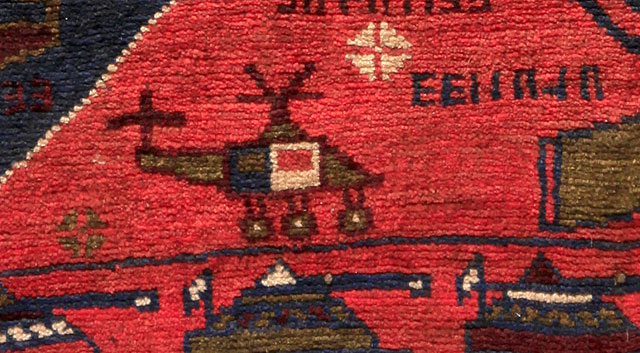
-
 Zoe Schoofs
Zoe SchoofsThe oriental carpet — in Europe it was once proof of the owner's long journeys or good trade relations, but in the regions of origin it was an everyday object used everywhere, often with a reference to paradise. With the invasion of Afghanistan by Soviet troops, the aesthetic concept changed — instead of lively gardens and elaborate arabesque patterns, suddenly there were tanks and weapons — so-called war rugs were created. Not only, but also for European viewers, whose idea of carpets is decisively influenced by classical Persian appearances, these new conventions of representation represent a break with the familiar. Soldiers, diplomats and war correspondents brought such pieces with them from their stays in Afghanistan and made them known in Europe and the USA. Enthusiasts and museum staff were quickly found to create collections of these objects, including the collectors Hans Werner Mohm, Till Passow and Enrico Mascelloni, as well as the Museum für Völkerkunde in Freiburg and Die Neue Sammlung – The Design Museum in Munich.
Carpets from the Orient were already popular at European courts in the 13th century, as they referred to the good trade relations with the Near and Middle East and served as prestigious items of the interior. Carpets were imported, but were also knotted directly in European court manufactories. With the enthusiasm for the Orient that emerged in the middle of the 19th century, the perception of carpets, whose origin had been relatively irrelevant until then, changed to a meticulous, scientific analysis, especially with regard to origin and iconography. World exhibitions and museums made them accessible to an ever wider public. While up to then carpets from courtly and urban manufactories had been the object of desire, over time those with a nomadic context became the centre of interest (Jansen 2001: 138). While this interest had already subsided on the part of the ruling dynasties in the 17th century, carpets for decorative use were produced for the bourgeoisie in the course of the industrial revolution. In 1861 William Morris founded his company Morris & Co. in Great Britain. "Over time, the carpet became part of an aesthetic 'spatial concept'. The technique and decorative motifs were first adopted from the Orient, but then adapted to Western tastes.“ (Bristot 2011: 32) They embodied "[...] the romantic ideal of the free and combative nomad in boundless expanse [...] the Turkmen carpet could be regarded as a sign of this independence sought among men.“ (Jansen 2001: 64) Thus the carpets found their way into male smoking rooms and libraries, also as blankets, cushions and seat covers when cut into pieces. The relocation of the production to factories brought with it simplifications of the motifs and thus further changes. The luxury good was now accessible to a broad section of the population and was thus the object of everyday use.
Carpets from these contexts, unlike woven textiles, are often knotted. They can be found in many different cultures all over the world. Basically, a distinction is made between courtly and urban works and works of the rural and nomadic environment, although there are of course blurred lines. While in the case of courtly and urban carpets all work processes were carried out by the respective specialists (spinning, dyeing, designing, knotting, etc.), all work processes for the carpets from the rural-nomadic environment were in one hand. These objects were primarily produced for the company's own needs and in some cases for the small local market. Courtly and urban carpets, on the other hand, were mostly commissioned works, intended for export or as envoy gifts and made in manufactories. The respective environment had a decisive influence on the appearance of the knotting work. In contrast to rugs made in manufactories, those produced in private homes or a rural community where meant for the local market.
The objects that today are commonly known as classical oriental carpets mostly originated from the Persian Empire and are therefore also known as Persian carpets. At this point, however, it should be noted that a large number of ethnic groups which were united under Persian rule knotted those carpets and that therefore there a large number of different aesthetic concepts. Those from northwestern Persia are most likely to correspond to the European idea of a particularly valuable carpet. The basis for this was an enduring period of peace under Shah Ismael in the 16th and 17th centuries, which is why sufficient resources were available to create works with particularly elaborate motifs (Bristot 2011: 56). In addition to purely ornamental patterns, numerous representations of gardens were created; vases, flowers and trees of life often referred to paradise.
On one hand, various textiles are ubiquitous in many societies: in tents and yurts, carpets have been hung on walls and lain on the floor as thermal insulation since ancient times and hung at the entrance as a substitute for doors. On the other hand, carpets were made in a (semi-)nomadic context in memory of the deceased. These carpets were placed on walls and, in addition to their insulating function, also had the function of commemorating the ancestors. The prayer rug was of central importance for the performance of religious practices. Thus, textile products shape the visual perception of craftsmen and users, and on the other hand, everyday things also find their way into the art of knotting (Frembgen/Mohm 2000: 15).
When Soviet troops invaded Afghanistan on Christmas Eve 1979, war became part of everyday life for many people there; in the course of the years, a civil war broke out. “As early as 1981, the war took on genocidal dimensions. Young and old, men, women and children were affected by unspeakable atrocities.“ (Knauer 1994: 27) "The cultural policy of the [Prorussian] Afghan government was aimed at destroying the traditional ties of Afghan culture to the Islamic world and at adopting the Soviet ideology.“ (Knauer 1994: 28)
As a reaction to these developments, women began to process these impressions into carpet art. The aim was not only to report on specific events, but also to motivate resistance against these conditions and the political system. The resulting carpets originated from the nomadic rural environment. In contrast to large manufactories, in which the knotting and design process was usually carried out by different people, these experiences could be directly converted.
In Figure 1, three horned hexagons arranged one above the other in a light background dominate the main field, which is lined by a wide, sixfold border. In the inner field of the rhombuses representations of three to four prayer rugs, several stylised mosques and a centrally placed ZSU-23-4 tanks were arranged. Although the tank immediately catches the eye, the carpet looks very calm, there are no other war instruments depicted. This impression is reinforced by the many geometric borders and the structure of the main field, whose symmetrical arrangement is reinforced by the triangles placed on the sides. The similarities to Mushwani carpets from the west and Baluchi carpets from the south are striking (cf. MacDonald 2017: 77 / 78; Parsons 2016: 166/167). The carpet measures 160 x 88 cm and was probably knotted in Pakistan in the 1980s. Since the carpets were mostly in use before they came to the bazaar and to Europe through traders, only estimates can be made in this respect. Since it didn't take long for international buyers to become interested while there was also a market in Afghanistan and Pakistan, such carpets were soon produced in Pakistani refugee camps to generate income.
In Figure 2, a border of BTR-60 tanks frames the midfield, on which two identical representations are arranged one above the other: A hand underneath hammer and sickle is directly related to the map of Afghanistan. Below is the inscription جهاد (Dschihád). This motif of map, hand and writing can be found twice in the carpet. On the right side two AK-47 rifles were placed. On the left side there are two representations of trucks each with a ZPU-4 rifle (heavy multi-bore anti-aircraft machine gun) and also a Mi-24A combat helicopter with glazed bow. The field is filled with pseudo-cyrillic writing.
In addition to the motifs shown here, there are many other illustrations that can be found on such carpets. Some point out the changes in day-to-day business by depicting weapons, others illustrate specific attacks on cities. But what was the purpose of those carpets whose motifs depict violent everyday scenes? In this respect, too, only speculations can be made. Scientists around the world hold different views on this question. What is certain however, is that the aesthetic change from classical ornamentation to specific depictions was also accompanied by a change in function.
Surely the desire to process the experience played an important role. According to Jürgen Frembgen, it can be ruled out however, that carpets depicting objects of war have found their way into the family space. Instead, he assumes that the carpets were used in the men's house, hujra, or in the reception room of a house reserved for male visitors, otaq — rooms in which conversations and discussions took place. "The use of space and spatial presence are [...] the expression of social interaction and include shared experience. Spaces thus become zones of identity building.“ (Issa 2009: 83) In such a place they could also serve as a call for resistance. The aesthetics of Object 2 resemble anti-Soviet leaflets that circulated in large numbers, often showing the head of state Babrak Karmal, appointed by the Russians, represented as an (Afghan) puppet whose strings were pulled by the Russian hand. In Carpet 2, only the hand and the Soviet symbol were taken from this illustration. A carpet that makes war the subject of discussion could stimulate conversation and strengthen the idea of community. In addition, the homeowner positions himself on the side of the mujahideen. Pursuing the same purpose, they have been presented "in the houses and tents of some mujahidin commanders (sic!) and wealthy people — as ornaments and probably also out of pride about victories won.“ (Frembgen/Mohm 2000: 46) Accordingly, the objects would have been bought and used as "art within resistance" (Frembgen/Mohm 2000: 46). With the resignation and presumably also a further deteriorating economic situation, the objects later came back onto the market and were then purchased by international buyers.
At first glance, it may seem surprising to be processing everyday life in a carpet. Since particularly Persian pieces are often seen as an investment, timeless patterns or representations of traditional legends are more common. These representations of realities of life therefore mark an aesthetic idea of Modernism in which "the textile is already understood as a pictorial surface in the sense of narrative, sometimes even realistic iconography.“ (Baumhauer 2016: 156)
Since their creation carpets with war motifs have served various purposes: to contribute to financial survival, to express political messages, to represent a medium of processing war. At a time when issues concerning refugee policy in Germany make up a large part of the political debate and there is disagreement about how to deal with migration of all kinds, the carpets have not lost any of their actuality. They are contemporary witnesses of the beginnings of a war that is hardly remembered today. Globalized relationships have made it possible for them to be known to experts around the world. Using various narrative concepts, the carpets with their „pictures against oblivion“ are meant to serve as a reminder of the conditions in the country for the following generation" (Frembgen/Mohm 2000: 45) – thus another purpose can be added, not only in Afghanistan, but all over the world. Although they were not explicitly created for this specific purpose, they could gain it through their display in museum spaces.
References
- Baumhauer, Till Ansgar: Kunst und Krieg in Langzeitkonflikten. Visuelle Kulturen im Dreißigjährigen Krieg und im heutigen Afghanistan, Berlin 2016.
- Bristot, Monique Di Prima: Bildlexikon Teppiche, Berlin 2011.
- Frembgen, Jürgen Wasim / Mohm, Hans Werner: Lebensbaum und Kalaschnikow: Krieg und Frieden im Spiegel afghanischer Bildteppiche, Blieskastel 2000.
- Issa, Christine: Baukultur als Symbol nationaler Identität: Das Beispiel Kabul, Afghanistan, Dissertation zur Erlangung des akademischen Grades Dr. rer.nat im Fachbereich Geographie, Gießen 2009, https://geb.uni-giessen.de/geb/volltexte/2010/7483/pdf/IssaChristine_2009_12_08.pdf [15.12.2018], S. 83.
- Jansen, Simone: Von der Jurte ins Herrenzimmer. Reisen von orientalischen und zentralasiatischen Teppichen, in: Dietrich, Andrea / Herbstreuth, Peter / Mannstein, David (Hrsg.): Orientale 1. Recherchen, Expeditionen, Handlungsreisen (Kat. Ausst. ACC Galerie, Weimar 2001), Weimar 2001, S. 58–71.
- Knauer, Karin: Afghanistan. Krieg und Alltag (Kat. Ausst. Museum für Völkerkunde, Freiburg 1994), Waldkirch 1994.
- MacDonald, Brian: Tribal Rugs. Treasures of the Black Tent, Woodbridge 2017.
- Mascelloni Enrico: War Icons, in: Mascelloni, Enrico / Sawkins, Annemarie (Hrsg.): Afghan War Rugs. The Modern Art of Central Asia (Kat. Ausst. Memorial Art Gallery, University of Rochester 2016), https://mag.rochester.edu/exhibitions/afghan-war-rugs/ [19.11.2018], S. 15–20.
- Parsons, Richard: The Carpets of Afghanistan, Woodbridge 2016.
- Passow, Till / Wild, Thomas: Geknüpftes Gedächtnis. Krieg in afghanischer Teppichkunst (Kat. Ausst. WILD Teppich- und Textilkunst, Berlin 2015), Berlin 2015.
- Schlammiger, Karl / Wilson, Peter L.: Persische Bildteppiche. Geknüpfte Mythen, München 1980.
published February 2020
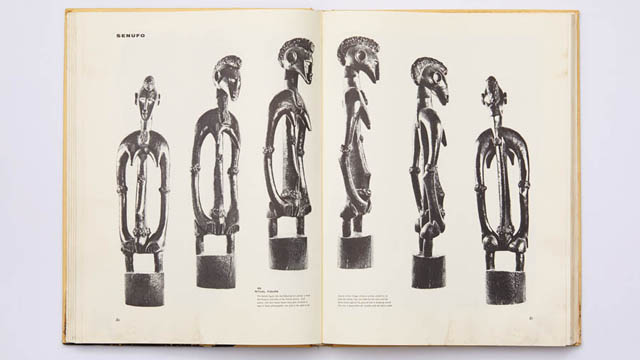
-
 Niklas Wolf
Niklas WolfPhotography as a technique and medium is questioning terminologies of truth and representation as part of the respective and genuinely inscribed authorship of technically enhanced images since the emergence of early photographic works. Through rapid and widespread distribution in print media, photographic images soon became part of the formulation and documentation of shared visual memory in the Global North.
Walker Evans, the father of documentary as one web article states1, heavily influenced the style of modern (not meaning contemporary) photography. His importance as a photographer is essentially based on the photographs he took during the Great Depression in the mid-1930s. The photographic portraits of the three US-american tenant families Fields, Borroughs and Tingle became icons of photographic history and formed the general visual representation of this era by telling a story (in the sense of a historical narrative) at the same time. They, thinking like Evans here, document the person(a), meaning identity or essence, of white, hardworking americans, who, even if they struggle, keep up their integrity. They represent a socio-cultural construct in insisting on their ability of showing, ordering and defining the truth. As Evans' images focus on an American underclass of the time, they show the author of those pictures as part of their own reality.
How does the search for some kind of visual truth in modern photographic images take place when they seem to not look for their own but for the other, which is imagined to be foreign to them and mostly without history? What kind of approach to questions about history and its narratives are they able to re-present as a consequence?
Concepts of history are always entities that reveal just as much about their architects as they do about the evidence integrated into them, which represents constructors and construct at the same time. History rarely appears in a singular form, is never neutral and always normative. It is part of its own discourses, demands order as well as testimony. In documentary terms, the latter (the testimony) should legitimize science and itself. Ordering structures and strategies, on the other hand, require places and institutions where they can appear. Gazes at the end of which historical narratives should stand are seldom equal. Often they are one-sided observations, classifying and hegemonic, alienated observations through mimetic imitation or intended othering. The basis of such categorical observations are specific techniques and strategies for appropriation; results are metaphors or emanations of one's own reality.
The exhibition African Negro Art, which was on view at the Museum of Modern Art New York in 1935, marks the beginning of the institutionalized exhibiting of so-called (or labeled) African Art at major western art museums. Finally coining a terminology often still used today, 603 African objects were exhibited at the MoMA from March 18 to May 19 1935. Walker Evans was commissioned to (literally) photographically document the objects on display.
The resulting images are characterized by long exposure times, which made it possible to guide a light source around the respective object while the cameras aperture was open. The illumination is therefore mostly impressively uniform and soft, strong shadows and the constitution of space are avoided. The images have a hyperfractual clarity.2 The surface of a Bamende facemask for example is uniformly illuminated, the exposure emphasizes the contrasting structures and lines, the formal essence, if one would say so. The actual plasticity of multidimensional objects becomes obvious in a second shot. The face of the same mask appears to be pointedly drawn forward, the slight inclination of a wide comb only becomes apparent here. It almost does not seem to be the same object, so much does the first shot focus on the ornamental surface. Evans used an 8 x 10 medium format camera, the resolution of the images is correspondingly high. The partly dramatic concentration on the object causes a visual monumentalization of things, image sections are often claustrophobic narrow - the objects are not relationally representative, but are re-presented according to their formal characteristics, analyzed by the photographer. This leads to major shifts in reception. One of Evan's most effective images is the photograph of a Pende pendant made of ivory. As if from nowhere, from a timeless, deep black and imponderable background, the masks face emerges from the pictorial ground. The focus lies on the middle plane of its face, which is photographed using a large aperture. Therefore initial blurring starts as early as behind the eyes of the carved face. It is shot from above, not from the front. Viewers are urged to imagine the figure's body (which is neither present nor laid out in the object). Deep shadows let the face appear threatening and alien, framed by sharp contrasts; it becomes clear that the intention of the mask cannot be a good one. Evans gives the alien object an equally alien character, an emotion. The mask stands pars per toto for the ‘other’, the uncanny.
Evans photographs were published quite widely. Starting with the exhibitions catalogue they were used in several publications by the exhibitions curator James Johnson Sweeney focusing on the ‘Art’ of Africa in a broader even more general and art historical perspective: the generalizing and educative intention of pictures and text is already foreshadowed in the somewhat holistic titles of such publications - African Folktales and Sculpture (1952) and African Sculpture (1964) for example . Entering the realm of the photobook as a medium Evans photographic images become part of semi-theatrical stagings, some kind of educational character is inscribed into them, especially looking at the close interlacing of text and pictorial object. Ultimately, the message and content of the images are only self-referential. Evans photographs where often published together with the ones of Elitot Elisofon, who amongst other jobs worked as a photojournalist for the LIFE magazine. In The Sculpture of Africa (1958) Elisofon makes use of the photobook as a medium very consciously. For example he uses different photographic views on the same sculptural object to kind of animate it in a cinematic way, using the photobook as an idea to look at three-dimensional properties of things in a two-dimensional way, making the accessible by flipping through the book. Both photographers work is often labeled as having a documentary style, both seem to have a special interest in photographically analyzing pictorial qualities of the surface and materiality of the things they look at. Exposure and contrasts (re)produce haptic qualities and material properties of the things being looked at through the camera quasi argumentatively, based only in the photographic objects themselves.
Methodically, Walker Evans' documentarism is ergo characterized by the omission of object-immanent information and the simultaneous genesis of image-immanent content. His pictures do not allow conclusions to be drawn about the size, material and context of the representations; a mostly unspecific monochrome background detaches the objects from the contexts inscribed into them. The photographer repeats aspects of the aesthetically and content-wise neutral display of a modern art exhibition and demands that the images focus on purely formal aspects. The representations do not permit any connection between the signifiers in terms of content. In narrow sections, each object is presented in a very specific view - the photographic images ergo become significant only in a Western canonical art context, shifted to its terminology and histories.
Stylistically, Evans' photographs can be described as clean and cerebral.3 The images of African objects are clean (and timeless) in the sense that they are cleansed of any context; they are cerebral in the sense that they are open to new inscriptions and attributions. The highly specific aesthetics of the images serve to conceal and reveal equally specific information at the same time, they are markers of tailored representations4 which are more the presentation of Evans as the author of those images and his techniques to strip pictorial objects from their original terminology and historical narratives, than the representation in the sense of a documentation of the object shown.
1) https://www.theguardian.com/artanddesign/gallery/2015/dec/03/walker-evans-documentary-photography-great-depression-gallery; 15. Juli 2020.
2) Cf. Campany, David: Walker Evans. The magazine work, Göttingen 2014, S. 52.
3) Cf. Strother, Z.S.: Looking for Africa in Carl Einstein’s Negerplastik, in: african arts Winter 2013 VOL. 46, No. 4, S. 8 – 21, S. 8.
4) Cf. Webb, Virginia-Lee: Perfect Documents. Walker Evans and African Art 1935, New York 2000, S. 15.
References
- Eliot Elisofon: The Sculpture of Africa (text: Ralph Linton, William B. Fagg), New York 1978
- James Johnson Sweeney, Paul Radin (eds.): African Folktales and Sculpture, New York 1964
- Kerstin Pinther, Niklas Wolf (eds.): Photobook Africa. Tracing Stories and Imagery, München 2020
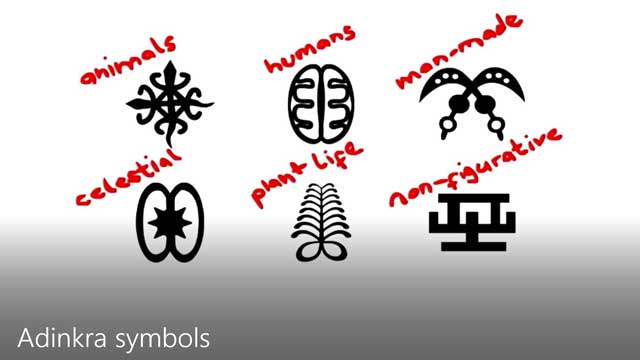
-
 Patrique deGraft-Yankson
Patrique deGraft-YanksonSome of these signs and symbols depict historical events, human behaviour, animal behaviour, attitudes, plant life forms and shapes of objects, many of which have grown to assume recognizable iconographic dimensions. Others carry rich proverbial messages that are traditionally considered a mark of wisdom. These attributes indeed give credence to the need for the preservation and popularization of traditional symbolism and imagery.
Therefore, in this project (which is one of many others in progress) therefore, has made an attempt to repackage Adinkra and other traditional symbols through animated videos. The aim is to make these age-old symbols more accessible and attractive to the modern Ghanaian youth. Presenting traditional symbols digitally would not only appeal to the youth, but would also ensure widespread visibility, presentation and thus, better preservation.
published October 2020

-
 Mahmoud Malik Saako
Mahmoud Malik SaakoThe Koma figurines did not only enrich the stock of African artwork but evoke the minds of a great culture represented or embedded greatly in these art pieces. These figurines have been classified into anthropomorphic (the use of human features), and zoomorphic (the use of animal features), based on the stylistic representation while some are both anthropomorphic and zoomorphic (they possess both human and animal features). They are some of the anthropomorphic figurines that have one head and two faces or one body with multiple heads while some have a head with a conical shape. Those anthropomorphic coned figurines are the most common types and are consisting of a head with a long conical neck or body.
The Koma figurines could be equated to those of Nok and Ife (in Nigeria), Sao (around Lake Chad), the Akan funerary clay figures (in southern Ghana), and the Jenne and Bankoni clay figurines of the Inland Niger Delta (in Mali). Beyond their artistic significance and historical products, the Koma figurines have generated some interest among intellectuals in and outside Ghana including antique dealers.
Before the scientific investigations commenced in the 1980s and 2006 onwards, the communities within this geographical area known as "Komaland" were encountering or recovering these terracotta figurines when they were digging for soil to build their homes. The people then referred to them as kronkronballi which literary means "children from an old-time". These figurines are either found in house or burial mounds within the area. The culture of the current inhabitants of the area where these figurines are found do revere their ancestors, and any disturbance of the ancestral graves or the removal of any burial goods either intentionally or accidentally must be expiated by sacrifices, and all the grave goods are reburied at the same place. Since the people are far remote from the creators or ancestors of these figurines, many of the damaged ones were either thrown away while a significant number of them were taken home and given to children as toys.
Moreover, art dealers in Ghana and West Africa recognized the commercial value of these Koma figurines long before the scientific investigations by the first anthropologists, archaeologists, and historians. These Koma figurines were, therefore, sold at the various art markets in northern Ghana (in Bolgatanga at the craft village) and southern Ghana (in Kumasi and Accra art centers) to foreign tourists. It is through this medium that Koma figurines have found their way into many European and Western museums.
Furthermore, scientific excavations in the 1980s and the subsequent excavations in 2006 onward by a team of archaeologists in Ghana and abroad, have attracted the attention of the world through conferences and publications. The Koma figurines were initially appreciated based on their aesthetic values but the subsequent archaeological excavations subjected them to more rigorous scientific analysis and historical classification such as social, cultural, political, and environmental. The scientific excavations have also to some extent put a stop to the numerous lootings of the sites that were hitherto very rampant.
The archaeological investigations in recent times and based on radiocarbon analysis from pieces of charcoal dated the site between the 6th and 14th centuries AD. But further investigations are still ongoing to identify the authors or creators of this supposed complex civilization in northern Ghana though, parallel has been made to the Lobi in Ghana and Burkina Faso.
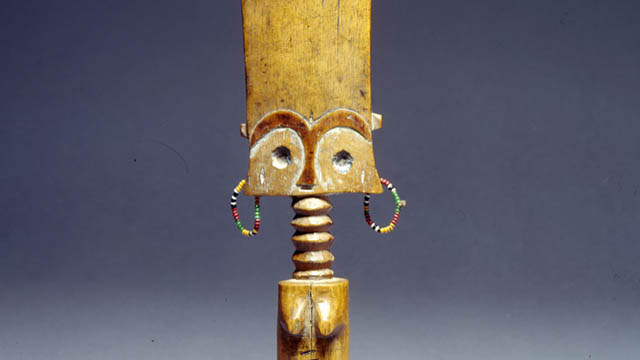
-
 Gertrude Nkrumah
Gertrude NkrumahInversion of Hegemony with Ideas of Femininity
Scholarly works abound on factors and causes of gender inequality in the Ghanaian society and many of these writings address gender inequality solely in terms of women as the victims and thus reinforcing the gender stereotype of female passivity. Although this is true in most cases, such studies do not necessarily address the question of how women have responded to and addressed issues of gender expectations and gender-related roles in African societies. By using the ‘Akuaba’ doll (fertility figurine), this research seeks to explore how the concept of womanhood has been portrayed and represented through time in the Ghanaian society among the Akan ethnic group. It seeks to extend an argument for the interpretation of these images beyond the depiction of women as sexual objects to that of creating an inversion of female hegemony in the society. I argue that instead of considering gender stereotypes as an all-pervasive oppressive tool, we must begin to think of the finer nuances and conceptualize how women have shaped, redefined, and negotiated socio-cultural construction of gender.
The object is widely referred to as the fertility figure, also known as the Akuaba doll among the Akans of Ghana. My reasons for selecting this object are two-fold. Firstly, it speaks to my childhood experiences as a girl growing up in an Akan society and secondly, as someone who is very passionate about gender-related issues either from an intellectual and personal perspectives, I was motivated to choose for this project an object that I can easily relate to, both from a personal and intellectual perspectives.
The object in question is the depiction of a female body, an exhibition of the Akan concept of an ideal woman. The features include a flat forehead with an elongated “ring-like neck shape”1 which reflects Akan standard of beauty. The understanding is that a woman with this type of neck is well-fed, healthy, and strong, a paragon of beauty and affluence. The flat broad forehead also is an embodiment of wisdom, while the accentuated breasts and hips with beads worn arounds the waist is the Akan ideal of womanhood, a depiction of woman as the giver of life. The beads worn around the waist has both aesthetic and symbolical meanings. In terms of beauty, beads were worn as an ornament for beautification, just as portrayed by the wearing of the jewels around her ears. It was also believed that wearing of beads around the waist is sexually appealing, while beads were also worn to broaden the hips and shape the waist for reproductive purposes. It is important to note that in the Akan society, and indeed in most Ghanaian culture, an ideal woman is one that carries and bears children. Clearly, ideas of beauty, sexuality and reproduction were the very essence of womanhood or femininity in the Akan society.
According to a very popular Akan oral tradition, the Akuaba doll is deeply rooted in one’s woman’s quest to overcome her inability in meeting societal ideas and expectation of womanhood.2 Akua, a childless woman, consulted a ritual specialist for a child. She was instructed to go to a woodcarver and make a doll of her choice for a child. Some rituals were then performed on the doll and given back to her to take home and treat and care for as her child. Later she became pregnant and gave birth to a daughter, just as she desired. The Akuaba doll then became symbolic for female reproduction. Amenumey explains that the Akuaba dolls were “…supposed to induce fertility and pregnancy….”.3 Among the Akan, like most precolonial Ghanaian societies, the concept of womanhood was largely defined and shaped by a woman’s ability to give birth to as many children as possible. Childbearing was a blessing from the gods and was usually celebrated with pomp and merrymaking. For instance, the custom was to reward a man whose wife has given birth to ten children with a sheep. The Akan refer to this as “badudwan”4 literally, a sheep for the tenth child. This was usually provided by the wife’s family to the husband to show their appreciation for the replenishing and sustainability of their family.5 In the quest to attain such feat, women worked hard to give birth to at least this number of children as prove of her worth to her husband and the society. This undoubtedly made women who were childless in the society feel undervalued and highly marginalized.
Such ideas and concepts of womanhood and inadvertent marginalisation of women still resonate in contemporary Ghanaian society and indeed in most contemporary societies. A woman’s value and worth continue to be tied with her sexual and reproductive abilities. Although women at present now have access to spaces and engage in works that go beyond the traditionally assigned roles of wife and motherhood (sexual and reproductive values), a woman is still expected to neatly fit in with socio-cultural construct of gender. This underscores the value place on women’s sexuality and reproduction to the detriment of other roles beyond these norms, thus leading to the marginalization of women. It is for these reasons that scholars such as Lerner and Allman have often called for the need to question entrenched patriarchal norms that undermine women’s oppression while it reinforces male- superiority.6
The understanding that women have continually been passive and largely detached from the making of their own history and are mere tools in the hands of a patriarchal society is neatly contested by the history behind the Akuaba doll. While it is true that it was Akua’s desperation to fit into societal expectation of ideals of motherhood that forced her to consult a diviner to help her conceive a child, the knowledge that Akua chose to actively engaged with the process of making the doll; how the doll is carved out, the shape, the physical features, and the aesthetic nature is significant. Additionally, the fact that she chose to carve out a girl child clearly indicates the active role she played in redefining and negotiating power with the matrilineal, yet patriarchal society, thus creating and inverting power in an all-pervasive patriarchal institution. It is also an indication that she did not consider the female as of little value in her society.
Paradoxically then, the history and philosophical ideologies that underpin the concept of the Akuaba doll is a clear exhibition of the nuances and complexities of societal construction of gender roles and status. In a society with a deeply entrenched gender expectations and assigned gender roles, it is remarkable that Akua sought to circumvent, manipulate, and yet conversely acquiesce with existing status quo to her advantage, an inversion of hegemony amidst patriarchal privilege. Therein lies the ambiguities and contradictions of performing gender.
References
- Addo-Fening, R (1973). Asante refugees in Akyem Abuakwa 1875-1912. Transactions of the Historical Society of Ghana. 14, 1. 39-64.
- Akyeampong, E & Obeng, P. (1995). Spirituality, Gender, and Power in Asante History. The International Journal of African Historical Studies. 28, 3. 481-508.
- Allman, Jean. (1996). “Rounding up Spinsters: Gender Chaos and Unmarried Women in Colonial Asante.” Journal of African History, 37, 2, 195-214.
- Amenumey, D. E. K. (2008). Ghana: A concise history from pre-colonial times to the 20th Century. Accra: Woeli Publishing.
- Appiah Anthony K. (1991) “Is the Post- in Postmodernism the Post- in Postcolonial? Critical Inquiry. Vol. 17, No. 2. 336-357.
- Lerner, G. (1994). The creation of feminist consciousness: From the Middle Ages to 1870. Oxford: Oxford University Press.
- Lerner, G. (1986). The creation of patriarchy. New York: Oxford University Press.
Footnotes
1) It is quite common today to hear songs in the Ghanaian society eulogising a woman’s beauty by referring to her ring-shaped neck, together with other physical features. This is an indication that the Akan standard of beauty in the past as enshrined in the Akuaba doll continue to resonate with contemporary Ghanaian societies.
2) This is a popular story among the Akans and was often recounted to young girls especially by an older woman in the family or society. I grew up listening to these stories from my mother and grandmother, among others.
3) D. E K. Amenumey. (2008). Ghana: A concise history from pre-colonial times to the 20th Century. Accra: Woeli Publishing. P. 90. From a spiritual and philosophical perspectives, the use of the Akuaba went beyond just fulfilling the desires of childless women. In most of these Akan societies, when a woman gives birth to twins but in an unlikely situation where one of them dies, she is expected to make a replica of an Akuaba doll in replacing the dead child. Some would also bury the dead child with the Akuaba doll as a way of warding off evil spirit from killing the living child.
4) “Badu” is an Akan name for the tenth born child. ‘Ba’ or ‘ɛba’ is the Twi word for child, while ‘ɛdu’ or ‘du ‘means the number ten in the Akan language. Therefore, the name Badu in Akan usually refers to a tenth born child.
5) It is significant to point out that Akan society, unlike most ethnic groups such as the Mole-Dagbani, Ewe, Ga-Adangbe and Guan, is mostly a matrilineal society. Lineage, inheritance, and chieftaincy succession have always been through the female line. Although precolonial Akan society was not completely immune from patriarchal ideals, women played important roles and and had significant status in society especially in areas of religion, politics and economy. For further details on this, see for example the articles Addo-Fening, R (1973). Asante refugees in Akyem Abuakwa 1875-1912. Transactions of the Historical Society of Ghana. 14, 1. 39-64 & Akyeampong, E & Obeng, P. (1995). Spirituality, Gender, and Power in Asante History. The International Journal of African Historical Studies. 28, 3. 481-508.
6) See for example, Allman, J. (1996). “Rounding up Spinsters: Gender Chaos and Unmarried Women in Colonial Asante.” Journal of African History, 37, 2, 195-214, Lerner, G. (1994). The creation of feminist consciousness: From the Middle Ages to 1870. Oxford: Oxford University Press., & Lerner, G. (1986). The creation of patriarchy. New York: Oxford University Press.
This article is part of a gallery: Perspectives from Ghana on Museum Objects in Germany
published January 2021
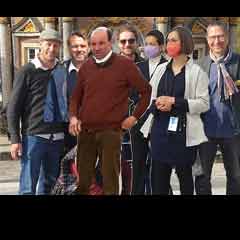 ISB_Team
ISB_TeamA German Perspective on the Akuaba Doll in the Museum Fünf Kontinente Munich
Akuaba Dolls are wooden figures that were and apparently still are in use mainly in rural areas in southern Ghana. Young women hoping for pregnancy or - if they are already pregnant - for the health and beauty of their child, wear these figures on their bodies like real babies and take care of them. That is why they are called 'dolls'.
Akuaba or better Akua-Bà literally means 'child of Akua'. The story tells of "a woman named >Akua< who could not get pregnant and went to a local diviner or priest and commissioned the carving of a small wooden doll. She carried and cared for the doll as if it were her own child, feeding it, bathing it and so on. Soon the people in the village started calling it >Akua< >ba< - meaning >Akuaba's child<, since >ba< means child. She soon became pregnant and her daughter grew up with the doll." (Annor et al., p. 308)
This story also forms the basis for the function of the widespread dolls as aids in a desire for pregnancy. An Akuaba Doll expresses this desire for a child, so the figure is 'cared for' by a girl from puberty onwards. This happens within the family. Outside the family, Akuaba Dolls can be found in shrines under the care of a ritual specialist, where they can be borrowed for their purpose.
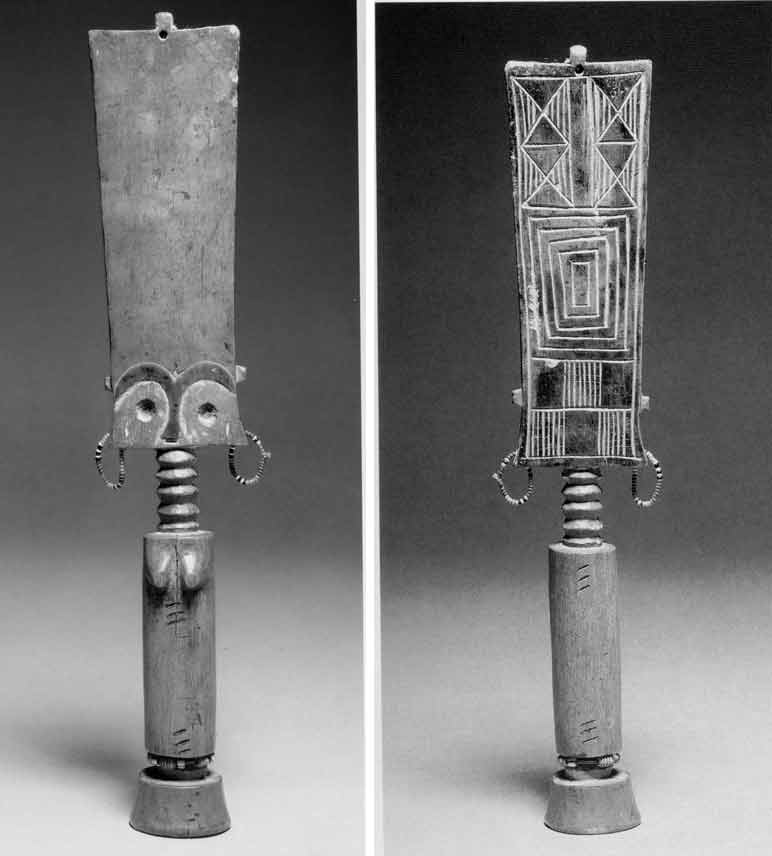
Fig. 1 & Fig. 2 Views of the Akuaba Doll in the Munich Museum Fünf Kontinente
Anonymous artist. Fante Fertility Figure. Early 20th century, Wood. 27,5 cm. Museum Fünf Kontinente. Presentation at Museum Fünf Kontinente.
© Museum Fünf Kontinente
Description
The doll in Munich's Museum Fünf Kontinente (Fig.1) comes from the Fante area. It shows a female figure. The very strongly abstracted forms and proportions symbolise various aspects:
The rectangular shape of the very flat head becomes - seen from the front - somewhat broader in an elegant curve towards the top. A strikingly high forehead, with eyes, eyebrows and nose only indicated, while mouth and ears are missing. The accentuated arch segments of the eyebrows flow together and then form the nose. On the back, the head has geometric patterns (Fig. 2). Added earrings of glass beads give the figure a colourful accent. For Kecskési (p. 38), their daintiness is a sign that the doll has been lovingly treated. At the very top there is another small moulding with a hole where hair was originally attached (compare Fig. 3a).
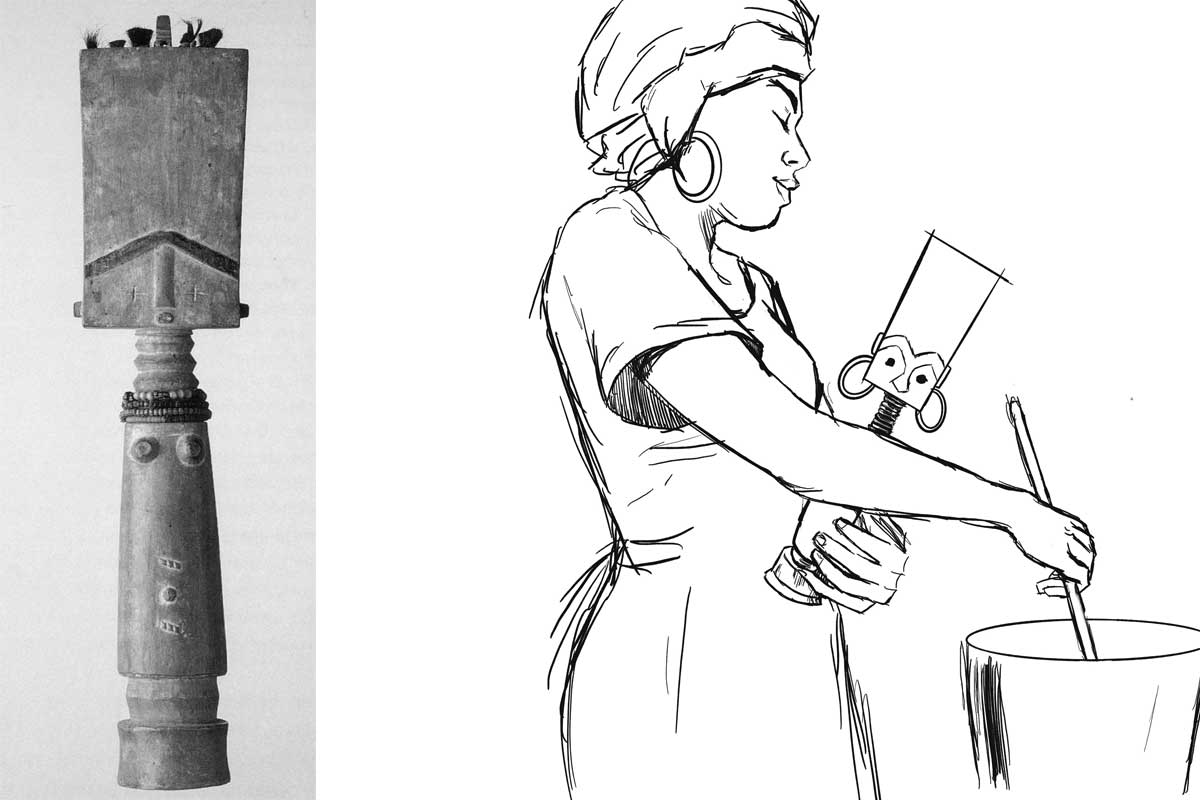
Fig. 3a: Akuaba Doll from the Linden Museum Stuttgart (Forkl p. 94). Fig. 3b: Use of the doll (drawing by Vanessa Rast - courtesy the artist)
The neck has five rings. It sits on a very slender, round trunk, which in turn stands on a delicate base. Striking are two groups of three diagonal embrasures each, which are repeated on the back. The figure has no arms, the legs are short stumps. The protruding forms in the chest area mark the figure as female. Its strict symmetry is softened by small deviations. One can well imagine taking the cylindrical figure in one's hand.
Material and technique
A ritual specialist to whom a woman who wishes to have a child goes makes the decision about the choice of doll at the respective shrine. If no suitable figures are available there, he instructs the woman to order a new Akuaba Doll from the woodcarver. The craftsmen then visit the tree to obtain the wood and ask the tree's spirits for permission to do so (oral information from the Ghanaian colleagues 2022 in Bayreuth [Link]). The Akuaba Doll in the Munich Museum was carved from softwood. (There are also darker examples made of hardwood, for example among the Ashanti, also an Akan group, as the presentation in the Ghana National Museum in Accra shows - see Fig. 4.) In the example in Munich, eyebrows and nose are darker.
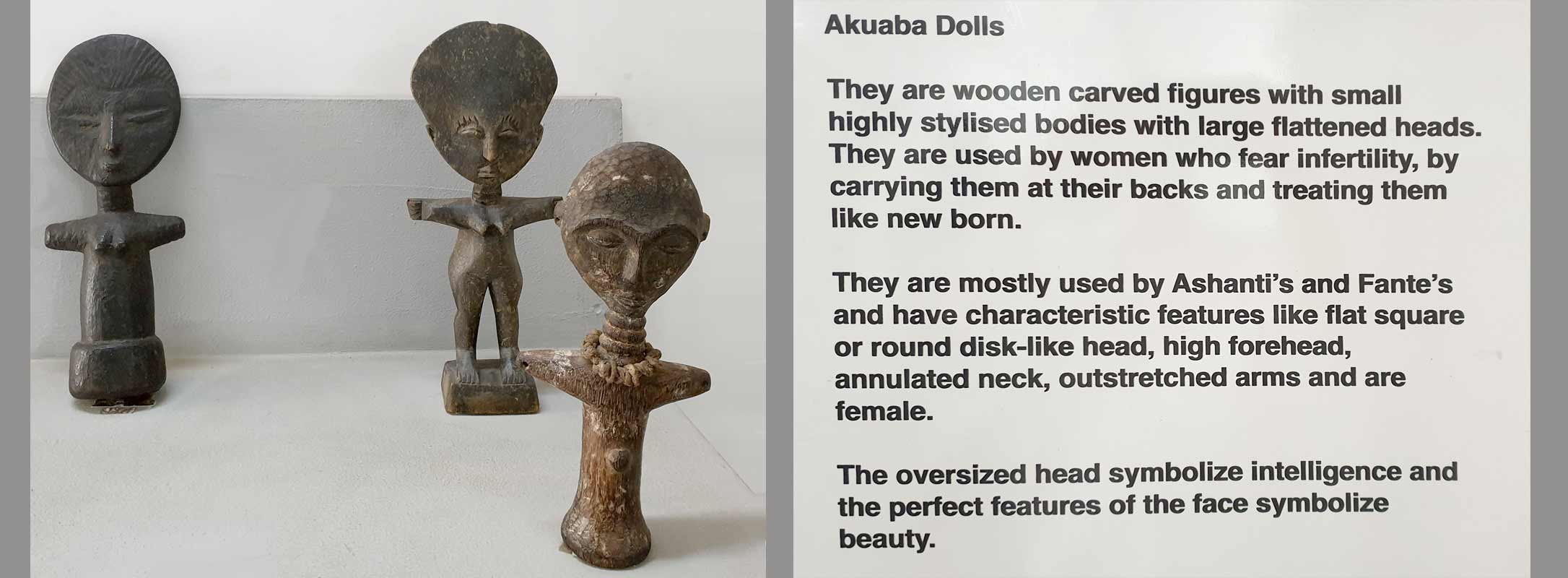
Fig. 4: Presentation of Akuaba Dolls at the Ghana National Museum in Accra (March 2023. Photo: the author)
Interpretation of the Munich figure within the original Ghanaian context
(1) Utility function: The figure is made for the family context. It is meant to lead to fertility, sometimes also to the beauty of a child. The size (height 28 cm), the pleasant material and the weight allow the figure to be carried and cared for like a baby. When an Akuaba Doll has fulfilled its task, it is often returned to the ritual specialist who accompanies the process.
The breasts indicate a female figure, which does not necessarily have to do with a corresponding desire for the sex of the child desired. Forkl (p. 94) assumes, however, that "women desire daughters, on the one hand as progenitors in a matrilineality oriented society, and on the other hand as support in household work." (There are also Akuaba figures with the characteristics of both sexes and probably male specimens; furthermore, breastfeeding examples and those who in turn carry other Akuaba Dolls.)
(2) Body shape: T The conspicuous and disproportionately large rectangular head symbolises the head as the seat of intellect and wisdom in local imagery. Akuaba figures among the Ashanti show round heads (see fig. 4), but they are also proportionally very large. High foreheads and flat faces correspond to the ideal of beauty. Luxuriant bulges on the necks tell that the figure is well-fed and thus refer to happiness and prosperity. There are Akuaba Dolls that show more feminine body shapes, wider hips, possibly emphasised by strings of pearls.
(3) The spiritual context: As Nkrumah writes in her contribution, an Akuaba figure serves as a dwelling place for a soul being, a being that is in a transitional area between the earthly and the spiritual world. Carrying and caring for it is a prerequisite for the entrance of such a soul being, which then sets out to appear on earth as a living being, i.e. to enter the family of the young woman through birth. A ritual specialist is involved in the selection, consecration and regulations for use. After a birth, the figure is returned to the ritual specialist.[1]
(4) The social and cultural context: The figure can also be seen as a sign of the traditional expectation for a woman to bring children into the world. In recent times, where traditional societal expectations of women collide with other worldviews, the ritual use of Akuaba Dolls obviously decreases .

Fig. 5: Souvenir shop at Accra Airport (March 2023. Photo: the author)
In the last decades, an interesting production for tourism has been established - apparently the dolls are seen as 'typical for Ghana'. However, these are not Akuaba Dolls in the traditional sense, but rather 'quotes'.
How can one relate Akuaba Dolls to European visual traditions and experiences?
As familiar as the image of an Akuaba figure may seem in Europe - as a 'typical' example of traditional African art - its traditional meaning is unknown in Europe. Nevertheless, it obviously seems to be attractive to tourists, e.g. as 'airport art' (see Fig. 5), perhaps because its shape somehow corresponds to the cliché idea of 'typically African', the size fits well into the suitcase, or the large head (by means of the Bambi effect) makes it appear 'cute'.
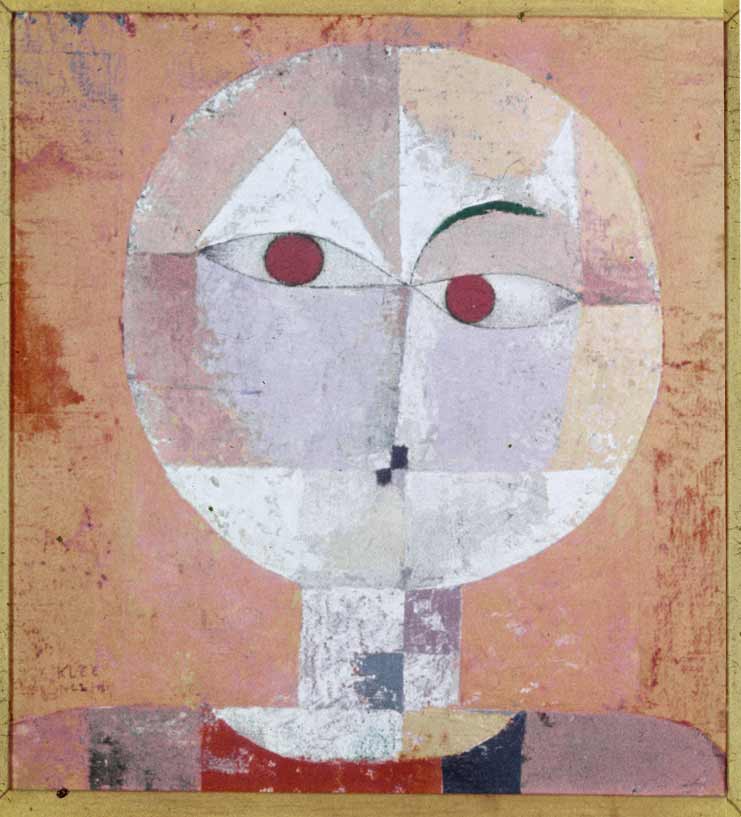
Fig. 6: Paul Klee. Senecio. 1922. Oil on chalk base on gauze on cardboard. 40.3 × 37.4 cm. Kunstmuseum Basel (Wiki Commons)
In the context of art history, the influence of Akuaba Dolls (and many other carved representations from West Africa) on European art of the early 20th century (see Fig. 6) is of interest. [2] The formal similarity to Klee's painting (fig. 6) is striking at first glance, but whether this is a direct reference must first be verified. In the context of art history, it would then be of interest in a next step which aesthetics were of interest to the artists at the time and which they blanked out, i.e. which "image of Africa" they wanted to have and also communicate.
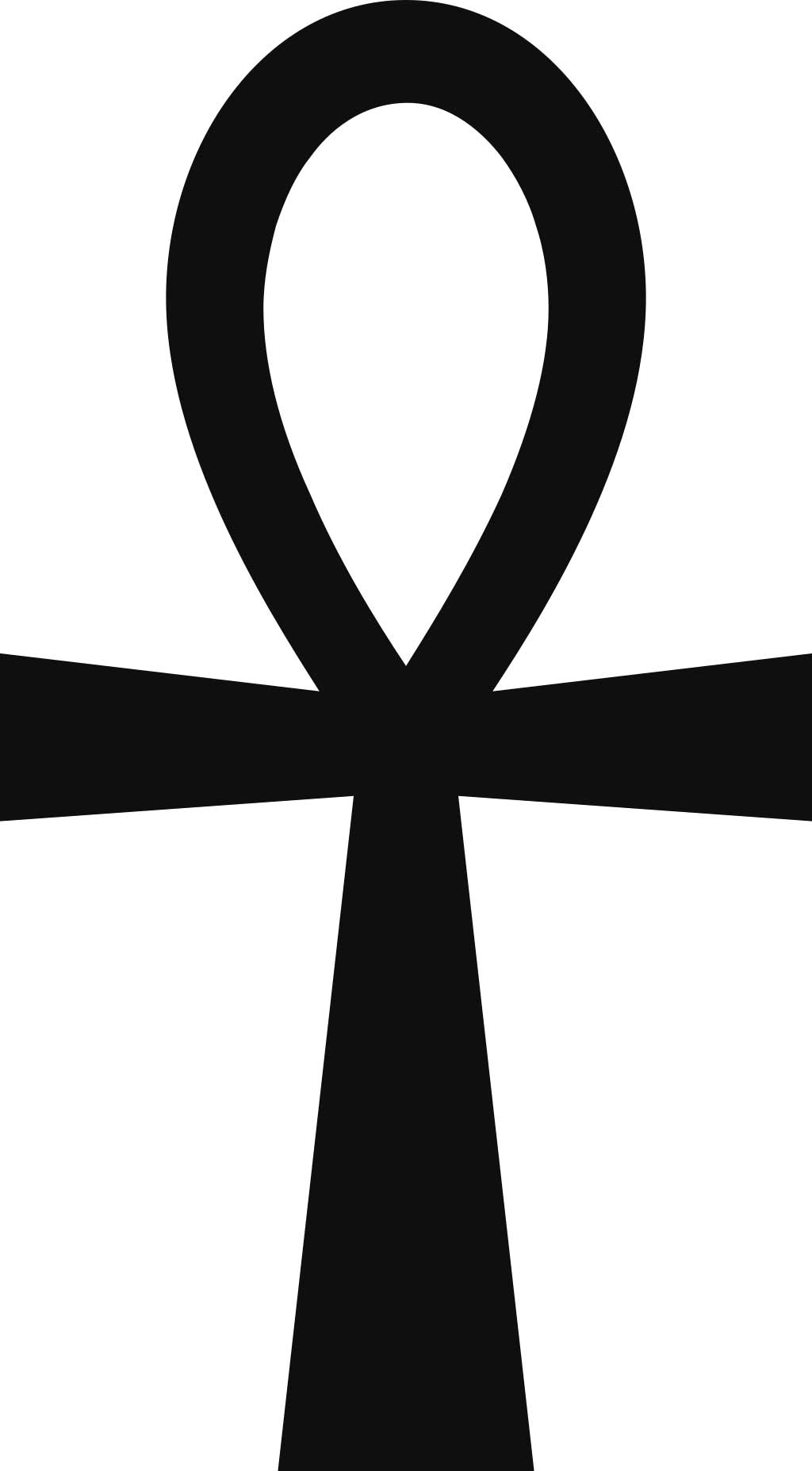
Fig. 7: Hieroglyph Anch
(Photo: https://anthrowiki.at/Anch)
The authors also considered whether the formal similarity of the Akuaba Dolls with the ancient Egyptian hieroglyph ‘Anch’ (the "loop of life" or the "key of life" - see Fig. 7) could have come about through a historical relationship between Egypt and Ghana. This would also correspond to the accentuation of content in Nkrumah's text with regard to the "representation of the woman as the giver of life" (see her chapter). Nevertheless, this association would also have to be examined more closely. To assume a universal archetype in the sense of C. G. Jung appears to be pedagogically misleading in its levelling effect.
In the German educational context, on the other hand, it seems important to link the figure - beyond clarifying its function - to Akua's story and thus include the role of narratives. This prevents another comparison that is also too quick and reductive when it comes to social practices (and not the isolated object), as dolls are also cared for and nurtured in traditional European contexts, but mostly by young children before puberty. So, in Europe, it does not belong to a fertility ritual, even if the child puts itself in the role of a ‘little mother’ or ‘little father’. (Another interesting question, whether Ghanaian women also go to a doctor when they are not pregnant, and whether there are comparable ritualised practices in Central Europe - for example among alternative practitioners or in esoteric circles - would have to be addressed in interdisciplinary approaches.)
Such comparisons appear to be useful, as they can show both similarities and differences, with the aim of better recognising one's own perceptual conventions or stereotypes and thus putting them into perspective. All this still leaves the question of the status of this doll in Munich when it is displayed in a showcase in a European museum (see Lab entry: What is an object? Link). Such a presentation contradicts its ritual and spiritual use. An Akuaba is then no longer an Akuaba. But what is it then?
Sources
This text is based on:
- Contribution by Gertrude Nkrumah: https://explore-vc.org/en/objects/the-akuaba-doll.html
- Talks with the Ghanaian EVC partners in Bayreuth in 2022: https://explore-vc.org/en/activities/archive/april-22-25-2022-joint-workshop-uew-team-and-isb-team.html
- The presentation at the National Museum in Accra, seen in March 2023: Fig. 4.
- Reading: see list of references
References
- Akyeampong, E & Obeng, P. (1995). Spirituality, Gender, and Power in Asante History. The International Journal of African Historical Studies. 28, 3. pp 481-508
- Anderson, Elizabeth L. (1989): The Levels of Meaning of an Ashanti Akua'ba. In: Michigan Academican. 21 205-219
- Annor, I., Dickson, A & Dzidzornu, A. G. (2011): General Knowledge in Art. Accra (Aki-Ola Publications)
- Forkl H. (1997): Healing and body art in Africa. Stuttgart (Lindenmuseum)
- Kecskési, M. (1999): Kunst aus Afrika - Museum für Völkerkunde München. Munich (Prestel)
Footnotes
[1] The number of five neck bulges here (there are also specimens with 3, 8 or 9 bulges) may also be a reference to the sacred number of "Odumankoma", the Akan creator deity, in this context.
[2] On the relationship of the European avant-garde to the aesthetics of West African carvings, see also the discussion of the Blue Rider post on this website (link 1 and 2).
 Christin Winter
Christin WinterMy Encounter with Black Feminism and Womanhood Inspired by the Akuaba Doll
I first came in contact with the Akuaba Doll while reading Bernardine Evaristo’s award winning book Girl, Woman, Other. In the book, the character Nazinga was described as “at least six foot tall with ornamented dreadlocks, large wooden Akuaba fertility doll earrings, red trousers, a cream embroidered caftan and strappy Roman sandals“ (Evarsito 2020, p. 81). I searched for Akuaba fertility doll earrings on the internet, but did not delve further into the topic at this time. A few weeks later, attending a seminar with Dr. Wagner at Friedrich-Alexander University in Erlangen, I stumbled upon the Akuaba Doll again. I knew, I had to take this opportunity to get to know her better. The comment from Gertrude Nkrumah is to be considered my first source of information about the history of origin and the tradition into which the Akuaba Doll is woven.
Through Nkrumah's feminist perspective on the Akuaba Doll, I wanted to dive deeper into the topic of Black Feminism to extend my knowledge in feminist theory. With the Akuaba Doll as my point of departure, I decided to focus on the ability to bear children and the social significance of abortions for Black women.[1]
At this point I move past the Akuaba Doll and her cultural context. Other works of art could have led me to a similar path. I have chosen to look at the Akuaba Doll with categories, which are not directly related to the Akuaba Doll and her cultural context as I questioned whether I have the right to write about the Akuaba Doll considering the colonial past of my own country, Germany. I am a white, European woman, a feminist, who is aware of intersectionality and racist structures within the society I have been socialised in and its way of thinking, but with no cultural connection to the Akuaba Doll other than the colonial impact on African art and culture (cf. Kushinator, Rahman and Dompreh, 2020[2]). Therefore, I chose a topic to which I have access via my role as a student of pedagogy and focus on Black Feminism and Womanhood of Black women living in white-dominated countries.
In white-dominated societies, Black women were excluded from a feminist movement for decades (cf. hooks, p. 216f.). White women systematically utilised the racist hierarchy within women to gain power and thereby forced a specific Black feminist movement to form and uncover the oppression Black women had and still have to face. The prefix “Black” emphases the specific oppression Black women face in white-dominated countries, although, of course, there has been feminist movements in Black-dominated countries before (cf. Roig quoted from Berlin Biennale 2022, 48:00 – 49:50).
In American history, Black women have always had to fight to be seen as women. As bell hooks gets to the heart of it: “the black female was a creature unworthy of the title woman; she was mere chattel, a thing, an animal” (hooks 2015, p. 214). Sojourner Truth[3] had to bare her breasts to prove that she was a woman indeed. Being yelled at “I don’t believe you really are a woman” by a white man represents the contempt and disrespect for Black womanhood (cf. hooks 2015, p. 214). In her famous speech “Ain’ I a Woman” (1851), she argues, that she – as her white women audience too – is indeed a woman. Here she argues with characteristics, that can also be found in the Akuaba Doll. The most important argument is the carrying and bearing of children and the “mother’s grief” (Truth 1851 quoted from hooks 2015, p. 215) she cried out, when her children were sold into slavery.
The ability to bear children has always played an important role in the history of womanhood and was – and still is – utilised to oppress and exploit Black women. In times of slavery, Black women were forced to procreate and bear children, who were worth a lot of money in a perfidious system of human trafficking (cf. Federici 2020, p. 23f.). In the late 20th century, Black men in the U.S. reasserted what they called their “rightful positions as patriarchs” (Taylor 2022) and denounced birth control and abortions as genocide that compromised the future and freedom of Black families by limiting the Black population (cf. Federici, p. 25f.). With the overturn of Roe v. Wade[4] – Black women are specifically affected, as Kwajelyn Jackson, Executive Director of the Feminist Women’s Health Center in Atlanta, Georgia puts it into a nutshell: "Abortion bans are inherently racist because they do not consider the lived experiences of Black people and other communities of colour. Many state policymakers would rather criminalize and endanger Black birthing people than supply them with all of the resources they actually need" (Jackson quoted from Long 2022). Even before the abortion laws were restricted, Black (and other BIPoc) women in the U.S were two to three times more likely to die from pregnancy-related causes than white women (cf. CDC 2019). Being allowed to decide whether you want children or not and furthermore, having access to certain facilities to end a pregnancy or not is still a bound to privileges. It is not only tied to the health care system, but also to cultural beliefs and practices, to the financial and educational background, as well as to class, race and many other factors.
In a world imprinted by patriarchy and privilege, it is important to unravel power structures that dominate our world, uncover where they come from and how different groups are affected differently. As patriarchal patterns of thought are inscribed in nearly all societies of our world, it is a tough task to uncover them in every aspect of our lives and hence require lifelong learning and feminist thought. Nevertheless, it is indispensable in order to build an anti-racist gender-equal society in which every woman can decide herself, if she wants to get children without fearing financial or social consequences.
In this context the Akuaba Doll can be interpreted as an early moment of feminism, where women disrupt the patriarchal system that marginalizes them. As Nkrumah states, by deciding about the gender of her child in a binary system, she chose to bear a girl rather than a boy, which – in the matrilineal line – effects the lineage, inheritance, and chieftaincy succession (cf. Nkrumah 2020). In my eyes, Akua used the power she had to influence her life to her advantage. Yet the worth of women was still tied to her sexual and reproductive abilities, but nevertheless she made a first step by empowering women to stand up for themselves and for their own lives.
References
Berlin Biennale (2022). Panel: Afrofeminism. Bridging the Gap. <https://12.berlinbiennale.de/media/panel-afrofeminisms-bridging-the-gap/> (09/30/2022).
Center for Reproductive Rights (2022). The World’s Abortion Laws. <https://reproductiverights.org/maps/worlds-abortion-laws/> (09/30/2022)
Evaristo, B. (2020). Girl, Woman, Other. UK: Penguin Books.
Federici, S. (2020). Jenseits unserer Haut. Körper als umkämpfter Ort im Kapitalismus. Münster: Unrast.
hooks, b. (2015). Ain’t I a Woman. Black Women and Feminism. New York: Routledge.
Kushiator, G., Rahman, A. and Dompreh, H.-O. (2020). The Influence of Western Culture on Traditional Art Forms and Cultural Practices: ‘Akuaba’ doll among Akan Women in Africa. ADRRI Journal of Arts and Social Sciences, Ghana: Vol. 17, No.6 (5), S.59 – 71.<https://www.researchgate.net/publication/344438737_The_Influence_of_Western_Culture_on_Traditional_Art_Forms_and_Cultural_Practices_%27Akuaba%27_Doll_Among_Akan_Women_in_Africa> (09/30/2022).
Long, S. (2022). Abortion Bans pose a Danger to all Mothers. For Black Women, they’re especially damaging. <https://www.refinery29.com/en-us/2020/10/10015405/abortion-ban-racism-black-women-effects> (09/30/2022).
Nkrumah, G. (2021). Inversion of Hegemony with Ideas of Feminity. <https://www.explore-vc.org/en/objects/the-akuaba-doll.html> (09/30/2022).
Taylor, K.-Y. (2022). How Black Feminists defined Abortion Rights. <https://www.newyorker.com/news/essay/how-black-feminists-defined-abortion-rights> (09/30/2022).
Footnotes
[1] In this context, I will delve into the topic of reproductive abilities and use the term "woman" throughout my text. However, I want to clarify that the ability to bear children is not a defining characteristic of womanhood. Not all women have a uterus, and not all women are able to bear children. Furthermore, one's physical appearance is not a determining factor of one's gender identity. Despite this, the reproductive ability is instrumentalised in our society and can lead to harmful stereotypes, which many women are confronted with at some point in their lives.
[2] In addition to exploring the different forms and cultural backgrounds of Akuaba Dolls, this article delves into the ways in which culture, religion, and artistic expression are intertwined in African cultures. The article points out how the colonization by white, western, and Christian men and women caused a change in function and values of the Akuaba Doll.
[3] Sojourner Truth lived from 1797 to 1883. She was an American abolitionist of New York Dutch heritage and a women’s rights activist. She was born into slavery, but escaped to freedom in 1826. In 1851 she joined George Thompson, an abolitionist and speaker, on a lecture tour through central and western New York State. At the Ohio Women’s Rights Convention in Akron, Ohio, she gave her speech with later became famous as “Ain’t I a Woman?”
[4] Roe v. Wade is a legal case in which the U.S Supreme Court ruled that unduly restrictive state regulation of abortion is unconstitutional and that the Constitution of the United States generally protects a pregnant woman's liberty to choose to have an abortion. This decision from 1973 was overturned by the U.S. Supreme Court in 2022.

-
 Esther Kibuka-Sebitosi
Esther Kibuka-Sebitosi“Footprints on the Ocean beach” represents the anthropogenic activities by people that affect planet earth. The Footprint on the Ocean beach is an allegory for you having been to a place. The fundamental question is what is the cost of your footprint? Many of us are making footprints in the sand, in our unsustainable life styles creating pollution, vegetation or biodiversity loss, contributing to carbon dioxide and other gasses that pollute the environment and subsequently a rise in temperature that will cause Climate Change that will impact us for generations.
The Footprints in the Ocean beach were produced at the Indian Ocean coastline of Durban, Kwa Zulu Natal, South Africa as a wakeup call to reflect on the impact of our actions on the environment. It is a call for transformation towards a more sustainable lifestyle that will ensure the preservation of marine life for present and future generations. The image is a reflection of our human activities. It is also a path to one’s destiny. It raises the question of the cost of the activities and mainly about how sustainable they are.
Oceans cover almost three quarters of the earth’s surface and contain 97 percent of the earth’s water (https://www.un.org/sustainabledevelopment/oceans/). The footprint in the Ocean sand beach, is story of self-examination: what kind of foot prints are you leaving on earth? Are you replenishing the earth per your original mandate or are you polluting it? What can you do personally to create sustainable lifestyles that will ensure resources for future generations?
Have you ever realized that you leave a footprint everywhere you go? It may not be visible like the one in the sand but every human activity has a print (consequence). How did it all start? The Book of Genesis 1:1-31 describes how the earth was created. “In the beginning God created the heaven and the earth” (Genesis 1:1, NKJ, 1984). The fourth day God said, let the waters bring forth abundantly the moving creature that has life (Genesis 1:20). God created man in his image, “in the image of God created him, male and female created he them (Genesis 1:26). He blessed them and said to them, “Be fruitful and multiply, and replenish the earth, and subdue it; and have dominion over the fish of the sea, and over the fowl of the air, and over every living thing that moveth upon the earth” (Genesis 1:28). Having all the authority and dominion over the earth in Genesis 3, we read how man fell and lost his authority to satan.
Living in a fallen world, man has absconded from his original responsibility to replenish the earth and instead has “developed” economies and societies that have taken the resources and created environmental challenges. We see from the story of creation that there is an ecological system that is very intricately linked where man is part of the ecosystem. In Mathew, Mark, Luke and John Gospels, we read about Jesus Christ, the Saviour who redeems the world from sin and destruction and with the help of the Holy Spirit, humankind can live a Prosperous life. Is man able to make sustainable Footprints in the Ocean sand?
Through civilizations in Africa for instance, man settled along the river Nile and utilized resources like water to build and develop his Agricultural economies. Ancient Civilizations in Africa such as Egypt, Axum, Nubia and Kingdoms like the Kingdom of Zimbabwe, the Empire of Mali, the Empire of Ashanti, the Kingdom of Kongo and the Buganda Kingdom all used resources and lived in harmony with nature; at times they fought over the resources leading to migrations. This was before colonization of the African continent. The period 1870s-1900 was a difficult one for Africa because the Europeans invaded Africa with imperialistic aggression, military invasions and colonization. Although African societies resisted in various forms, they fell prey to the colonizers. Except for Liberia and Ethiopia, most of Africa was colonized mainly for three factors: economic, Political and Social. This was following the end of the devastating slave trade. The Imperial capitalistic industrialization required raw materials, new markets and search for territories to re-settle poor people; these forces drove the scramble for Africa. The competition between the political imperialists: Britain, France, Germany, Italy, Belgium, Portugal and Spain was fierce-all for Africa’s resources. The competition was so ferocious that the then German Chancellor Otto von Bismarck, invited all powers to the Berlin Conference, the climax for the Scramble for Africa. Germany, Britain and France looked for Africa’s natural resources and a market for their goods.
From the beginning, Africa got a raw deal with this trade imbalance, Africa’s territory was taken and an unsustainable economic development model established.
A period of extraction of Africa’s raw materials mainly minerals and natural resources has continued to this day. What kind of Footprint is that? The development model Africa has followed emulating her colonial masters has resulted into loss of biodiversity, acidification of the ocean, land degradation and environmental pollution. The footprint in the Ocean sand beach, is story of self-examination: what kind of foot prints are you leaving on earth? Are you replenishing the earth per your original mandate or are you polluting it? What can you do personally to create sustainable lifestyles that will ensure resources for future generations?The footprint global connection
In the developed nations, a lot of development of infrastructure and industries to fit the lifestyles of the societies has come at a cost to the environment. The emissions this have come at a cost in that the Carbon dioxide produced and other gases cause the erosion of the ozone layers that protect us from damaging rays. The ozone layers also protect us from rising temperatures. The societies and every one of us consumes and produces waste. The ecological footprint we produce leaves a mark. The ecological footprint means the impact of human activity on the earth and the amount of resources necessary to produce the goods and services (Business or economic) growth.
In 1987, the Brundtland commission chaired by a former Norwegian Prime Minister Gro Harlem Brundtland defined sustainable development as, “the kind of development that meets the needs of the present without compromising the ability of future generations to meet their own needs”. There are three dimensions of sustainable development: the economic, Social equality and environmental protection.
The 2030 Agenda for Sustainable development adopted by the United Nations in 2015 provided a blue print for prosperity and peace for the planet earth. Along with this were 17 Sustainable development goals (SDGs) which are signaling an urgent call for action for developed and developing nations. Taking cognizance of the need to end poverty, improve health and education, the SDGs should be integrated with strategies to drive economic growth, all together tacking climate change and working to preserve oceans and forests.
The impact of the footprints is global and if produced in one part of the world can affect another hence the need for a global action using the SDGs framework. The historical context of the SDGs is well documented. In 1992, the earth Summit in Rio de Janeiro, Brazil adopted the Agenda 21 to build a global partnership for sustainable development. In 2000, the Millennium Development goals (MDGs) were adopted to reduce poverty by 2015. Back home in Johannesburg, the World summit on sustainable development declaration reaffirmed the commitments to eradicate poverty emphasizing multilateral collaboration. In 2012, in Rio de Janeiro, the UN Conference on Sustainable development adopted, The Future we want” in while in 2013, a working group was established to work on the SDGs. Meanwhile, 2015 was pivotal because the post-2015 developmental agenda negotiation began culminating in the 2030 Agenda for Sustainable Development with the adoption of “Transforming our World” with 17 SDGs at the UN Sustainable Development Summit in New York in September. The famous Paris Agreement on Climate Change was signed in December 2015.Although this agreement has had its fair share of political debates and shunning in some parts of the world, the SDGs are important in transitioning to the future we want. In South Africa the National Development Plan (NDP) whose aspirations encompass the SDGs is implemented together with action plans and policies that incorporate the SDGs.The Footprint in the Ocean and Links to SDGs
The Footprint in the ocean sand is a mirror for us to perceive the impact of our actions on the ocean in particular. Linking it to SDG Goal 14, “Conserve and sustainably use the Oceans, seas and marine resources for sustainable development” requires us to understand the effective strategies and management models to combat the adverse effects of Pollution in the oceans, overfishing, ocean acidification, ocean plastic pollution and growing coastal eutrophication. The need for expanding the Biodiversity protected areas is enormous. The Sustainable Development Goals report (2018) showed that the marine fish stocks within sustainable levels declined from 90% in 1974 to 69% in 2013. Trends show that coastal eutrophication will increase in 20% of marine ecosystems by 2050. The good news is that in 2018, the mean coverage of key Biodiversity areas that are protected increased from 30 & in 2000 to 44%.
Human activities that cause danger to marine ecosystems include infrastructure development which result in loss of habitats, land use that results in pollution of rivers and storm water systems which drain into bays, these include also human settlements, industry, agriculture, exploitation of resources for example bait collection, fish harvesting and mining.
The Footprint in the Ocean coastline in Durban is not unique to South Africa. The ecological status of the estuary in Durban Bay is a degraded ecosystem. The impact is that the resilience of the ecosystems its self has been compromised. Human activities have a massive impact on the physical, abiotic and biotic elements of the system.
Footprints in the sand as a metaphor has taken many forms, the most popular being one from a poem whose author is disputed (https://en.wikipedia.org/wiki/Footprints_(poem). Taking a Christian view, the poems describe an experience of a person walking on a beach with Jesus. The notice two sets of footprints in the sand. The prints represent a person’s life path. At one point, only one set of footprints is seen, representing the tough times where Jesus himself lifts up the person and carries them. Jesus gives the explanation, “I carried you” during the times of trial.
Footprints therefore also signify the journeys we take on planet earth, the trials and tribulations we go through and point to the only person who can lift us up- God. Looking back on colonization, What kind of footprints did the colonizers leave in Africa? The languages is one foot print. The economic development is another.Examples of footprints
Carbon dioxide Footprint
This represents the amount of greenhouse gases produced as a direct or indirect result of human activities, normally expressed as equivalent tons of Carbon dioxide (CO2). Essentially it is the the amount of carbon dioxide released into the atmosphere because of the activities of a particular individual, organization, or community. Now Business has developed a Carbon Tax . The Oxford Dictionary defines a person’s Carbon Dioxide Footprint as a measure of the amount of Carbon dioxide that their activities produce.The sand on the beach by the ocean creates a footprint that is real for a moment and washed away by the waves.
What kind of footprint do you leave when you visit a place? How much does it cost to the present and future generations? How can you wipe away your footprint?Bibliography
AfriMAB, 2013. AfriMAB: Biosphere Reserves in Sub-Saharan Africa: Showcasing Sustainable Development. (Eds.) R. Pool-Stanvliet and M. Clusener-Godt. Published by Department of Environmental Affairs, Directorate: Protected Areas Planning, Legislation, Compliance and Monitoring, Pretoria, South Africa, and UNESCO, Division of Ecological and Earth Sciences, Paris, France.
Chronology. Digital Egypt for Universities, University College London. Archived from the original on 16 March 2008. Retrieved 25 March 2008.
https://www.leisurepro.com/blog/explore-the-blue/life-cycle-of-coral/ Retrieved from 18 Jan 2019
https://en.wikipedia.org/wiki/Brundtland_Commission
Retrieved 19 Jan 2019
https://www.un.org/sustainabledevelopment/blog/2018/06/world-oceans-day-2018-to-focus-on-cleaning-up-plastic-in-oceans/Retrieved 21 Jan 2019
https://en.wikipedia.org/wiki/Classical_African_civilization Retrieved 19 Jan 2019
https://en.wikipedia.org/wiki/Footprints_(poem) Retrieved 21 January, 2019.
https://www.un.org/sustainabledevelopment/oceans/ Retrieved 21 January, 2019.
(https://www.onlythebible.com/Poems/Footprints-in-the-Sand-Poem.html) Retrieved 21 Jan 2019.published January 2020
 Esther Kibuka-Sebitosi
Esther Kibuka-SebitosiSleeping Corals

Sleeping Corals (© Esther Kibuka-Sebitosi)
The life under the oceans drives the global systems that make our planet habitable for more than 7 billion people. It is vital to conserve and use the oceans sustainably. Oceans contribute to poverty eradication as they provide sustainable livelihoods and descent work. The marine and coastal resources are critical for food security and prevention of climate change disasters. Sleeping Corals don’t know what is happening on the ocean surface. They continue with their daily activities until pollution or raising acidity in the ocean affects them. The Sustainable Development Goals in particular SDG Goal 14, “Conserve and sustainably use the Oceans, seas and marine resources for sustainable development” is a call to global action to keep the Oceans safe for present and future generations. Have you ever imagined that you leave a Footprint everywhere you go?
The footprints in the ocean sand have been interpreted as foot paths taken by believers in Jesus Christ whom they follow. At the start there are two sets of footprints but they merge into one as explained in the Poem (https://www.onlythebible.com/Poems/Footprints-in-the-Sand-Poem.html). The footprints of Jesus are the only ones during times of trouble when He lifts up his children. They portray the love and omnipotence of the Lord and that He will never leave or forsake his people in times of calamities. How is your walk with God? The sleeping corals reveal to us the eminent danger of polluting the oceans.published January 2020

-
 Dong Xiaoling
Dong Xiaoling"Father” is a huge portrait created by Luo Zhongli (born 1948) in 1980. The picture shows an elderly man with dark skin and fine wrinkles on his face wearing a white headscarf. He is holding an old bowl containing tea in both hands. The old man’s fingers are rough, there is still dirt embedded in his nails and there is dirty gauze wrapped round his fingers. He has only one tooth left in his mouth. In the wrinkles on his forehead, on his brows and on the end of his nose there are glittering beads of sweat. This is the typical image of industrious peasants in China.
The importance of farmers was of great significance in China in the 20th century. Mao Zedong's assessment of issues concerning Chinese farmers commenced with the establishment of the People's Republic of China in 1949. Before the founding of the People's Republic of China, the peasants were liberated through a political revolution centered on the Agrarian Revolution; after the founding of the People's Republic, the common prosperity of farmers was achieved through the modernization of rural socialism. The role of the farmer changed from a participant in the revolution to a builder of modernization. Farmers were an important political foundation in the Mao Zedong era. Even today, there are still about 600 million farmers in China.
As a result, most of the works depicting farmers were created after 1949. Regarding the painting “Father”, the portrayal basically conforms to the definition of ordinary farmers. With the change of context during history, the visual interpretation of identity is very much influenced by the opinions of the post-modern.
Farmers are considered to be the people society relies on for a living – that is the reason why the artist named his work "Father". The model for this work was a farmer in the Daba Mountains in Sichuan province of China. The Cultural Revolution began in 1966. Mao Zedong advocated that young people from the cities should go to the countryside to receive re-education through hard labor. In 1968, Luo Zhongli, who was studying at the High School attached to the Sichuan Academy of Fine Arts, went to the Daba Mountains and stayed there for nearly 10 years. One Chinese New Year's Eve he saw an old man squatting outside a public toilet, guarding a pile of faeces as if he were guarding something of great value.[1] This image of a peasant bearing the burden of humiliation made a deep impression on the artist's mind. In 1980, when the artist was a student[2] at the Sichuan Academy of Fine Arts, he created his work “Father” by combining the image of Deng Kaixuan[3], an old man who was the artist’s landlord in the Daba Mountains , with the memory of the old man who had been guarding the pile of faeces. In 1981, Luo Zhongli was awarded the gold medal in the Second Chinese Youth Art Exhibition held in Beijing.
Controversy caused by "Father"
Today, the people viewing this large-size portrait may not be able to imagine what the people felt 40 years before when they stood in front of the large-size portrait “Father” for the first time. Those people experienced a visual shock and an impact to their values when they first saw this over 2-meter high portrait of a farmer. At that time, people were used to seeing the huge portraits of Mao Zedong or Marx only, and the monotonous idealized paintings of workers, farmers and soldiers.
During the Cultural Revolution, works of art were of the "revolutionary romanticism" style that is red, light, bright, tall, large, and full. A picture was required to contain brightness and sunshine as well as strong colors, especially red, and even shadows were not allowed to be painted in cool colors. The characteristics of such a picture is vividness and fine detail, and there are almost no traces of the brush. The themes of the works are mainly revolutionary idols and the history of the revolution. In this artistic style the happiness and prosperity of the country and the people are praised. This form of painting depicts a paradise full of sunshine and no pain, a utopian world of social optimism and revolutionary idealism. The depiction of Mao Zedong was always as an extremely tall well-built man in the center of the picture, in fact completely the image of a supernatural god. Mao Zedong was worshipped as an idol.
As an intellectual, Luo Zhongli had his own interpretation of this. "True and benevolent farmers and the like make me feel that there are people whose nature is unpolluted. The people are simple, honest, rustic. ‘Men of the earth’ with soil permanently under their fingernails. This kind of simple, down-to-earth nature often makes me feel ashamed".[4] The artist makes use of a huge portrait, a method traditionally used in nation leaders' portraits to express their sympathy, empathy and respect for ordinary farmers. At the same time, the artist tried to use painting to explain two kind of "truths", the moral truth and the artistic truth. This method is to use the truth of art to criticize the hypocrisy of morality. At the time this was however dangerous and controversial.
In fact, even for a long time after the smashing of the “Gang of Four” in October 1976, the “Mind Emancipation" had not really begun. At the Third Plenary Session of the Eleventh Central Committee of the Communist Party of China held in December 1978, the Communist Party of China clearly showed that the core of their work would be shifted from class struggle to the economic construction of modern socialism. However, at this time people's minds had still not been completely liberated from the shackles of the Cultural Revolution. Regarding the standard of artistic "authenticity", artistic creation at this time was still following the logic of the Cultural Revolution.
Shao Yangde (Chinese art theorist at this time) wrote an article in 1981 titled "Creation. Appreciate, comment, read "Father" and discuss with relevant reviewers"[5]. The article triggered a wide-ranging, long-lasting and intense academic debate on the field of Chinese art theory. Shao Yangde believed that "Father" showed the image of a farmer of the old society: numb, passive, sluggish. Therefore the painting gave the impression that farmers were submissive and pessimistic. He accused the artist of not injecting "noble revolutionary ideals" into "Father". "The image vilifies the peasant”. In fact, the living standards of Chinese farmers had nearly reached rock bottom during the Cultural Revolution while the political theorists were trying to convince the farmers that they were the masters of society and lived in paradise. This view also proved that between 1976 and 1980, many people in China were still living in utopian dreams and were unwilling to recognize reality. Luo Zhongli's "Father" shows a strong critical realism opposite to the rigid thinking at that time.
A dramatic irony is that before the work was sent to Beijing to join the Section 2 National Youth Art Exhibition, at the insistence of Li Shaoyanchairman of the Artists Association of Sichuan Province, Luo Zhongli replaced the cigarette that was originally behind the left ear of the farmer with a ballpoint pen (image below). In this way he showed that the man was an educated farmer with noble ideas in the new era. The artist's compromise was in the hope that his work would pass the intensive political investigation before a work of art was accepted, and thus been sent to Beijing. However, this modification shows the great irony of utopian fantasy.
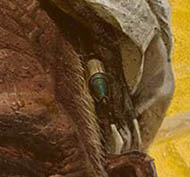
Luo Zhongli, 1980, detail © Luo Zhongli
When the works were successfully exhibited in the National Art Museum of China in Beijing in 1981, “Father”, the image of a farmer who endures the suffering and never complains, deeply moved hundreds of millions of people. The huge size and the hyperrealism of the picture were extremely fresh but tacit to those Chinese people who saw the work at the museum. Li Xianting, the editor of the official media "Fine Arts" magazine at that time, was also moved by the human compassion shown in the work. For this reason, in 1981 he used "Father" as the cover of the magazine. Only through the undisguised expression of reality can art find the truth it has lost.
Changes in social thinking after "Father"
In terms of artistic language itself, China originally had its own context of development and its own system of language. However, Chinese art since 1949 has been mainly influenced by the realistic art of the former Soviet Union, coupled with the Cultural Revolution’s censoring of the traditional Chinese context and the ban on Western contemporary art. Under the influence of this aesthetic inertia, representational realism has become the most acceptable visual narrative method for the public.
Luo Zhongli was inevitably influenced by the American photorealist Chuck Close at that time. However, instead of deliberately hiding traces of personality, emotion, and attitude to create a flat and indifferent picture as Chuck Close did, Zhongli added these feelings to his picture. "I feel that this form is most conducive to powerfully conveying all my feelings and thoughts. The arts of the East and the West have always absorbed and been influenced by each other. Forms, techniques, etc. are just the language that conveys my emotions and thoughts. If this particular language can say what I want to say, then I will learn from it.”[6] The artist seems to have used a more calm and objective approach, but made the most subjective elucidate of a farmer in the work "Father".
To the general public at that time in China, Chuck Close and modern art in Europe and America were unfamiliar and so far away. Even at the Sichuan Academy of Fine Arts, the school had bought a Japanese-published "Complete Works of the World" but it was locked in a cabinet. The students had to press their faces against the window, brush the condensation from their breath off the glass, and view the book as they would a cultural relic in a museum. Such a book would take 1-2 months to read and absorb –but only under such conditions it was possible to read about Western modern art.
For a period of time after this work, a group of artists who were contemporaries of Luo Zhongli returned to their innermost selves in pursuit of their own spirits and emotions. They became more willing to pay attention to people's daily life, and wanted to explore and express the beauty of human nature in ordinary life. The spiritual essence of their paintings was the continuation of the humanitarian sentiment.
It is precisely because of the success of “Father” that the artist was sent by the government to study at the Royal Academy of Fine Arts in Antwerp, Belgium at the end of 1983. He developed a comprehensive and deep understanding of European art and phenomena. Later, he held a personal exhibition at Harvard University in the United States, and thus gained a wide international reputation. Since then, his use of different techniques to express the language of painting has become more pioneering and expressive.
In addition to reflecting on and breaking through the constraints of the political dogma on art, Chinese artists are eager for artistic change. Art theorists have begun to introduce and translate a large number of works on the history of Western modern art, for example Herbert Read‘s: A Concise History of Modern Painting (1979), H. H. Arnason’s History of Western Modern Art (1986) and many more. In the 1980’s, influential art newspapers such as "Art" (reissued in 1976), "Art Translation Collection" (founded in1980), and "World Art" (founded in 1979) began to publish articles on a large number of Western modern art genres and artists. Faced with the influence of foreign culture as well as domestic social pressure to achieve modernization, the ruling party has adopted a more accepting attitude.
Precisely at that time, Western modern art and post-modern ideas came together and quickly merged in China. There is 1985 Art Trend[7] movement, the 89 Art Exhibition[8] etc. So far, Chinese modern art has entered the experimental stage on a large scale and has been continuously reconstructed.
However, what is significant is that the village in the Daba Mountains where the artist once lived has now lost its former prosperity. As villagers have started to go to work in cities across the country, the village has become very glum and mediocre, in sharp contrast to the prosperity of the cities. And those farmers who have moved to the city are also working hard to transform themselves into a part of the city. Farmers, who once held an important position in China's social structure, are now gradually being urbanized under the drive of the market economy, and are being marginalized in the city.
References
- Michael Sullivan, Art and artists of Twentieth-Century China, Shanghai, 2012
- Gao Minglu, Chinese Avant-Garde Art, Jiangsu Fine Arts Press, 1997
- LvPeng YiDan, The Art History of China Since 1979, Beijing, 2011
- WangYong, A History of Art Exchange between China and Abroad, Beijing, 2013
Footnotes
[1] During the Cultural Revolution, China's economy was extremely weak and faeces was the most important source of fertilizer in rural areas at that time.
[2] During the 1966-1976 Cultural Revolution, universities stopped accepting students, and the college entrance examination did not begin again until 1977. Luo Zhongli was admitted to the Sichuan Academy of Fine Arts in 1977.
[3] Deng Kaixuan was a farmer in the Daba Mountains. Luo Zhongli lived in the farmer’s home when he was in the Daba Mountains. Deng Kaixuan was also the model for the painting "Father". He has passed away now.
[4] Gao Minglu, Chinese Avant-Garde Art , ( Jiangsu Fine Arts Press,1997)P70
[5] “Fine Arts" Magazine, (Beijing,1981)Issue 9, P57
[6] "Fine Arts" Magazine, (Beijing,1981)Issue 2, Page 4
[7] The 85 Art Trend refers to an art movement towards modernism that emerged in mainland China in the mid-1980ies. The young artists at that time were dissatisfied with the line of leaning to the left of the art world at the time, and with the Soviet socialist realism art stereotypes as well as some values in traditional culture. They tried to find new blood from Western modern art, which triggered a nationwide art trend.
[8] 89 Art Exhibition, "Chinese Modern Art Exhibition" held at the National Art Museum of China in Beijing in February 1989. This is the first exhibition of concentrated Chinese avant-garde art including performance art and installation art. The artist Xiao Lu shot her installation "Dialogue" and the exhibition was forced to terminate. The shooting incident of "Dialogue" has therefore become a symbol of the 89 Art Exhibition and has an important position in the history of modern Chinese art.
published September 2020
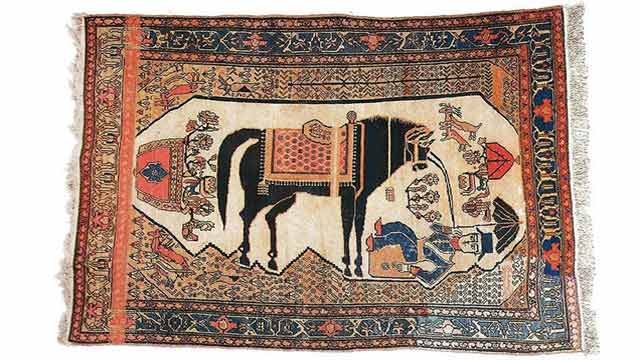
-
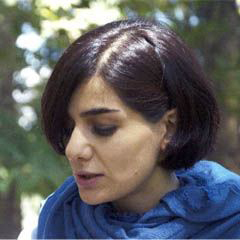 Azar Emami Pari
Azar Emami PariA carpet is neither produced nor read like other pictures. As such, how does it communicate and what is the proper way of reading a carpet? Does it enjoy an esoteric meaning? A meaning beyond that of its patterns? In other words: is the carpet a decorative object with a symbolic or iconic meaning added on top, or does it contain—at least for viewer who belongs to Persian visual culture—a meaning completely different from any other quotidian object? The mesmerizing power of the carpet lies in the fact that it convinces the viewer of the latter. Many studies on the subject aim at understanding how different Persian carpets are made, trying to elucidate the nature of their mode of production. Yet, “how the appearance is consumed”[1] has rarely been the subject of study, as well as inquiring about the causes behind the formation of such a bizarre appearance. It can easily be shown that the answer cannot be reduced to how a carpet is produced: it is clear that Persian carpets are more than, as it were, a pixelated version of Persian images found in other Persian decorative arts, or the product of a “design process” (as one understands the term today) and sheer creativity; it is rather an object unlike any other quotidian objects and not just another branch of fine or decorative arts.
It is very difficult to penetrate the different layers of meaning in a Persian carpet, at least much more so than Persian miniature paintings for example there is a winding path from form to meaning in carpets. A Persian carpet has something to say that is not a statement: it is not a text with a definitive meaning, not even one that we could call “abstract” in the sense of avoiding any reference to the real world. Similar to mystic verses of Sufis, known as shat-hiyyāt, whose general meaning is unclear to the reader, yet written down, with meaningful words, for a purpose clear to the author, the appearance of carpets insists on signifying something: they are not just pleasant melodies without words. As such, the carpet cannot be studied as an abstract painting. (Probably that is why it has rarely inspired modern Persian paintings and protects itself against easy visual plagiarism.) The image of a carpet is not the same as the carpet itself: the carpet is not produced to be “seen”, rather be “watched” in the long term. It is meant to be lived on, not to be distanced from the viewer to produce a moment of reflection, which is the essence of European painting. It is not an exaggeration to say that every Iranian grows up on a carpet and learns visual literacy from it. It is the very first window through which every Iranian look. The opposite of a Renaissance painting, i.e. a window opening to the outside world, is the carpet, not even the Persian miniature painting.
Despite its decorative function, the effect of Persian carpets, and in particular pictorial Persian carpets, on viewers do not depend on the text that accompanies it (as is the case with urban, fictional, pictorial carpets[2] and Persian painting alike). The origins of pictorial carpet have been, as it follows, purely aesthetical, nothing more.
Historically, pictorial carpets appeared as new art, not only because of a change in their function but also because of their new appearance[3]. They were woven according to the personal taste of weavers or specific clients, and for that reason, they were less mass-produced. There is no doubt that such carpets as Persian miniatures are ultimately born of the poverty of illustration[4] in Iran. Such carpets, also known as figural carpets, “emerged in the late twelfth century AH (18th century AD) following developments in various other fields of art in Iran and coincided with the emergence of new possibilities in the visual realm, such as printed pictures or photographs. All these led to a new expression in Persian carpet weaving.” (Tanavoli, 1989:9) The story narrations in the pictorial carpets of Iran have different origins. Themes of pictorial carpets include kings, epic and romance stories from classical Persian literature, religious themes and stories of Quran, dervish and Sufism, Armenians pictorial carpets, nomads’ pictorial carpets, pretty women, and animals.
In order to enter the realm of the Persian carpet, let us begin from a simpler point of departure. We ask: what is the relationship of the carpet to the space in which it is unrolled? What is the horizon of the carpet and what is space and time in the carpet? The objective form of such a relationship is reflected in the relation between the carpet and the architectural space. Of course, we have samples of carpets woven for a particular space, as well as spaces built to house a particular carpet. We know, for example, that Nasser al-Din Shah (who reigned from 1848 to 1896) ordered a complete building to be fitted with a carpet he received as a present from the Ottoman sultan. Mo’ayer al-Mamālek writes: “Abyaz Palace: Although the building is still in place, not everybody knows why it was built, therefore, some facts are mentioned here. Sultan Abdul Hamid sent dozens of pieces of furniture and some precious Turkish carpets to Nasser al-Din Shah. Several large portraits of European kings and queens painted by the most influential painters of the era were also given to Nasser al-Din Shah. As other palaces were all decorated with various ornaments and were not suitable for the aforementioned gifts, so the king ordered the Abyaz palace to be built and tailored to the size of the largest Ottoman carpet. When it was finished, they unrolled the carpet in the hall and decorated the space with precious upholstery. They hung the portraits together with another painting depicting Napoleon I, given to Fat’h Ali Shah, thus creating a magnificent hall for receiving kings and dignified guests. One day I was there when the king went to the treasury, and there he chose some artifacts to complete the arrangement of the Abyaz palace.”
The visual significance of the Persian carpet must be considered as Iranians’ historical understanding of art and painting as an independent language, and pictorial carpets can perhaps be formulated as a new form of testimony to such a language. The language begins with the synchronicity of Persian painting with literature and fiction texts and its culmination in the pictorial carpet. Persian painting is considered narrative art. “Because some example of Persian painting is an illustrated book that depicts a literary text, most of which are fiction.” (Shokrpour, Azhari, 2019:104) In Persian painting, the drawings depend on the text “and this feature is one of the main features of the illustrations of Shahnameh, which includes short and concise themes in which the narrative aspect lies. These texts were chosen for illustration because their readers were fully acquainted with the leading text, allowing the painter to show the last minutes of the events and the most notable or most tragic moments in his work.” (Shokrpour, Azhari, 2019:104) The logic of the carpet, however, is much more complex than painting. The charm and wonder of the pictorial carpet stem from the middle point between the carpet and painting, where the story originates, and which, of course, has become “inexpressible.” Neither the image nor the story is a reality of this world; just like the miniature, pictorial carpet is also an imaginary window to stories; no event or thing in that frame has a real presence. They are pure images (without any text) that create a suspended and immaterial world of colors, shapes, and textures. Pictorial carpet is a unity resulting from the contradictions between the common presence of figural pictures and details of carpet designs. That is why the carpet frame and its details have added to its grace and appeal rather than reducing the magical attractiveness. The “childish” aspect of such images, which are not solely due to the weaver's inability to render everything realistic, is a result of a vast game of imagination combined with pictures.
What is unique in the pictorial carpet is the magical aspect, and the subject of the painting is completely insignificant. Of course, in harmony with the scene, each picture has its own special figural drawing and necessities in terms of color combination. (The color combination is insignificant in nomadic and rural pictorial carpets. For example, the skin color of the body could be very strange, e.g., red, etc.). But whatever the image is, whether romantic like countless scenes of Shirin bathing with Khosrow secretly watching her or battle scenes, such as the battle of Rostam and Sohrāb, the shocking effect of the pictorial carpet is the same in each case.


Figure 4: Lilihan Poshti. The story of Khosrow and Shirin. Natural color, size 100*67 cm, Yousef Samadi Bahrami’s Collection.
Figure 5: Rostam and Sohrab, Karabakh (South Caucasus), inscription reads: “Sohrab” (inverted text), late 13th century AH, 120*85 cm, asymmetric knot, displaying 672 knots per square decimeter (Tanavoli 1989, 43) When the carpet depicts a story, it does not narrate it.
A pictorial carpet is not really depicting the place of an event or the feeling or interpretation of what happened in the scene. Apart from the feeling of wonder at the visual beauty reflected in the carpet, there is nothing but a thoughtful or emotional expression: there is no drama, no sadness or sense of impression. The event as a whole is an absent element in the pictorial carpet. All details are equally important; thus, the important function of a pictorial carpet is that it guides the viewer's gaze on numerous details of the carpet, while an inner harmony skillfully creates a strong, decorative unity. Such carpets attract viewers’ attention, not because the scene is a special story that is unsuccessful in its narration, but in the harmony with the story figures within the form of a carpet.
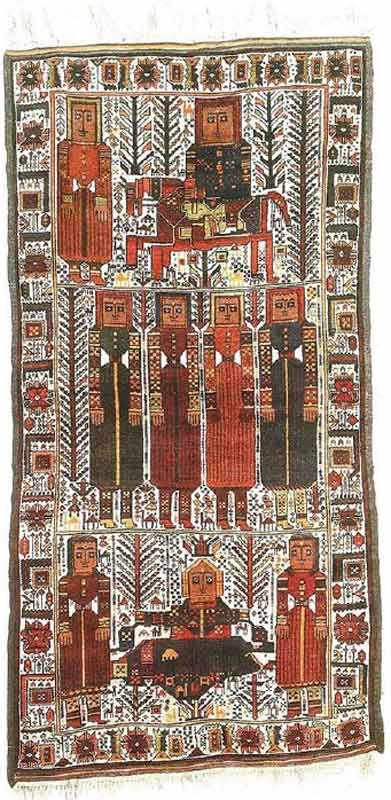
Figure 6: Baluch, Zabol, mid-14th AH century, asymmetric knot, 1280 knots per square decimetre; this carpet displays a scene from the story of Khosrow and Shirin. However, the images in the carpet do not narrative anything and if the viewer is unfamiliar with the story there is little to be understood from the images. (Tanavoli 1989, 48)
Of course, the carpet, in its physical aspect, has a distinctive relation to space in Persian architecture, as it covers a rectangular space that shall not deflect both horizontally and vertically. It is true that the carpet was not always considered a floor covering and not necessarily been rectangular in shape: as in the case of saddlebags and cushions, or carpets hanging from walls or covering a horse or a mule, and so on. Yet it is the Persian architectural space that provides a flat, rectangular space for the carpet: it is part of the formal relationship of carpets with the architectural space. This is why in European paintings that feature a Persian carpet, the first thing that strikes an Iranian viewer is the unusual use of these carpets: Hung from a window crawled up the stairs and deflected in height. This, in itself, has a definite relation to the way the carpet is seen: on the one hand, the formal carpet looks like a horizontal tableau that is clearly framed and as such forms a totality. It does not resemble, for example, the scattered Islamic designs on glazed tiles that crawl up walls whose entirety forms the totality of the building; on the contrary, the carpet has a strong, coherent framing that protects it against any deflection.
In the past, Persian carpets were not masked by pieces of furniture and thus better seen in their entirety. The carpet was the most important part of interior design. It was a furniture in itself. Thus, the carpet is fundamentally different from a painting: viewers of a carpet never actually see it in its entirety because they are already standing “on” the carpet. They never lose contact with it or distance themselves from it, far enough to see it in its entirety. They can kneel and touch it, or sit or lie down on it and get closer to it as much as they want, but their distance to the carpet never exceeds their height. The prohibition of walking on carpets with footwear allows a close and intimate relationship with the carpet, emphasizing its dignity and sanctity. Even paintings on ceilings (which sometimes reflect the patterns of a carpet, as in the case of Sheikh Safi’s tomb) do not enjoy such quality and can be seen and appreciated in one glance while remaining out of viewers’ reach. In the case of carpets, viewers can see the design from different angles and need to move in space and change their standpoint to fully appreciate the work (exactly the same way they need to circulate within the introverted spaces of Persian architecture in order to grasp a proper sense of space).
It might seem that the distance between the carpet and the observer is a secondary quality of the carpet and does not have a direct impact on the aesthetic aspect of the Persian carpet. However, we know of aesthetic systems (including that of Kant) that define the aesthetic experience fundamentally on the basis of an idea of distance. The most prominent is that of Edward Bullough (1880-1934), the English aestheticist, i.e. Psychical Distance. In a paper published in 1912, Bullough writes that the aesthetic experience takes place at a certain distance from the work, not too far nor too close, and this applies to the locative, temporal, and subjective distance of the observer from the object, and is an aesthetic principle (Neil 1995, 304), and is an element present in all art forms (ibid., 299). The transition from the agreeable to the beautiful takes place through distance (Neil 1995, 305). And it is advisable to reduce this distance both in creating and in understanding art, without having it completely removed. (Neil 1995, 302) In his view, this depends both on the audience and the object (Neil 1995, 302). For instance, the Persian miniature takes advantage of its small dimensions to reduce such distance. In carpets, however, the distance is completely different, both objectively and subjectively. The maximum distance is a person’s height and the minimum is zero. It is this distance that has resulted in the unique form of viewing carpets. The Persian carpet is not seen, but “watched” (tamāshā), as was the case with Persian gardens. That is to say, carpets were observed in motion, with a constant shift of the viewer’s point of view. The term tamāshā means “to watch” and “to walk in the garden with a friend” at the same time. Such a relationship between how carpets and gardens are viewed is by no means a coincidence. Persian carpets have long been associated with Persian gardens, sometimes even reflecting and imitating their patterns. In terms of function, the Persian carpet brings nature into the interior and plays the role of green in times of the year when grass does not grow. We know that the famous Sassanid “Baharestan” carpet had a similar function. Tabari History writes about this carpet:
“They wove a carpet with colored silk, sixty cubits in sixty cubits … they unrolled it in wintertime when no flowers blossomed and no green was seen on the globe. On the margins were sown emeralds and peridots… Omar ripped the carpet and the gems and gave each person a fair share… Ali ibn Abi Talib received his, which he sold for twenty thousand Dirhams.” (Tabari History, 1985, 41).
Thus, we encounter one of the most important subjective aspects of the relationship between carpets and architecture: the viewer is a part of the image; the observer of a carpet is “inside” the carpet. This also properly explains the horizon line in Persian carpets, which is very different from that of miniature painting: the carpet does not necessarily have a horizon line, and the horizon line is not necessarily within the carpet or in its “upper” part. The figures in pictorial carpets are not depicted “on” the carpet but are rather “inside” the carpet, like a letter in an envelope.

Figure 7: Horse and stableman, Hamedan, Darjazin, early 14th Century AH, 189*129 cm, symmetrical knot, 1296 knots per square decimeter (Tanavoli 1989, 95). The logic of the carpet design is much more bizarre than miniature. Where is the horizon line in this carpet?
This statement is also true on another level: the observer is “within” the carpet subjectively too. The carpet is not a home decoration, it is part of the home: it is home itself. This is why the unit for counting carpets, was called “home” (khāneh), or why the carpet sometimes imitates the plan of the Persian houses or gardens. Children are well enough familiar with this concept and elders respect it too. Children carefully trying to walk on the lines of a carpet pattern imagine themselves walking on a bridge above avoid. The patterns of a Persian carpet always show depth, as opposed to Persian miniature painting which appears flat and even.
So, when confronted with carpets, even pictorial ones, “touching” is more important than “seeing”. In fact, this is the only way to see it. Touching renders, us more dominant. Seeing does not allow one to understand the physical quality of a phenomenon, but the tactile sensation does. In pictorial carpets, this touching proximity is more realistic than an unattainable distance, as it empowers the viewer to touch the universe once again. The carpet is a representation of the universe, as the root of the Persian term indicates: in Haji/Engineer Travelogue, Ali Hassouri traces the root of the word Qāli (carpet), back to Qalin in the early Islamic centuries, to the words Kalinin the Sassanid era and Kar’einé in Avestan, back to the word Kāshtan (“planting”), as making every carpet knot is like planting a seed, that would later represent grass at the time of its absence in winter: the carpet is a perpetuated Persian garden. (Hassouri 2017, 42) In Mithraism, human beings are descendent of the plants: Mashya and Mashyana, the first human beings to grow out of the earth. Each knot of a carpet is a seed that is planted with hope and carries a wish, the same way lovers knot grasses in Nowruz with the hope of their wishes being fulfilled. Every Persian couple begins their married life with a home/carpet on which their children will later grow up and flourish.
Resources
- Emami Pari, Azar, and Bavand Behpoor. “The Iranian Carpet Is not a Picture”, Herfeh Honarmand (Iranian quarterly journal on visual arts), no. 73 (2019): 151-160.
- Parviz Tanavoli (1989) Iranian Pictorial Rugs (Tehran: Soroush Publication)
- Hafiz-e Abru, Nur-Allah ibn Lotf-Allah ibn 'Abd-al-Rashid Behdadini, edited by Seyyed Kamal Haj Seyyed Javadi (Tehran: Ministry of Culture and Islamic Guidance Publications)
- Ali Hasouri (2017) Haji muhandes Travelogue (Carpet Travelogue) (Tehran: Cheshme Publication)
- Doost Ali Khan Muir al-Mamalek (2011) Notes on the private life of Nasser al-Din Shah (Tehran: Iranian History Publication)
- Alex and Aaron Ridley Neil (ed.) (1995) The Philosophy of Art: Ancient and Modern Readings (Boston, Mass.: McGraw-Hill)
- shokrpour, and f.azhari , Azhari. “The role of the Figure in the Narratology of Persian Paintings” (Case Study: Six Drawings from Shahnameh Tahmasebi), Journal of Visual and Applied Arts (Quarterly Journal of Tehran Art University). no. 25 (2019): 101-121.
- Tabari History, illustrated version, 1208 ed., Astan Quds Razavi, Iran Culture Foundation, 1966, 17-18, quoted from Parham 1985, 41.
Acknowledgments
I would like to express my special thanks to my colleague and friend, Mr. Bavand Behpoor, for his intellectual support and insightful comments on this paper.
[1] The function of a carpet does not justify its appearance: Persian carpet has played throughout history a much more significant role for Iranians than merely providing a warm and soft flooring and has gained its appearance through complex and lengthy historical procedures.
[2] Persian pictorial carpets have been divided into two classes: one is urban carpets, and the other rural and nomadic ones. Urban carpets were woven according to a plan, painted by a carpet-designer, while nomadic carpets had a different origin. In Iranian villages and among Persian tribes, carpets were woven without a plan, and rather based on another carpet. When a weaver intends to weave a carpet, s/he borrows a carpet from their neighbors or relatives and uses it as a model (in local parlance: “Dastūr”). (Tanavoli, 1989:16)
[3] The installation of pictorial carpets on walls brought about changes in the way carpets were used. The new application moved the carpet from the floor and underfoot to the walls, turning it into a painting. Previously, ordinary carpets were occasionally hung on at door gates and walls, but that was a temporary function, in occasions such as wedding, religious celebrations, especially commemorating the birthday of the last Imam (the Messiah or “Mahdi”). Walls of houses, shops and markets could be decorated with carpets, a custom that still exists today. (Tanavoli, 1989:14)
[4] The 19th and 20th centuries should be considered the time of popularization of illustration in Iran. In those two centuries, a significant tendency towards simulation and naturalism became apparent in nearly all branches of art. Simulation, as a pervasive movement, attracted the attention of artists. The leaders of that movement, of course, were painters. Although painters constitute different classes and branches in this, the main goal of all groups was to depict their subjects through likeness and similarity to nature. Two groups of painters had the largest share in spreading visual arts among the masses: Coffee-House painters and religious painters. The works of these artists were widely seen and influenced the taste of artists in other disciplines, including engravers, illustrators of printed books, and carpet weavers. (Tanavoli, 1989:11)
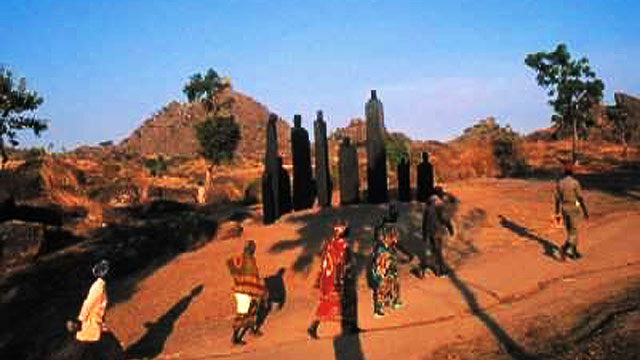
-
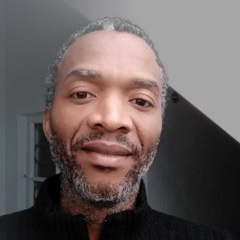 Paul-Henri Souvenir ASSAKO ASSAKO
Paul-Henri Souvenir ASSAKO ASSAKOThe image is a photograph showing details of the French artist Christian Lapie’s public installations in 2001 in the city of Ngaoundéré, capital of the Adamawa Region in Cameroon. The work consists of five modules composed of nine figures, ranging between 150 and 450cm each and laid in a semi-circular radius of 1000 cm. The pieces are made of wood and placed vertically in an upright position. The upper end is shaped like a head, giving each piece the appearance of a human silhouette. Arranged like a gathering of people dressed in local traditional attire, called boubou (a long, loose-fitting garment worn by both sexes in parts of Africa), the works are aligned in a semi-circular arc.
The work’s detailed structure is closely linked to its title Djaoulérou, which means "traditional space, place of meeting and reception". The artist echoes customs in a context where the relationship between traditional practices and Islam remains ambiguous. Islam provides an opportunity for certain members of local society to acquire privileged positions under the auspices of religion. Religion’s role in the political game has proven to be so important that post-colonial politicians have laboured to maintain control of the religious sphere in every region. Religion presents challenges for politicians in terms of governance and control. Maud Lasseur (2005, 95), echoing this sentiment, maintains that: “During the colonial period and under the regime of President Ahidjo (1960–1982), Christian missions were thus contained to the south of Cameroon so as not to hinder the Muslim aristocracy of the Far North or thwart the unifying political project of the first Cameroonian president”.
The monumental character of the work, the rhythm and movement suggested by forms treated with little attention to detail, the variations in volume and the different dimensions of each silhouette make the installation look both impressive and expressive. Each individual group of statues, displayed at the same time in different places in the city, shows how the "mysterious objects" made by a foreign artist present unfamiliar traits regarding the city’s socio-cultural imagination. The work breaks taboos: an unusual appearance that creates artistic experience, tradition and beliefs, which have become subject to manipulation and political propaganda within the society.
The work’s destruction reflects the fragility of a slavish society instrumentalized by politically motivated religious arguments in the 2002 legislative elections in Cameroon. The fact that a French artist has carried out an unusual and iconoclastic installation project in this city is seen as a provocation, particularly by the Muslim cultural authority. This religious and political authority occupies a very influential social position as "guardian of the temple" (custodian of traditions) and is in a position to incite people to commit acts of such magnitude. In addition to setting fire to the works and proceeding to uninstall them, public authorities definitively closed down the Franco-Cameroonian alliance of Ngaoundéré because of the social unrest the works provoked. This cultural centre for Franco-Cameroonian cooperation had supported the artist's installation project.
The act of vandalism perpetrated on Christian Lapie’s work exposes Cameroon’s national society in search of landmarks. Art, and particularly sculpture, has played an important role in expressing belief systems. The cosmogonic universe and the world view of the populations that have succeeded one another in this territory have been revealed through artistic representation. The bold production and reproduction of anthropomorphic, zoomorphic, geometric and imaginary forms is typical of these societies. As in many countries in sub-Saharan Africa, art has helped what people see, think, imagine and believe (J.P. Notué, 2005). Because of the lack of critical understanding of their history and the changes they experienced, societies are confronted with major shocks that have an impact on their development. Among these shocks are an ambiguous relationship to religion. Its consequences are the religious and political manipulation that societies are sometimes subjected to. One historical reason for this is the attitude of missionaries who made no discernment in the positive values of the tradition and the absence of doctrine and deep convictions of these values (E. Mveng, 1985).
Cameroon’s colonial religious legacy is one of the most important sources of the ethical foundation of its society in the 21st century. The generalization of the religious profession of faith/conversion seems to have fostered a latent form of "alienation" among the urban society. There is a superficial knowledge of both the principles of modern culture and the traditional environment, two references whose slavish play of opposites have political stakes. In Cameroon, the policy of conviviality between Islam, other religions and local cultural practices implemented by Sultan Njoya in the Kingdom of Bamum presents elements of inspiration for a compelling form of social emancipation. The policy of inculturation and multi-confessionalism has favoured the cultural openness of society and preserved, for example, the sustainability of the region’s remarkable creative industry. Art, belief systems and politics are all values of cultural expression fundamental to society.
The work breaks taboos: the artistic experience created by its unusual appearance calls upon traditions and beliefs that have become subject to manipulation and political propaganda within the society.
References
- Mveng Engelbert. 1985, Histoire du Cameroun, tom 2, Yaoundé, Ed. CEPER.
- NOTUE Jean-Paul, TRIACA Bianca, 2005, Bandjoun, Trésors royaux du Cameroun, Milan, Ed. 5 continents.
- Maud Lasseur. 2005, in « www.cairn.info/revue-afrique-contemporaine-2005 ».
- Assako Assako PH.S. 2011, l’art au cameroun du XXe au début du XXIe siècle : étude des expressions sculpturales en milieu urbain, thèse de Doctorat/Ph.D. en histoire de l’art, Université de Yaoundé 1.
- www.christianlapie.net/oeuvres/16/djaoulerou
- www.christianlapie.net/mobile/news/326/.%20http:#news
- www.christianlapie.net
published February 2020
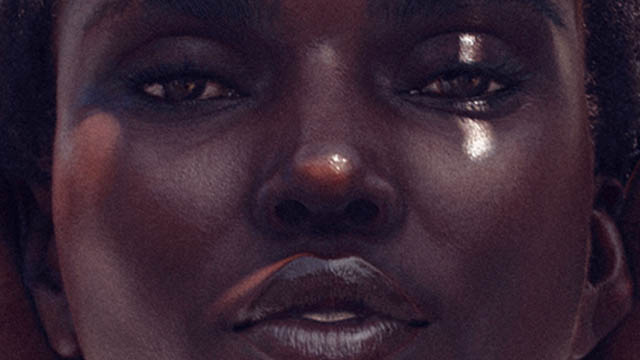
-
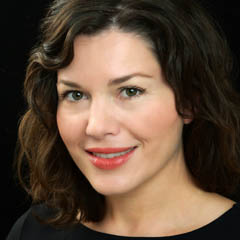 Hanni Geiger
Hanni GeigerShudu (2020), a dark-skinned mannequin based on Instagram and other social networks, is a CGI – a 3D computer graphic that, according to its creator Cameron-James Wilson (founder and CEO of the digital modelling agency THE DIIGITALS, https://www.thediigitals.com/), is considered the world's first digital supermodel. With currently more than 218,000 followers (@shudu.gram), she is one of the most booked models and has collaborations with major fashion companies such as Oscar de la Renta or the superstars Tyra Banks and Rihanna (Square, 2018). Yet the genesis of the mannequin and virtual influencer is anything but glamorous: after years as a photographer in the London fashion industry, Wilson retreats to his mother's garden shed in Weymouth, Dorset, and experiments with various design programs on a very cheap gaming computer (Jackson, 2018). In designing Shudu, he was primarily driven by a desire to work freely and “[…] focus on the art rather than the money” (Jackson, 2018). Shudu was intended to be a product of pure creativity, regardless of her later successful integration into the fashion industry (Jackson, 2018).
It takes a closer look to detect the artificiality from the model. Thanks to various digital image editing programs such as Marvelous Designer, CLO and Daz 3D, Wilson deliberately adds small flawed constructions to his very naturalistic-looking mannequin (Jackson, 2018; Square, 2018): scars, hairs, wrinkles and pores provide more liveliness, and thus also more “truthfulness”, if one were to argue in the Benjaminian sense with the aura of the unique or authentic. Basically, this is a completely contrary approach to high-end fashion photography, which classically aims to remove any physical imperfections from the human models until they mutate into doll-like, enraptured beings. This already shows through the external observation of the virtual model that „authenticity“ in the context of digital media and the outdated understanding of reality as distinct from virtuality must be rethought and oppositions in the technical, but also especially in the philosophical-social sense must be questioned.
In order to get closer to this „reality“ or the societal significance of the digital model, it is imperative to look at the controversial debates surrounding the black mannequin. As a white man, Wilson has more often had to face accusations of commercializing black culture, which is legal but equally questionable (Square, 2018). Under the rubric of “cultural appropriation”, “racial expropriation”, “racial capitalism” (Cedric J. Robinson) or “racist plagiarism” (Minh Ha T. Pham), the economic and social exploitation of inferior, marginalized cultures by the dominant white culture is understood as a neo-colonial approach, especially in the broad sector of industry. In this process, social as well as economic value is drawn from an ethnic identity, even generating a “commodity” from it, without thinking about the painful or unpleasant part or even giving minorities a share of the profits. Wilson's implementation of diversity and responsibility in the design process could, according to critics, be read as a clever marketing strategy – after all, “exoticized” phenotypes with very dark skin, high cheekbones and slender, tall stature are currently in vogue (Square, 2018). Particularly problematic in Shudu's design process appears Wilson's inspiration in the “Princess of South Africa Barbie doll”, a special edition Barbie launched in 2002 as one of the “Dolls of the World” collection (Khoabane, 2018). The digital avatar is said to have a similar origin and motivation: born out of the imagination of white companies and creatives to generate commercial success without knowing, considering or including the reality of people of color in the creation and sales process (Square, 2018).
For a holistic understanding of the figure, however, it is also important to analyze it beyond stereotypical argumentation and against the backdrop of its time, its creators and its consumers. As Generation Z and digital natives, the creators and users of virtual influencers are inevitably shaped by the technological changes of everyday life. Their thoughts and actions are primarily derived from the fascination with digital design, which increasingly merges the real and the virtual and makes physically, socially and culturally significant differentiations recede into the background. Wilson seems to use the technical qualities of the digital image, such as its mutability and ubiquity, to draw a picture of a decidedly plural, heterogeneous society in a sustainable way that is independent of time and place. Unlike the dys- and utopian visions of the future of human beings in classical fashion photography or in numerous digital drafts of human beings in art, the figure that exists only virtually seems to be the digital embodiment of a thoroughly real and, above all, present world of life characterized by diversity. With her obvious distancing from the white, male and Western-dominated political and economic mainstream, Shudu offers a template for breaking with the universalism of imperially knitted modernism via strategies of so-called inclusive marketing, which consciously considers diversity in the design process1.
The fact that the digital visualization of a virtual body that stands for diversity, such as Shudu’s, is particularly suitable for creating meanings around the human body, goes back to the postmodern discourse on the epistemology of the body and the knowledge attached to it. As Jay David Bolter recognized in the early 1990s, we as human beings know something by virtue of our bodily and social situations and not through a process of abstract and disinterested thought (Bolter, 1996, 85). Time, place and context thus determine the so-called specific “situated knowledge”, which can never be universal (Haraway, 1988). While in the 1990s transhumanist, biotechnological processes such as genetic engineering and cloning changed the body, in the (post-)digital age a new attention to the physical is evident, which is shifted to the realm of digital image production (Kröner, 2019, 72–73). What becomes evident is that despite the temporary disappearance of the human body through its dissolution into data and bits, it returns on screen in an altered and far more flexible form than the carnal. Posthumanism, following on from the tendencies of postmodernism, then makes use of digital image genesis and manipulation to base the epistemology of the body and its situatedness on the complete rejection of humanism as a Western-determined anthropocentric unity and superiority. These aspects could be relevant precisely to the reading of Shudu. The hierarchical scaling of people according to gender, ethnicity, class, sexual orientation, ability or age, which is characteristic of humanism, is to be fundamentally abandoned with the rejection of the onto-epistemological superiority of the human species (Ferrando, 2008, 438–439). Human interconnection, the symbiotic relationship with the non-human (Haraway, 2008; Wolfe, 2010) and the recognition of so-called “more-than-human geographies”2 are at the forefront of these conceptions of the body (Ferrando, 2008, 438–439). Beyond bias, dualisms and hierarchies, a (re)figuration of the human beyond the human that recognizes nature as well as technology in unity with the human (Haraway, 1985/2016) manifests itself in Shudu as a visual representation of Donna Haraway's cyborg figure. Thus, it seems that it is precisely thanks to the digital-technological “liquidity“ of bodies, techniques and media that Haraway's vision has been fulfilled: with the help of their transnational, hybrid nature, (digital) cyborgs develop subversive strategies of “writing” as a powerful form of political struggle against oppression (Haraway, 1988; Schmitz, 2016). Such “writing” (and thus also speaking) negates the dream of a common language and seemingly homogeneous identity (Haraway, 1988; Schmitz, 2016). In this respect, Shudu, as just such a (digital) cyborg, offers the template for multiple localization –against organic holism, unambiguous classification, and antagonistic dualisms (Schmitz, 2016).3
This then also includes the fact that virtual figures such as Shudu can be designed, consumed, exploited, criticized and thus also shaped on a global level in a socially, gender and culturally largely independent way4 – unlike the real, expensive Barbie dolls. With more images of underrepresented people in global circulation, habitual ways of seeing and thinking can be permanently changed, which could open up opportunities for marginalized groups, also from an economic perspective (Slay, 2018). With his collaborations with numerous representatives of the Black community as well as the Black staff team of hair stylists, make-up artists as well as also real Black models he stages for certain brands alongside Shudu (Square, 2018; Wilson 2021), Wilson intervenes in the working world and the economics of fashion. By consciously involving people of color in the design, styling, marketing, sales and profits of his company, his digital embodiments of elastic otherness impact the direction of a society that seeks to transcend Western-determined barriers – from a variety of perspectives and fields of action.
In this way, the initially small companies that originated in a decidedly plural society seem to be using both simple and advanced digital technologies to draw artificial images of a reality that has always been characterized by diversity and particularisms. The fact that the artificial figure (certainly also for marketing reasons and due to the entertainment industry) enters into a targeted interweaving with the analogue world through the staging with real people in real settings, increases its credibility and thus the social, economic and political influence of digital (human) images. Thus, these creators, who have long since outgrown their infancy and cooperate with big brands, seem to initiate a new “decentralization” of society as well as of the internet because of their politically underpinned messages about inclusion, heterogeneity and equal opportunities – and regardless of their possibly commercially colored motivation. If the dissolution of boundaries between the real and the virtual, nature and the artificial, the human and the non-human (Barron, 2003), and consequently also between art and commerce, responsibility and economy, truth and lies, majority and minority, genres, techniques and media no longer seem socially or scientifically relevant, the question of categorizing people according to skin color or ethnicity will no longer have to arise.
At this point, however, AI should also be taken into account as another possibility of digital “humanization”, which, in contrast to the purely external formation already described, concerns an “inner”, algorithmically controlled shaping of the “human-machine”. The juxtaposition of both types of artificial human creation becomes relevant in the question of the generation of “truth”, which algorithmically controlled AI – unlike the digital images and animations of social diversity mentioned above – in no way answers with the claim to represent the social cross-section. As a neural network, AI processes data such as words and images statically, it calculates the probabilities and says what the majority says and thinks (Simanowski, 2021). However, if the production of AI-generated “human images” is mainly based on large, Western-managed companies and the knowledge infiltrated into the machine is fed from data sets of a white, male majority belonging to the global North – without being externally curated or supervised – every minority and individuality is silenced (Simanowski, 2021): data inclusion on the one hand thus means the exclusion of diverse social structures on the other. This would, as it were, preprogram the return of the “gatekeepers” whose disempowerment through the internet was previously welcomed so enthusiastically (Simanowski, 2021). In this case, it becomes clear that technological progress does not necessarily go hand in hand with social progress (Simanowski, 2021).
Finally, it should be noted that the technologically induced change in the production and perception of the digital (human) image challenges us to critically rethink traditional systems of order. The interweaving with digital technologies seems to make the physical body and its interior comprehensible as an open system intertwined with its environment, whereby entrenched biases and dualisms could be invalidated and a multi-perspective view of society, politics and the economy could unfold. Whether this change in perspective can lead to a more open, even tolerant society in the long term will become clear in connection with further steps in the development and the future horizon of impact of the digital image in art, society, politics and science.
Footnotes
1) Inclusive marketing aims to create a sense of community through “authentic” cultural values inherent in the customer base. In doing so, the personal perspective of the designers, including their prejudices, should be excluded and a design for the whole of society that is as broadly conceived as possible should be created (Saputo, 2019; Maier 2021).
2) The term goes back to the findings of new cultural geography, which is based on theories of human geography. The aim of its research is to question the contemporary relationship of people to the living beings and things in their environment. Among other things, this involves the correlation between the human and the non-human, nature and culture, people and technologies. See most recently the events at the University of Bern on “More-than-human geographies”: https://www.geography.unibe.ch/forschung/sozial__und_kulturgeographie/lehre/seminar_mehr_als_menschliche_geographien/index_ger.html.
3) Against the backdrop of Haraway's theories, this multiplicity of localizations could then be conceived with the complete abandonment of the concept of identity, if relations were created based on choice in conscious coalitions and political kinship via so-called “affinities”. See Haraway 1988; Schmitz, 2016.
4) It is important to remember that although digital images circulate worldwide, they are not equally accessible to everyone in the context of divergent cultures, political, religious and sexual restrictions. Participation in a digital “global culture” is therefore always accompanied by exclusions, interruptions and detours.
References
- Barron, Collin (2003). A strong distinction between humans and non-humans is no longer required for research purposes: A debate between Bruno Latour and Steve Fuller. History of the Human Sciences, 16(2), 77–99.
- Bolter, Jay David (1996). Virtuelle Realität und die Epistemologie des Körpers. Kunstforum International. Die Zukunft des Körpers I, 132(November–January), 85–89.
- Ferrando, Francesca (2018). Transhumanism/Posthumanism. Posthuman Glossary, edited by Rosi Braidotti & Maria Hlavajova, Bloomsbury Academic, 438–439.
- Haraway, Donna J. & Wolfe, Cary (2016). A Cyborg Manifesto. Science, Technology, and Socialist-Feminism in The Late Twentieth Century (1985). Manifestly Haraway (3–90). University of Minnesota Press, http://www.jstor.org/stable/10.5749/j.ctt1b7x5f6.
- Haraway, Donna J. (1988). Situated Knowledges: The Science Question in Feminism and the Privilege of Partial Perspective. Feminist Studies, 14(3), 575–599.
- Harraway, Donna J. (2008). When Species Meet. Posthumanities, Volume 3, edited by Cary Wolfe, University of Minnesota Press.
- Jackson, Lauren Michelle (2018, May 4). Shudu Gram Is a White Man’s Digital Projection of Real-Life Black Womanhood. The New Yorker. https://www.newyorker.com/culture/culture-desk/shudu-gram-is-a-white-mans-digital-projection-of-real-life-black-womanhood.
- Khoabane, Rea (2018, May 20). Meet Shudu: the world’s first digital black supermodel. Sunday Times. https://www.timeslive.co.za/sunday-times/lifestyle/2018-05-19-mock-princess-meet-shudu-the-digital-supermodel-turning-heads/.
- Kröner, Magdalena (2019). Liquid Bodies. Ein subjektiver Überblick. Kunstforum International. Digital. Virtuell. Posthuman? Neue Körper in der Kunst 265(January–February), 72–115.
- Maier, Birgit (2021, February 5). Du bist nicht alle – warum inklusives Design uns all angeht und wie es gelingen kann. OnlineMarketing.de. https://onlinemarketing.de/marketing-tools/inklusives-design-geht-alle-an-wie-es-gelingt.
- Saputo, Sandy (2019, June). How Rihanna’s Fenty Beauty delivered „Beauty for All” – and a wake-up call to the industry. Think with Google. https://www.thinkwithgoogle.com/future-of-marketing/management-and-culture/diversity-and-inclusion/-fenty-beauty-inclusive-advertising/.
- Schmitz, Sigrid (2016, July 12). Cyborgs, situiertes Wissen und das Chthulucene. Donna Haraway und dreißig Jahre politischer (Natur-)wissenschaft. Soziopolis. https://www.soziopolis.de/cyborgs-situiertes-wissen-und-das-chthulucene.html.
- Simanowski, Roberto (2021, April 28). Identitätspolitik und künstliche Intelligenz. Es droht eine Tyrannei der Mehrheit (audio article). Deutschlandfunk Kultur. Politisches Feuilleton, ARD-Audiothek. https://podcast-mp3.dradio.de/podcast/2021/04/28/kuenstliche_intelligenz_identitaetspolitik_und_die_drk_20210428_0720_58851d76.mp3.
- Slay, Nick (2018, April 9). Twitter Reacts to Virtual Influencers: Is Shudu Art or Appropriation? The Source. https://thesource.com/2018/04/09/twitter-reacts-to-virtual-influencers-is-shudu-art-or-appropriation/.
- Square, Jonathan (2018, March 27). Is Instagram’s Newest Sensation Just Another Example of Cultural Appropriation? Fashionista. https://fashionista.com/2018/03/computer-generated-models-cultural-appropriation.
- THE DIIGITALS. Shudu.Gram. Instagram. https://www.instagram.com/shudu.gram/?hl=de.
- Wilson, Cameron-James (2021, April 30). How Digital Models are Changing the Face of Fashion. Lecture at the Online Conference „The Digital Image – Social Dimensions, Political Perspectives and Economic Constraints“, Ludwig Maximilian University of Munich, April 28–30, 2021.
- Wolfe, Carry (2010). What Is Posthumanism? University of Minnesota Press.
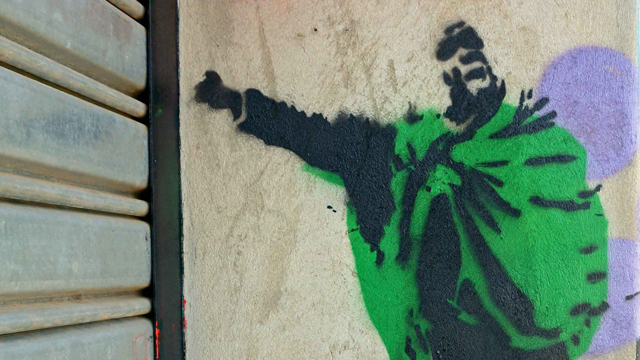
-
 Runette Kruger
Runette KrugerCape Town based Tokolos Stencil Collective uses stencil and graffiti to address socio-political issues such as lingering racial inequality, labour exploitation, segregation, and poverty. The name of the collective refers to a dwarflike mythical being, the tokoloshe, that materialises at night to frighten unsuspecting victims, now mobilised by the Collective to “terrorise the powers that be”, or, the status quo of inequality (Tokolos-Stencils, 2015). The declared aim of the Collective is to highlight continuing spatial and social segregation in a post-apartheid South Africa (Botha, 2014).
The social discrepancies whereby the majority of South Africans continue to experience social and economic isolation are addressed by Adato, Carter and May (2006), who cite the Poverty and Inequality report of 2000. In the report, South Africa is described in terms of two parallel worlds, “one, populated by black South Africans where the Human Development Index (HDI) was the equivalent to [that of] Zimbabwe or Swaziland. The other … [populated by] white South Africa in which the HDI [was] between that of Israel and Italy” (Adato, Carter and May, 2006, p. 226). This inequality had, disturbingly, only deepened between 2000 and 2006, and in a March 2018 report by the World Bank, South Africa is cited as the most unequal country globally in 2015, based on the Gini coefficient of 0.63 of that year (World Bank, 2018, p42). The Gini coefficient measures the gap in income between the wealthiest and poorest members of a population. A score of 0 would indicate absolute income equality, and a score of 1 would indicate that one person owned all the wealth. This disparity, as well as the resultant exploitability of the poor, informs the Tokolos Stencil Collective’s main subject matter.
The most widely recognizable image associated with the Collective is the Remember Marikana stencil, which combines these words with an image of Mgcineni Noki, known as Mambush to his friends and family, or, within the context of the Marikana massacre, The man in the green blanket. The Marikana event played a formative role in the establishment of the Collective – it was founded in 2013 on the day of the first anniversary of the event (Anaya, 2014). The massacre is widely regarded as a watershed crisis, comparable with the Sharpeville tragedy of 21 March 1960, now commemorated as Human Rights Day.
Noki was a community leader who became a prominent news figure in the days before the Marikana massacre, identifiable by the bright green blanket tied around his shoulders. The Marikana massacre took place on 16 August 2012 when striking miners working at the London-based Lonmin Platinum Mine in the North-West Province were gunned down by police wielding automatic rifles, violently ending a six day build-up of tension. Noki grew up in Thwalikhulu, a small village in the Eastern Cape, and was aged 30 at the time of his death. He had a wife and two year old daughter who lived in Carletonville, about 100km away. He is reported to have attempted to de-escalate the growing violent skirmishes, and to focus the gathered strikers on their aim – to increase their wages. The evening before the massacre, the miners were led to believe that if they returned to work, wage negotiations would begin. In the hours before the final events, while the miners’ repeated requests for negotiations were ignored, they were finally beseeched by their union to withdraw. Weighing up the growing indications of a final crack down, Noki began to lead a group of miners away from the outcrop of rock that had been the main scene of conflict over the course of the week. As they reached the nearby settlement their path was blocked by police and barbed wire. Noki led the men another route, only to be blocked again. The ensuing gunfire on the group led to the death of 17 men, Noki among them, identifiable by his green blanket as he lay on the ground. A second group of men were also attempting to leave the site, and were fired at with 295 bullets, resulting in 17 more casualties. The strike continued for another five weeks before the mining company agreed to negotiate. Pay was increased by 7% (Davies, 2015).
I specifically chose this image of Noki, his arm raised while exhorting and encouraging his fellow workers, instead of the dehumanising imagery of up-close, lifeless mineworkers that was freely shared by the press. In contrast, this image in the Remember Marikana stencil shows him as a leader with courage and purpose, and has become an iconic symbol of the struggle for dignity and an adequate wage among the most exploited workers in South Africa, on whose labour an economy that they are unable to access, has been built. Commenting on the lot of the under-classes in 1940, during the impending humanitarian crisis of the Second World War, Walter Benjamin (1969, p. 255 original emphasis) reminds us that “every image of the past that is not recognized by the present as one of its own concerns threatens to disappear irretrievably ... To articulate the past historically ... means to seize hold of a memory as it flashes up at a moment of danger [failing which] even the dead will not be safe”. The Remember Marikana image reminds us that it is crucial to prevent the sacrifices of the most vulnerable members of society from slipping into the amnesia of oblivion.
References
- Adato, M., Carter, M.R., & May, J. (2006). Exploring poverty traps and social exclusion in South Africa using qualitative and quantitative data. The Journal of Development Studies, 42(2), 226-247.
- Anaya, V. (2014, September 10). Tokolos Collective: “Cape Town is a very oppressive place for the poor”. Wiriko Artes Y Culturas Africanas. Retrieved from https://www.wiriko.org/tag/marikana/
- Benjamin, W. (1969). Illuminations. Edited by Hannah Arendt. New York: Schocken.
- Botha, N. (2014, November 21). Tokolos Stencil Collective: 'Crap' art designed to unsettle. The Mail & Guardian. Retrieved from https://mg.co.za/article/2014-11-21-tokolos-stencil-collective-crap-art-designed-to-unsettle.
- Davies, N. (2015, May 22). The savage truth behind the Marikana massacre. The Mail & Guardian. Retrieved from https://mg.co.za/article/2015-05-21-the-savage-truth-behind-the-marikana-massacre.
- Tokolos-Stencils. (2015). Retrieved from http://tokolosstencils.tumblr.com/.
- World Bank. (2018). Overcoming poverty and inequality in South Africa: An assessment of drivers, constraints and opportunities. Washington DC, USA.
published March 2020
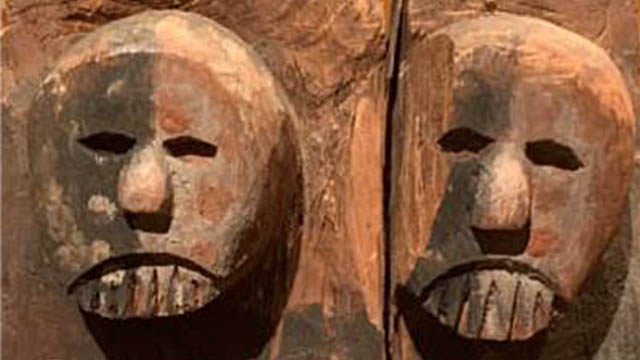
-
 Patrique deGraft-Yankson
Patrique deGraft-YanksonExploring an Enigmatic Piece of Traditional Cameroonian Sculptur
The Veranda Post found in Museum Fünf Kontinente is an exemplification of the extent to which indigenous Africans mutually reinforced socio-religio-cultural existence and expressiveness of form through sculpture. Various examples of these artefacts abound in the collections of African plastic artforms found in many museums across the globe. The beauty in experiencing, analysing and speaking about this artwork (as well as many of its kind), lies within the absence of authenticated historical and analytical literature on them. This makes it possible for the observer to exert complete authority of personal perception and interpretation devoid of any fixed attitude that dictates, interfere or curtails aesthetic enjoyments, interpretations and judgements, as attempted in this presentation.
With the dimensions of 199 x 60 x 50 cm, the Veranda Post found in Museum Fünf Kontinente is one of the numerous examples of the African artistic expressiveness, confirming the artistic prowess of the traditional African. Examples of these artefacts abound in the collections of African plastic artforms which record indigenous religious beliefs, practices and performances that date back from the beginning of African history.
As typical of most indigenous African sculptures, this work is not only uncaptioned, but the artist/creator is not known. What is known, however is that, its peculiar characteristics and style makes it easily identifiable and representative within the milieu of popular African sculptures. According to the Museum Fünf Kontinente records, this work was collected from 'Kamerun'. 'Kamerun' was an African colony of the German Empire between 1884 and 1916, which was located in the region of today's Republic of Cameroon (Wikipedia, 2020). Comparing the characteristic features of this sculpture with similar sculptures described by some art historians as Veranda Posts created as part of ancient African monumental architectures found in the Cameroons Grassland (Willett 1981) therefore, it is not difficult place it within that category. Hence its caption.
As can been seen from similar ‘posts’ and judging from the elaborateness of the images created on them, the major reason for the production of these posts was more to afford the sculptor or sculptors the opportunity to decorate the buildings with stories, rather than serving as supports (see figure 1).
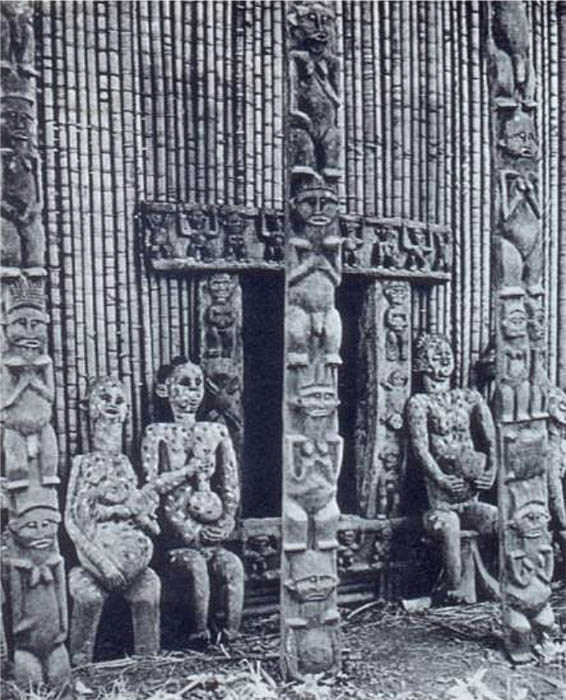
Figure 1: Ancestor statues, carved door-frame and verandah posts (Source: Willett 1981)
As said above, the beauty in analysing and speaking about this artwork (and many of its kind), lies within the absence of historical and analytical literature. The fact that this makes it possible for me (and for that matter any other observer) to exercise personal powers of perception and interpretation without any fixed attitude to direct or curtail their aesthetic interpretations and judgements made it my object of choice for this project at the Museum Fünf Kontinente.
Going by Margaret Trowell’s generalisations about African art, this Veranda Post can be classified under the ‘spirit-regarding’ art. Like many others of its kind, this work, which has front and back views, is flanked with human and other figures, ostensibly those of ancestors and is symmetrically disposed about a vertical axis, rendering it frontal at both sides.
Analyses of the images created on this pole reveal striking similarities between the age old traditional religious practices of the African and the Western religious beliefs and practices brought in by the earlier missionaries.
At the direct look of the object from the front (as it has been positioned at the museum, but actually one of its two sides), a prominent kneeling figure with hands clasped together unto the chest (much like the praying hand) can be seen in a pose that looks very much like the kneeling praying postures at Christian worships. To the African, this posture is not only assumed at prayer sessions as a visual image of submission to God’s authority, but is also exhibited as a sign of respect, humility and total surrender to a superior authority. For the sculptor to present the kneeling man as a central figure and subsequently rendering all other human figures in similar submissive postures therefore makes the theme of prayer, submissiveness and spirituality very strong in the composition.
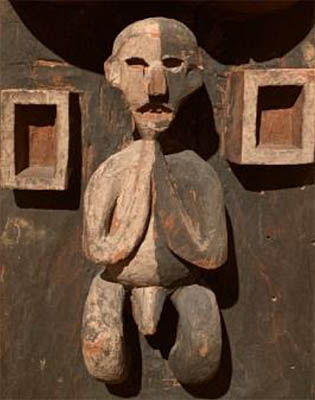
Figure 2: The kneeling or praying figure
The kneeling man is placed right below two human faces whose prominence and positioning easily pass them for elders, superiors, or better still, ancestors. Before the ancestors, all supplications are made, and through them, request are carried through to the supreme God.
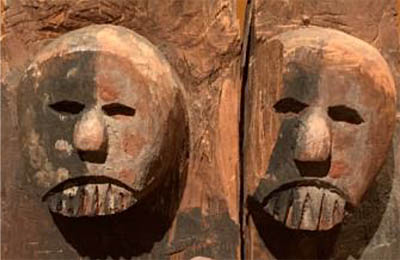
Figure 3: Ancestor figures
The importance of the two faces and emphasis on their superiority is further strengthened by a strong demarcation between them and the kneeling man through a thick rigid contoured line that forms a partition between the elements. This could be interpreted as a spiritual borderline that separate the spiritual world from the physical world. Generally, the African believes in the existence of the physical and the spiritual worlds as separate entities and this demarcation clearly depicts this belief. Also worthy of notice is the orientation of the demarcating border which rhymes with the praying hands of the kneeling figure, thereby visually connecting the figures. This carefully chosen placement of the two faces in the composition alludes to the supremacy of the ancestors and their exclusive existence in the after world as well as their connection with humans.
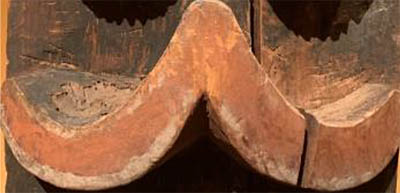
Figure 4: The spiritual borderline
Another striking imagery is created with the placement of a very visible image rendered in concentric circles. Among many African ethnic groups, the circle represents completeness, holiness, perfection and other such attributes ascribed to the supreme being (God). Among the Akan people of Ghana, for instance, the Adinkra symbol called Adinkrahene (king of Adinkra symbols) is presented as concentric circles. This symbol represents authority, leadership and charisma. The sculptor most likely created a bull’s eye of this symbol as an indication of exactly where this particular post belongs. The post could possibly be one of the furnishes for a palace or the abode of a traditional priest. This could also suggest the likelihood of the prominent kneeling figure being the King or the chief priest. Considering the atmosphere created by these symbols, the circle, with the kind of prominence it exudes could also represent the omnipresence of the supreme being, thereby heralding the people’s belief in the iniquitousness of God and His closeness to mankind.
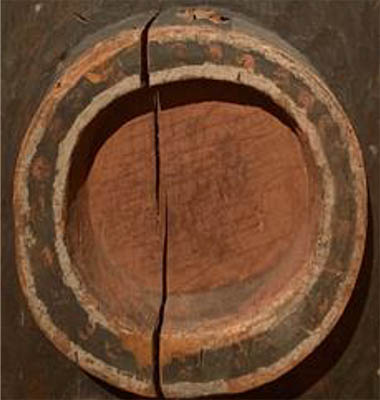
Figure 5: The concentric circles
Other recognizable images of animate and inanimate objects in the work include crocodiles, lizards and geometric shapes. Whilst it is likely that the geometric figures may have been deliberately presented to create balance, simulate a built living environment and arouse aesthetic sensibilities, the images of animals like those of the crocodiles have significant meanings as far as African culture and belief systems are concerned. Among some ethnic groups in Africa, crocodiles are believed to be the souls of ancestors who come back to live with men. Examples are the crocodiles in the Crocodile Pond at Paga in the northern part of Ghana who virtually live peacefully among the people. There are numerous African stories about crocodiles coming to the aid of men to either protect them or lead them to safety. Their inclusion in this particular work therefore is to establish the existence of spirits among men, especially as humans pray to seek their guidance and protection.
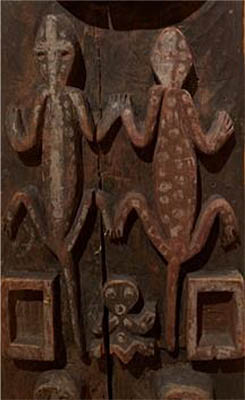
Figure 6: The crocodiles
Considering where it was created and where it is located now, as well as the current effort towards extracting a meaning out of its symbolism, this veranda post and many other such African artefacts in several museums around the globe have demonstrated how images and symbols resonate relationship between cultural practices around the world. The confluence of symbolic interpretations of the icons in the traditional African religions and the Euro-Christian religion, as depicted in this veranda post, gives justification to Africa’s unquestionable acceptance of Euro-Christianity and all the associated visual cultural practices.
For comparison, also read Karin Guggeis' analysis of this object here.
References
- Roy, C. (2019). Signs and Symbols in African Art: Graphic Patterns in Burkina Faso. Signs and Symbols in African Art: Graphic Patterns in Burkina Faso. https://africa.uima.uiowa.edu/topic-essays/show/38?start=13
- Wikipedia. (2020). Kamerun. Kamerun. https://en.wikipedia.org/wiki/Cameroon
- Willett, F. (1981). African Art. London: Thames and Hudson.
 ISB_Team
ISB_TeamThis 'Veranda Post' is variously referred to (mostly in relation to its architectural-functional context) lintel or "te ken dy dye" (in the local Bandjoun language - PHSAA), porch post, house front pillar, post, cult house post (M5K, p. 17), Cameroon post / family crest (Macke at M5K, 13, 24). Post, however, in the sense of sign (post-it) is suggested by PdGY to address the communicative function. Other designations do not address the function, but limit themselves to the given, perhaps to avoid any pre-interpretation: 'sculpted wooden block' (Kecskési 1999 n. 108) or 'large carved square wooden block' (Kecskési 1976, p. 22).
Object biography: The object was taken before 1893 by Max von Stetten during expeditions on the Bamileke Plateau (south-western Cameroon), where it was presumably part of a meeting house of a confederation. Stetten (1860-1925) was German commander of the Kaiserliche Schutztruppe for Cameroon until 1896. Cameroon was a German colony at that time. The exact circumstances of how the object came into Stetten's possession are unknown, as is its original location and context.[2] In 1893, the Royal Ethnographic Collection acquired the pillar as a gift from Stetten.[3] In 1912, a photograph of the pillar was published in the Almanac of the Blaue Reiter. It is currently on display in the permanent exhibition in the Museum Fünf Kontinente Munich in a niche - a mirror allows a view of the second side (see Fig. 2). Along with other objects from the collection, it is currently the subject of a transnational project on their provenance (GI).
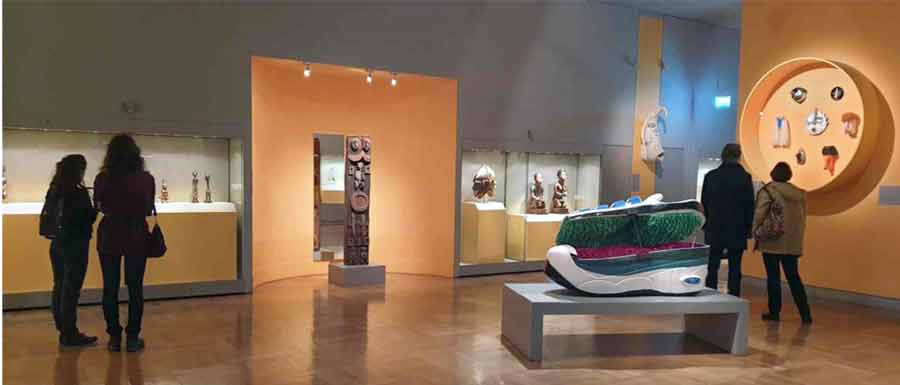
Fig. 2
Status: In comparison with carved mullions on façades of royal residences in the Cameroon grasslands (Fig. 3),[4] other mullions or door frames in the Museum Five Continents (M5K, p. 17, Kecskési 1999 No. 11, 70, 75) or in the Humboldt Forum Berlin, there is a partial similarity of motifs, but a strikingly 'archaic' formal language. Other examples are clearly more 'elaborate'. The multitude suggests that this type of pillar is quite typical of works from this period in this region of West Africa.
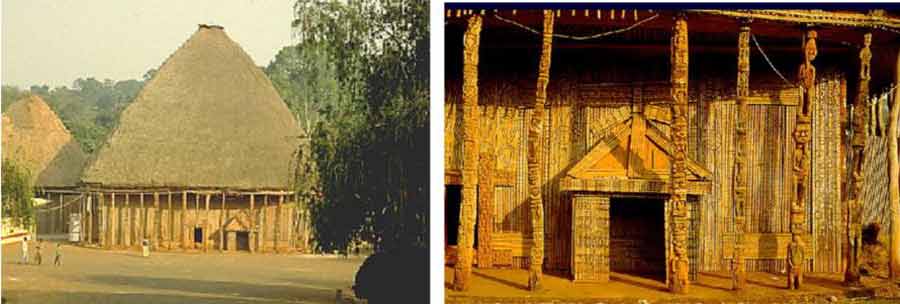
Fig. 3
Interpretation
The current view of the work
For the interpretation, the following questions lend themselves to art lessons: Form, iconography (meaning of the motifs), function, theme (or core idea) of the object, i.e. an interpretation.
With regard to the guiding idea of multi-perspectivity, two positions will be addressed: On the one hand, the view of today on the basis of ascertainable contexts, which seeks to understand the object from its time of origin and its context of origin. On the other hand, the view of the object by the artists of the Blaue Reiter. The comparison of these perspectives seems particularly relevant from an art didactic point of view, even though other perspectives would be conceivable, e.g. from the point of view of museology, provenance research, from the context of current restitution debates, etc. However, these are addressed in the teaching suggestions.
Shape
At first, the pillar develops an immediate physical presence for the visitor: through its sheer size (larger than life, almost square in plan), the materiality of the massive, cracked block of wood (the outline is irregular and probably corresponds to the tree) and the clear, concise, reduced language of form, whose meaning seems inaccessible. The surface treatment is archaic, the wood is more hewn than carved.[5] Thus it appears powerful and at the same time mysterious, which is supported by its presentation in the exhibition on a plinth and without glazing (see Fig. 4).
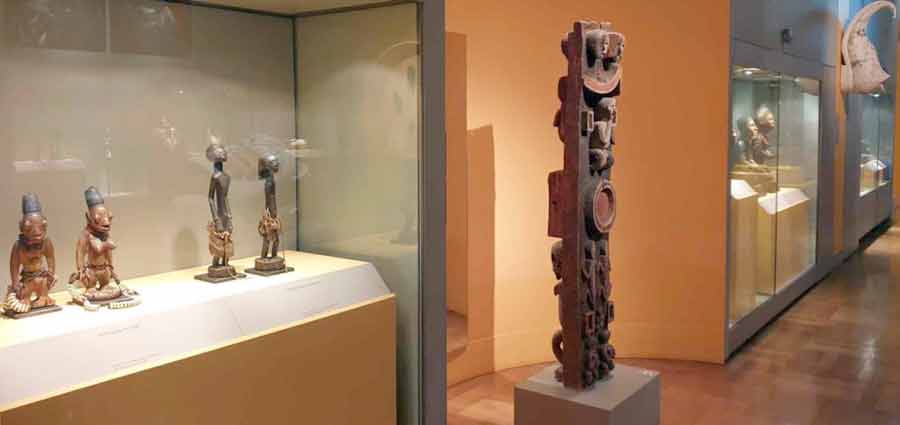
Fig. 4
A closer look reveals how the sculptor interweaves various modes of representation between complete abstraction (circle, rectangle) and representationalism (human figures, animals) in a compositional way[6] , monumentalising the individual motifs through internal symmetry, geometrisation, frontality and statics. This is supported by the painting (see Fig. 5). In this reduction, everything narrative is missing. The representation becomes emblematic, it becomes a symbol.
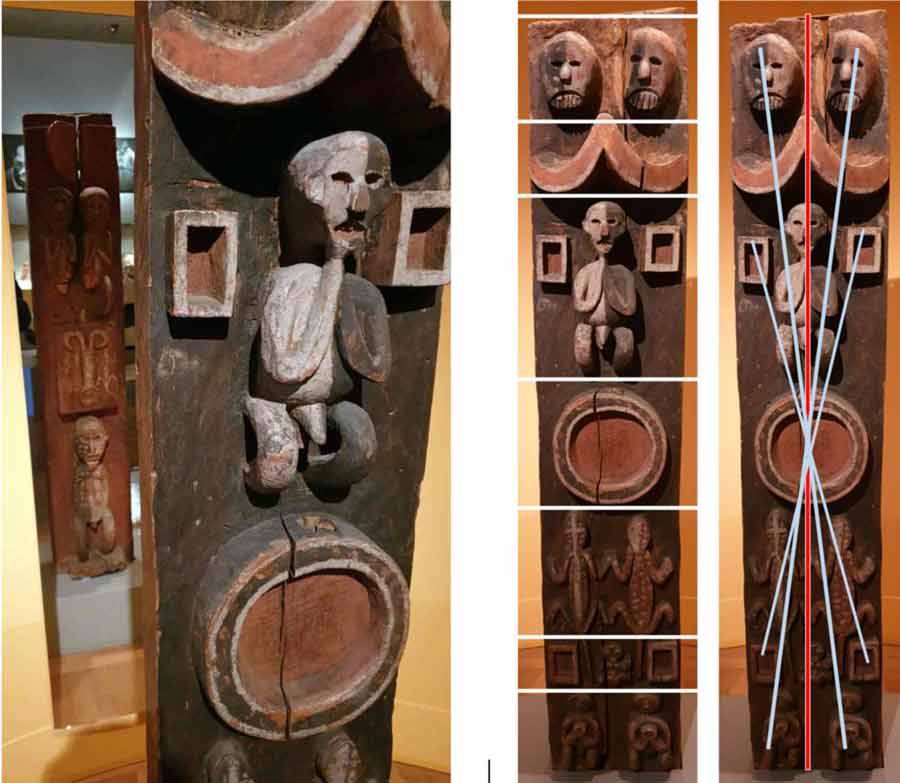
Fig. 5, 6 and 7
This is also supported by the overall composition, which obviously follows a calculated geometric order. It is strictly horizontally divided into individual zones, only once do lizard tails protrude into another zone. However, the separation into individual layers is ingeniously overcome compositionally by the strict axial symmetry in the vertical, but also by the point-symmetrical arrangement around the respective centres. The result is a tension between the contradictory compositional principles (see Figs. 6 and 7) that is decisive for the effect of the pillar.
The lack of any narrative on the one hand and the high creative effort on the other underline once again that it is about a symbolic level. This can perhaps be deciphered, even if its immediate complex order makes it seem above all direct, sensual.
The secure decoding of the iconography (what the individual motifs as well as the arrangement meant in the context of origin) is not possible with today's state of knowledge. Oral culture has left no written sources that could be consulted. Moreover, the oral tradition has been torn down - not least due to colonial destruction. However, since the work obviously has a symbolic language with clear iconography, this level cannot be left out in art lessons. German-language literature and oral experts from West Africa were consulted here. The results contradict each other, but nevertheless yield a court of meaning (see Fig. 8, in which the individual attributions of meaning are named)[7] , which provides a certain direction.
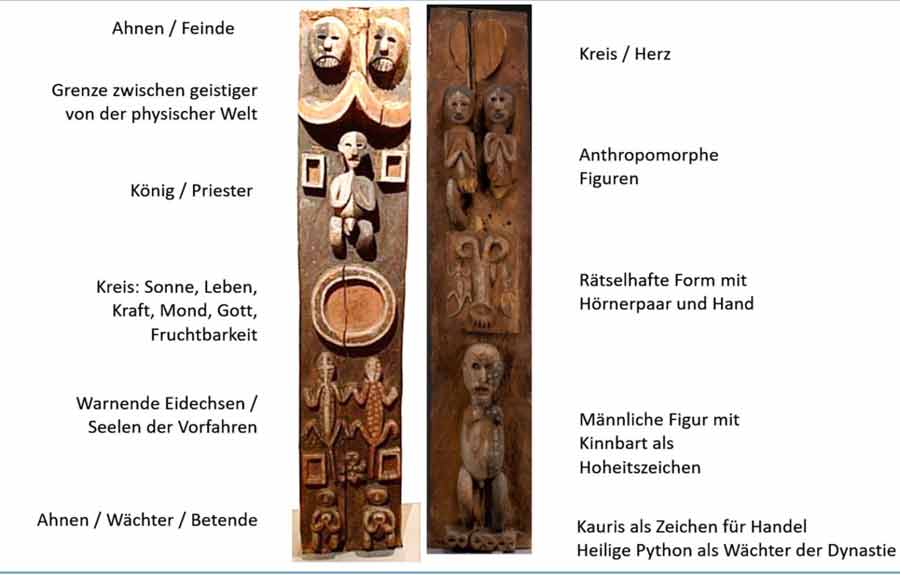
Fig. 8
In addition, the block is painted in three colours. These also carry meanings: Black could symbolise suffering, white could be the colour of the dead and symbolise mystery, red, the colour of blood, symbolises life (PHSAA). The light-dark contrasts themselves symbolise life and death (Kecskési 1999).
Function
PdGY suspects that the pillar - as part of the architecture of the house - stood at the spatial interface with the public (on a path) in order to communicate the significance of the house, presumably a cult house, to the outside. The object could therefore have been part of the façade of a particularly distinguished house[8] , also with a supporting function for the roof. It communicates what happens in the house or who lives or resides there.
Kecskési, on the other hand, considers a free positioning in space (Kecskési 1976, p. 22) and suspects an ancestral tablet. This in turn would fit the following determination by Gouaffo: "The 'Blue Rider Post' is a spiritual object. According to oral traditions, the object was placed in the sacred house like a statue. Caps, chains, bags or skeletons could hang from the object. Secret societies like the 'Losango' used the statue to perform certain rites, for example to cleanse the village of evil spirits." (Albert Gouaffo in GI) KG also suspects the context of a meeting house of such a secret society. Common to all assumptions is that the pillar stood in the context of a house with a sacred or cultic function.
'Theme' of the object: Basically, three different levels can be delimited, some complementary, some contradictory. First, the communication function on the façade or at the entrance to the outside. Then the pictorial formulation of a certain understanding of human being-in-the-world is asserted; man is ultimately embedded cosmologically.[9] At the Humboldtforum Berlin, in turn, such pillars from West Cameroon are also seen as the "architecture of power", power exercised by the rulers or the secret societies through impressing and deterring.[10]
Second perspective
The interpretation provided above can be countered by a second perception of the pillar, as it appears in the almanac "Der Blaue Reiter". This almanac, an artist's book, was published in 1912 by Franz Marc and Wassily Kandinsky. The reception of this book is over a hundred years old, but it is significant for the development of European art, as it is a good example of how artists of this time created a new frame of reference by referring to non-European art. In this respect, the Blaue Reiter clearly differs from Cubism, Expressionism or Dadaism, which were all being developed at the same time.
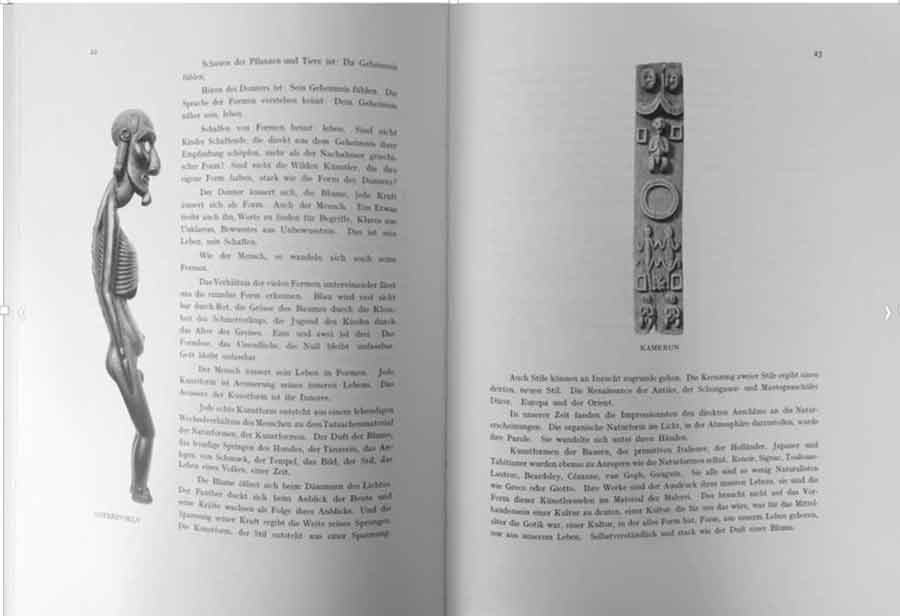
Fig. 9
In the Almanac, on pages 21 to 27, there is an essay by the painter August Macke entitled "Die Masken" (The Masks), in which a relatively small illustration of the pillar in question is embedded (see Fig. 9). Macke's contribution, like all the other texts in the Almanac, was probably written at a joint meeting of Macke, Marc, Münter and Kandinsky in Murnau.[11]
Visits to ethnographic museums are documented above all for Wassily Kandinsky, who was a trained ethnologist, and Franz Marc. Marc had also admired sculptures from Cameroon in particular during his visit to the Berlin Ethnographic Museum in 1911. And it was he who was ultimately responsible for the insertion of the photograph of the post in Macke's article.[12] In his letters to Macke, Marc writes about this. On 14.1.1911 about the objects from Cameroon in the Berlin Ethnological Museum: "I remained amazed and shaken by the carvings of the Cameroonians"; and later that he would furnish Macke's article in the Almanac with "ethnographic wonders" (MW).[13] In the text itself there is a single, very brief reference to "carved and painted pillars in a Negro hut", by which presumably the post was meant.
The text itself represents Macke's conception of art. In it, "intangible ideas", "mysterious forces", an "invisible God" express themselves in the world of appearances and "cultic expressions". The invisible materialises in the visible. This realm of the visible includes not only art, such as that of Giotto or van Gogh, who are classified as 'primitive', but also nature. Children's drawings, the folk art of the 'primitives' and 'savages' or non-European cultural forms are also expressions of the mysteriously invisible. These themselves are - and this is decisive - equal to each other. There is no hierarchy, no distinction between high and low, between high art and popular culture. All forms speak - as Macke characterises it - in "strong language". For Macke, the pillar in the museum is then an example of "the tangible form for an intangible idea, the personification of an abstract concept" (Macke 24). He also calls this the figure of an "idol".
The approach underlying this thinking sounds familiar; we have known it since the Platonic theory of ideas. However, this approach does not justify the selection of this particular post, as other posts from the museum's collection would also have been available.[14] Here one can only assume. I suspect that there are various factors that led to the selection: the archaic power of the forms; the initially wild and carefree-looking, additive combination (or montage) of the various principles of representation in the individual motifs (concrete - abstracted, geometric - organic, symbolising - depicting), which on closer inspection, however, then reveals itself to be consciously composed; or the coarse, physically perceptible materiality of the cracked, thick block of wood in impressive dimensions. PdGY also speaks of "wonderfully composed".
In the work, everything is represented with great sensual power that is the opposite of an "empty" image in European "cultures that have already passed through a thousand-year course, like [...] Italian Renaissance" (Macke 24) and from which Macke renounces: "We must bravely renounce almost everything that has hitherto been dear and indispensable to us as good Central Europeans [...] in order to get out of the fatigue of our European lack of taste". (Macke ibid.)
In art lessons, the question arises to what extent the image that Marc or Macke create of the pillar (as representative of the idea of an idol) goes together with what the object presumably was and is in its original context. Or to put it another way: are they designing a certain, exotic image that does not correspond to the object itself? [15]
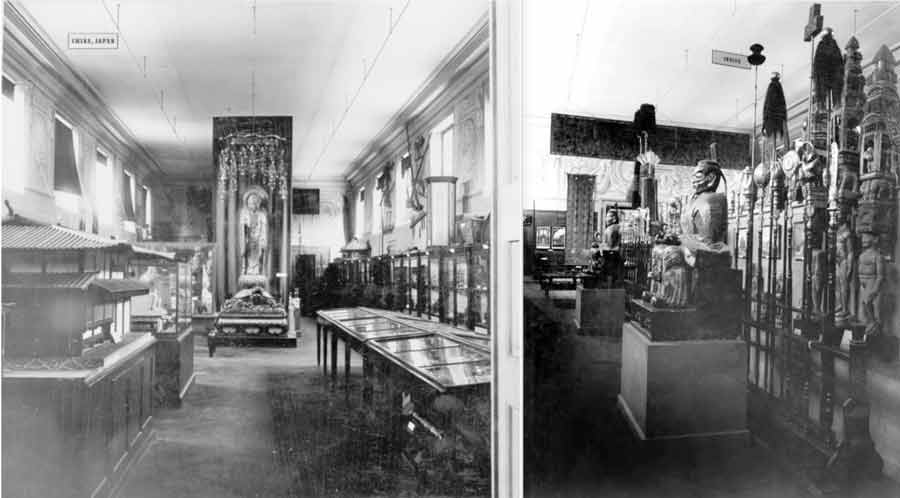
Fig. 10 Historical photos of the exhibition of the India Department in the Munich Museum around 1910 (source M5K)
References
- GI: Juliane Glahn and Marta Krus: CAMERUNS RIGHT TO CULTURAL OBJECTS. https://www.de/prj/zei/de/pos/22656808.html
- Kecskési 1999: Maria Kecskési. Art from Africa - Museum of Ethnology Munich. Munich (Prestel) 1999
- Kecskési 1976: Catalogue for the exhibition African Art. Andreas Lommel (ed.). Munich (Bruckmann) 1976
- M5K: Staatliches Museum für Völkerkunde München (ed.). The Blaue Reiter and the Munich Museum of Ethnology. Munich (Hirmer) 2009
- KG: Karin Guggeis. The Blue Rider Post. (2021): https://www.explore-vc.org/en/objects/expanding-the-canon-of-art-at-the-global-north.html
- PdGY: Patrique deGraft-Yankson. The Veranda Post. (2019) https://www.explore-vc.org/en/objects/the-veranda-post.html and oral interview on 23.4.2022 in Bayreuth, Iwalewahaus.
- PHSAA: Paul-Henri Souvenir Assako Assako. Information by email 20.5.2022
- Wikipedia: Cameroon & Max von Stetten
- MW: Macke Wolfgang (ed.). August Macke - Franz Marc: Briefwechsel, Texte und Perspektiven. 1964. Cologne (DuMont).
- Macke: Macke August. The Masks. In: Almanac "Der Blaue Reiter", 1912, edited by Franz Marc and Wassily Kandinsky, pp. 21-27
Appendix on iconography
- Anthropomorphic figures: ancestral couples / guardians and protectors of the royal residence. These anthropomorphic figures are treated with respect as extraordinary personalities. They are considered ensouled beings, spirits with supernatural powers. (PHSAA) Depiction of all human figures in similar postures: theme of prayer and submission to spirituality. (PdGY)
'Front' side from bottom to top:
- Two people: Ancestral couples / guardians and protectors of the royal residence (PHSAA). People pray for the guidance and protection of the ancestors (PdGY).
- Lizards: The symbol of the lizard warns everyone; it symbolises death. (PHSAA) PdGY sees here two crocodiles (ancestral souls returning to live with humans) instead of lizards.
- Circle: motif of the sun, symbol of life and power; the moon, image of woman and symbol of fertility. (PHSAA) The circle represents completeness, holiness, perfection and other attributes attributed to the supreme being (God). (PdGY)
- Kneeling figure: King or priest (PdGY)
- Line of demarcation between the spiritual and the physical world
- Two heads above: Ancestors (PdGY)
'Back' side from bottom to top:
- Python (geometric frieze at the bottom of the 'back' side): royal totem/sacred python, guardian of the dynasty (PHSAA).
- Male figure with chin beard as emblem of sovereignty (Kecskési 1999)
- Enigmatic form with a pair of horns ending in a hand (?) at the bottom (Kecskési) on a rectangle with two flanking lizards.
- Anthropomorphic figures
- Circular area
Footnotes
[1] The object is variously referred to, mostly in relation to its architectural-functional context: lintel or "te ken dy dye" (in the local Bandjoun language - PHSAA), porch post, house front pillar, post, cult house post (M5K, p. 17), Cameroon post / family crest (Macke at M5K, 13, 24). Post, however, in the sense of sign (post-it) is suggested by PdGY to address the communicative function. Other designations do not address the function, but limit themselves to the given, perhaps to avoid any pre-interpretation: 'sculpted wooden block' (Kecskési 1999 n. 108) or 'large carved square wooden block' (Kecskési 1976, p. 22).
[2] The first German trading posts were established in Cameroon as early as 1868, and in 1891 German military "expeditions" were launched in Cameroon. In 1884, the German Consul General concluded protection treaties with regional rulers and thus proclaimed the protectorate of Cameroon as a German colony. The seizure of the hinterland, which included the grasslands, took place over the course of the following 30 years. (Wikipedia) Even if the provenance is still not clear today, one can certainly share the Humboldt Forum's assessment of such objects that - even if they were not looted through acts of war - they are nevertheless "an expression of unequal power relations and structural, colonial violence". (https://www.smb.museum/nachrichten/detail/ethnologisches-museum-weg-frei-fuer-die-rueckkehr-der-ngonnso-nach-kamerun/)
[3] In the entry book it is noted: "Gr. square block, 1.80 cm high made of heavy wood, carved on both sides with humans and lizards, heavily damaged by termites". (https://onlinedatenbank-museum-fuenf-kontinente.de/) In 1895 Stetten published detailed "Travelogues" in the Deutsches Kolonialblatt.
[4] http://www1.biologie.uni-hamburg.de/b-online/afrika/kamerun/palast.htm; http://www1.biologie.uni-hamburg.de/b-online/afrika/
[5] The block is almost certainly worked with a chisel.
[6] "decorated with geometric, anthropomorphic and zoomorphic forms" (PHSAA)
[7] All performers avoid a complete decoding. They only make suggestions for individual motifs.
[8] It could have been the house of a 'priest' whom one could consult there and through whom or ancestors one could pray to God (PdGY).
[9] "Expression of the cosmogony of the universe of the peoples of the Bamileke plateau; expression of the belief system" (PHSAA).
[10] The assertion of power is also included by PHSAA.
[11] Catalogue: August Macke, Lenbachhaus Munich, 1987, Bruckmann. Munich. S.164
[12] He simply titled the painting "Cameroon", the name of the country of origin (the country whose sculptures he admired).
[13] There are other illustrations in the text: a bird's head from Brazil, a figure from Easter Island (see Fig. 9), one from Mexico, a bird mask from New Caledonia, a cloak from Alaska[13] and a child's drawing entitled "Arabs". Except for the child's drawing, all objects are from the then Royal Ethnographic Collection in Munich (M5K, p.11). They are only titled with the respective country of origin, e.g. Cameroon. Macke was obviously involved in the selection as well as the layout, as his layout sketch shows (M5K 24).
[14] It is not certain what was shown in the presentation at the Royal Ethnographic Collection in Munich at the time, which covered 400 square metres in six rooms in the north wing of the Hofgarten arcades in Munich. The only thing that is certain is that photos of the ten objects depicted, which came from various parts of the world, were lent to the artists for the publication of the Almanac. Photos of the presentation do not exist. "Whether Marc and Macke [actually also] saw the work in the exhibition at that time can be assumed with a high degree of probability, since it is after all very large and thus impressive." (Information Karin Guggeis 26.7.2022)
[15] In this context, it seems of interest that neither Marc nor Macke take up in their own pictorial language the aesthetics of the non-European works they "celebrate" here.
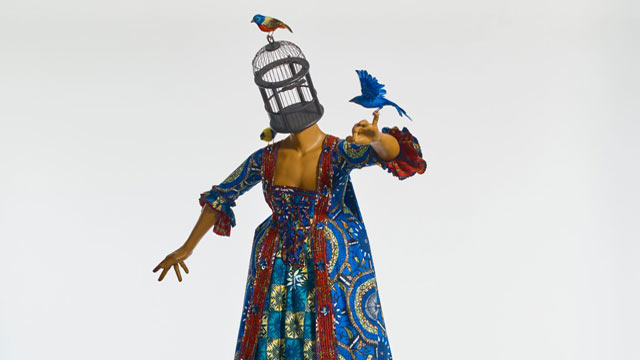
-
 Bernadette Van Haute
Bernadette Van HauteMrs Pinckney and the Emancipated Birds of South Carolina (2017) is a sculpture in the round composed of a headless, female, ‘white’ mannequin swathed in historical dress and balancing on a globe. In place of her head is an empty birdcage from which three birds have escaped. The work was created by the internationally renowned artist Yinka Shonibare (born 1962) who is a black man of Nigerian descent living in the United Kingdom. He can thus be identified as a member of the African diaspora. In his artworks he usually engages with concepts that are related to the politics of colonialism and the slave trade and explores cultural identity in the context of globalisation. [1] While his creations are deeply critical of western imperialism, he always makes sure to render them visually alluring and engaging to elicit a visceral response. [2]
This particular artwork was co-commissioned by the Yale Center for British Art and Historic Royal Palaces, Kensington Palace, and created especially for the exhibition "Enlightened Princesses: Caroline, Augusta, Charlotte, and the Shaping of the Modern World".[3] This adds an aura of seriousness of intellectual and aesthetic intent to the sculpture. In the title of the work, the artist has identified the woman as Mrs Pinckney, or Elizabeth (Eliza) Lucas Pinckney, who at the age of 16 was put in charge of her father’s plantations in South Carolina. [4] She had a major influence on the colonial economy by developing indigo as an important cash crop to be processed as dye. [5] The sculpture is said to be the artist’s response to Eliza’s encounter with the German Princess Augusta in 1753 which further identifies her as a member of the social elite. [6] All of the above components help to retrieve the identity of the subject, the ideology being addressed as well as the message in the image.
The artist has encoded his artwork with visual tropes that clarify and enforce his message. While the style of Eliza’s dress is based on 18th-century fashion, the fabric used is Dutch wax cloth which Amah Edo describes as a “marker of Africanness”. [7] Manufactured in Europe but using the Javanese batik printing technique, the cloth “came to be produced specifically for West African markets in the 1890s … [and] its aesthetic was adapted by manufacturers to suit these new consumers’ tastes”. [8] Now widely perceived as symbolic of tradition, the Dutch wax cloth is regarded “as a high-end commodity desirable to elite customers”.[9] The material of the woman’s dress thus not only identifies her as a member of the elite but also refers to Africa as the source of her wealth: it is through the labour of the African slaves that Eliza was able to run her family’s plantations in America. Likewise, the blue of the material – and the bird on her finger – is a direct reference to her successful cultivation and processing of indigo. It can thus be seen that the artist explores concepts of race and class through a careful choice of materials and colours in his imagery. By dressing the white woman in African cloth, he complicates history and racial identity in an effort to startle the viewer’s conscience.
As the plantation’s manager, Eliza occupied a position of power which is visually manifested by her being placed literally on top of the world. The latter is represented by an eighteenth-century globe that shows the colonial territories of the British empire. [10] Eliza is thus turned into a symbol of white superiority and privilege granted by the politics of imperialism. Her balancing act, however, proves to be precarious and elicits tension as the ball can roll at any moment and topple her from her position of power. It is also interesting to note that the globe is an attribute of Fortune, the fickle goddess of antiquity. Fortune is blind and even eyeless, and the globe “on which she stands or sits, originally indicated instability, but to the Renaissance it was rather the world over which her sway extended”. [11] The headless Mrs Pinckney thus shows a cunning resemblance with the antique goddess Fortune “who bestows her favours at random”. [12]
The favours bestowed by Eliza relate to her release of the birds from the birdcage. However, instead of flying away to freedom, they come back to her. She playfully lifts her left arm for an indigo-blue bird to perch on her little finger, while another bright-coloured bird sits on her left shoulder and a third one on top of the cage. According to Shonibare, the birds are a metaphor for slaves and her gesture of setting them free symbolises her wish to emancipate the slaves – hence the title Mrs Pinckney and the Emancipated Birds of South Carolina. [13] The narrative thus presents a paradox between the white woman’s privileged yet unstable position as powerful, wealthy mistress and her fickle wish to liberate the black slaves whose destiny is entirely in her hands.
In this work, Shonibare has given his own interpretation of the story of Mrs Pinckney, choosing to focus on the effects of the slave trade and colonisation in the eighteenth century in the United States, then still British territory. While the playfulness of his rendition and its aesthetic appeal conceal the harsh realities of enslavement, the dehumanisation of black people as a result of colonial politics still filters through in the form of brightly coloured birds which, although set free, are so tamed – read oppressed and subjugated - that they are not able to fly.
[1] https://en.wikipedia.org/wiki/Yinka_Shonibare (26 July 2021).
[2] Yale News, 2017. Yinka Shonibare MBE (RA): ‘Mrs. Pinckney and the Emancipated Birds of South Carolina’. Video. Yale News, Yale British Art, 25 July 2017. https://news.yale.edu/videos/yinka-shonibare-mbe-ra-mrs-pinckney-and-emancipated-birds-south-carolina (26 July 2021)
[3] Yale News 2017.
[4] Yale News 2017.
[5] https://en.wikipedia.org/wiki/Eliza_Lucas (26 July 2021).
[6] Yale News 2017.
[7] Edo, Amah M. (2019). From African print to global luxury: Dutch wax cloth rebranding and the politics of high-value. In Mehita Iqani and Simidele Dosekun (Hrsg.). African luxury: Aesthetics and politics (pp. 77-92). Bristol, UK / Chicago, USA: Intellect, p. 82.
[8] Edo 2019, p. 80.
[9] Edo 2019, p. 85.
[10] Yale News 2017.
[11] Hall, James. 1974. Dictionary of subjects and symbols in art. London: John Murray, p. 127.
[12] Hall, James. 1974. Dictionary of subjects and symbols in art. London: John Murray, p. 127.
[13] Yale News 2017.
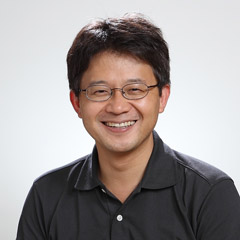 Nobumasa Kiyonaga
Nobumasa KiyonagaThe oeuvre of Yinka Shonibare CBE is often characterised by a colourful and at the same time amusing appearance. This facilitates the viewer's immediate access. This is also the case with his 2017 work Mrs Pinckney and the Emancipated Birds of South Carolina. What one perceives here at first glance is the figure of a lady wearing historical European clothing, a "Robe à la Française" from the 18th century. However, the clothing is unusually colourful. Moreover, the woman is standing on a sphere, albeit shakily and leaning forward somewhat. This image quickly connects with the traditional European iconography of "Fortuna", i.e. the admonishing, allegorical symbol of "fate". It turns out that the sphere is the globe.
The graceful lady also has a strange head in the form of a birdcage. But its door is open and the three birds have long since escaped. This could be an allusion to Maurice Maeterlinck's The Blue Bird, the central message of which is the obvious true happiness. In any case, the caged head shows us that it is actually our thoughts that tie us down and hinder our actions, as is often the case. Seen in this light, at least this lady has succeeded in unmasking the internalised gender ideology and liberating herself mentally. But is it really a lasting liberation?
Who actually is this lady, this "Mrs Pinckney"? What fate is at stake? She is not known here in Japan, for example. A look at Wikipedia, for example, will help: she is considered one of the first emancipated women in the USA, who achieved prosperity with her pioneering attempt to grow indigo on slave plantations in South Carolina. This dye was in particular demand for military uniforms in Great Britain at the time.[1] That is why the lady is wearing this indigo dress. But where does the artist's reference to Mrs. Pinckney come from? A direct connection is hard to find at first. However, knowing that Shonibare describes himself as a "post-colonial hybrid"[2] - he was born in London as the child of Nigerian parents, grew up in Nigeria and studied in London - and that he very often uses "African wax prints" for his works,[3] one gains more clues about the work.
At present, those wax prints seem to represent "authentic" African life, but they have an Indonesian origin and were made by Europeans, especially Dutch, and sold and distributed in West Africa.[4] In this sense, they are in fact a transcultural product. Through their use, the artist points to the "cultural imagination as a power structure and means of domination"[5] in the spirit of the critique of representation. In this specific work, too, the wax prints, which have something in common with the fate of indigo, find their use in clothing.
Thus, it turns out that the lady functions as the encouraging and, at the same time, admonishing symbol of the emancipation of women, which never proceeds in a linear fashion and is still threatened and endangered everywhere today. Moreover, this emancipation movement must always be seen in an even more complex context, which was and still is connected with the fate of countless people - in Mrs. Pinckney's case, for example, that of the slaves, according to the message of the work.
[1] https://de.wikipedia.org/wiki/Eliza_Lucas_Pinckney (27 July 2021)
[2] Shoji, Sachiko. 2019. “History is Happening Now: What Connects Us All to the Art of Yinka Shonibare CBE.” In Exhibition catalogue Yinka Shonibare CBE: Flower Power. Fukuoka: Fukuoka Art Museum, p. 105. Incidentally, this is the artist's first solo exhibition in Japan.
[3] Shonibare CBE, Yinka. 2019. “Artist Statement. Woman Shooting Cherry Blossoms.” In Exhibition catalogue Yinka Shonibare CBE: Flower Power, Fukuoka: Fukuoka Art Museum, p. 13.
[4] Ibid. According to Shoji, Japan also became involved in the production of those wax prints and their export to Africa from the late 1920s to the mid-1990s. See Shoji 2019, 106-107.
[5] Shonibare 2019.
 Ernst Wagner
Ernst WagnerA life-size, headless, female mannequin balances on a globe showing the African continent from the front. Her Biedermeier-style clothing in bright colours shows a deep décolleté. The fabric pattern is Dutch Wax, which can be inferred from the given information on the work. In combination with the birdcage and the three colourful birds outside the cage, the sculpture is reminiscent of surrealist montages like in René Magritte's artworks.
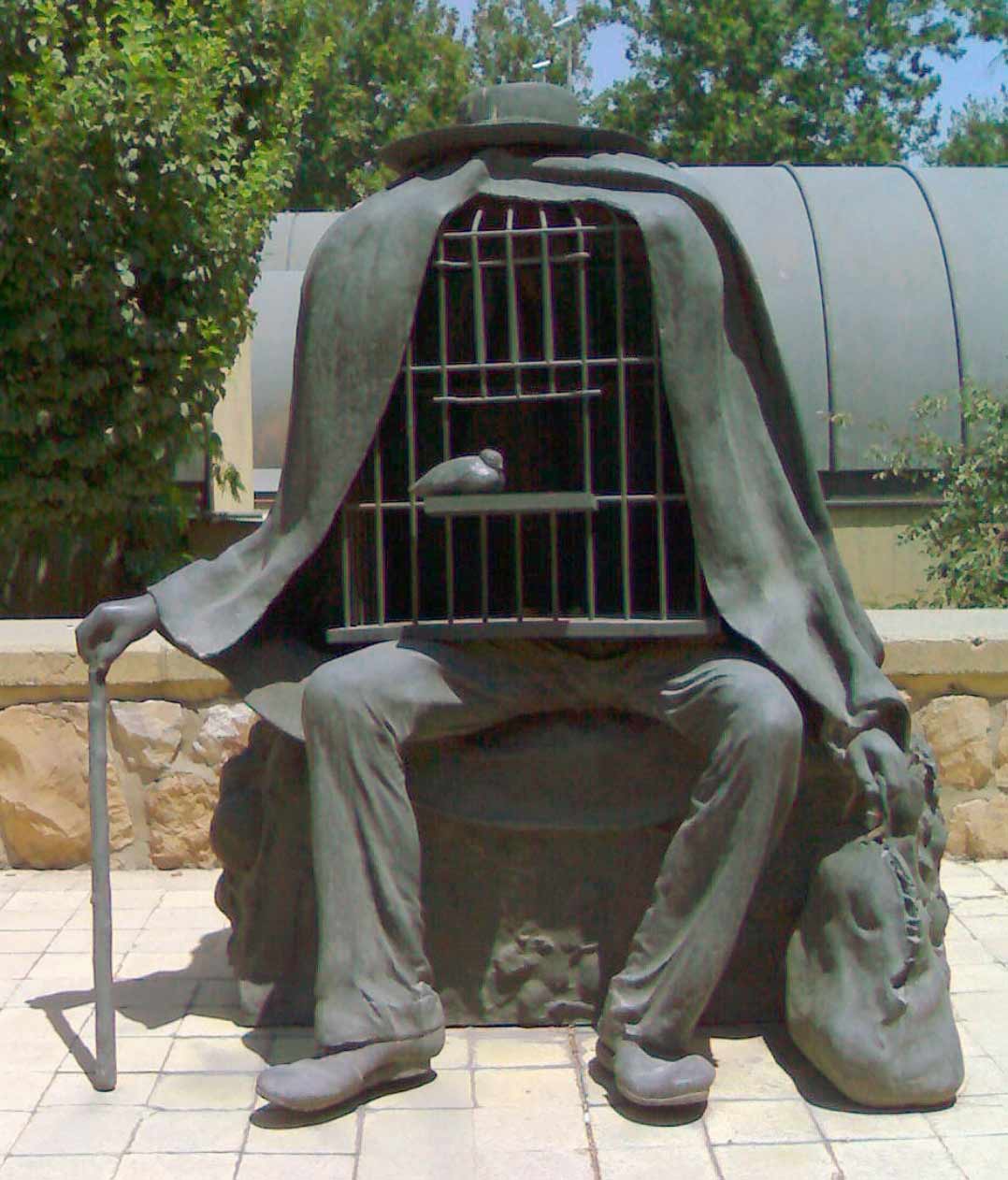 René Magritte, Le Thérapeute (1976), Tehran (Copyright: WikiCommons)
René Magritte, Le Thérapeute (1976), Tehran (Copyright: WikiCommons)The title refers to a concrete iconography that makes research necessary which - as a reward - helps to decipher the birds and the blue dress: Mrs Pinckney refers to a prominent historical woman (Eliza Pinckney, 1722 - 93) whose biography - as one can read on Wikipedia - was deeply entangled with English colonialism and the American War of Independence. Shuttling between North America and England, she was remarkably innovative and entrepreneurial. The birds in the sculpture allude to a specific anecdote when Eliza Pinckney gave such birds as a gift to the mother of the British King George III. The blue of the dress can be seen as an allusion to Pinckney's production of indigo in South Carolina.
The globe and the pattern of the dress - like the title - also allude to the theme of colonialism. Even the material specification of "Dutch Wax" tells a tangled story in colonialism. But the female role model embodied by Eliza Pinckney in her time, obviously denies the usual connotations associated with colonialism, slavery and looting. The birds outside the cage perhaps also make references to the immanent contradiction between freedom and captivity.
Alluding seems to be the most adequate term to grasp the specificity of the visual language of this work. Nothing is clearly asserted, no thesis is put fprward. Rather, a dazzling, assembled, ambiguous figurine stands in the context of 18th-century colonialism, hinting at many themes that are significant also today: women's roles, capitalism, domination and exploitation of nature, colonialism, freedom and oppression. This fits in well with the immediate perception of the object. Looking at the artwork, one gets the impression of a strange balance of lability and stability, of theatricality and ridiculousness, of immediate sensuality and learned knowledge.
Now, the question remains as to how this work is located in the transcultural contact zones. Today, it is exhibited in a US collection of British art, the "Yale Center for British Art". The artist himself is called a British-Nigerian artist. He himself uses his English title of nobility CBE (Commander of the British Empire) in his name. Since documenta 13, he is well known in the context of Global Art. In terms of iconography, the work is also located at these interfaces. Through montage, it merges different associations into an inherently contradictory complexity that cannot be resolved. This creates a fundamental openness that is reflectes when we ask about its meaning: can we read the work as ironic alienation? Or as a commentary on history? Or as homage or, on the contrary, as criticism of the historical Mrs Pinckney? As a reflection of current and very serious issues or as a harmlessly playful object?
A video produced by the museum where the work is now located shows an analogous reception history (Link 1 / Link 2). How does the work constitute the “ideal” viewer? He or she is a decoding, deciphering viewer who allows the iconographic fixation to fail with relish because of the sensuality of the playful object, just as the narrative of Mrs Pinckney fails because of the mannequin's instability. The ideal, contemporary viewer simultaneously enjoys the openness and yet sees him-/herself confirmed in his/her anti-colonial habitus.
 Discussion
DiscussionDiscussion
EW: When I compared all three contributions, I was initially surprised by the large number of common intersections. This certainly points to the global power of interpretation of media representations in English (website of the collection at Yale, Wikipedia), which we could not escape either. We all researched Mrs. Pinckney on Wikipedia, we all trusted the video on the website as a source. But what is interesting now is how differently we deal with it and what different conclusions we come to. I have the impression that in your approach, Bernadette, the story of Mrs. Pinckney plays the biggest role, while in my text this story is rather only a possible reference point. I don't know if you can agree with me.
NK: Yes, I also see these differences. With Ernst, I see more of a fundamental, principled attitude in the analysis of the work. In Bernadette's interpretation, I found the interpretation of the birds as "slaves" interesting. I myself saw in it the - temporarily - liberated soul of an emancipated woman. Moreover, in this context, I also find your reference to the paradox of the actually already liberated "slaves" particularly illuminating, as it seems to have been derived from your discussion of colonial history in Africa.
BVH: When comparing our contributions, I was also reminded of the fact that art is always about other art, hence we looked for precedents that may have inspired the artist. But what I find most exciting about our interpretations are the differences in emphasis on the various meanings that are embedded in the work. For Ernst, the transcultural nature of the work stands out, as well as its openness in meaning. For Nobu, it is the reference to gender ideology and women’s emancipation that forms the core of the work, especially in light of ongoing gender discrimination. For me, it is the historical narrative that led me to interrogate the issue of racial discrimination which also continues today in movements such as #BlackLivesMatter.
EW: I share this, and I would like to follow up with a question. Is it possible that our respective contexts in which we work have influenced this? Not in terms of content – we agree on that – but in terms of patterns of argumentation. If you, Bernadette, place so much emphasis on the story of Mrs. Pinckney, does this perhaps reflect the great oral, meaningful storytelling traditions in Africa? And when you, Nobumasa, on the other hand, elaborate Mrs. Pinckney as an encouraging and at the same time cautionary symbol, does this perhaps reflect the great ethical traditions in Asia? My refusal of direct meaning-making and ethical service, on the other hand, would then be a European-style reflexive evasive manoeuvre to a (preferably unassailable) meta-level?
BVH: Good question indeed. In my opinion, this exercise shows how we are all conditioned by the sociocultural environment in which we live and work. Hence my response, from a South African point of view, focused on the story/history in order to highlight the importance of the work in decolonising the subject. While playfully complicating racial issues in a historical context, the artist mainly celebrates Africanness by means of materials, patterns and colours. This allowed me to infuse my interpretation with African epistemologies. Your response, Ernst, could be regarded as a refusal, perhaps, to acknowledge and engage with the deeper implications of the work and indeed rather shift the focus onto more theoretical concerns as inspired by German art historians? I am keen to hear Nobumasa’s view on this matter.
NK: Ernst's question about whether a Japanese ethical tradition might secretly be reflected in my interpretation is very difficult for me to answer. But as Bernadette has just pointed out, the social context in which we work definitely plays a certain role. While globalisation has erased spatial distances, perhaps not necessarily mental ones. For Japanese today, Africa is still very distant, in the double sense mentioned above. Although Africa is the second largest continent with 55 countries and countless information is available, detailed and nuanced ideas about it are often missing from our consciousness. My leap into the general, or ethical, implication of the work could possibly be explained in this way. Seen in this way, I have probably unconsciously "traced" my own situation. But this also underlines the fact that the critique of representation – in the sense of a critical questioning of pictorial representations – is still as relevant today as it ever was.
EW: I was very grateful to you, Nobumasa, for the emphasis on the ethical, because we always have to include the ethical dimension in the context of education. My argument from a German point of view would be that the interpretation of a work like Mrs. Pinckney must not be arbitrary. That would be the ethical responsibility of the interpreters. We will have to come back to this in a moment when we discuss conclusions for a toolbox for decoding images.
But first I would like to learn more about the differences between our approaches – even though there is a large area of consensus. In the theoretical discussions we had some time ago, we clearly distinguished the Japanese concept of 'kansho kyoiku', the South African concept of 'art criticism' and the European concept of 'work immanence'. Could you elaborate on the question of how these positions are reflected in your texts?
NK: The introduction of dialogue-based art viewing from the USA in the late 1990s revived the field of art education in schools or museums in Japan. Since then, this didactic method, which seems to seek to maximise the viewer's part in interpretation through its strict rejection of knowledge transfer and ultimately prioritises the discussion of interpretation, is still in vogue today. But a crucial question still arises as to how the meaning of interpretation, or meaningful interpretation, is secured without degenerating into mere arbitrariness. In this respect, too, our experiment seems to be very inspiring.
BVH: At the University of South Africa we believe that the basic skills required to interpret objects of visual culture are best taught by beginning to practise art criticism. The proper domain of a critic is the description, interpretation and evaluation of concrete works of art. As a first step in this process, students must learn how to describe and interpret artworks. Essentially art criticism is a practice embedded in western epistemology that has been appropriated to study the art of contemporary Africa in a global context. When investigating the historical arts of Africa, the method remains the same although the local context of traditional culture and customs must be taken in consideration. My interpretation of Shonibare’s work was guided by these very same principles.
EW: Finally, I would like to ask you something with regard to the 'methodological kit' proposed by the editors of this volume: Which methodological approaches for the interpretation of images do you consider absolutely necessary – independent of our respective Japanese, South African or European context? And I'll add a second question in a moment: Does that leave one area that plays a role exclusively in your respective local context?
BVH: From an art historical point of view, the methods best suited for the interpretation of political images stem from a contextual approach which demands critical consideration of the cultural context of the work, its artist and of the social practices and power relations in which it is embedded. As the interpreter, you can apply the iconological method: first describe what you see – formal elements and details – and then identify the iconography, the specific subject and symbolism of the work. Do some research on facts and historical context, as well as the reasons why the work was made or commissioned. Then you can explain how all this information was put together to express the meaning or content of the work and decide what message or ideas the artist was trying to communicate. Because every interpreter comes to the artwork with his/her own worldview, the interpretation will differ depending on that worldview and not on the local context. For example, because I attach more importance to the idea of decolonisation, my contextual approach is combined with and influenced by decolonial theory.
NK: Basically, Bernadette, I gladly agree with you, especially with regard to your gradual approach. I also think it is reasonable and sensible from a pedagogical point of view. But this raises the question of what actually constitutes a "political image" or "when" an image becomes political. Of course, there are pictures or works of art that are obviously and unmistakably recognisable as such, but there are also those that are much more subtle, that are not so noticeable to foreign eyes, or that were not originally created with political intentions, but that in retrospect seem to be quite political. What one considers to be political depends, after all, very much on the view of the observer, possibly even completely apart from the original intention of the creator. In this respect, it seems to me that a fundamental attitude is indispensable for the viewer to be able to keep a mental distance from a picture and its context as well as from himself and his own horizon in order to perceive a picture (also) politically.
EW: Thank you both, because from my point of view I cannot and do not need to add anything more. I completely agree that an iconological basis, as Bernadette has formulated it, is needed. And I am deeply convinced that the reception-historical and reception-theoretical extension that Nobumasa has added is absolutely necessary, indeed indispensable, for the toolbox. I can add nothing to this bundle of methods.
What perhaps came up short in our conversation were the different cultural conditions and the resulting consequences for interpretation. But we'll make up for that on another occasion.
NK: Finally, let me add something to my previous statement. For responsible interpretation, we need above all a willingness to engage in dialogue. I experienced this again in our conversation and our experiment also shows this in an exemplary way.
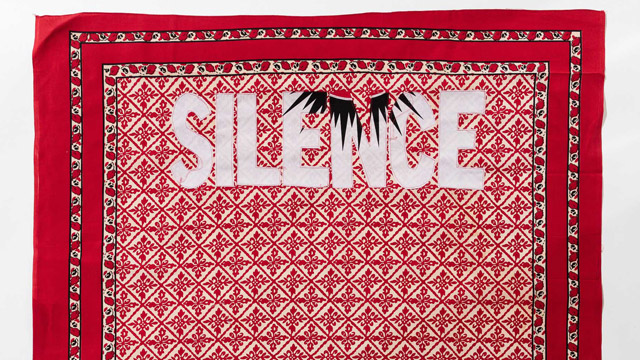
-
 Bernadette Van Haute
Bernadette Van HauteLawrence Lemaoana’s work, entitled SILENCE … FALLS (2017) consists of Kanga fabric with cotton embroidery, measuring 155 x 115 cm. Lemaoana is a South African black male, born in Johannesburg in 1982, who lives and works in Johannesburg. The work serves as an example of the ways in which young black artists in South Africa aim to express a specific South African identity which appeals to the global art world.
The use of Kanga fabric as medium is in itself very significant. Lemaoana states that: "Kanga fabrics [...] are used extensively in my work. Manufactured in the East, and brought to South Africa to be sold in markets and bazaars, the journey of the fabrics speaks of the idiosyncrasies and trade imbalances of globalisation. The textiles themselves though have a wholly different life in South Africa – they are regarded as significant markers of spiritual healing, imbued with great religious and spiritual power, used by diviners and fortune-tellers." (Afronova)
The Kanga cloth is “used specifically in Emandzawe rituals, both as clothing for the sangoma [diviner] performing the ritual and as cloth on the shrine inside the shrine room in which the ritual takes place” (von Veh, 2017, pp. 13-14). The use of this fabric thus establishes Lemaoana’s identification with both global culture and black African culture which does not belong to a mythical past but is still very much alive today. His own familiarity with the sangoma becomes clear when he maintains that the ambiguity of the traditional healer’s utterings parallels that of headlines in the news media. He also exploits the deeper meaning embedded in the three colours white, red and black to heighten the impact of his highly topical messages.
Lemaoana’s work is inspired by current socio-political events and the way in which they are reported in the local media. The composition Silence Falls evokes the #RhodesMustFall movement which began in 2015. This demonstrates the artist’s concern with the plight of the South African youth and his identity as an artist born in the 1980s – the so-called ‘born-frees’ who did not actually experience the ‘struggle’. The works of this generation of artists are described as “symptomatic of the new identity issues of the post-apartheid era. This young generation is appropriating a history that it believes has been confiscated and twisted in order to develop an alternative that takes into account its own subjective experience. Conscious of their responsibilities, these artists are helping to formulate and affirm a specific South African identity” (Pagé and Scherf, 2017, p. 8).
Lemaoana expresses his concern with socio-political issues through a critical engagement with mass media in South Africa. He is particularly concerned by the ability of the local media to shape social consciousness. By isolating news headlines and appropriating political slogans in his very own cynical way he “turns didactic and propagandistic tools on their head” (Afronova). As Lepage (2017, p. 117) states, Lemaoana uses the power of “words as favoured instruments in the political struggle”.
The importance of Lemaoana’s work is vested in his participation in the Fondation Louis Vuitton exhibition in Paris in 2017. The exhibition was divided in three parts; the first one was entitled Being there: South Africa, a contemporary scene and aimed to show South African vitality through the works of 16 artists. In the accompanying catalogue the curators Suzanne Pagé and Angeline Scherf (2017, p. 8) explained that their choice of artists was “based primarily on the action of the artists themselves, on their engagement with the current economic and social institutions, their awareness and conviction that they can act and play a role: BEING THERE”.
Interestingly the curators also comment on the fact that this younger generation of artists, in the context of ongoing economic and social divisions more than two decades after the end of Apartheid, sees it as its mission to transform “disenchantment into the energy for renewal” (Pagé and Scherf, 2017, p. 8). Achille Mbembe (2017, p. 16) elaborates on the current tensions in South African politics and culture which have led to a stalemate. In a society where consumption has become the quintessential state of being, the visual arts are in crisis, characterised by radical fragmentation and dispersion of reality (Mbembe 2017, pp. 23-24). “What is needed in contemporary South African arts”, writes Mbembe (2017, p. 24), “are concepts with which to seek out the real … . This will not happen without a new collective imagination that will help to facilitate the passage from the past and present to the future”.
This is what Lemaoana has achieved in his art. His participation in the show confirms his status as a contemporary South African artist who has managed to decolonise his art by “seeking out the real” and grounding it in a local or national context. Furthermore, in Lemaoana’s works there is no room for, what Mbembe (2017, p. 25) calls, “tropes of pain and suffering” or the injuries inflicted “by the forces of racism and patriarchy” – tropes that are the characteristic traps of postcolonial discourse. His art is decolonised in the sense that all the resources of cultural and artistic modernity – both in terms of medium and narrative – have been mobilised in order to render itself more relevant to a modern Africa and a global humanity (Ekpo, 2017, p. 20).
References
- Afronova. http://www.afronova.com/artists/lawrence-lemaoana-2/ (accessed on September 19, 2017).
- Ekpo, D. (2017). Manifesto for a Post-African art. Unpublished keynote address presented at the SAVAH Conference, Tshwane University of Technology, South Africa, September 21 – 23, 2017.
- Lepage, A. (2017). Lawrence Lemaoana. In S. Pagé & A. Scherf (Eds.), Being there: South Africa, a contemporary scene (pp. 116-21). Paris: Fondation Louis Vuitton and Editions Dilecta.
- Mbembe, A. (2017). Difference and repetition. Reflections on South Africa today. In S. Pagé & A. Scherf (Eds.), Being there: South Africa, a contemporary scene (pp. 15-25). Paris: Fondation Louis Vuitton and Editions Dilecta.
- Pagé, S. & Scherf, A. (Eds.). (2017). Being there: South Africa, a contemporary scene. Exhibition catalogue. Paris: Fondation Louis Vuitton and Editions Dilecta.
- von Veh, K. (2017). Textual Textiles: Gender and Political Parodies in the Work of Lawrence Lemaoana, TEXTILE,1-19. doi: 10.1080/14759756.2017.1337381 (Accessed September 5, 2017).
published March 2020
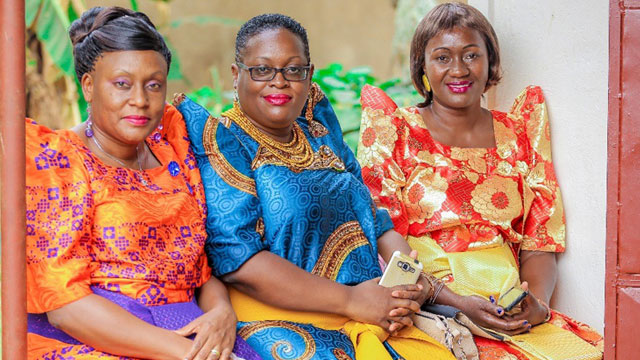
-
 Esther Kibuka-Sebitosi
Esther Kibuka-Sebitosi“Decolonizing self” is a photo demonstrating the complexity of cultures and how inter twinned African and western cultures have become. The photo was taken at a traditional wedding in Kanyanya village, where African cultural practices like sitting down on the mat are proudly demonstrated. Paradoxically, decolonizing the self-starting with the dress, is not an easy process as pieces of the western culture are clearly visible, for example the sunglasses, the necklace and ear rings all show the interlinkages between cultures. The example is excellent in showing culture, history and evolution of the traditional dress and political economy for educators. The mood of the gaze is best described by former President Thabo Mbeki in his poem,” I am an African” as he proudly says, “ “Today I feel good to be an African”.
In unravelling decolonizing self, I want to start with explaining colonialism; Torres (2007) refers to colonialism as, “ a political and economic relation in which the sovereignty of a nation or people rests on the power of another nation”. He refers to coloniality as a long-standing patterns of power that emerged as a result of colonialism but that define “culture, labour, intersubjective relations and knowledge production well beyond the duration of colonial administration”. Hence, coloniality, he argues, survives colonialism and is maintained through books, music, academic performance, cultural patterns, in self-image and aspirations of self and is lived every day. It follows therefore that decolonizing self would have aspects of culture, language and daily practices that one has to get rid of. Taking an example of cultural dress, I dress in my traditional dress called the busuti or Gomesi. The image shows the dress and the Shaath (cream colour that is used to tie it). The necklace is modern shining with stones. The accessories are also western. I am sitting down on a mat made out of sisal and “nsansa- palm tree leaves. Sitting down is a cultural tradition and practice that dates back for generations. This is also a gender demonstration of roles of women who would sit on the mat to greet visitors who had come to be introduced. The practice of paying lobola (bride price) is common in Southern Africa and traverses the African continent. In the photograph, everybody dresses in the traditional dresses. It is a way of saying “I am an African” and I dress like this, “Look how smart my dress is lovely”.
Ironically, long ago, the traditional dress was made of out of the Mutuba tree- Fig tree Ficus species. They got it from the bark of the tree, which they smashed until it became flat. It was dried and then rolled out. The cloth (Kikunta or Lubugo) comprised only of a sheet, which was wrapped around, the shoulders. Over the years, the Kikoyi replaced the kikunta as it was made out of cloth- cotton. Linked to the traditional dress, is the decorative materials from India. Inside the dress is another wraparound Kikoyi that together with decorations were also from India. The image shows the material of the dress- silk with beads. This material is from India or Dubai. The modern materials are no longer traditional (Kikunta and kikoyi). The local industry has adapted to make traditional dresses out of new materials linen, nylon, chiffon or a mixture instead of cotton or Lubugo from the Mutuba tree back.
The image also demonstrates the mostly western sunglasses or gaggles. The sunglasses show the western culture I have adopted over the years. The Europeans normally put on sunglasses to protect their eyes from the sun. The occasion was held during the day as the sun was shining. It is not traditional practice to wear sunglasses. However, they help protect the shy people, as they do not have to look at all the guests. The gaze in the image is that of a woman comfortable in her body, sitting down with pride and taking pride in her tradition. This particular image was selected because it reveals the culture in transition. It is contemporary culture- a traditional wedding- a place where African Culture is luxuriously displayed. Paradoxically, the dress is traditional but the accessories are western showing the entangled nature of coloniality- the tradition African culture and the western culture, practices, all intertwined in intercultural interactions. The sunglasses may also demonstrate the cover up- hiding of self in the modern practices. Based on the above, it is not surprising that Decolonization is a layered process, which takes time and patience.
Thabo Mbeki wrote a poem, “I am an African” expresses the objective of the constitution, “It is a firm assertion made by ourselves that South Africa belongs to all who live in it, Black and White”.
As I sit on the mat and watch the bride and groom give gifts to each other, I remember the words of the former President of South Africa, “Today I feel good to be an African”.
In decolonizing self, “decolonization” that has become the rallying cry for those trying to undo the racist legacies of the past, according to Achille Mbembe. Starting with cultural dressing is the first form of decolonizing self. Other forms include decolonizing power and decolonizing knowledge.
published January 2020
 Katharina Knaus
Katharina KnausBeyoncé’s and Jay-Z´s Video „Apeshit“ discusses post-colonial exhibition art
My first contact with art history was by reading E.H.Gombrich „The Story of art.“ (1909-2001). When starting my studies of art history in Munich, this was the book they recommended as standard literature. The cover text describes it as „the most famous and popular book on art ever published“. Although it claimes to be an introduction in art „for reader of all ages and backgrounds“ Gombrich tells a very one-sided story. Beyoncé’s and Jay-Z´s Video „Apeshit“ discusses post-colonial art historiography by exposing the Louvre as a white – dominated space.
„Two black women are sitting on the floor wearing light brown tights and body-hugging beige vests. They are in profile, facing away from each other, and positioned at either side of David’s painting of the famous 19th Century French socialite. Linking the two women together is a flowing piece of white material, each end of which they wear on their heads like a turban.
Above them, Madame Récamier reclines on her antique sofa, dressed in a simple sleeveless white dress, her head turned towards the viewer. The design of the sofa is similar to that of a sleigh-bed, with rising wooden ends. It is these bed ends that the women on the floor echo, the variance in the darkness of their skin matching the different tones of the wood in the painting.
The cloth that links them represents the dress worn by the painting’s subject. The message is clear: It was on the backs of subjugated black people from the French colonies that Madame Récamier was able to enjoy her life of leisure and pleasure.“ (Will Gompertz)
The Carters’ Louvre takeover isn’t just about protest; it is about power too. But the overall point is powerfully put. The game is up for those institutions – be it Hollywood, Broadway or the Louvre – which have ignored black artists, refused them a voice, or a seat at the top table.
published January 2020
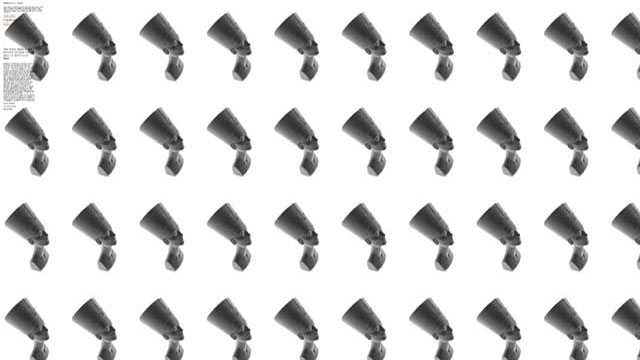
-
 Niklas Wolf
Niklas WolfIn ancient Egypt there was an elaborate system of reproduction around representative works of art. Gypsum casts of royal statues ensured that images of rulers were comparable and consistent nationwide. The formal type of a portrait bust, however, is as special as the material of Nefertiti’s representation. Stone figures, combined with a publicly effective installation, corresponded to ideas of permanence and a ruler’s longevity. The stone bust’s surface is coated with gypsum, which enabled a particularly fine design, and brightly coloured paint. The latter is preserved in its original condition (Tyldesley 2018).
Technology, material, surface and the design of the object play an important role in Nora al-Badri and Jan Nikolai Nelles’ project The Other Nefertiti (Pinther 2018). This project intentionally raises a number of questions that refer to discourses about provenance and access to both one’s own and foreign cultural assets, as well as their relocation. Moreover, it points towards a possible democratization of globally significant, mobile artefacts. What happens to a visual object when it is reduced to the essence of its digital data? How can digital processes and media be part of such discourses, and even possibly their solution? As part of an artistic intervention, the two artists penetrated the space of the museum and photographed the bust with concealed scanners, from which they were able to generate a multitude of detailed data to create a 3D print. Within the framework of a Common Creative License, this data is accessible online to the general public and provides “immaterial material” for future images as well (Nelles 2016). Anyone with access to the Internet and a 3D printer will therefore be able to print a copy that corresponds to the shape of the original, thereby democratizing the cultural asset. This gesture directly counteracts how strongly the accessibility of such assets are typically regulated – not even amateur photographs are permitted in a museum context, as the Berlin State Museums (Staatliche Museen zu Berlin) retain sovereignty over the object and its image. Both the generation of the data and the symbolic return of a Nefertiti copy and its burial in the Egyptian desert were documented on film. The project thus becomes part of a discourse critical of museal practices such as those of the Berlin State Museums: in reaction to the publication of the data, they referred to the legality of ownership, the ban on photography and the possibility of various – strictly regulated – accesses to the object and its reproductions. (SPK 2016)
Questions of accessibility and the relocation of cultural assets were also the topic of a seminar held at the Ludwig Maximilian University in 2019. A female student, who gave a lecture on the relocation of Nefertiti, contributed to the discussion by printing a Nefertiti bust using data from the Nefertiti hack. In contrast to the Berlin original and a printout based on Nelles and al-Badri’s data, this bust was greatly reduced in size and made of fluorescent material. A significantly expanded conception of art developed amidst questions of reproducibility, reproduction, aura and figurative trademarks. Unlike the officially signed copies produced by the Berlin Gipsformerei, these replicas are made at a greater distance from the original. No direct contact is necessary, the distribution is globally possible. There are several processes of translation and transformation that create new networks between bust and recipient. First, an immaterial object – the data set – is created, which gains new materiality through printing. The latter is freely scalable, a series of enlarged or downsized reproductions can be made, which would nevertheless correspond in scale to the dimensions of their source; materially, a Nefertiti created that way would never (want to) correspond to the bust of Nefertiti. Artists thus become the authors of new “truthful” objects. The story of the original begins to overlap with the narrative of its reproduction: the intriguing story of outwitting and interrogating the museum becomes an immaterial and performative work of art, which exists on an equal footing with the shapeless dataset and the multitude of printed and altered Nefertiti busts.
What can an object do as a representative? Which discursive spaces does it operate within? What kinds of questions can be asked of the original and copy? Which terminologies are capable of describing new metamorphical translation processes and aesthetics?
Critical comments on the Nefertiti project point out that simple, transportable scanners would not be able to capture images that would allow such high-resolution data sets. It is possible that Nelles and al-Badri gained access to professional scans commissioned by the Berlin State Museums or that they themselves had a replica of the bust scanned (SPK 2016). Both remarks are difficult to verify after the fact and do not affect the intention of the project.
Little is known about Nefertiti’s life; she encountered the global visual memory through a singular object, the portrait bust exhibited in Berlin, which stands for timeless glorified beauty and power in its own right. Questions about the accessibility of such images are already inscribed in the contexts in which they were created. In the ancient Egyptian tradition of exhibiting, powerful pictures worked between showing and concealing, they functioned as temporarily enlivened representatives of royal or divine power (Hornung 1971). Closely bound to constantly changing contexts of religion and rule, they had a constitutive memorial function in society, represented absent power, and were threatened by iconoclastic destruction. With the beginning of the colonization of the African continent by Western powers, Egypt’s cultural heritage was of particular archaeological and political interest to both public and private collections, as well as the art market.
(Read more on the history of the Nefertiti bust and the concept of partage...)
In contemporary terminology used to discuss ancient Egypt, terms of similarity (likeness) were summarized in discourses between original and copy: tut means (perfect) similarity; image, role and model coincide in one object and correspond to each other. Tut ankh is a living image (Tyldesley 2018) – (…) conceptual art was designed to represent the exact nature of a thing or person in the simplest way possible (…) (Tyldesley 2018). Perhaps the busts of Nefertiti – the dislocated cultural artefact in Berlin, as well as the multitude of possible reproductions from 3D printers worldwide – fall into very similar transcultural categories of representative likeness.
Delve deeper into the reception history of the bust.
References
- Hornung 1971: Hornung, Erik. Der Eine und die Vielen. Altägyptische Götterwelt, Darmstadt 1971
- Nelles 2016: Nefertiti Hack. Artist homepage: http://nefertitihack.alloversky.com (25.01.2019)
- Pinther 2018: Pinther, Kerstin; Weigand, Alexandra (Hrsg.). Flow of Forms / Forms of Flow. Design Histories between Africa and Europe, Bielefeld 2018
- SPK 2019: Stiftung Preußischer Kulturbesitz: „Nefertiti Hack” ein Schwindel?, 09.03.2016. http://www.preussischer-kulturbesitz.de/meldung/article/2016/03/09/nefertiti-hack-ein-schwindel.html (25.01.2016)
- Tyldesley 2018: Tyldesley, Joyce. Nefertitis Face. The Creation of an icon, London 2018
published February 2020
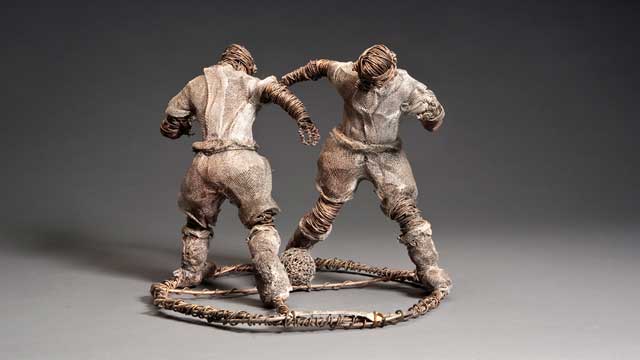
-
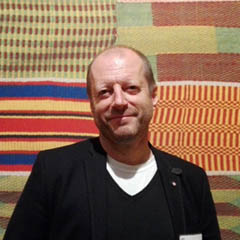 Stefan Eisenhofer
Stefan EisenhoferHis artistic production is informed by the basic concepts of "love", "peace" and "liberty", and he expressly hopes that his works will help to create a better future.
Since 1996, after twenty-five years of working with clay, plaster, stone, cement and wood, Joe Big-Big has mainly used wire, iron nets and barbed wire to produce works with a very characteristic signature. Through the use of metal nets, he produces an effect of lightness and dynamism, even in sculptures several metres high. It was his fondness for big and high sculptures that earned him the nickname Big-Big.
Through his choice of materials he reveals the preoccupations that inform his work: he believes that people are free to decide whether they want to produce or destroy something, to encourage or suppress. In Joe Big-Big's work, wire and barbed wire, commonly symbols of oppression, captivity and division, represent the overcoming of bondage: they stand for prevention and protection. Joe Big-Big plays here with the notion of wire as an everyday material that normally goes unheeded, but which can become an instrument of human creativeness and global understanding through artistic activity. However, in Joe Big-Big's work this metal material seldom loses its ambivalence – for it is also a symbol of human labour and human toil. The artist makes use of these associations in works showing toiling people.
Joe Big-Big is intensely interested in the iconology of his metal materials and the objects he integrates into his works. Padlocks, for instance, symbolize the difficulties we get ourselves into, while keys stand for solving problems, freedom, peace and happiness. Coins represent the money we need to live, and clocks or watches are references to the time we need for solving our problems on the way to a carefree future. The metal materials thus symbolize wealth, strength and power. The artist also deliberately combines old with new metals, as a reminder that one needs to remember the old in order to be able to cope with the present and the future.
The themes taken up by Joe Big-Big come from nearly all areas of human life. His works are concerned with very personal issues as well as with political topics, such as war, poverty, flight, displacement, or the equality of women. He believes that his images speak louder than words, and he intends them to arouse emotions in the viewer, for "art without emotion, feeling or meaning is like a voice or a noise without meaning".
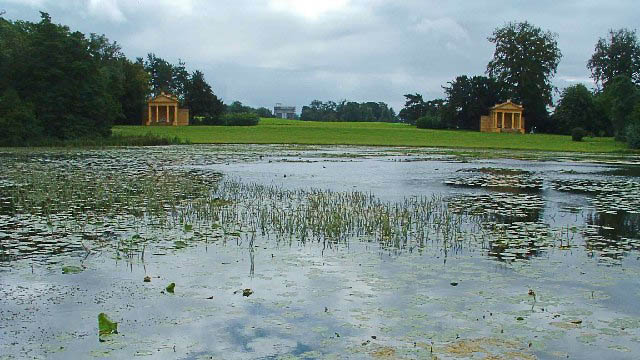
-
 Ernst Wagner
Ernst WagnerThe English Garden perceived as harmonious, lovely, picturesque or graceful to visitors in our present day, is charged with political resistance, struggle for power, projection of social utopias or flight into resignation. Like many interesting creations, these gardens are microcosms full of contradictions – particularly during the time they were created in the early 18th century: utopia and idyll, a mirror of society and its antithesis, dream and melancholy, imitation of nature and going beyond nature.
Stowe House Park, less than 70 miles northwest of London, is considered to be the first and most definitive site of an ‘English Garden’ – Lancelot Brown (1716 – 1783) who was employed there was the first person whose life-long occupation was that of a landscape gardener. The Stowe gardens embodied the ‘English Garden’ paradigm like no other and Benton Seeley’s guidebook (1742), the first garden guidebook to be published in the world, helped to spread Stowe’s influence throughout the 18th century as the model for the ideal English garden.As a country estate of the Temple family, it was – many decades before the redesign – first committed to Baroque, i.e. French models: symmetrically laid out, geometrized nature, combined with the pompous splendor of the manor building. The early model was abandoned and the new complex design of 26 hectares followed more innovative principles, for good reason; however, it still remained a status symbol of the wealthy family.
Thus the many buildings that were built in the park are demonstratively not Baroque. After all, Baroque embodied absolutism, which was despised. Instead, they were inspired by Renaissance, Gothic, antiquity, or Chinese architecture, pre-baroque styles or styles found geographically outside the borders of England. Each style tries to evoke its own mood: Gothic stood (and stands) for the morbid, the unearthly, China for the exotic, antiquity for the free citizenry.
In this sense, the names of the garden parts can be understood as allegories: Temple of Concord and Victory, Grecian Valley, Stauen von Saxon Deities (Germanic Deities) or Homer and Socrates, Gothic Temple, Elysian Fields and many others refer to cultural regions that represent a different, supposedly better social order. It is about an alternative concept to the absolutist principles, about freedom. The dedication inscription on the Gothic Temple makes this very clear: “To the liberties of our Ancestors”.
This directly decipherable political iconography is complemented by a differentiated iconology of forms. For example, the grass around the Temple of Ancient Virtue is subtly maintained as a lawn, while the grass around the ruins of ‘contemporary virtue’ grew wild until the ruins disappeared completely. The outdoors devours the contemporary, decadent, (neo-) absolutist tendencies. Thus nature was liberated from geometrizing corsets just as society was liberated from absolutism. As in free nature outside the garden with its unbridled forms, the garden becomes a free landscape in which free people move freely.
This conception of how such a landscape garden should look was influenced by three main sources: from the personal memories of nature that English nobility brought back with them from their Grand Tours through Europe; various descriptions of exotic Asian gardens; and, finally, from the classical landscape paintings by Ruisdael, Lorrain or Poussin.
Areas in the garden were designed for such three-dimensional pictorial stagings, which in Stowe featured over 90 selected scenes (or one might call them intriguing or harmonious compositions) that could be experienced from certain spots or areas in the garden. The visitor had to and has to set out to walk in order to experience all the spaces and perspectives along the way. Winding paths, which repeatedly open up to surprising glimpses of the unexpected, lift the visitor from everyday life and put him in a special mood. Hence, the course of the path is the central means of the landscape designer to develop his own dramaturgy. He steers the visitor and controls what he sees and when. What the visitor doesn’t see are typical walls. Instead the use of ha-has, a recess in the landscape similar to a sunken ditch, creates a vertical barrier while preserving an uninterrupted view of the landscape. The fine line between art and nature disappears.
The ever-changing weather, light and appearance of the plants, and the multifold of views along the way, allow the visitor to immerse himself again and again in an entirely new visual experience. This sensual experience should have a purpose. In the five-volume Theory of Garden Art by Hirschfeld, published 1779-85 in Leipzig, the aims are clearly outlined: On the one hand, the education of the observer through the enjoyment of art (“inner true cheering up of the soul, enrichment of the imagination, refinement of feelings”) and on the other hand, the “beautification of an earth which is our home for a time”. The aim is thus the refinement of nature by man as well as the refinement of man by nature.
The Temple family had initially acquired its immense wealth through sheep farming, and on the basis of its economic success it provided members of the English parliament for generations, including four prime ministers. English politics in the 18th and 19th centuries would be inconceivable without its influence. Richard Temple, 1st Viscount Cobham (1675 – 1749), who was a key figure in the founding of the park at Stowe, was initially a successful army commander in the War of Spanish Succession against France. In the early 18th century, however, as a supporter of the ‘Glorious Revolution’ (1688/89), which had led to the abolition of absolutism in England, he was marginalized by internal adversaries, which made the development of his garden so important for him.
In search of an aesthetic alternative to the ideologically rejected French garden (as the embodiment of absolutism), Chinese or Japanese gardens offered a central source of inspiration. William Temple had already published a book on Asian gardens in 1690. These gardens were above all a counter-model to the symmetrical arrangement of geometrically limited flowerbeds, the prototype of which was the park of Versailles. The irregular, free composition of trees, plants, stones, and water in Asian gardens was the model for a natural appearance that was as natural as possible and, in turn, created with the highest degree of craftsmanship, that is, artificially. In 1738, this enthusiasm for Asian gardens led to the construction of a Chinese house in Stowe – the first in garden history – an innovation that found its successors in many gardens throughout Europe.
Reference
Sibylle Hoimann, Garten; in: Fleckner U., Warnke M., Ziegler H. (eds.), Handbuch der politischen Ikonographie, Vol. I, München 2011 (Beck), pp. 388.
published January 2020
 Prudence Lau
Prudence LauAt the moment, I find it fascinating that such English and Chinese or Asian cultural exchange upon the built environment started so early on in the 18th century. It reminds me of the Chinese garden that focuses also on landscape, and an emphasis for reflection and escape from the outside world.
published January 2020
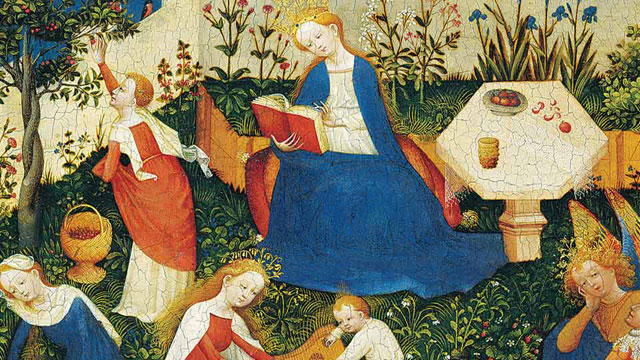
-
 Constanze Kirchner
Constanze KirchnerThe motif Paradiesgärtlein originates from Christian imagery. It was painted many times in the 15th century, especially in Italy and along the Rhine. The enchanting devotional picture shows Our Lady enthroned on a bright red cushion in the middle of the garden, tall, in a radiant blue robe, as the figure dominating the picture. Her head is bowed and she is reading a book. A crown with leaves distinguishes her as the Queen of Heaven.
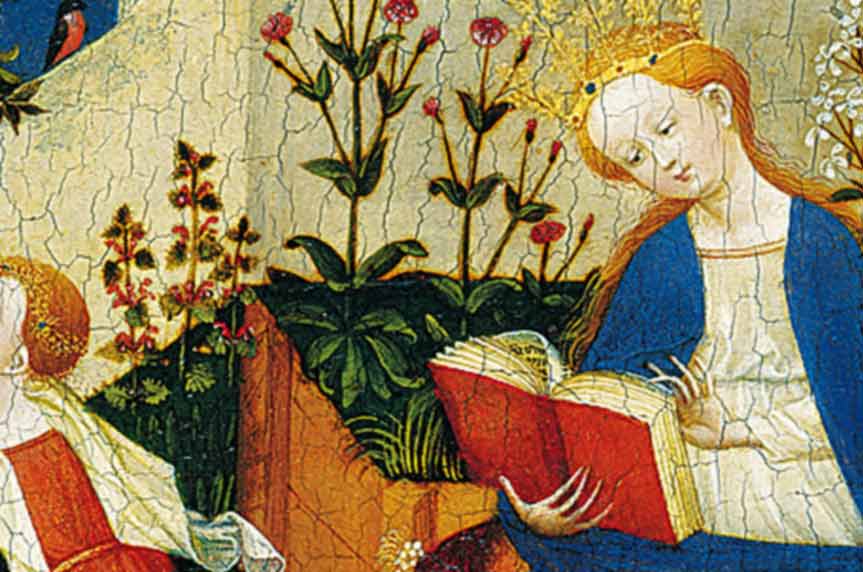
The Christ Child is playing at her feet. The other female figures in the left half of the picture are also to be understood as Holy Virgins because of their splendid clothing. A clear assignment of these saints is uncertain (Keazor 2001, p. 231 ff.). St. Barbara is probably drawing water with a golden spoon from the (life) well in the foreground on the left, because legend attributes to her miraculous powers in overcoming a period of drought. And it could be St. Dorothea who picks cherries from the (life) tree and puts them into the basket, although – according to the legend – the cherries are handed to her (ibid.). The figure holding the plucked instrument (psaltery) to the infant Jesus is interpreted as St Catherine of Alexandria or St Agnes. She is distinguished by a golden diadem with floral decoration and by her flowing hair (ibid.).
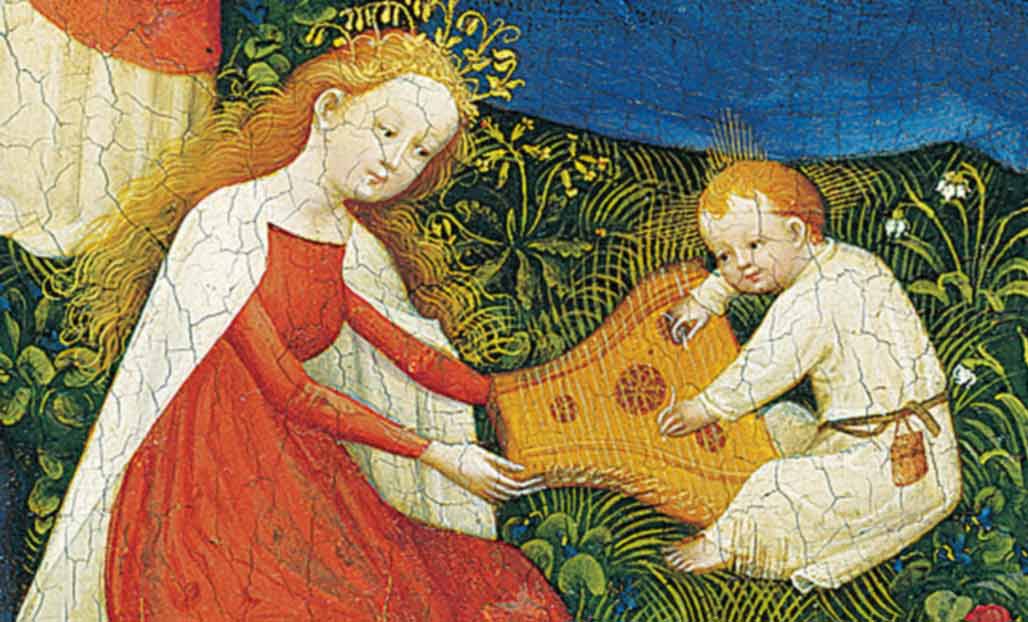
The group of figures on the right consists of the pensive Archangel Michael, also crowned with a golden plant, and – facing him – St. George in chain mail, next to whom lies a small dead dragon. A third figure, probably St. Oswald, bends down to both of them, as a raven peeps out from behind his knee (ibid., p. 233). He is holding on to the tree of knowledge. Saint George has of course already conquered the dragon, which stands for evil, and looks expectantly at Mary. Under another tree sits a frightened monkey with the distinct features of the devil.
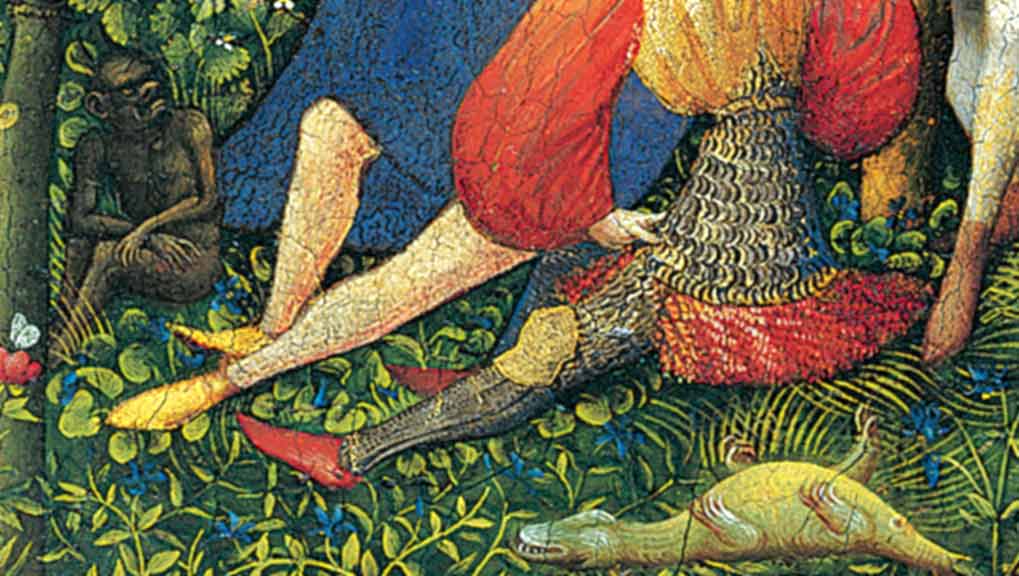
According to biblical legend, he is held in check by the Archangel Michael, the fighter against evil and guardian of paradise. The apples mentioned in the creation story, which tempted to sin, lie ready on the hexagonal, bright white stone table. Wine and bread refer to the Last Supper. The table is compositionally remarkable, dividing the male group of figures from Mary.
Both paradise and the garden stand for a protected, enclosed and bounded place that provides food and water as well as peace and quiet. In the garden, flowers, herbs, fruits and grasses blossom and grow, spanning a supra-temporal, idealising arc from spring (lily of the valley) to midsummer (roses). Especially the white-flowered plants, such as the lilies, stand for the purity of Mary. Just like the plants, twelve birds of different species are depicted in detail and realistically - and thus identifiable (Brinkmann/ Kemperdick 2002, p. 93).
Compositionally, the colour scheme dominates the picture: the secular blue sky frames the graceful Mary leaning towards the book, whose blue robe corresponds with the blue clothing of St Barbara and that of the archangel. The white garments of the saintly figures, the wall in white tones and the light-coloured table enclose the baby Jesus, also dressed in white, in their midst. At the same time, the bright red of the virgins' robes, the red of Mary's book, her seat cushion, St. George's sleeves, the blossoms and fruits reinforce the clear composition, which is additionally underlined by the complementary green of the plants and once again places Mary at the centre of the picture's action. The spatial effect is essentially determined by groupings and overlaps of the figures and pictorial objects; there are no shadows in the heavenly world.
The figures appear relaxed, peaceful and serene, the colourfulness and the abundance of vegetation with springing water embody serenity and earthly happiness. The Holy Virgins are engaged in an occupation that does not cause any trouble. The clothing and hair ornaments are reminiscent of courtly life in a well-tended castle garden. This is also indicated by the killed animals, which are not usually part of the heavenly world, as well as a tree of knowledge that does not bear fruit. This combination of the divine world as a heavenly paradise with the impression of earthly reality characterises the picture to a great extent and thus lends it a peculiar mood, explosiveness and tension in its contemplativeness.
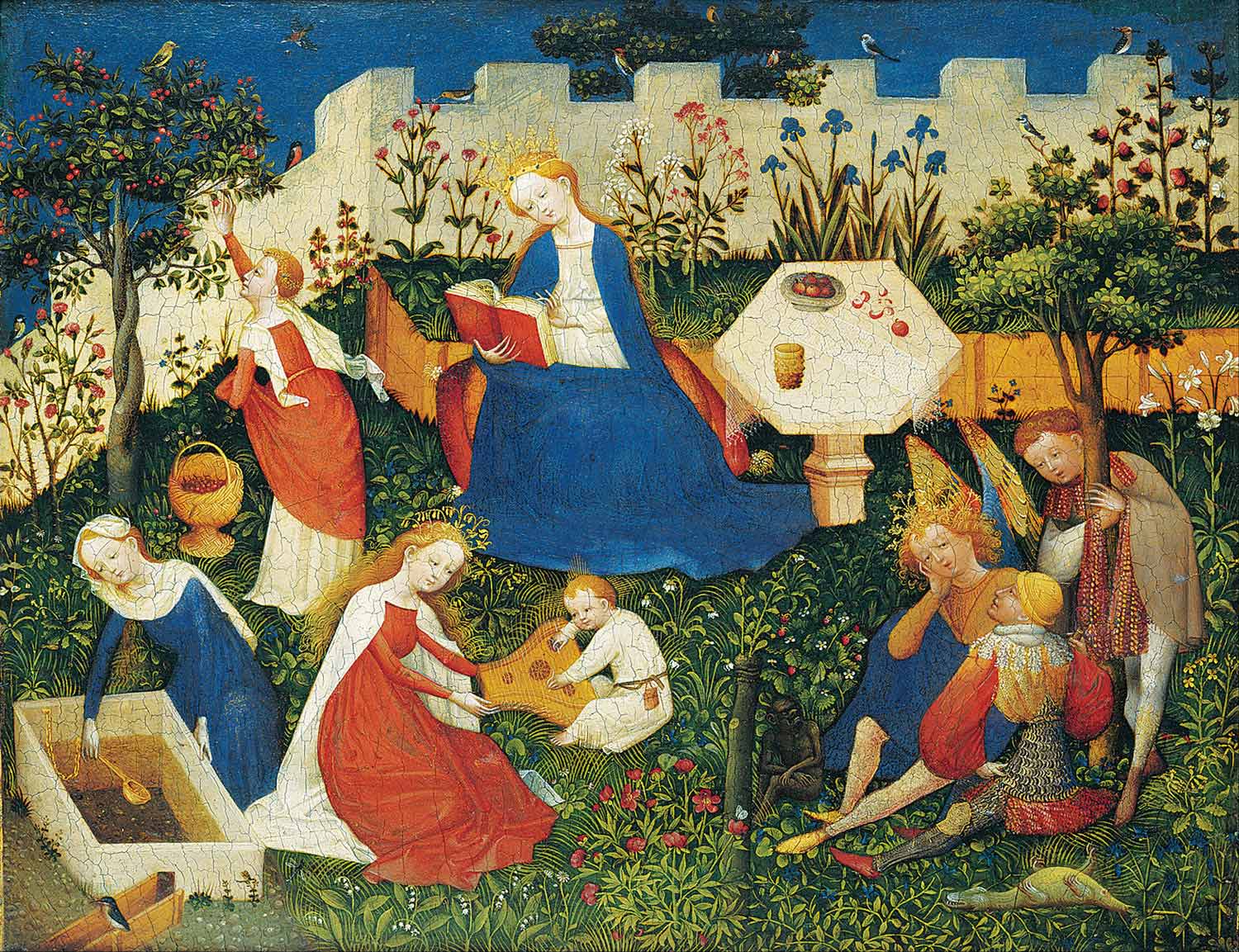
There are numerous studies on the painting technique, the use of colour, the symbolism, the identification, function and activities of the saints, the plants and animals. Also research has been done on provenance in the monastic context or on the attribution of the picture type as ‘hortus conclusus’ (closed garden as a symbol of Mary's virginity). ‘Hortus conclusus’ is often alluded to in paintings of Mary - a garden with an enclosure and with certain plants that refer to Mary (lily, rose, but also lily of the valley or strawberries) - as can also be seen in the Paradiesgärtlein. At the same time, however, the Paradiesgärtlein evokes associations with the gardens of pleasure and love, as found, for example, in engravings by the Master of the Gardens of Love in the mid-15th century (http://bildersammlung-prehn.de/de/node/946, 06.03.2019) - and in this ambivalence once again clearly emphasises the link between divine and earthly worlds of life.
What does the Paradiesgärtlein mean?
The Paradiesgärtlein defies a clear interpretation. The duality of good and bad is hinted at, but the victory of good in paradise over evil or sin – represented by the dead dragon and the vanquished devil – is clearly emphasised. However, the ideal state in paradise is not unbroken: With their tilted heads, the figures in the painting appear pensive, as if they know that there is a life of tormenting reality outside their shelter. The garden as a retreat from the dangerous outside world protects, where in everyday life there is oppression, fear of hunger or sudden death. With the devotional image, religion offers comfort in the promise of salvation to a paradisiacal existence in which the threatening is banished. The imponderable reality is countered by the protective enclosure of the massive wall – outside, the world is full of danger.
The devotional image builds a bridge from this world to the hereafter and vice versa. It opens up a view into eternity and thus into a transcendental space of experience that lies outside finite everyday experience. Visual means are used to create access to the divine, an access that at the same time recalls one's own experience of the world and yet enables the imaginative experience of transcendence.
As an anthropological constant, the idea of a transcendent reality, which usually characterises life after death, runs through many cultures. Experiences of transcendence are described in many ways and often refer to extrasensory perceptions and supernatural forces to which the respective belief is tied.
Why is the painting interesting for art education?
Transcendence and spirituality are often at the core of cultural traditions - in this case Christian heritage. It could be exciting to enter into a conversation about this and to draw on examples of non-European cultural testimonies of faith from the 15th century. In this way, world history can be opened up and a Eurocentric perspective on the history of Western art can be expanded. (As the epitome of European beliefs about the Garden of Eden, the work also stands at the end of the medieval conception of nature and art.)
The image announces divine truth: In paradise, the world is in order. Outside the garden, man lives in untamed nature and is exposed to all incalculable events. With its religious context of origin, the painting's function is primarily to depict an otherworldly, divine order that illustrates the promise of salvation after death in contrast to the earthly hardships of the late Middle Ages. But the pictorial interweaving of earthly and heavenly life already points beyond the late medieval conception of the image. The shielded divine world view experiences ruptures, opening and change.
Not only can the work paradigmatically explain the end of the Middle Ages and the development of art history. Furthermore, the it invites discovery: plants can be identified, animals and groups of figures with their actions tell stories that can be researched, re-enacted, developed further and transformed into the present day. And last but not least, the linking of divine and earthly reality allows analogies to virtual and real, individual and global worlds of life.
References
- Brinkmann, Bodo/ Kemperdick, Stephan (eds.): Das Paradiesgärtlein. In: German Paintings in the Städel: 1300 - 1500, Catalogues of the Paintings in the Städel Art Institute. Frankfurt am Main/ Mainz 2002, pp. 93 -120
- Leaflet of the Städelsches Kunstinstitut on the work: "Das Paradiesgärtlein", c. 1410-1420. Upper Rhenish Master, mixed media on oak, 26.2 x 33.4 cm. Städelsches Kunstinstitut, Frankfurt am Main o.J., o.S.
- Historisches Museum Frankfurt am Main, Prehn'sches Kabinett. http://bildersammlung-prehn.de/de/node/946 (06.03.2019)
- Keazor, Henry: "Manu et voce". Iconographic Notes on the Frankfurt Paradise Garden. Original publication in: Bergdolt, Klaus/ Bonsanti, Giorgio (eds.): Opere e giorni: studisu mille anni d'arte europea dedicati a Max Seidel, Venezia 2001, pp. 231-240. http://archiv.ub.uni-heidelberg.de/artdok/2344/1/Keazor_Manu_et_voce_Ikonographische_Notizen_zum_Frankfurter_Paradiesgärtlein_2001.pdf (07.03.2019).
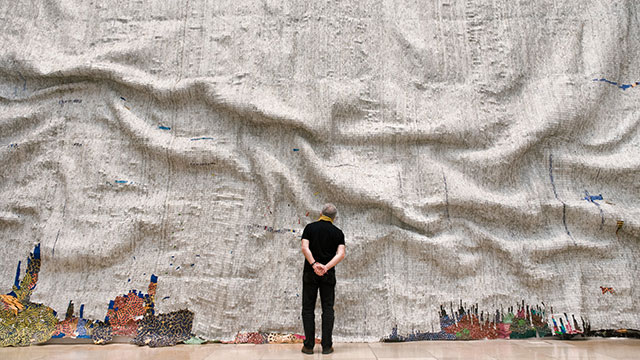
-
 Patrique deGraft-Yankson
Patrique deGraft-YanksonThe Rising Sea by El Anatsui is a naturalistic presentation of an ocean in turbulence, which elicit attention through both grotesquery and finesse. The work, which covers an area of about 14,38 by 6,90 meters, is made up of several pieces of flattened aluminum bottle tops stitched together with copper wires into a massive sheet of grey wall overlay.
To achieve the intended illusion, the artist manipulated portions of the metal fabric into large series of ridges of different sizes that combine into an irregular rhythm randomly positioned across the surface of the sheet to simulate sea waves. Beyond supporting the movements of the sea waves, the rhythm created by the raised portions of the work also provides narrow range of values that effectively bring out the three-dimensionality of the work and transforms the otherwise flat sheet into an illusionistic volume.
Like the texture of oil paints in Van Gogh’s Starry Night, the texture of the stitched pieces of metals sheets introduce energy into the work, bringing out the fluidity of the sea and the potency of the mesmeric sea waves. Indeed, improper disposal of those materials used (and many others) is causing a lot of nuisance in his home country and other parts around the globe, with the sea being the most affected. Therefore, right from the materials used to its marvelous finishing, it is not difficult to discern a blend of severe censuring and admonition in the voice of the artist. The sea is, in the way presented, depicted as rising against improper treatment; and El, by the pains taken to stitch every piece of material together, seems to emphasize the need to make it our business to salvage the sea from improper handling.
The sea, which has served as an important source of livelihood for Ghanaians over the centuries invokes multidimensional viewpoints and draws out divergent responses and reactions depending on its relationship with the people. Among the coastal dwellers (and indeed a very great population of Ghanaians), the sea is considered an important resource for commercial activities, an arena for entertainment and recreation and grounds for spiritual exploits and worship.
He himself being born in the coastal town of Anyako in the Volta Region of Ghana, El seems to know so much about the sea. Growing up, he most likely experienced the sea being perceived, treated and utilized in many different ways. Besides its major use for commercial activities and other useful ventures, he might have listened to many stories about the sea as a god (with other inhabitants), as a provider and as a friend. He might have learnt about how the sea and her inhabitants contribute to the fortunes of the people. He might have witnessed how people got healed as they bathed in the sea, or had their fortunes turned around as they threw some coins in the ocean and made their requests known to the sea.
Beyond this, he might have also been warned about the consequences of flouting the taboos and other prohibitions that regulate the “use” of the sea, including forbiddance from desecrating the sea with unhealthy practices such as defecating in the sea, throwing filth into the sea or wearing sandals or shoes in the sea and the need to observe the tabooed fishing days, and so on. Besides, another important thing which Ghanaian coastal dwellers take very seriously is the need to adhere to physical signs and conditions of the sea, which have various local interpretations and implications. For instance, there are periods when the sea is considered as “full”, during which times the sea waves “rise” and become more intense and turbulent. Fisher folks are supposed to take a rest from “climbing the sea” (as they say in the local parlance) as the sea is likely to be unfriendly, and therefore unconducive for fishing.
Factors that cause the “rising” of the sea may not be ordinarily known. However, according to coastal dwellers, there is always something sinister about a rising sea – either somebody got drowned, or someone or a group of persons might have violated the rules of the sea god – and what motivated El in his presentation of the Rising sea might not be any different from what are traditionally believed. Probably the sea is fed up with deliberate dumping of wastes and toxic materials into her bowels. Therefore, she must rise!
But the “full” or “rising” sea is not as unfriendly as it sounds. Though it prevents fishing activities, which might be one way of punishing the people for disrespecting her, it also affords the people the opportunity to dry up their canoes, mend their nets and relax in the beautiful view of the sea along the coast. The occasions of the rising sea also witness other people who just move along the shores to observe the large waves that gather in the deep ocean, roll angrily towards the shoreline and dissolve tumultuously at the shore in a creamy white lather. The views at the seashore during these periods are nothing short of aesthetical experience that is shared by different kinds of observers with different perceptions, questioning, discussing, enjoying.
In so many ways therefore, the spectacle of observers in front of El Anatsui’s gigantic reconstruction of the Rising Sea gives so much semblance to the natural phenomenon, and this is a fundamental underpinning to the success of El’s work.
Culturally, the Rising Sea could be perceived as an allusion to the dynamisms in life, which sometimes rise against human tendencies and restrict mundane behavior, at the same time ensuring regularization of natural behaviors. What is important is to identify what is causing what, and how to seek for the right solutions.
For it to be presented as an aesthetic piece of work, El is probably saying that, the Rising is Sea is frightening; it is confusing; it is chaotic. But she is still beautiful, because in the right time, when given the right treatment, she will calm down so we have nothing to fear. She is still our god, our friend, our provider and our protector.
published February 2020
 Ernst Wagner
Ernst WagnerEl Anatsui (* 1944) created 'Rising Sea' 2019 specifically for a particular wall in a comprehensive solo exhibition of his oeuvre entitled “Triumphant Scale” at the ‘Haus der Kunst’ in Munich. Like many of his other works, “Rising Sea” is a large-scale piece comprised of thousands of flattened liquor bottle caps (extrapolated approx. 190.000) that have been tied together with copper wire. It hangs like a large tapestry from ceiling to floor and though it looks solid, it is flexible and has a seemingly textile structure. The effect is monumental and magnificent; it impresses by the sheer size as well as by the sensual materiality of the almost infinite number of small, shimmering pieces of tinplate.
To see the composition we need to view the work from a distance. The sculpture is divided into three starkly contrasting horizontal zones. A vibrantly colored strip runs along the bottom. It appears fragile and becomes thinner and interrupted as it runs toward the lower right corner. The broad, massive, monochrome grey zone in the middle falls with heavy folds. The third zone at the top is a narrow, shiny, silver and smoother appearing plane that rises from its lower edge on the left in a sharp line upwards to the right, like a ‘Silberstreif’ (i.e. glimmer of hope).
Nearing the work, we discover bright flecks of color that emerge out of the shimmering mother-of-pearl gray middle zone. While some of the flecks appear to build concrete figurations others seem to be randomly dispersed. In the lower right corner small speckles of color gravitate toward and buzz around a concentrated cluster of speckles. We are enticed to move closer and to discover more details. Individual bottle tops become recognizable out of a speckled ‘field of pixels' or 'threads in the fabric’. One recognizes and reads the labels "Turn to open" and the names of African high-proof alcoholic beverages that are popular in Ghana or Nigeria where El Anatsui lives and works (KP Beverages, Bacco , etc.)
As with an impressionist painting, this work enables and requires two different viewing positions: close up and from a distance. Both perspectives tell different stories. In contrast to impressionism, El Anatsui’s stories address political and social issues of highest relevance. From a distance, the rising water level caused by global warming is addressed, to which the title of the work 'Rising Sea' refers. “Reading” from left to right, sculptural folds in the large gray middle area remind us of mighty waves that are in the process of destroying the narrow, speckled strip on the floor that we may associate with human dwellings and their fragile situation. The ‘Silberstreif’ is dwindling and so is hope. Obviously, this meaning is addressed directly and in all clarity.
The inscriptions on the bottle tops tell another story, the story of alcohol and slave trade during European colonialism in West Africa. Thousands of Africans were sold and taken across the Atlantic in ships to cut sugar cane in the Caribbean plantations to make rum. The rum was shipped to England and then later sold to Africa. Rum with its high alcohol content became another means of dominating an already exploited people. In the course of time, West Africans commonly used rum and other forms of alcohol for libations. However, El Anatsui only uses discarded bottle caps from liquor made in Africa today.
In turn, the process of 'sewing' the individual metal pieces together is an important, additional cultural-historical referral to El Anatsui’s roots in West Africa where there is a long tradition of weaving colorful textiles.
The close-up view of “Rising Sea” thus speaks of the past in West-Africa. Whereby the view from the distance, speaks of the future, a future that directly and indirectly affects the world globally. The narrative strands are connected by the idea of upcycling: discarded bottle caps become art, the cheapest material becomes sumptuous beauty, the past becomes present and future, regional colonialism becomes the narrative of a global threat.
It is important to remember that it is a black artist from Ghana exhibiting this threatening beauty in a space that was built in Munich to serve National Socialist racism. The title of the exhibition 'Triumphant Scale' alludes directly to this context, which Okwui Enwezor, the initiator of the exhibition, was certainly aware of. The Nazi regime, a regime without scale, built the Haus der Kunst, a building that broke all scales. El Anatsiu’s magnificent, grand scale triumphs over the excessive Nazi scale.
Challenging the Western concept of art
As an artist, El Anatsui is a representative of the Global South as well as of global art. He displays past and present catastrophes in decorative splendor. We can understand this message through classical analysis and interpretation on the base of the iconography of material and motifs. This system of decoding is familiar to us and confirms our Western expectations of a work of art. However, the simple explicitness of the content of El Anatsui’s work, poses a challenge to Western expectations of open, complex, self-contradicting art.
According to the latent notion of the community of art experts, if there is a clear content in art it should be as ironic, witty or distanced as possible. Hence, the intrinsic value of art (l'art pour l'art) eludes ideological appropriation and art gives no instructions for action. None of these tenets of Western art is is evident in Anatsui’s work. "Turn to open” with an arrow pointing up or down is the instruction repeated thousands of times in the middle section of “Rising Sea”. The sentence can be read as a directive for us to act on the challenges of our time.
El Anatsui thus negates the ‘prohibition' of unequivocal, direct symbolism and narration in the Western concept of art and its associated prohibition of politics and agitation. As a global artist, he challenges this concept. In addition, it is interesting to note that El Anatsui, unlike most Western artists, often leaves the responsibility of installing his work in exhibitions to the respective curators. In every exhibition, the same works look a little different, or quite different: folds will fall differently, pieces will be grouped differently and work that has been previously exhibited hanging on the wall may even be presented lying on the floor. With this artistic strategy, he formulates an unmistakable position from the Global South. Thus Western dominance loses its normative power in art and culture in general. The world becomes more diverse and polycentric.
Learn more about El Anatsui.
published February 2020
 ISB_Team
ISB_TeamTwo perspectives on one work of art
In 2019, a large solo exhibition of the Ghanaian artist El Anatsui, initiated by Okwui Enwezor, took place at Munich's Haus der Kunst. It was the occasion for Patrique deGraft-Yankson and Ernst Wagner to write together about one of the works there. deGraft-Yankson and Ernst Wagner agreed on a parallel writing process in order to minimise any mutual influence of their respective approaches. Thus, they knew nothing of each other's point of view. The resulting texts can be read above.
The result of this exercise is surprising and fascinating. In some aspects, of course, the interpretations of the work coincided, but in others they differed considerably. What they had in common, for example, was the appreciation of the production process and the impressive effect of material, size and surfaces. Also that the issue of environmental pollution plays a central role in the interpretation of Rising Sea. But it was precisely here that the first differences, even mutually exclusive approaches, emerged: for example, when deGraft-Yankson referred to the sea as a deity, a deity that can sometimes be friendly, but also unfriendly. Understood in this way, the sea in its immediate effect is simultaneously frightening and beautiful, it threatens and at the same time invites aesthetic enjoyment.
Ernst Wagner could easily relate this aspect to the Western aesthetic of the sublime, however, the difference becomes quite clear when we look at the underlying concept of what an art work is. deGraft-Yankson's text takes the work of art as its point of departure, but it always speaks of the sea itself, while Ernst Wagner always speaks of the work - and not of the sea. This different focus marks a fascinating difference: deGraft-Yankson is concerned with the sea, which he brings to us through his discussion, while Ernst Wagner is concerned with a work of art that simply has the sea as its subject. For deGraft-Yankson, the sea is "in" the work, it is really present. For Ernst Wagner, the sea is a represented motif, it lies "behind" the work, so to speak. It serves as a theme or a point of reference.
This has consequences for the methodology: while Ernst Wagner delivers an analysis of form, deGraft-Yankson focuses on contextualising the art work; he describes the significance of the sea for the people on the Ghanaian coast today. This difference is probably also due to the different perceptions of what the sea itself is: in his text, deGraft-Yankson speaks of the sea as an independent, souled entity, an acting being or a god that enters into a relationship with people. For Ernst Wagner, the sea - as part of the ecosystem - is also in relationship with humans, but he does not ascribe an independent will to it.
These different understandings of the relationship between human beings and the world are then echoed in an obviously equally different concept of what art or an art work is. In deGraft-Yankson's text, the work of art, like the sea itself, is charged with energy. The sea appears, as it were in the work, indeed it is present there. In the work, then, the sea materialises as something we perceive directly. In this sense, the work and the sea appeal to us to "preserve it from improper treatment [...] or it will be desecrated."
This approach of deGraft-Yankson, in which everything interpenetrates, is contrasted with Ernst Wagner's approach, which analytically separates everything: proximity and distance, splendour to be enjoyed and admonition to be taken seriously, discourse on colonialism and ecology, work and motif, art system and ecology, art system and colonialism, and so on. In the end, Ernst Wagner achieves a synthesis, but it only works on a meta-level by addressing the irritation of the Western concept of art through Anatsui's work. An irritation that dissolves or at least relativises the fundamental separation in Western understanding of viewer and object, of sign (the concrete work) and signified (the rising sea), of spirituality and reality, of art and ethics.
Annette Schemmel, then member of the ISB group, wrote to the the authors in 2020:
"Dear Patrique, dear Ernst,
Your texts are a great read and so complementary! For me, writing from Munich, the aspects raised by Patrique have opened up an entirely new reading of this marvellous piece of art, which I was lucky to contemplate at the exhibition of Haus der Kunst. What you're telling about Ghanaians' relation to the sea is unveiling and beautiful, thank you for unfolding these narratives here! Thank you all the more for sharing a piece of local wisdom (how the sea can react angrily) and linking these narratives to the global challenge of saving the sea, a challenge with impacts on localities all over. On another note, the evocation of "Starry Night" caught my eye at once and does make a lot of sense to me. I will be using it in my art classes, if you don't mind.
Ernst's reading of the piece is much more familiar to me, obviously. He is telling about the context of the exhibition on site in Munich, a context that is so highly charged! When exhibited at this specific museum, Anatsui's work can't but comment on our German history, laughing at its racism by means of its "immoderate" dimensions and calling for a long-due revision of our role in colonialism and in exploitative global circuits of goods like alcohol. It is for this potential of speaking to a place that artworks should always be seen in different locations!
I would also like to point out that Ernst is exemplifying a familiar method of accessing artworks here, a method that I am happily teaching to my pupils. This method from academic art history wants you to start from close observation and description of formal aspects of the work before risking an interpretation. By means of this strategy arguments about a work of art are meant to become more solid, even if this visible gesture of searching for the right interpretation makes a text less smooth. Thus, Patrique's and Ernst's approaches are totally complementary.
This said, I am not agreeing with Ernst in the way that "Rising Sea" is explicit in a way that certain Western art lovers might want to criticize. They might, but they would be very wrong. Let me explain: to me, the reproach of explicity rhymes with simplicity and a lack of layerdness. As you both have shown, "Rising Sea" does have multiple layers of possible interpretation and certainly some more, which have not been addressed here. These layers are visible, not only but most clearly, if the work is read against the backdrop of different locales. Artworks from our global age command us to look at them with changing perspectives. If certain Western art lovers can't be bothered to do this, they will forever be missing the point. Their fault. Let me add that you might even spot a good deal of irony in the way that El Anatsui has made this piece outstandingly beautiful, caressing the eye to the degree that every exhibition visitor wanted to take a selfie in front of it, while at the same time pointing to some very painful and threatening truths about today's humankind. Therefore, I would like to uphold that this artwork's relation to the viewers and to its places of exhibition is complex and challenging rather than simple or explicit.Annette"

-
 Esther Kibuka-Sebitosi
Esther Kibuka-SebitosiRainbow Nation
The rainbow in the Bible given in Genesis 9:16 is a reminder that we have a covenant with God not to destroy the earth again by floods. “I set My rainbow in the cloud, and it shall be for the sign of the Covenant between Me and the earth,” says the Lord. God had made a covenant with Noah and his seed for generations. Genesis 9:9. And I, “behold, I establish my covenant with you, and with your seed after you”. Since we are all Abraham’s seed, we are covered in this covenant, although Jesus makes a better covenant in the New Testament. Returning to the rainbow nation, this covenant is saying “ no more destructions”. It is as if God is saying we should no longer fight each other but live together in peace. He made us all people with different colours (rainbow).
The metaphor describes a people with multi-cultures living together. The image of the flag is a symbol of togetherness or unity. The different colours. Adopted in 1994, the red, white and blue were adopted form the colours of the Boer Republic while the yellow, black and green were taken from the ANC (African National Congress) flag. The black colour is a symbol of the people; the green represents fertility of the land while the gold represents the wealth from minerals beneath the soil. The ANC adopted these colours way back in 1925.Associated with the flag is the national anthem. This is unique in that it has many languages:
- Nkosi sikelel’ Afrika
- Maluphakanyisw’ uphondo lwayo,
- Yizwa imithandazo,
- yethu,
- Nkosi sikelela,
- thina,
- lusapho lwayo.
- Morena boloka setjhaba sa heso,
- O fedise dintwa la matshwenyeh
- O se boloke (Ntate)
- O se boloke
- setjhaba sa
- heso,
- Setjhaba sa
- South Afrika
- – South Afrika.
- Uit die blou van onse hemel,
- Uit die diepte van ons see,
- Oor ons ewige gebergtes,
- Waar die kranse antwoord gee,
- Sounds to call to come together,
- And united we shall stand,
- Let us live and strive for freedom,
- In South Africa our land…
Songwriter: Cornelius Jacob Langenhoven
Summary
The Rainbow metaphor is characteristic of a nation that aspires for peaceful living; building a peaceful nation. The symbol taken from the Bible donating the Noahic covenant reminds us that God will no longer send the floods to destroy us.
The flag is a symbol of unity between the Boers and the African National Congress colours, which represents the whole of South Africa. It is a sign of hope and nation building.
Associated with the Flag and the Rainbow nation is the National anthem. It is written in many languages signifying the rainbow nation of multi-cultures.
References
- https://en.wikipedia.org/wiki/Rainbow_nation
- https://www.worldatlas.com/webimage/flags/countrys/africa/soafrica.htm
published January 2020
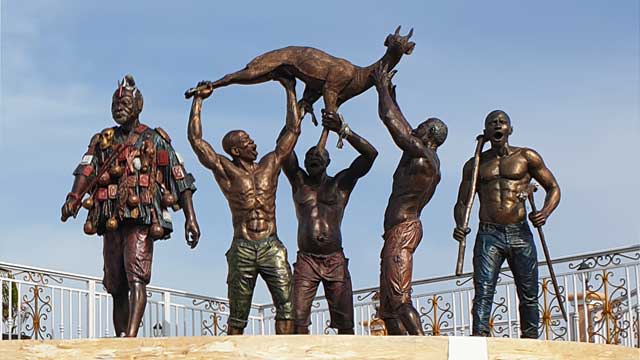
-
 Ebenezer Kow Abraham
Ebenezer Kow AbrahamTheophilus Kwesi Mensah and the Placemaking Paradigm
Within the rebranding and the making of new identity for Winneba as enshrined in the Effutu Dream Project, the name Theophilus Kwesi Mensah cannot be overlooked in this intercourse. This is not only because he engineered the widely talked about installations: the Unity Monument, The Aboakyer Monument, The Fishermen of Akosua Village and the Monument of Ofarnyi Kwegya but the awe-striking aesthetical connotations he incorporated in the aforementioned works. Each of these statues were rendered to mimic the idea of Winneba as a community built on a collective space. Being native of Winneba, heightened his understanding of how the amalgamation of economic, political, and cultural activities in the past, would accord him the impetus to express himself publicly. In so doing, he empowered his sculptures to ventriloquy the unique narratives that define Winneba and redefine this relatively old settlement yet burgeoning municipality as a dwelling place or a place worth visiting.
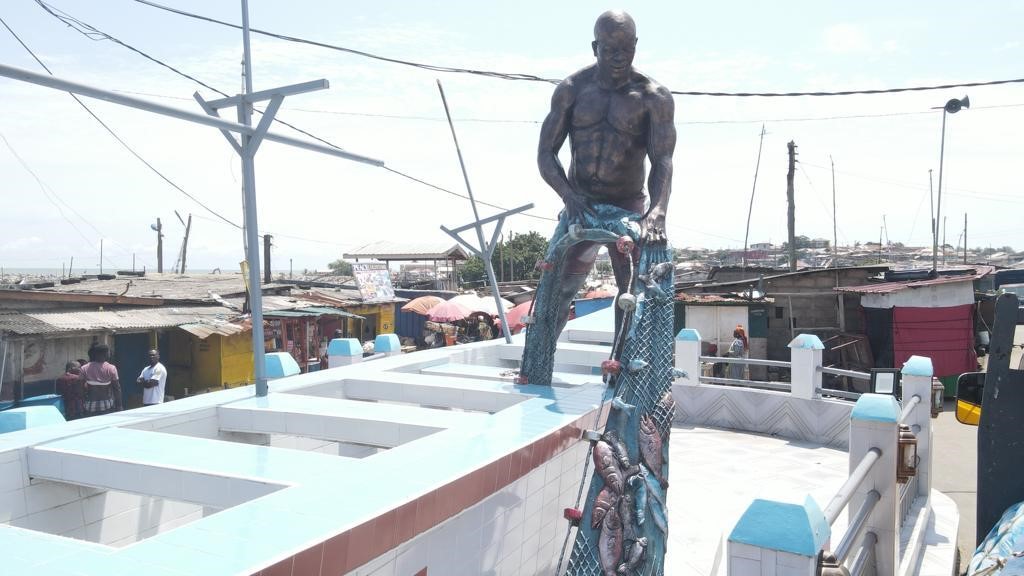
Figure 1: Theophilus Kwesi Mensah, Ofarnyi Kwegya, 2021. Fibre Reinforced Polymer. Yeepimso Community Centre, Winneba. Courtesy of Edem Dedi Photography.
Through the lens of placemaking, Ofarnyi Kwegya (Figure 1) and the Fishermen of Akosua Village (Figure 2) are two typical statues that has beautified the vernacular space of two historical settlements in the older southern half of Winneba.
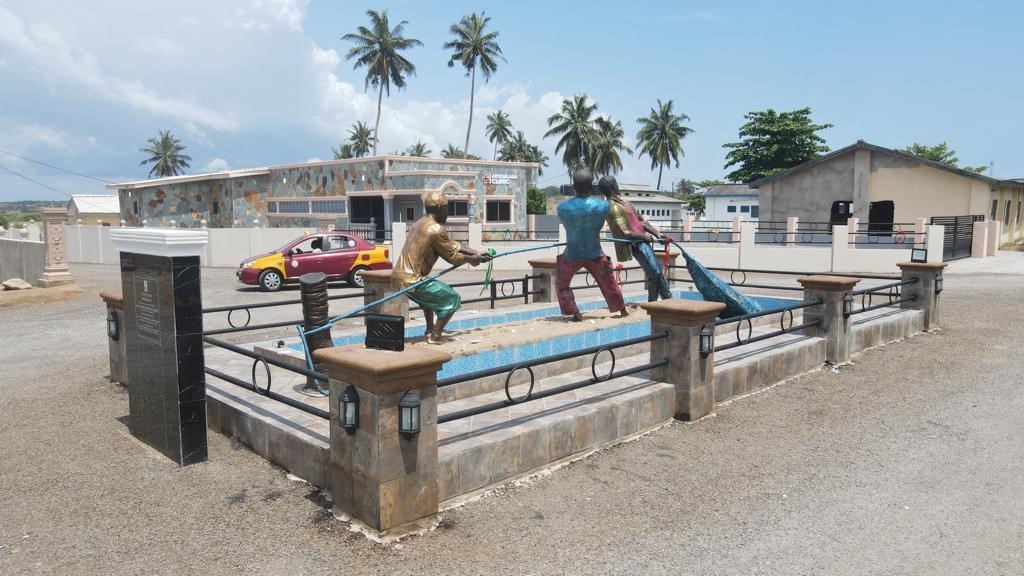
Figure 2: Theophilus Kwesi Mensah, Fishermen of Akosua Village, 2021. Fibre Reinforced Polymer. Akosua Village Community Centre, Winneba. Courtesy of Edem Dedi Photography.
The two statues stand in the middle of Yeepimso and Akosua Village communities respectively as embodiments of vital ingredients helping in creating a sense of community, civic identity, and culture in both spaces. They have both transformed their unique sites as lively and attractive communities with the monumental figures not just becoming legible maps to the sites but turning the spaces into places that support human interactions. The site of the statue has become the most important and attractive places in the two communities. They have become the center of attraction where the community gather for entertainment and trade, especially at night when economic activities in the two communities are at their peak.
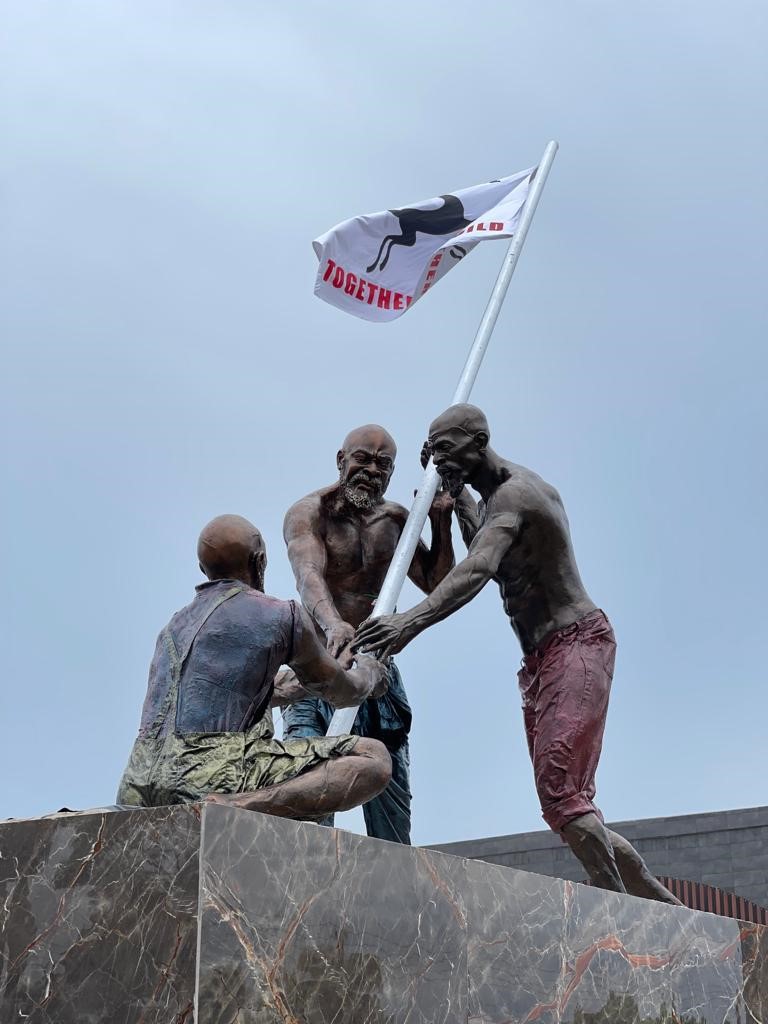
Figure 3: Theophilus Kwesi Mensah, Unity Monument, 2021. Fibre Reinforced Polymer. The Unity Square, Winneba. Courtesy of Edem Dedi Photography.
Another compelling monumental statue that has transformed the landscape of its site is the Unity Monument (Figure 3). Before the advent of the monument, the site of the statue (the Y-intersection – Winneba Traffic Light) was a deserted barricaded mere chaparral which displayed all forms of notices including obituaries and political posters (Mensah & Abraham, 2022). Yet, Theophilus Kwesi Mensah’s statue has transformed the space into an ideologically charged space for a deliberative unity and peace agenda in Winneba. The environment is so aesthetically pleasing that people like to visit the site for selfies and sightseeing thereby generating income for the Municipal Assembly.
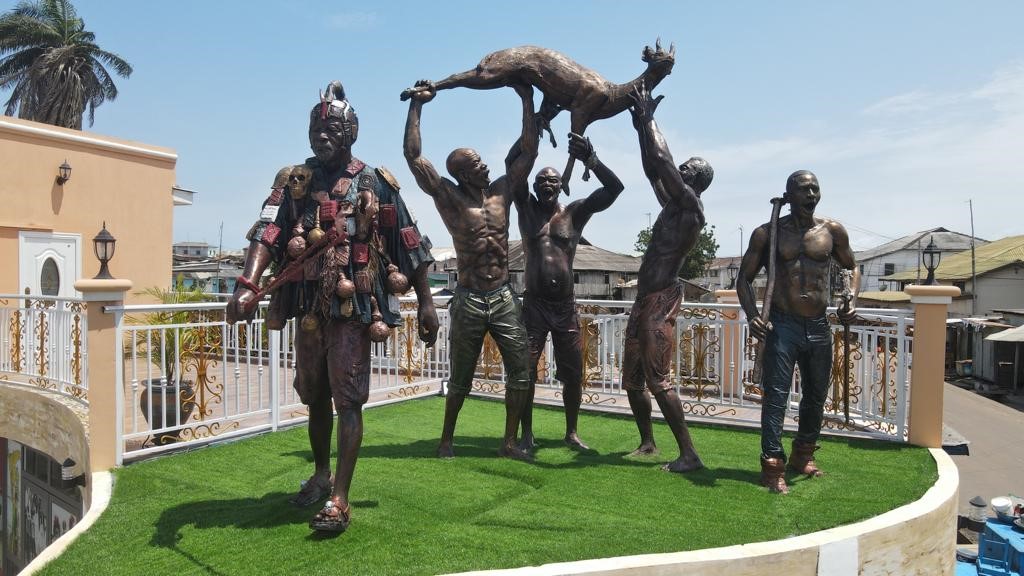
Figure 4: Theophilus Kwesi Mensah, The Aboakyer Monument, 2021. Fibre Reinforced Polymer. Osimpam Museum, Winneba. Courtesy of Edem Dedi Photography.
Theophilus Kwesi Mensah’s ontological orientation of Winneba is multifaceted. Hence, he found significance in the century’s old festival of the people of Winneba, Aboakyer to sculpt a monumental statue to this honour (Figure 4). The Aboakyer Monument mounted on the roof-top of the Osim Pam Museum is at the heart of Winneba as an embodiment of Winneba’s heritage. Owing to the enormous narratives surrounding the Aboakyer Festival, it is seen as one of the most popular and most significant festivals in Ghana (Akyeampong, 2019). The people of Winneba are invariably identified by the Aboakyir Festival. Theophilus Kwesi Mensah captured the very essence of the festival by vividly depicting the most significant characters: the Supi, the Asafo warriors, and their cheer leaders in procession with the catch.
During the 2022 Aboakyer Festival, it was observed that both celebrants and tourist were awe-struck by the aesthetic connotations of the monument. People gathered around the site for various reasons. Whilst some were seen taking tourist photos, others were seen venerating the ancestors who in the past led the festival.
In view of the Effutu Dream Project, Theophilus Kwesi Mensah’s artistic ingenuity to a large extent has contributed to rebranding the Winneba Township by beautifying the place and making it attractive for tourist. However, beyond the beautification agenda, part of the underlining philosophy of the statues was to consciously bring to the fore, some compelling memories of Winneba in relation to the current narratives within the land.
Theophilus Kwesi Mensah and the Collective Memories of Winneba
Theophilus Kwesi Mensah capitalized on his creativity to translate some notable historical events pertaining to his beloved native, Winneba into tangible remnants of the recent past to shape and, indeed, consolidate the Effutu Dream Project. Whilst usurping a storyteller, he equipped his statues to mimic the historiography of Winneba as collective memorials for the publics of Winneba. This is underpinned by his inclination to the truism that cities are built based on their histories and for that matter, Winneba cannot be gentrified without laying claims to the past publicly. Therefore, he ensured that whilst the Effutu Municipal Assembly initiated the Effutu Dream Project, the glorification of the public triumphs of Winneba was not taken for granted. This desire culminated into transforming some important public vernacular spaces into storehouse of memories embedded and inscribed on the landscape of Winneba.
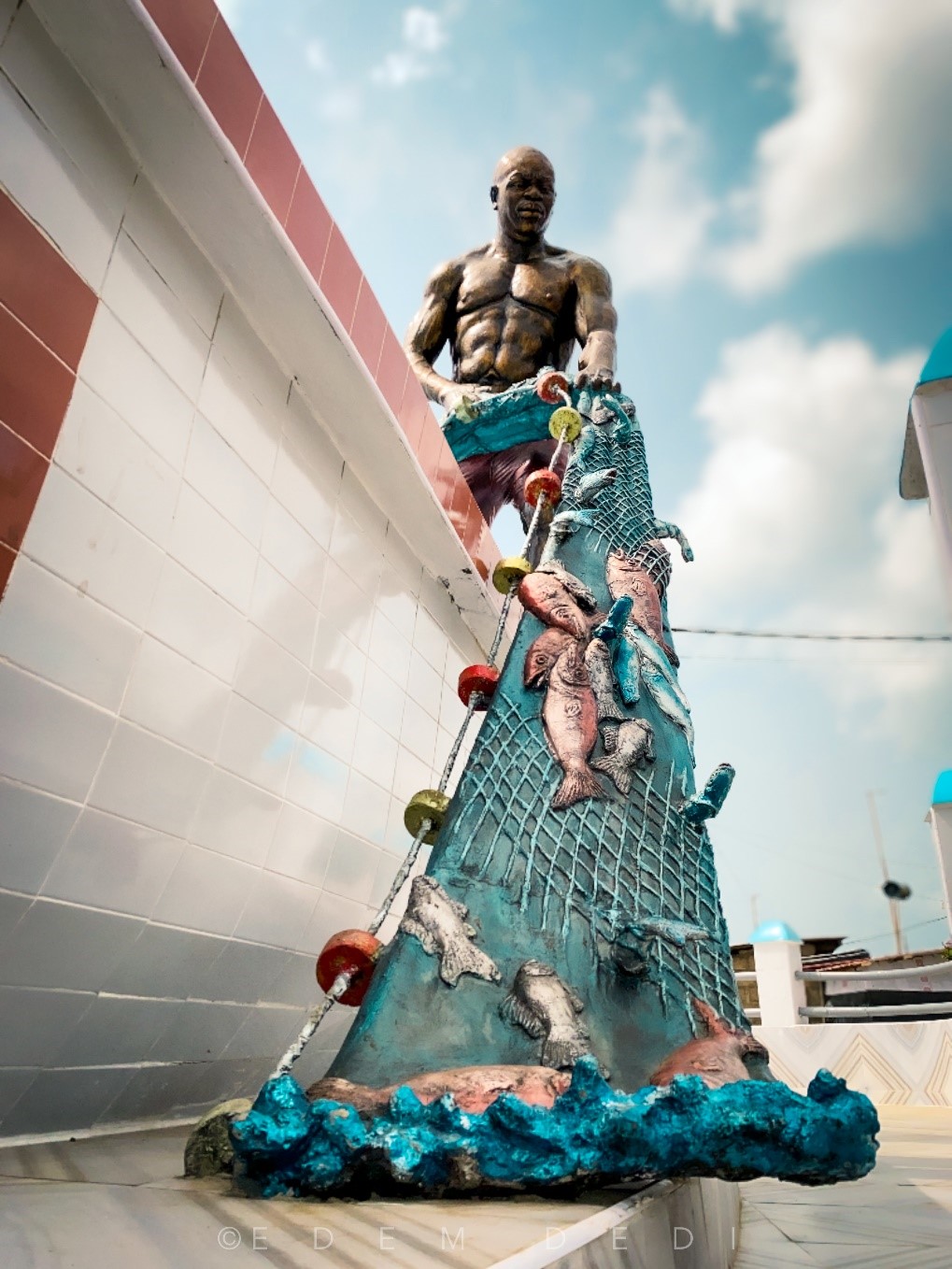
Figure 5: Theophilus Kwesi Mensah, Ofarnyi Kwegya, 2021. Fibre Reinforced Polymer. Yeepimso Community Centre, Winneba. Courtesy of Edem Dedi Photography.
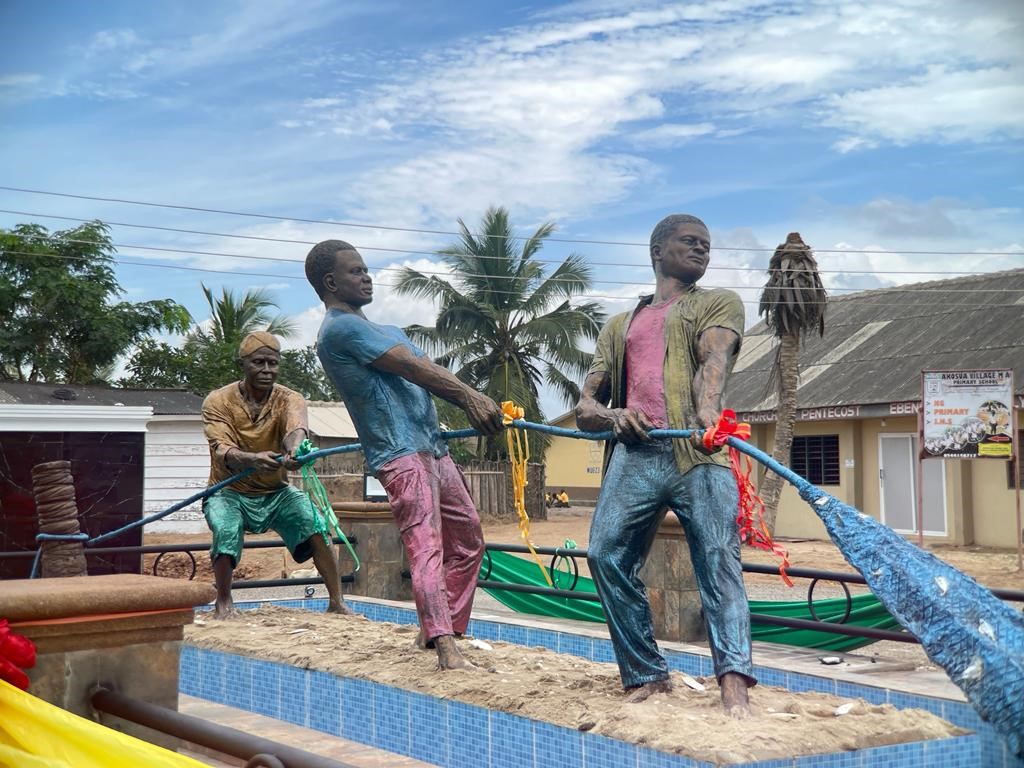
Figure 6: Theophilus Kwesi Mensah, Fishermen of Akosua Village, 2021. Fibre Reinforced Polymer. Akosua Village, Winneba. Courtesy of Edem Dedi Photography.
Knowing Winneba traditionally as a fishing community, Theophilus Kwesi Mensah produced two major monuments, Ofarnyi Kwegya (Figure 5) and the Fishermen of Akosua Village (Figure 6) as a concretized instantiation to the noble trade that has in the past defined what place Winneba is. Ofranyi Kwegya, is the statue of the unheralded giant master fisherman, an exponent of mid water trawling in Winneba who captured huge number of fish whereas the Fishermen of Akosua Village depict the famous trio: Zagada Afadzinu, Kwami Akpade and Sogbka Dagodzo who introduced artisanal fishing or subsistence fishing to Winneba.
Although the fishermen portrayed in these monumental statues have died long ago, they constitute such significant heroes in the historiography of Winneba. In view of their important roles in the socio-economic phenomenology of Winneba, Theophilus Kwesi Mensah aimed at stopping their decay and position them into the realm of the timeless with the erection of their statues as memorials that transmit their archetypal narratives.
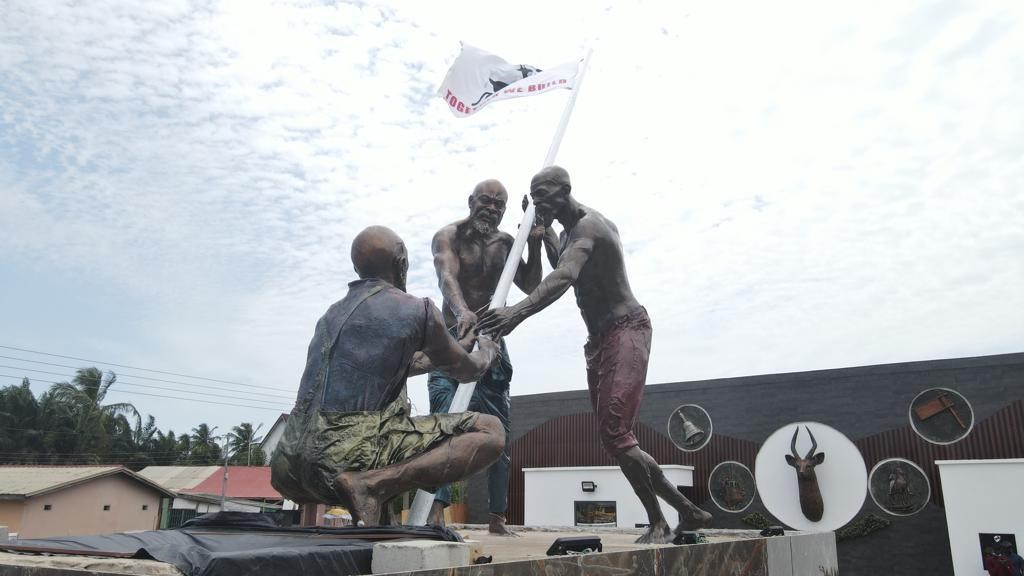
Figure 7: Theophilus Kwesi Mensah, Unity Monument, 2021. Fibre Reinforced Polymer. The Unity Square, Winneba. Courtesy of Edem Dedi Photography.
In view of Theophilus Kwesi Mensah’s understanding of the political and dynastic heritage of Winneba, he engineered the construction of the Unity Monument in commemoration of the end of the protracted chieftaincy feud that had ensued in Winneba in the past. Ephraim-Donkor (2019) recount that since the latter part of the nineteenth century, the people of Winneba have clashed in violent struggle for power until 22nd July, 2015 when the Supreme Court of Ghana, finally intervened. The feud was rooted in an uncanny clash of cultures within the same family three, resulting in a political quagmire as to which succession mode to follow, the male or female model. The people of Winneba traditionally follow the patrilineal line of succession, however the Acquahs who are for the female model, tasted power as caretakers but refused to cede power back to the original benefactors, the Otuano Royal Family (Gyatehs or Gharteys) who are for the male model.
The female model became popular in Winneba because of their hospitality which allowed their Akan neighbours to live with them and rendered Winneba as a cosmopolitan community. Theophilus Kwesi Mensah’ depicted the two families, Gharteys and the Acquahs and a third figure representing the non-natives as a united force in the gentrification of Winneba as they erect a flag as signifier to this commitment. The Unity Monument does not only exhibit an aesthetically astute display of Theophilus Kwesi Mensah’s artistic ingenuity but also, it encapsulates the political and dynastic history of Winneba whilst being a crucible of memory to the unity and peace in Winneba presently.
As part of Theophilus Kwesi Mensah’s memorialization agenda with regards to his statues in Effutu Dream, he produced the iconic Aboakyer Monument as a memorial to the Aboakyer Festival of the Effutus of Winneba. The Aboakyer, known throughout Ghana as the "Winneba Deer Hunting Festival," is held annually in early May. It commemorates the founding of Winneba some three centuries ago, when the Effutu, led by one Osim Pam and accompanied by the god Penkye Otu, settled on the coast at the end of their migratory journey from northern Ghana to the present location.
Pedagogical Connotations of Theophilus Kwesi Mensah’s Statues in Effutu Dream
As artist academic, having been under the tutelage of the Emancipatory Art Teaching Project (EATP) by Professor kąrî’kạchä seid’ou, he is an alley of the blaxTARLINES community in Kumasi. Theophilus Kwesi Mensah’s practice ties in with contemporaneity in the arts. In his teaching, he identifies with the philosophy that trainee art educators ought to think and act creatively. He does this by championing their epiphany in the studio as nexus of exploring emerging issues in art education. Through the studio, his statues in Effutu Dream creatively imparts on his students as agents of transformation in addressing the urgent call for equity, diversity, and inclusion in our educational structure and practices.
Whilst his students have the liberty to choose their own masters, he has been readily available, and the doors of his studio was opened to all students who loved art whilst working on his statues in Effutu Dream. After all, he too has absorbed lessons from legendary Ghanaian Artist Academics such as Benjamin Menya, Kwamevi Zewuze Adzraku and Buckner Komla Dogbe. So, students with varied backgrounds are mainstays in his studio beyond the statues in Effutu Dream. He reckons the studio space as a crucible of intellect and a window to add to knowledge as his students pick his brain as apprentices there.
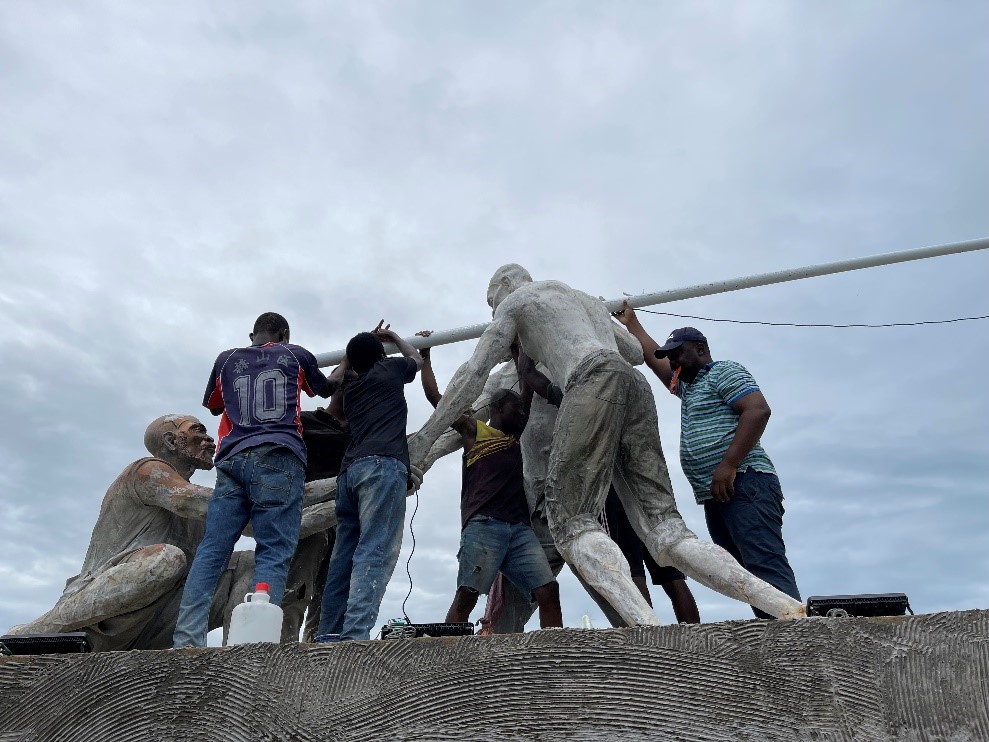
Figure 8: Theophilus Kwesi Mensah working with his students (Courtesy the artist)
Despite his inclination to EATP, he does not sway from being a traditionalist in the sense that he continues to enjoy working from the human figure. His preference to the human figure in his statues in Effutu Dream was informed by the truism that life changes and the language of sculpture evolves. So, it does not really matter if he is being repetitious with a subject that has preoccupied sculptors throughout history. Yet, as didactic symbols, he sought to make explicit what many sculptors make implicit in contemporary memorials in a classical sense with his figurative renditions.
Whilst the public may tend to be passive receptors of his statues in Effutu Dream, his students cannot afford to be indifferent. There are obvious educational imperatives they naturally cannot ignore. As far as they look and see the statues, there are predisposed to learn from them by asking questions. Reis (2010) citing Silva (1984) concerning public art claimed that even if we do not pay any attention to it, daily contact influences our attitude towards the conservation of artworks and our intellectual and sensory appropriation of them. What more do students need to get motivated in their studies aside having the opportunity to see the works of their lecturer installed all over the community? As artist academic, Theophilus Kwesi Mensah thrives to integrate his vast knowledge in the art into the practice of cultivating artistic design talent. His contribution to knowledge is application oriented. His statues in Effutu Dream make meaningful contributions to practical solutions that are at the core of art education. His students garner the nuances of what he says in the classroom when they see his statues in town.
Conclusion
Theophilus Kwesi Mensah’s ingenuity as a sculptor, draftsman and an academician are undeniable, so too is his energy and prolific creative output in the wider Effutu Dream Project. Within a trilogy of paradigms, he displays a profound representation of Winneba as a beautiful place to live and work. He does so by immortalizing four important collective memories of the town whilst using Fibre Reinforced Polymer, a material that stands the test of time and exudes a sense of eternalness. In the process, his students tapped into his creative sense both at his studio and on site.
Whilst Theophilus Kwesi Mensah’s artistic praxis is eclectic, what I have sketched is a heuristic effort to describe his monumental contribution in the Effutu Dream Project in his beloved Winneba where he lives and practice as artist academic. The few details I have carved may at times be minor, but they add up to have a larger impact to his contributions in the effort to redesign and develop Winneba.
References
- Akyeampong, O. A. (2019). Aboakyer: traditional festival in decline. Ghana Social Science Journal, 16(1), 97.
- Farman J (2015). Stories, spaces, and bodies: The production of embodied space through mobile media storytelling. Communication Research and Practice 1(2): 101–116.
- Mensah, T. K. & Abraham, E. K. (2022, June). The unity monument: A hope of the end to the political quagmire in simpa. Paper Presented at The Creative Arts Conference, University of Education, Winneba, Ghana
- Reis, R. (2010). Public art as an educational resource. International Journal of Education through Art, 6(1), 85-96.
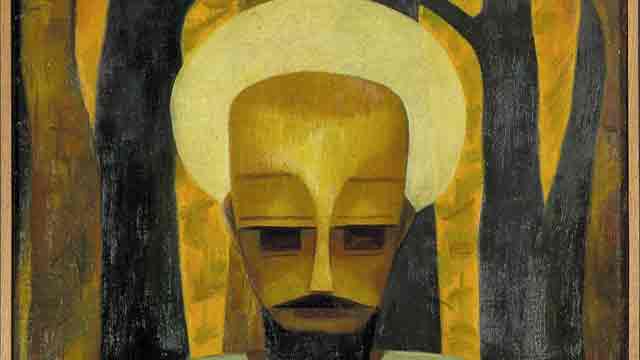
-
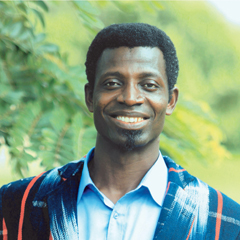 Osuanyi Quaicoo Essel
Osuanyi Quaicoo EsselThe seated human-like figure is centrally placed with the head occupying almost the centre of the entire composition while the hands rest gently on the laps. The head and the face of the human figure is rendered in planes and cubistic orientation, a style reminiscent in precolonial African wooden sculptures. Hands of the figure received similar cubistic treatment with less details as in realistic depiction. Interestingly, there is a deliberate subtle emphasis on the head size of the figure. In African sculptural renditions, the human head is considered as seat of wisdom and, therefore, presented bigger to defile the realistic canonic proportions and connote its Afrocentric symbolic essence. This concept of head re(presentation) is termed as African proportions (Amenuke et al, 1991).
To create a harmonious contrast of colour and shape, tints of yellow forms an arc-shaped design around the head. This treatment possibly suggests a halo effect characteristic of saintly figural paintings in Western art traditions. It also mimics a turbaned human figure. As an artist who hailed from a predominately Muslim community, this stylistic treatment, perhaps, pays tribute to his religious cultural background. The eyes are presented with dark brown rectangular dabs, with the forehead gently highlighted with bright yellows, a treatment that puts the human figure in a meditative mood and sanctimonious character. Though Uche Okeke presented the work in a portrait orientation, the skilful placement of the human figure, and the peculiar colouration of the head regions creates a triangular effect when imaginary diagonal lines are projected from the bottom corners of the composition to the halo-shaped found on the head. Similarly, the haloed effect on the head and the elongated pharaonic beard creates an imaginary inverted triangle resonating a visual excitement.
Symbolically, yellow depicts riches and royalty in African colour scheme. With this schematic colouration, Okeke gave a clue to the kingly characteristics of the human figure. The white looking garment of the figure also adds to the sanctimonious conjecture of the figure as in African colour symbolism. The artist’s use of luminous chromatic reflection of the tint of yellow and dark shades helped in achieving the sense of depth in the garment. Complementing the overall kingly posture of the human figure is its elongated pharaonic beard and bodily language as found in sculptures of ancient Egyptian kings.
Okeke skilfully deceived viewers of this composition into believing that it is symmetrical per its stylistic tendency, yet an intense observation reveals a psychedelic mutation of the placement of the fingers, padding of the background with tree-shaped figures in rich application of tints and shades of black, yellow and brown to create contrast of colours and shapes. Placement of the trees in colour variations and the sprouting of the branches forms a psychedelic cross and contribute to breaking monotony. The patchy effects of the intense yellow forming the negative spaces adds to creating a perceptual believability that the human figure wears a contemplative mood per the facial looks. There seem to be gentle highlights of the yellow from the shoulders to the halo-shaped object.
Per the compositional portrayal, Okeke showed a kingly and majestic posture of, perhaps, the Christian religious icon in Africanised bodily posture and cultural praxis. This compositional contextualisation feeds into his personal manifesto that he did not subscribe to borrowing Western artistic accent hook, line and sinker. Neither was he comfortable with resorting his Nigerian indigenous artistic traditions without modification. He emphasised in his manifesto that it is ‘… futile copying our old art heritages, for they stand for our old order. Culture lives by change. Today's social problems are different from yesterday's, and we shall be doing grave disservice to Africa and mankind by living in our fathers' achievements’ (Okeke, n.d). For that reason, he appropriated western artistic accents and fused them with Afrocentric artistic concepts and perspectives to achieve a hybrid artistic language which is not purely African nor Western, but yet circumvent the boundaries of artistic cultural traditions in general. The fusion lends itself to exploring the familiar and the unfamiliar to create a renewed breed of art. He called this effect ‘natural synthesis’. Emanating from Nigerian non-conformist artist group named Zaria Rebels, Okeke sought to reinterpret the Western artistic style of realistic depiction, perspectival detailing, accurate proportions and tonal gradation he was exposed to by the Eurocentric-inspired faculty in the so-called formal education setup in art in Ahmadu Bello University, Zaria. As part of the pioneering post-independence artists in Nigeria, Uche Okeke was experimenting for a renewed artistic accent for his creations through the assessment of his Nigerian cultural values and the new artistic training he had been exposed to in order to arrive at the boundary of these two traditions.
Using this painting in teaching and learning in the context of collective memory could inspire relevant competencies in the learners. Gathering inspiration from the artistic pursuit of Okeke, learners could fuse multiple artistic traditions of the artworld to arrive at their individualised artistic accents. Teachers could engage learners in this manner by asking them to borrow and appropriate a foreign artistic style and fuse it with their nationalistic art making techniques to develop a new breed of art or concept. Teachers could also discuss with learners about the fact that gathering artistic inspiration is multicultural with no boundaries. Furnishing learners with links to the biographical account of the artist for them to understand his cultural nuances remains key in the process. It would also be beneficial to guide learners to explore with their own interpretation of the artwork (figure 1). Teachers could also provide learners with printed copy of the painting and ask them to redraw this religious-centred figure to suit their own religious understanding and cultures. This approach addresses the competencies of critical thinking and problem solving; creativity and innovation; cultural identity and global citizenship; and personal development.
References- Amenuke, S. K., Dogbe, B. K., Asare, S. K., Ayiku, F. D. & Bafoe, A. General knowledge in Art for
- senior secondary schools. Evans Brothers Limited.
- Okeke, U. (n.d.). Natural synthesis. final okeke natural synthesis manifesto 1960.doc (live.com)
 Mahmoud Malik Saako
Mahmoud Malik SaakoThe image is presented in a form of a male figure in a seated position with long beard, white turban, white robe, long sleeves and a probably waist band. The painting represents fairly the complexion of a male, black bearded and wearing a face mask, with hands resting on the laps possibly in a meditation mood. The Background is probably a wooded environment or garden with tall trees of two colours (black and yellow). The figure seated probably on a staircase or an amphitheater. The sun ray penetrating through the tree created shaded patches reflected on the image.
An Islamic perspective: I base my interpretation of the painting on Islamic perspective as one of the foreign region that had an early contact in northern Nigeria as early as 15th century long before Christianity and eventual colonization of Nigeria by European power (the British) and its possible independence in the 1960. The emir is mostly male usually dressed with a white robe, long sleeves and a white turban tied around his head to signify his authority. The painting perhaps represents an Emir of the Zaria state at that time sitting in a garden relaxing.
Using an African mask: The use of an African mask to represent the figure was done deliberately or perhaps to avoid revolution from the Muslim community of disrespecting their leader which the author was much familiar in this volatile society especially, the intolerance nature between Muslims and Christians at this era in the Zaria state. The mask as a tradition signature that ubiquitous across many cultures that can be used to represent the religious discourses by appropriating and manipulating them to produce art forms of the past to produce a mythology for the present.
Lessons
- The image portrays the power of the emir in the Zaria state with a possibly palace and vineyard or gardens where he retires to relax. The seat or staircase/amphitheatre is constructed within the park for relaxation.
- It also shows the importance of trees because the natural air and shade provided. It reflects the symbiotic relationship between man and the natural environment or biosphere.
- The long beard is a reflection of the age of the figure, combined with the white turban tied around the head which is a symbol of power and authority of the emir within the context of an Islamic state. Again, the white long robe coupled with black beard and the white turban is a reflection of the dress code of the emir within the states dominated by Muslims. The waist band (blue sea colour) is used to tie the robe for easy movement.
- The facial representation of the figure doesn’t conform with normal human head based on the eyes, nose and mouth. It is probably a mask of an Egyptian pharaoh to imbibe the spirit of the Pharaoh as a kingly figure that wielded much power. A story that is synonymous in both Islam and Christian doctrines except the West Africa Indigenous Religions that do ascribe this myth. The use of the mask also simmer the tension of using identifiable imagery that would have rise tension in this probably consecutive Muslim state. The use of masks within the Africa context show the spiritual powers embedded in them that the wearer or user is mostly possessed and transfigured a situation that can only be explained by adherences to that particular belief system.
- The black and yellow tall trees depict the diverse nature of the ecosystem and the symbiotic relationship mostly exhibited in the environment. This shows the complex nature of the human society with diverse cultural and different colours complexion that need a person with wisdom and patience to rule, like the emir who assumes the position of an Egyptian Pharaoh.
- Uche Okeke, was a revolutionary artist who tried to break away from normal art presentation handed to Africa by the white colonial powers. This diversion was to Africanize the art industry in West Africa and Africa at large. This where Okeke decided to use the Pharaoh mask from Egypt that was considered even among Europeans of the cradle of human civilization in the world.
 Ernst Wagner
Ernst WagnerI argue in the following text from a special position. Firstly, I was present in Bayreuth on 26.4.2022 when the two co-authors, Osuanyi Quaicoo Essel and Mahmoud Malik Saako, discussed the painting in a larger circle. The representatives of the Iwalewa House clearly expressed their doubts about the (traditional) title of the painting "Christ".[1] Perhaps this brought the question of who was depicted in the painting, Christ or another person, to the fore. This question also shapes my discussion of the painting presented here. It became the guiding theme behind which other topics disappeared, such as the question of the painting's function (what was it created for?), its biography (how did it come to Bayreuth?) the role of oil painting (is it a European import), the context of the debates on modern art during the independence movements in Africa (does the painting belong to a global modernism after the Second World War or does it mark a Nigerian path? [2]) - to name just a few.
My own interpretation is therefore less an independent approach to the work than a response to the positions presented with the intention of building bridges between the approaches by introducing a meta-level. Whether this is convincing, whether the bridge is sustainable, is for the reader to decide. But more on that below.
Traps through aesthetic stereotypes that lead to false classifications / interpretations
And a second preliminary remark: I didn't like this picture at the beginning. It reminded me too much of the religious pictures of the 1950/60s of my childhood. They were popular for death pictures back then: A mixture of a bit of Pre-Raphaelite and icon-inspired imagery, soaked in the formal world of a moderate and esoterically inclined modernism (Franz Marc). The intention was easy to see through: To somehow keep alive that which, in my view, was no longer contemporary at all, and to do so through a bland, unconvincing and even less convincing adaptation (a kind of "modern facing"). This is also why, when I saw the picture hanging at the entrance to the Iwalewa House from the corner of my eye, I immediately saw a Christ.
Iconography - inclusion of other perspectives

Detail
In the discussion mentioned at the beginning, the intervention of Mahmoud Malik Saako was really surprising for me - against the background of this perception, which was shaped by my own stereotypes. The halo (which I saw - see detail) was a turban (which Malik saw). But I could not counter his view. There was no argument for the interpretation as a halo. This is also true now when I read Malik's text (like Osuanyi's). So I first had to recognise my stereotype in perception, which had lured me onto a perhaps (?) wrong track, I had to get rid of this, unlearn something, in order to be able to open up to the other perspective.
Why I - retrospectively - still speak of "perhaps wrong", a research on Okeke's work has confirmed as meaningful. After all, there are obviously works in his oeuvre that iconographically quite certainly represent Christ or St Mary, as an internet search reveals (see fig. below). The auction house Bonhams (Abb.1) states - even if for 1963, two years after our work: "in 1963 ... the Passion of Christ was a recurring theme for the artist. He had produced the stained-glass designs of the Fourteen Stations of the Cross in Munich earlier in the year." (www.bonhams.com/auctions/25800/lot/28 accessed 14 Sept 2024)
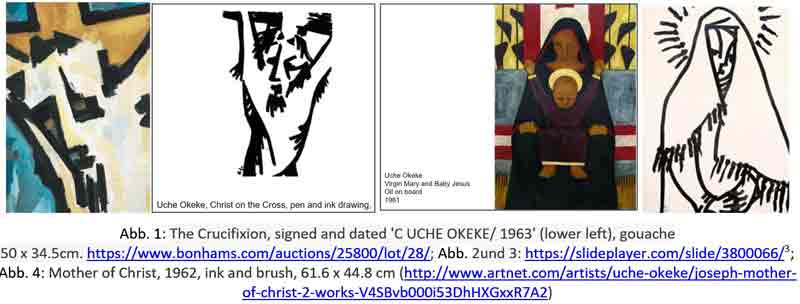
Christian motifs in Uche Okeke's Ouevre between 1962 and 1963 found by the author on the internet (May 22, 2022)
Perhaps this is why the discussion about whether Christ or a Muslim is depicted makes me feel uneasy. In my mind, the question is connected with the attributions or depreciations: To whom / which faith does the work of art belong? Does it belong to the Christians, the Muslims, or the traditional believers in northern Nigeria, if, as Philipp Schramm or Mahmoud Malik Saako suggest, one also discovers a traditional wooden mask?
New approach and reflection on its anchoring
Hence my attempt to think of the painting in a different way, i.e. not from the artist's point of view and what he or she wanted to represent. In doing so, it is clear to me that I am taking a specifically Western approach to a modernist work (where I now place Okeke's painting) with my new approach. This approach is based on the loss of a binding iconography and a fundamental openness / never-quite-unambiguity of 'autonomous' works of art for a Western-oriented, middle-class audience. In addition, my proposal for interpretation is based on a specific position in the interpretation of images, from production theory to reception theory (in the context of constructivist epistemology). The loss of a binding iconography is accompanied by a greater significance of form (which is now itself charged with content to compensate for the loss). In a next step, I therefore try to examine the image - beyond a positioning in the question of whether it is an "Islamic" or a "Christian image" or a "traditional image" - form-analytically.
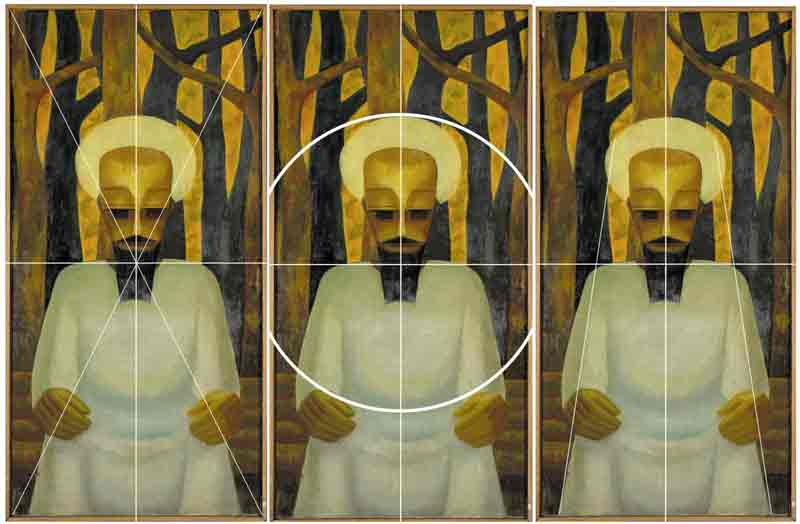
Analytical composition with auxiliary lines. (c) the author
Form analysis
The dominant, almost penetrating axial symmetry in a very high longitudinal format speaks of high order; the pyramidal structure of the figure also speaks of calm and stability, indeed of sublimity and dignity, of quiet, immovable power. And this dignity is not fed by external insignia or theatrical staging, but by a calm that radiates from within. It is a picture in front of which one can become calm if one trusts the order as a viewer.
The striking human figure contributes to this effect. Although clearly figurative, it does not represent - to the degree of abstraction - a concrete portrait or a human being that can be grasped by the senses. This is most obvious in the geometricised eye area, which is shaded in various dark zones. This makes the gaze ambiguous: is the figure looking at the viewer, is it looking forward, is it looking inwards (contemplatively, with closed eyes)? Together with the geometric rhythm of the picture's surface (the symmetry, but of course above all the parallels that can denote eyelid, tear sac, eyebrow - or not) support the depiction of a human being in an abstracted ideal form that remains open to itself, as in a mask. The latter is also characterised by the fact that the viewer immediately sees what has been made, what has been assembled, as in the case of the moustache, for example.
The figure sits quite classically in front of a middle and a background: at the bottom the zone (again - between two-dimensional and spatial effect - strongly abstracted) is divided into horizontal stripes, which become slightly narrower towards the top. They again suggest something familiar (a wooden bench), but this remains ambiguous. In the upper zones, the tree trunks (without leaves) form the liveliest, least symmetrical, most restless element in the painting, even if the alternation of light and dark again shows the abstracting hand of the artist.
With this spatial layering in clear zones (background, trees, seat, figure), but also the geometric reduction of the forms, the picture looks like a carved relief. The colouring also fits in with this, for example when the "sky" behind the trees as well as the lighter trees have the same colouring as the face, while the beard, eyes and the dark trees form a second colour zone. The lightest zones are formed by the robe and the shape around the head. Despite the large spectrum in the area of light-dark contrast, the picture does not appear colourful, rather like a natural wood relief. An effect that is again particularly evident in one detail: the way the hands are shaped is reminiscent of hands carved out of a piece of wood.
This character is supported by the way Okeke uses oil painting. He clearly outlines the contours of the surfaces. The objects are each assigned a main colour, applied impasto with broad brushstrokes. The modelling creates plasticity, lightly set with internal structures enliven the colour surfaces.
Conclusion
The degree of abstraction, the modelling construction of the figurative out of a colourfulness, the strict symmetry of the composition, the tectonics of the pictorial space unfold a tableau that nevertheless - and this is now decisive - creates zones of ambiguity in the figurative. The viewer must fill these with his or her own ideas. The viewer's gaze is directed towards the picture, but the eyes do not look back. In this respect, the painting is suitable for contemplation, meditation, spiritual experience. In seeing the painting, one's own can come to rest. And so the distinction between the Christian halo, the Muslim turban and the ritual mask can also come to rest in the contemplation of the painting.
This consideration is based on an 'ideal viewer' of the work, i.e. it is reception-aesthetically oriented. If one finally turns it once again to production aesthetics, one could interpret the work as an attempt by the artist in which it experimentally unfolds what a spirituality beyond the distinction traditional - Christian - Muslim could look like.
Footnotes
[1] Philipp Schramm's position becomes clear in his text (https://www.bayfink.uni-bayreuth.de/de/Sommerausstellung-2021_-Not-yet/audio-not-yet---welcome/index.html).
[2] Perrin Lathrop, "Uche Okeke," in Smarthistory, August 9, 2015, accessed May 21, 2022, https://smarthistory.org/uche-okeke/.
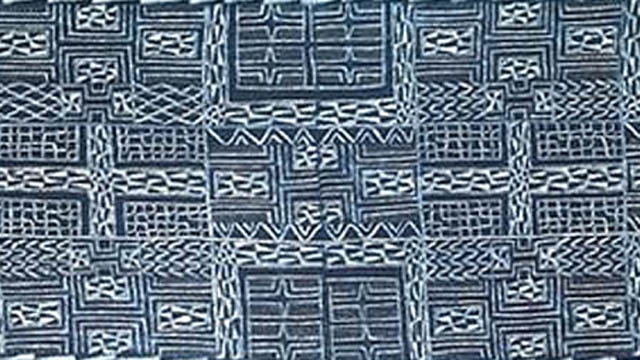
-
 Osuanyi Quaicoo Essel
Osuanyi Quaicoo EsselIn my encounter with the exhibits of the Permanent Exhibition of the African Collection in the Museum Fünf Kontinente, one of the African textile collections that striked me from a distance, and possess high tendency of inviting viewers attention is the ndop fabric. I moved closer to the exhibit to observe its uniqueness in terms of its structural and surface characteristics. From my curious observation, I realised that the ndop fabric has simple geometrical linearity and patterns, yet, spiced with complex dynamism of the arrangements of these patterns that evoke the artistic principles of variety, harmony and technical constrast. This treatment breaks monotony and creates multi-sectional visual interest in the fabric design despite its monochromatic colouration. These observable details, characteristic of authentic African fabric, pulled my visual curiosity to the exhibit. Indeed, it is an epitome of authentic African fabric.
Africans had long developed unique structural and surface decorative techniques for creating fabrics. Structural decorative techniques concern itself with the basic forming or construction of the fabric. Weaving, bonding, netting, lacing and felting include the structural decorative technique. Surface decorative techniques deal with the colourations and other embellishments to improve the surface quality or appearance of the fabric. Examples are dyeing, painting, printing, embroidery and applique. The ndop fabric was struturally woven with handspun cotton yarns in plain weave format in the form of stripes. The stripes were joined together with the aid of a needle to form a wide sheet of fabric after which the sheet of fabric was subjected to resist dyeing to create attractive patterns. In resist dyeing, portion of the fabric are prevented from dye absorption. Techniques used in resisting dye penetration include tying, tritiking (sewing), waxing, folding, twisting and coiling, and or a combination of these techniques. In the case of the ndop fabric, tritiking technique was used where raffia fibre cordage was used to stitch the desired patterns such that it could resist dye penetration after which the fabric was immersed into indigo dye solution locally extracted from plants. After the required time for dyeing, the fabric was removed from the dyebath, rinsed, dried and unstitched to reveal the patterns.
The skilful use of regular geometry in seemingly irregular and asymmetric arrangement style complemented by the handmade rendition, the technical finesse in stitching to create the intricate pattern and the entire arrangement of the geometrical shapes in simple repetitive format create high visual appeal of the surface quality of the fabric. Per its visuality, one may see it as a printed fabric, yet, it was created using resist dyeing effect. The slight unevenness in the dye absorption resulting in patchy shades of the indigo at certain portions of the fabric adds to its creative uniqueness. The varying border designs of the fabric bond well in creating a sense of unity in the entire composition.

Ndop fabric. Detail. (© Museum Fünf Kontinente / Photo Ernst Wagner)
Besides the observable trenchant characteristics of the fabric, it also has social and cultural contexts in the Bamum society. The ndop is more than just a fabric in terms of its usage and communicative significance. The fabric is symbolically linked to death, afterlife, and powerful spirits connected to life. Consequently, it is worn during funerals and traditional religious rites. Apart from this, it is worn for its aesthetical reasons.
The ndop fabric falls within the repertoire of indigenous and authentic African fabric creation and decoration culture, which include the Korhogo Cloth (Ivory Coast), Adire (Nigeria), Bogolanfini (‘mud cloth’ from Mali), Kente and Adinkra (Ghana), Smock or fugu (Ghana) and Dogon Cloth. Common to these fabric printing technology of Africa is that the fabrics used are usually cotton, with ocassional usage of silk or velvet. In the case of Ghana, Adinkra printing is made with cutout stamps which are dipped into dyes and transferred on the fabric to register the designs while in Kente and fugu, the hand spun cotton yarns are dyed in different colours and used for weaving. The ndop is dyed. Availble records indicate that indigenous dyeing of fabrics in Ghana, in many instances, were done by uniform application of dyes to the entire fabric. This means that fabrics were immersed without resisting some portions. Kobene (brick red) and Birisi (blue-black) fabrics of the Asante people of Ghana are examples.
As a textiles and fashion educator and artist, I guide learners to examine the hand-made indigenous fabric decorative characteristics of Africa including the ndop fabric in order for them to understand and apply them in their fabric design. In this sense it inspires my fabric designs and that of my students. I also empower them through my teaching with historical knowledge about the contributions of Africa to the global textiles design culture. This is because the unique patterns and characteristics found in the repertoire of indigenous and authentic African fabric technological culture have been imitated with computer effects and printed by some European and Asiatic fabric brands, mostly sold in Central and West Africa. These foreign brands have been deceptively labelled with an umbrella term, African prints, to lure and deceive buyers. The ndop fabric has valuable educational relevance in teaching and learning and historical understanding of African fabric making technology in this context.
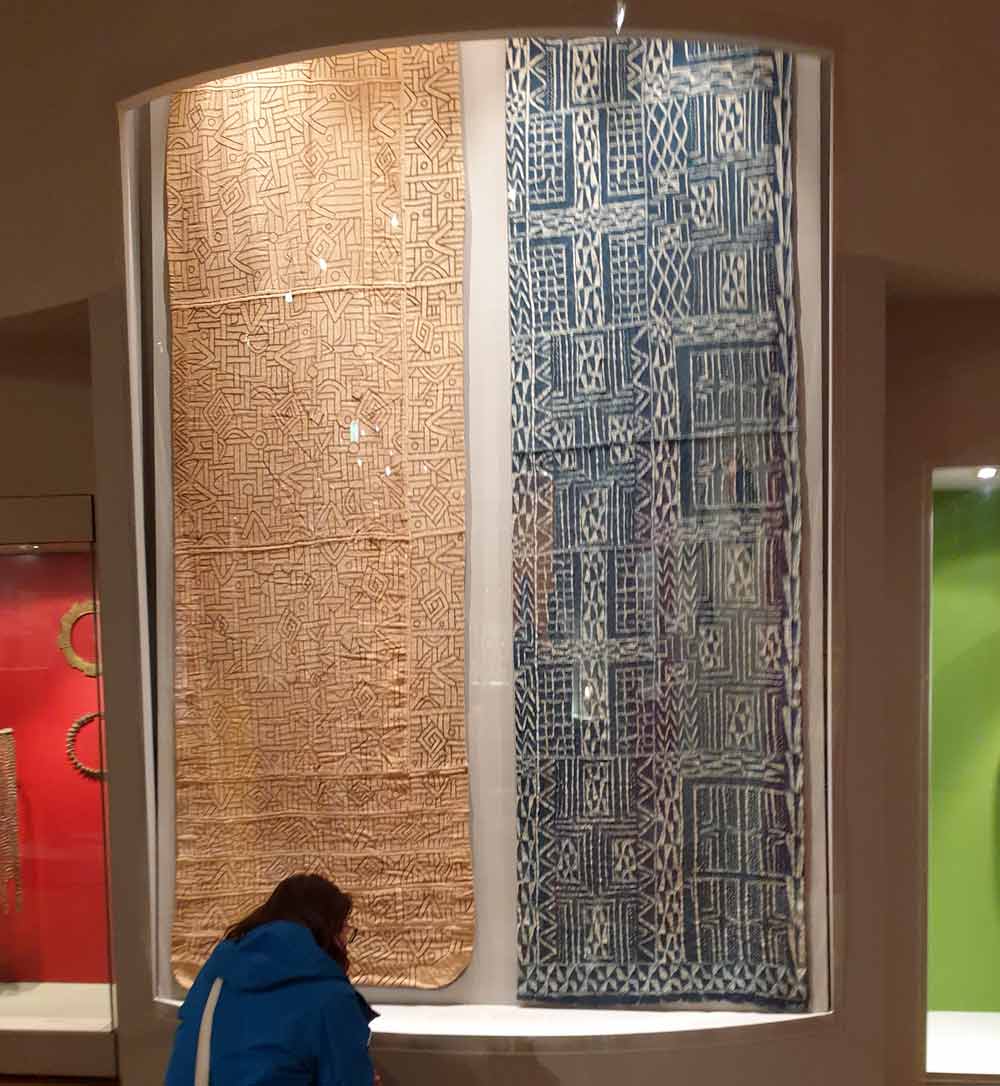
Presentation at the museum 2021 (Photo Ernst Wagner)
This article is part of a gallery: Perspectives from Ghana on Museum Objects in Germany. Published in January 2021
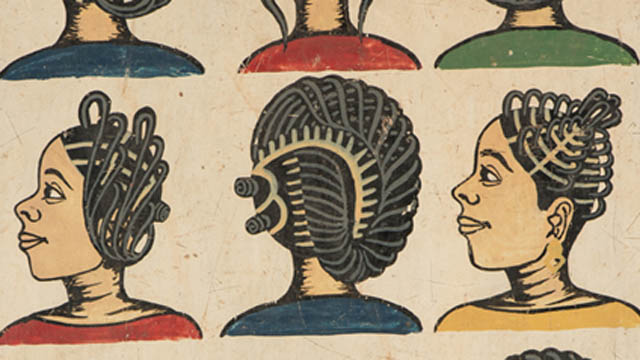
-
 Osuanyi Quaicoo Essel
Osuanyi Quaicoo EsselCatching a glimpse of the feminine hairstyles (re)presentation in rows on a single support, brings to memory the barber salon promotional campaign artworks that served as visual displays to invite potential customers in parts of Africa in the past. Artists in the community were commissioned to create picturesque signages that display plethora of Afrocentric hairstyles on wooden boards and placed in front of hair salons or vantage points to attract potential clients. The artworks served as form of advertisements to the salon operators. Some itinerant hairstylists moved around with these signages in search of customers. The painted images have been replaced with printed catalogue of pictured hairstyles printed on large sheet of papers and flexy materials which are displayed in and outside salons in the communities. The picturesque hairstyles signage presented in this exhibition reminisces the artistic practice of creating these portraits as form of hair salon advertisement in Togo, Ghana, Nigeria and other West African countries.
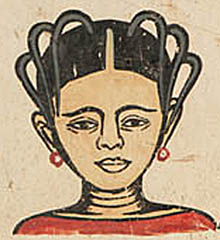
Cutout from anonymous artist, second half of the 20th century, plywood, oilpaint, Image: Osuanyi Quaicoo Essel.
Uniformly arranged on a support, the artist presents fifteen Afrocentric feminine flashy plaited coiffures in portrait orientation. Of the fifteen hairstyles, one occupies the epicentral position of the entire composition in frontality of pose, depicting her full facial details in simple flat tone of brownish colour with the hair stylization rendered in black. Her rigged neck, pronounced eyebrow and bejeweled ears depicts her feminine characteristics. In Togolese culture, wearing of earring is a preserve of females as in the case of Ghana and some West African countries. The artist’s treatment of this centrally placed figure gives hint of Togolese feminine beauty standards. Four of the hairstyles are shown in side view, facing the left. Similar to these four figures in profile are the type-form head, rigged neck details and varying earrings. The rigged neck features found on these four figures also appear on the centrally placed figure in the composition. With this treatment, the artist makes visual notation of feminine beauty culture standards that characterised some West African countries. Rigged neck feature is considered as a marker of beauty ideal, and commonly depicted in West African feminine sculptures. For example, Akuaba (wooden doll, predominantly used as fertility figure), of Ghana is often armoured with rigged neck characteristics. Understanding the beauty culture ideals of Africa depicted in this simple but interesting hairstyles composition offers viewers of African art a better understanding of the art.
To reveal a great deal of the level of sophistication of the hair stylizations, the artist showed ten of the figures in back view posture, three each atop and down in horizontal placement, while four are arranged in a kite-shaped arrangement in the middle portions of the painting. The artist generates visual interest with the arrangement of the figures to create a sense of movement, variety and rhythm. For example, in the depiction of the clothing of the figures, shades of reds were used in a serpentine orderliness that forces the eyes to traverse gracefully upon a gaze from the topmost middle part to the down and vice versa. Similar colour treatment is achieved with shades of blue from the top left, moving in diagonal direction to far right of the middle portion of the painting, and orchestrating another diagonal turn towards the down left part. One striking feature that bedews the ten hairstyles in back view posture, is the skillful use of the negative and positive spatial relations that creates visual curiosity for deeper gaze of the hairstyles. With the exception of the blue-shirted figure on the last row of the composition, the remaining blue-shirted figures wear trumpet-shaped hairstyles with multi-sectional visual interests.
All the hairstyles represented by the artist are a reflection of the Afrocentric standardized beauty ideologies and practices inherent in the social environment of practice. These hairstyles make use of no hair extensions and or wigs; and are also practised in Ghana and other neighbouring countries. Females usually cared for their hair to grow long and plait it with black twine to form long narrow stripes which are then arranged in a particular manner by way of styling. Based on the society that wear them, the hairstyles may be given names and have symbolic meanings. The hairstyles portrayed are usually worn by the youthful and middle-aged females.
Colonialists’ invasion, slavery, Western religion, racial discrimination, amongst others, contributed to Black hair stereotyping which has caused some Black women to resort to hair beauty ideals of the colonialists. Historically, the discrimination resulted in some Black women who found themselves in foreign lands, hiding their hair by using coverings, especially, in public places. Some Black women use artificial chemicals to straighten their hairs to imitate the beauty ideals of the colonialists. Despite the counter-resistance to the stereotyping of Afrocentric hairstyling through civil right movements and visual (re)presentation by its practitioners and artists, many African women now wear extensions and wigs, a trend that raises the question of identity crisis and politics. The work of the artist in this context sheds light on the purely Afrocentric hairstyling culture of Togo and its neighbouring countries, and makes unapologetic statement of turning away from the colonial past.
The work brings into focus the need for fashion art educator and artists to join hands in contributing to institutional restructuring of teaching and learning of African fashion history including standardised beauty ideologies and ideals for reclamation of the past, and impenitent practice of Afrocentric beauty culture. Towards this end, teaching and learning should be focalised on the African cultural reorientation, concept of sankofaism (return to fetch the goodies of the past) and respect for one another irrespective of geography, skin colour, hair type or physique. Learners must be taught to build positive self-esteem and love for their culture, and demonstrate love for individual differences.
This article is part of a gallery: Perspectives from Ghana on Museum Objects in Germany
published January 2021
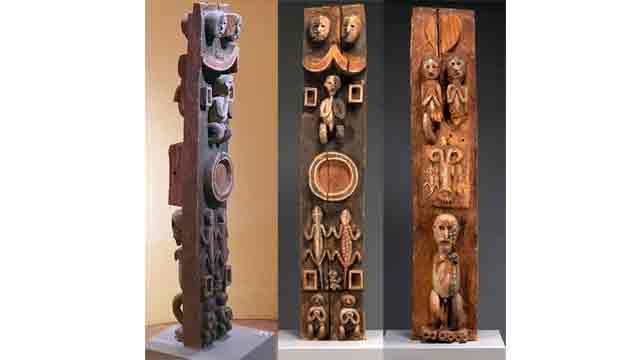
-
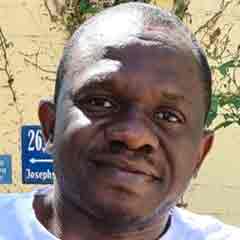 ELVIS NKOME NGOME
ELVIS NKOME NGOMEThe selection of informants was randomly done as we were only interested in identifying the most relevant resource persons within the research areas like members of defunct and existing regulatory societies, traditional rulers, herbalists, and other village notables with measurable experience in material culture and their symbolisms which is the interest of the author in this paper. The paper consists of three parts: an introduction, the background issues or the historical antecedence, and the core, which deals with interpretation of the motifs on the objects, significance and ends with a summary.
African arts and cultures predates the colonial and missionary encounter in Africa. Some of the works provide useful information about indigenous craft industries such as pottery, carvings, iron metallurgy, weaving and much more. This article made use of works of earlier scholars who discussed aspects linked to the current paper. I also exploited some archival records, for example, file No. E.P.4929, entitled “Assessment Report [on] Bali, Bamenda Division- Cameroon Province (1925) by W.E.Hunt, District Officer, National Archives Buea, NAB. The works are framed into three broad thematic: objects made out of clay; objects made out of iron, and those produced out of wood and forest fiber materials.
Wooden Carvings and Clay Objects
Traditionally, the Bamenda grass fields and the Western Grassland regions of Cameroon are known for their mastery in the production and commercialization of various art works. In this region, craftsmanship is believed to be handed down from one generation to the next; from father to son. Grassland traditional architecture, objects, and symbols were unique from the point of view of their aesthetics, decorations and uses. In the 19th Century, a German Military Officer, Hans Glauning’s Official Report of 1906 on the Pre-colonial Nso (Banso) described grasslands houses in the following words:
The Banso houses, some 5-6 meters high to the roof, are [were] roomy and neatly built in Grassland style. The floors are paved with small pebbles. Each village has at least one meeting and drinking hall with carved door posts. Both frontages of the meeting house in Kumba were hung with about 900 skulls of Bamum and Nsungle warriors…[1]
The above extract clearly describes the pre-existing cultural and social institutions the European came across in the Bamenda grassland in early phase of the 19th century. The people were talented carvers, weavers and painters. The most remarkable designs were and are still royal stools, bangles, and door / window frames on houses that helped to show various layers or classes in society. On the door or window frames for example, were carefully carved motifs of animals and other selected creatures. The motifs were interpreted and symbolized cultural and political differenceswhich the society was aptly stratified.
According to Knopfli (1995a, 2000b) the carved posts were sometimes awards from the Fon, Kwifo as gifts to some notables, cult members, or other great men. These sculptures on wooden frames sometimes depicted great societal achievements of fons and great men and women in society. Also, in royal circles, such sculptures bore symbolic representations of warriors, heroes, and royal animals such as buffalo, lion, python, elephant and leopard appeared conspicuously carved on the chosen object. Other creatures like lizards, tortoise, and scorpions were widely engraved on Grass field arts. Besides, inanimate objects like iron gongs and cowries were represented on objects.
The zoomorphic and anthropomorphic Ethno-historical Dimensions of Cameroonian Carvings
To better appreciate the origins and meaning of some of the animal motifs on artistic objects, it would be important to understand the cultural and philosophical dynamics of some of the zoomorphic motifs on the objects and what they represent. There are different animals reproduced in aesthetic designs by the carvers like lion, scorpions, tigers, toads, various species of lizards and a host of other non-living things. However, for the purpose of this paper, we shall focus more on the lizards depicted on the wooden board (the ‘Blue Rider Post’). As far as lizards are concern, Hans Knopfli (1990), studied various kinds of lizards which were/are common in the Western Grasslands of Cameroon. The stylistic motif of lizard is one of the most common designs in wood sculpture in the region, but also in many forest areas of Cameroon such as in Kribi in the South Region, amongst the Ejagham group in Manyu and Meme Divisions in the South-West Region of Cameroon. Generally, lizard motifs, or appear on various works of arts such as royal stools, masks, doorframes, drums, clay pots, title cups, and on embroidered robes and caps.[2]
However, the actual meaning of the lizard symbol is not quite clear. Knopfli noted that lizards are treated with maximum respect in the grassland. The belief about lizards include the idea that twins, chiefs and ancestors can transform themselves into lizards and that lizards have the spiritual ability to drive away witches. These however, does not close the page on their relevance in the cultural settings of different communities. In Africa, different groups perceive lizards differently according to their customs and traditions which have of course redefined their outlook as a people. There are three main types of lizards common to the grassland groups: the rainbow lizard (known in Bafut as kwifongu).[3] Another type of lizard is called the majuku lizard in Bafut language. This lizard is used by witch doctors to send and direct lightning in cases of theft, adultery, land stealing etc. Apart from the majuku, there is also the kukub (Mungaka language) lizard. This is a smooth skinned lizard with a long tail and it is very swift running lizard.
In Mungaka language it is called kukub, in Bafut language it is called akongse and in the Babanki language it is called fekeke, while Bakossi called it ebote-ngule. Worthy to note is the fact that most of the grassland sculptures carried this and other kinds of lizard motifs on door and window frames as well as traditional stools. Such insignia symbolized authority and deity, and life (Knopfli, 1990:58) In recognition of the above notion, one is tempted to argue alongside Knopfli that lizards therefore symbolizes life. He further states that any design of two or three rows of lizards round a stool with interlocking fore and back legs expresses the fullness of life.
Interpretation of the Motifs on the ‘Blue Rider Post’: New Perspectives
The information that follows herein is a fair, reliable and verifiable opinions of our informants who after careful examination of the photographed images gave their interpretations of the motifs on the ‘Blue Rider Post’ in its entirety. It is important to point out that the motifs are zoomorphic (animal), anthropomorphic (human-made) and inanimate gestures in the form of dots and circular/square indications.
The object has two sides which are embellished with similar motifs. The motifs include: dark patches, white dots, red marks, two human-like heads at the top, lizards, squared shape, circular shape in the middle of the object, and at the bottom, two human figures or deities. It is important to look closely at the object in order to have a clear interpretation of its motifs. According to recently collected data, the various marks like red, white and black confer or indicate various meanings according to the customs of the resource persons and sampled communities in Anglophone Cameroon. In this connection, the white colours stands for purification, membership, fertility, peace, prosperity, life, and an ‘eye’ like in the liengu female society.
Similarly, informants in Buea hold that the red colour represents danger, defence, and blood of sacrificed animals, authority and bravery. While, the black colour on the other hand, also represent prestige, authority, danger, and power. All these colours are still used by members of some cult agencies and cultural dance associations in most parts of South-Western Cameroon and the Cameroon-Nigeria Cross River Region. The red colour was extracted from either clay or camwood, while the white dot came from certain milky plants in forest. Existing cultural associations in Meme, Manyu and Kupe Muanenguba make use of these colours. The use of these colours as painting or decorations by associations like the Monikem and Oroko dances depicts closer similarities of the embellished colours used by the originators of the so-called ‘Blaue Reiter Pfosten’.
The upper/top layer with heads represents ancestors who watched over or protected the chief or king on the throne. Lizards on the carved object too represents many aspects or dimensions of community life as messengers, bravery, fertility, protection, and courageousness. On the hand, the square ark and the circular parts depict various things. While the square ark symbolizes the village’s sacred house such as etana, njeb, mbwog, the circle on the contrary represents the village, environment or community. The environment or the village is governed by the king or chief, who derived his authority and spiritual wisdom from the environment which was guided by ancestors.
Lastly, at the bottom side of the object there is a human-like figure, which assumes the status of a village ‘god’ or deity. The two figures at the bottom of the other side are depicted to pay allegiance to their superior king or the hegemonic ruler and played the role of mediator between the spiritual (dead) and the living in society. This is what the two little human-like at the bottom represent. They also played the role of messengers, mediators, seers, defenders, source of fertility and councillors to the reigning kings.
In terms of name, the object was recognized by various informants in areas where the tradition of either its use or production was common like amongst the Bakundu, and Ejaghams of Anglophone – South-West Cameroon. As a spiritual object, some informants called it ndo’obe while others called it nsibiri. According to Ayuk Divine Ndifon and Ernest Effim Lahluh, the object was likely the cult object of the Epke society in Ejagham, and the carvings on its represent a cult writing called nsibiri which could only be read and interpreted by those initiated into the inner core of the secret agency. The nsibiri depiction is used by members of the Epke cult, who opined that the object was probably dismantled from its original structure in a violent context.
By situating the object within the forest regions of Cameroon especially amongst the Ngolo, Bakundu of Ndian and Meme Division, and also the fact that there is cultural legacies that identifies with certain features of the so-called Blaue Reiter Pfosten, convinces the researcher to claim this region and its constituent villages as the likely source communities of the object whose biodata lacks comprehensive information to reconstruct its origins and provenance in recent years in spite of its popularity in the global North than in the Global South where it came from.
Summary
The paper has attempted to deconstruct the so-called Blaue Reiter Pfosten by tracing its seemingly obscured origin, its possible source societies and the meanings attached to its assorted motifs and much more. Based on current data it seems probable that the object was a religious medium of one of the cult agencies or a ritual symbol of some cultural associations or cult that flourished in villages that straddle the Cameroon-Nigerian Cross-River Region, including Ejagham, and Ekoi ethnicities in Manyu and Ndian Divisions of Cameroon. Other possible source villages of origin include Ngolo, Ikiliwindi, Bombe-Bakundu and Ngolo-Bolo. One of the likely reasons for arguing in favour of this assertion is because the above named villages share the same traditional religious, political and cultural beliefs that made used of similar posts for their initiation, divination, protection and other important rituals. It is believed that such an imposing object with impressive characteristics and diverse colorations: red, white and black dots had other uses which only core members of the cult agencies could analyse. This is because the secrets of any cult are kept jealously by its members and non-members are not allowed to know its real meaning. This is another difficulty realized in deconstructing the object.
As earlier mentioned, the object depicts the life of a true traditional African society where there is an inseparable bond between the dead and the living on the one hand, the community leader and his courtiers and deities on the other. However, because of lack sufficient information about this object because failing memories our informants, it seems difficult to ascertain the exact period when the object was made. It is however, true in my humble view that the object was customarily used by the peoples of the originating villages prior to the arrival of European missionaries and German colonial authorities in Cameroon by 1884.
References
Chem-Langhee, Bongfen and Fanso, V.G., eds, “Nso and the Germans: The First Encounters in Contemporary Documents and in Oral Tradition”, 1996,
H, Knopfli. Sculpture and Symbolism. Limbe: Presbook Publication, 1998.
Ngitir,V.B. “Bamenda Grassfields royal collections and museums from ancient times to the beginning of the 21st century: The symbolisms and Conservation of Palace Art,” Yaoundé: thesis, Department of History, Yaoundé I, 2014.
Interviews
Name of Informants
Profession
Age
Date & Place
Language
Interviewer (s)
Ethnic Group
Prince Remigius L. Endeley*
Teaching/Museum manager
47 years old
27/07/2020, Buea.
English
Ngome Elvis N.
Bakweri (SW)
Dr.Venantius Ngwoh Kum
University Lecturer
55 years old
5/08/2020, Buea.
English
Ngome Elvis N.
Esu (Wum) – (SW)
Ekema M. Ahone
Teaching
65 years old
Tombel, 25/07/2020
English Language
Ngome Elvis N.
Bakossi (SW)
Michael Emeh
Retired state Agent
84 years old
17/07/2020, Ngob-Baseng, Tombel
English Language
Ngome Elvis N.
Bakossi (SW)
Prince Nzum’etoe
Researcher/Farming
45 years old
Bakweri-Town-Buea,17/07/2020
English Language
Ngome Elvis N.
Bakossi (SW)
Richard Tarkang
Retired State-Agent
64 years old
Kumba, 1/08/2020
English Lang.
J.B. Ebune
Banyang (Mamfe) –(SW)
Mosses Ebollo
Retired state-agent
84 years old
27/07/2020, at Kumba
English
Lang.
J.B. Ebune
Bakundu –Ibemi (SW)
Pa Esseme
Retired farmer
84 years old
Kumba, 13/07/2020
English Lang.
J.B.
Ebune
Kokobuma-Bafaw (SW)
Moka Williams M.
Farming
40 years old
06/07/2020, Wolikawo-Small Soppo, Buea
English Lang
Ngome Elvis N.
Bakweri (SW)
Prince Kombe David Monono*
Farming/security guard
46 years old
13 October, 2020, Great-Soppo-Buea
English Lang.
Ngome Elvis N.
Bakweri (SW)
Ikome Kingue
Traditional healer
70+ years old
Bonduma, Buea, October 28, 2020
English Lang.
Ngome Elvis N.
Bakweri (SW)
Mathias Nyoki
Retired soldier
55 years old
Great-Soppo, Buea, 2020
English Lang.
Ngome Elvis N.
Bakweri (SW)
Nteh Roland
Teaching
46 years old
28/09/2020, Limbe
English Lang.
Ngome Elvis N.
Bakossi (SW)
Joss Clinton
Security Guard
46 years old
Limbe, 13/09/2020
English Lang./Pidgin
Ngome Elvis N.
Menchum (NW)
Chief Ekumbe Thomson*
Traditional Ruler
74 years old
Bakweri-Town Buea, 16/10/2020
English Lang.
Ngome Elvis N.
Mbonge-Bakundu (SW)
Tita Oliver T.*
Teaching
54 years old
22/09/2020, Limbe
English Lang.
Ngome Elvis N.
Misaje-(Dongamantong) –NW.
Paul Mukete
Retired state-agent
80+
Great-Soppo-Buea, 23/10/2020
English Lang.
Ngome Elvis N.
Bakossi (SW)
Simon Buma*
Church Worker/PCC
61 years old
Great Soppo, 17/10/2020
English Lang.
Ngome Elvis N.
Bali-Nyonga
(NW)
Allen Maimbo B.
Building
58 years old
15/09/2020, Limbe
English Lang.
Ngome Elvis N.
Basum- (NW)
Footnotes
[1] “Nso and the Germans: The First Encounters in contemporary Documents and in Oral Tradition” in Chem-Langhee, Bongfen and V.G.Fanso (eds.), 1996, 123. Quoted in Ngitir (2013): 169. See the entrance to the second Courtyard of the Fon’s Palace, Bali-Nyonga in 1907.
[2] Knopfli (1990), 55.
[3] The word is a combination of the kwifon, the name of the much feared secret society and ngu fowl. Kwifongu then means ‘danger to fowls’.

-
 Amanda du Preez
Amanda du PreezThe first selfie selected is taken by a reporter Yuzrig Meyer who reported for the Bushradio blog and is taken in Cape Town with students congregating in the background. The second selected image is taken by Michelle Gumede for the student paper Wits Vuvuzela of a student of the University of Witwatersrand (Johannesburg) enrolling in January 2016, while the university campus is locked down by security guards and police officers after bloody clashes between students and police.
The two selfies should be differentiated as the first image is an actual selfie (image maker and taker are the same person) while the second is an image of a selfie-taker (Image maker differs from image taker). In the first image the direction boards towards CPUT CT (Cape Town University of Technology) campus, and the Damelin building (Private Tertiary Training Institution) in the background are clear indicators of its location. The selfie-taker is visible in the righthand side of the image forming a montage by merging his own image with that of the protestors in the background. The second selfie-taker is wearing a T-Shirt with the slogan #FeesMustFall while making a typical selfie ‘duckface’ with the security guards looking on in the background. She is provoking the security guards by asserting her presence as a protestor in their midst.The two images are selected to engage with the growing selfie scholarship also in the field of image studies. The selfie has predecessors in the rich tradition of artists painting portraits and self-portraits, and then democratized further with the invention of photography as a means of self-expression to include a broader audience and artistry. Until finally in the contemporary moment anyone with a smartphone can create a self-portrait or rather, take a selfie. The two images sampled here showcase the expressive and participatory possibilities of selfies as voicing dissent against the powers that be on the one hand, and on the other hand, showing solidarity with those uprising. As such they form part of a new visual activism that is created via online participation and images.
Interpretation(s):
The selfie is notorious for its insertion of the human subject into the digital sphere that appear ubiquitously on social media platforms. More than any other mediating technology the front-facing smartphone has enabled the human subject to create and capture images of the self as never before. The immediacy and the circulation of selfies are extraordinary.
Depictions of the self is however not a new venture within the history of images, in fact, any reflective surface has sufficed as a tool for creating self-images in the past. Most notably the mirror which shares an intimate relationship and history with self-portraiture and self-representation. The progenitor of the selfie can probably be found in Andy Warhol’s self-portraits taken in photo booths (circa 1964-1965). The selfie that became a substantial category on its own since 2012 and 2013 has elevated self-expression to a new level. The two selfies collected here fall within the insertion of agency within the image, as both photographers insert themselves and their subjects within political events. In the first selfie, the creator can only be seen in the bottom half of the image so that the world behind him becomes visible. In the second selfie, the photographer also puts the selfie-taker on display surrounded by an environment of contestation. The images state: look at me but even more importantly, look over my shoulder at the world behind me. I am a witness to these events, and by sharing this image with you, you are also now becoming complicit and a witness to the event. It is a calling forth of a visible agency.
The attempt of the artists to show his or her witnessing of an event – being there – is also not a new endeavour in the history of images. We are reminded of Jan van Eyck’s (1390-1441) signature and presence left in the small mirror in The Arnolfini Portrait (1434), and later Diego Velázquez’s (1599-1660) mocking presence in the company of royalty in Las Meninas (1656). In all these instances, the artists insert or interject themselves into the picture plane. In the case of Ernst Ludwig Kirchner’s (1880–1938) Self-Portrait as Soldier (1915) we see the artist inserting himself into the horrors of war, with an arm lost (although only imaginary), trying to work through the aftermaths of terror. Granted it is not the same interjection we see as in the case of the selfies but one may argue that something of that tradition of witnessing, making present, announcing an event is already born in these earlier examples from Western art history.
The selfies selected here as part of the #FeesMustFall events testify to being present to a historical event and also to being interpellated into the activities. Interpellation as used by the French Marxist philosopher, Louis Althusser shows the status of the individual as always already being a subject subjugated in terms of power and ideology. The selfie makes that power hegemony visible as the subject negotiates his or her status apropos the powerful and ideological hegemony. There is an awareness in the #FeesMustFall selfie that not only bears witness to the riotous event but also positions the self in a particular participatory and supportive position towards what is happening. As Yuzrig Meyer euphorically states about his participatory #FeesMustFall selfie: “I may not have been around in the apartheid era in freedom struggle as an active participator, but from my experience of today I (sic) may have a better understanding to what it was like to be in the atmosphere of passionate comrades and the feeling of camaraderie in the air.” It is both an act of uncovering how power works, by making power visible, especially in the second selfie, and showing solidarity with the riots by inserting the face of selfie-taker as a montage onto the events in the background, as in the case of the first selfie.
These two selfies could also be interpreted as decolonising images as they disrupt what can be considered to be colonizing powers and assert themselves as agents of what Nicholas Mirzoeff (2011) terms “the right to look” and moreover, asserting “the right to be seen”. These two images refuse to look the other way by pretending nothing is happening. Instead, they inject themselves into the event and confront us as viewers with their message.
Discussion of the interpretations:
If we accept the interpretation that these two selected examples of selfies create a new decolonized agency by inserting themselves as both witness and participant of the #FeesMustFall events, it can be suggested that selfies allow for an expansion to the gamut of the traditional self-portrait. The contribution or democratic expansion of the selfie to the history of self-portraiture can be identified in at least the following three categories, namely skills required, immediacy, and generating a broader reach expanding the self-portrait genre. These three categories are not exhaustive but add to the meanings attributed to the two #FeesMustFall selfies.
In the case of skills, one does not require much talent or particular artistic skill to take a selfie. Where the self-portrait traditionally required set skills in the medium utilized for creating the self-portrait, whether painting, sculpture, etching or photography, the artists had to master basic techniques. This is not the case for producing a selfie. One merely requires a front-facing smartphone and the willingness to share in order to create a selfie. In this respect the selfie can be interpreted as a democratizing tool.
Similarly, whereas the creation of a traditional self-portrait mostly implied time (duration) and space for the artwork to be executed and to be exhibited, the selfie can be immediately uploaded online and shared. The selfie also potentially has a far broader reach than the traditional self-portrait as it can be viewed by hundreds (conservatively estimated) of viewers immediately after being shared. The selfie thus further democratizes the self-portrait by being available instantly and anywhere. The selfie is not bounded by time or place and space, as is the traditional self-portrait – it crafts a tele-presence.
Although, like all images the selfie is a complex and multi-layered occurrence and therefore not all selfies produced can be considered as democratizing and destabilizing agents. What is however accurate for most selfies is that they expand the genre of self-portraiture in significant ways.
published November 2019
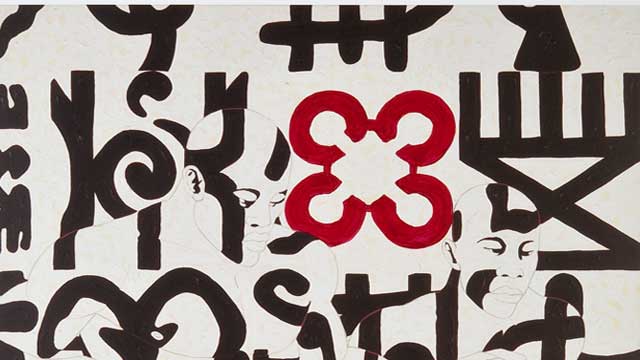
-
 Stefan Eisenhofer
Stefan EisenhoferOwusu-Ankomah received his basic training at Ghanatta College of Art in Accra. He was thirty years old when he moved to Bremen in Germany, where he still lives and works today. Characteristic of Owusu-Ankomah is his devotion to painting. For him the act of painting is a kind of highly concentrated ritual in which the medial properties of his body are used as memory store and energy-field generator, rather in the manner of an action artist.
In the course of his life, Owusu-Ankomah's artistic work has passed through several distinct phases. From an iconographic point of view, his early work is strongly influenced by mask and rock painting traditions from all over the African continent. But it was not long before human bodies, especially his own, became the dominant subject of his work. Naked bodies in his paintings, represented in idealized and naturalistic perfection, demonstrate a shameless and very close physicalness and often seem to radiate superhuman energy. Owusu-Ankomah plays here with the beauty of the human male body and with the harmony of flowing, clear lines. These works also evoke a range of ideas inspired by the human body – the body as instrument of the soul and instrument of communication, as a universal symbol and point of intersection between the physical and the metaphysical, and as a means by which the individual constructs himself, presents himself to others, and negotiates the conditions of his belonging to the world.
In his recent works up to 2008, the figures are covered with markings and signs. They originate from a variety of sources: the artist has combined traditional West African symbols, such as adinkra cloth signs, with symbols from China, America and Oceania, well-known popular logos, and symbols of his own invention. The figures melt into the backgound which consists of the same symbols, and thus become almost invisible.
With these symbols and human figures that compete for space on the canvas and for the attention of the viewer, Owusu-Ankomah has created some highly dynamic and truly pulsating compositions. The works also raise questions concerning self-determination and heteronomy, the tension between the wisdom of collective worldviews and individual creativity, and the personal potential of the individual. This is particularly striking in works showing the Sankofa bird. This mythical bird is well known in large parts of West Africa and embodies the concept of "flying forward while looking back". It symbolizes the idea that one should remember the past in order to shape one's life positively in the present and the future. With its name meaning "go back and pick", the bird also stands for one of Owusu-Ankomah's guiding principles: to look for useful traditions in all parts of the world. Accordingly, Owusu-Ankomah borrows a great variety of elements from very different cultures and periods in his works. He is influenced by adinkra symbols, together with their worldviews and philosophies, but also by Michelangelo, video games and designs by popular contemporary graphic artists. In his ambition to unite elements from very different regions in one great human universal, his works become something that overcomes the borders separating individual cultures. In his search for an existential utopia, he creates a symbiosis out of these heterogeneous elements in fantastic and futuristic spaces. Thus he aims at a common "world consciousness" and global visions of the establishment of universally longed-for values, such as harmony, solidarity and non-violence.
An interpretation of an early work by the artist from 1975, "Deer Hunt", can be found under the following link.

